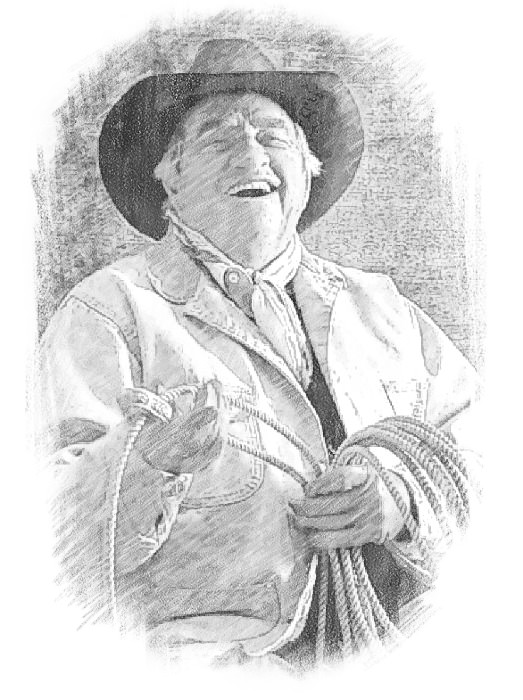
Joe Beeler, CA Founding Member
(1931-2006)
Joe Beeler, a founding member of the Cowboy Artists of America, was a pioneer in the territory of contemporary Western art. He was there at the beginning of the tremendous development of that territory in the early 1960s. The key event in Beeler’s pioneering activity was the founding, in 1965, of the Cowboy Artists of America. From that association of like-minded people flows a stream of fine art works—making the exhibitions eagerly anticipated and commercially successful.
Raised in Oklahoma and Missouri, Beeler received his Bachelor of Fine Arts degree from Kansas State Teachers College and continued his studies at the Art Center School in Los Angeles. His professional career began in illustration at the University of Oklahoma Press in Norman. This gave him the confidence to pursue a career as a professional fine artist, and collectors were quick to acquire his paintings. The success of his one-man show at the Thomas Gilcrease Museum in 1960 established him on a course that would lead to national acclaim and a string of honors and awards.
Numerous medals and awards have been bestowed on Beeler’s work, including gold and silver honors in sculpture, silver in drawing, and an Artists’ Choice Award, all from the CAA organization; there aren’t many artists who can claim such versatility. In 1994, the Arizona Historical League named him an “Arizona Historymaker”—an award presented to a very select group of Arizonans. In 1998, Canada’s Cowboy Festival presented “Living Legends Awards” to six individuals in different categories of cowboy culture, and Beeler was the artist honored by the Canadian group.
Source: Cowboy Artists of America

Joe Beeler, CA Founding Member (1931-2006) | Mike McFarland, Sculptor
Artist: Joe Beeler, CA Founding Member (1931-2006)
Description: Joe Beeler, CA Founding Member (1931-2006) | Mike McFarland, Sculptorbronze
Bronze (2006) | Dimensions: 3 ½” Diameter
Eddie Basha commissioned this medallion in 2006 following the passing of his brother, Joe Beeler. It was cast as a limited-edition series and shared with Joe’s immediate and CAA family and with other private collectors of his masterworks.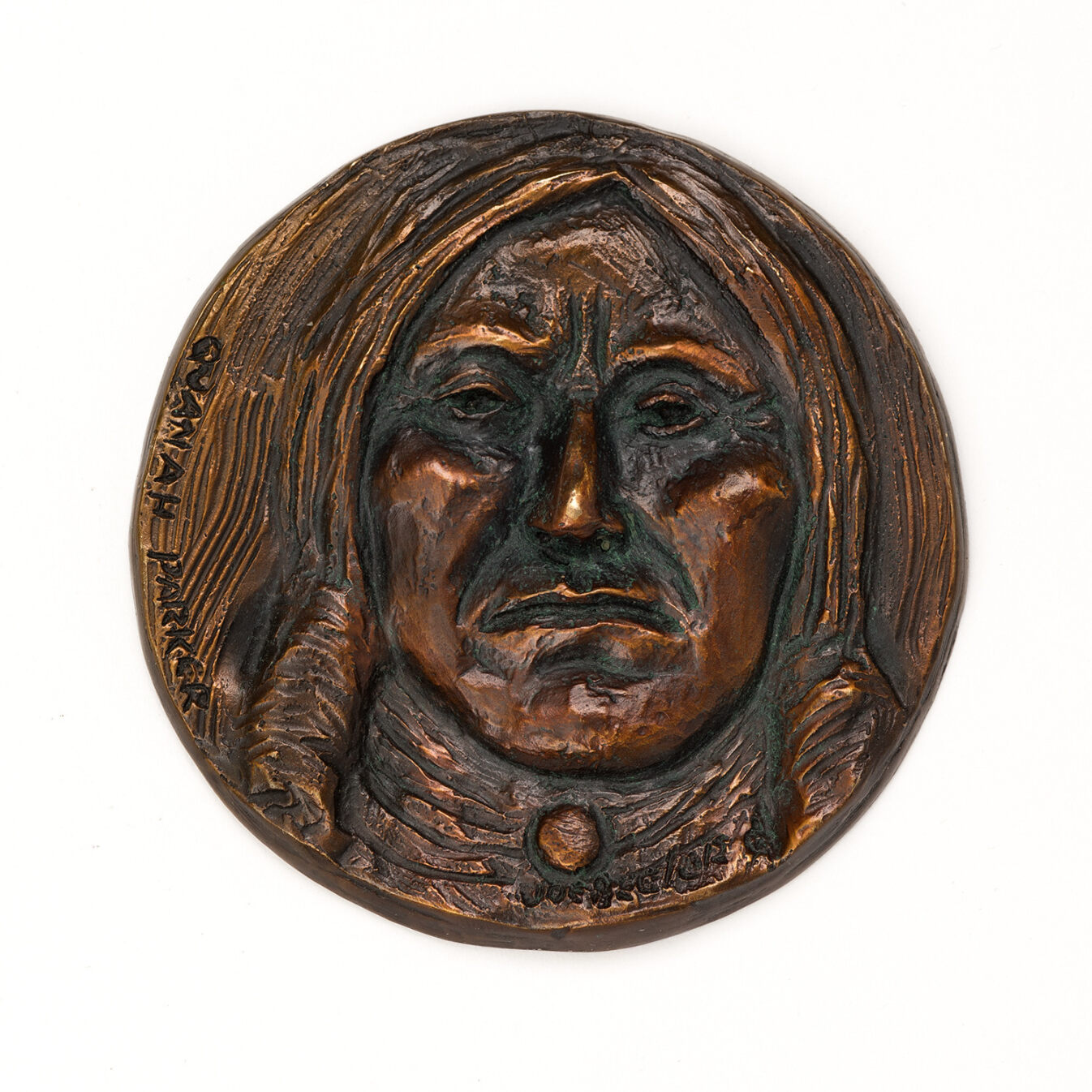
Quanah Parker
Artist: Joe Beeler, CA Founding Member (1931-2006)
Description: Bronze (2005) | Dimensions: 3 ½” Diameterbronze
In this medallion, Joe Beeler depicted the sometimes-controversial figure of the American West, Quanah Parker, who was the oldest of three mixed-race offspring of Cynthia Ann Parker and Comanche Warrior Peta Nocona. Raised in the Comanche culture, Quanah was also a warrior, chief, husband, father, rancher, deputy sheriff, church founder, community activist, and businessman. While reconnected with his maternal relatives, he studied the English language, farming techniques and culture of the white man. While varying perspectives of Quanah Parker’s life exist, there is a constant; he was an independent thinker.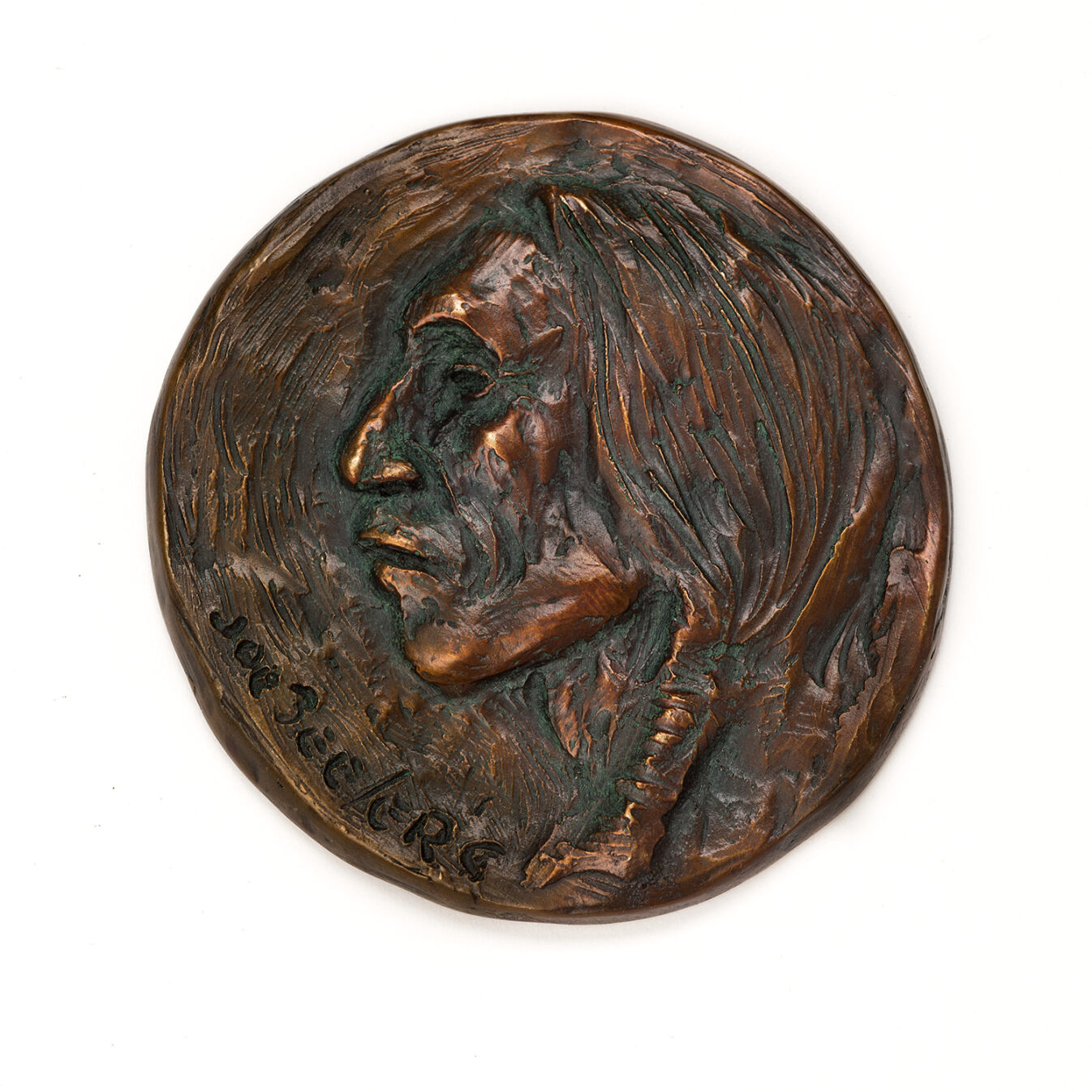
Kiowa
Artist: Joe Beeler, CA Founding Member (1931-2006)
Description: Bronze (2004) | Dimensions: 3 ½” Diameterbronze
The Kiowa Tribe moved from Montana to Colorado during the 17th and 18th centuries; by the early 19th century they eventually moved into the Southern Plains. And, in 1867, they were moved to an Oklahoma reservation. The Kiowa tribal headquarters is in Carnegie, OK, and there are approximately 12,000+ tribal members. In the Kiowa society, maternal and paternal lines are equally significant within its complex kinship system. And societies based on age and gender are also included within that system.
Early on the Kiowa use of tipis were preferred due to portability since they were hunters and gatherers and migrated based on the availability of bison and other wild game; women collected various varieties of wild grown berries, other fruits, seeds, nuts and vegetables. As a result, the Kiowa tended to stay in a specific locale for a longer time period. That is until they began acquiring horses from the Spanish which accorded them greater mobility.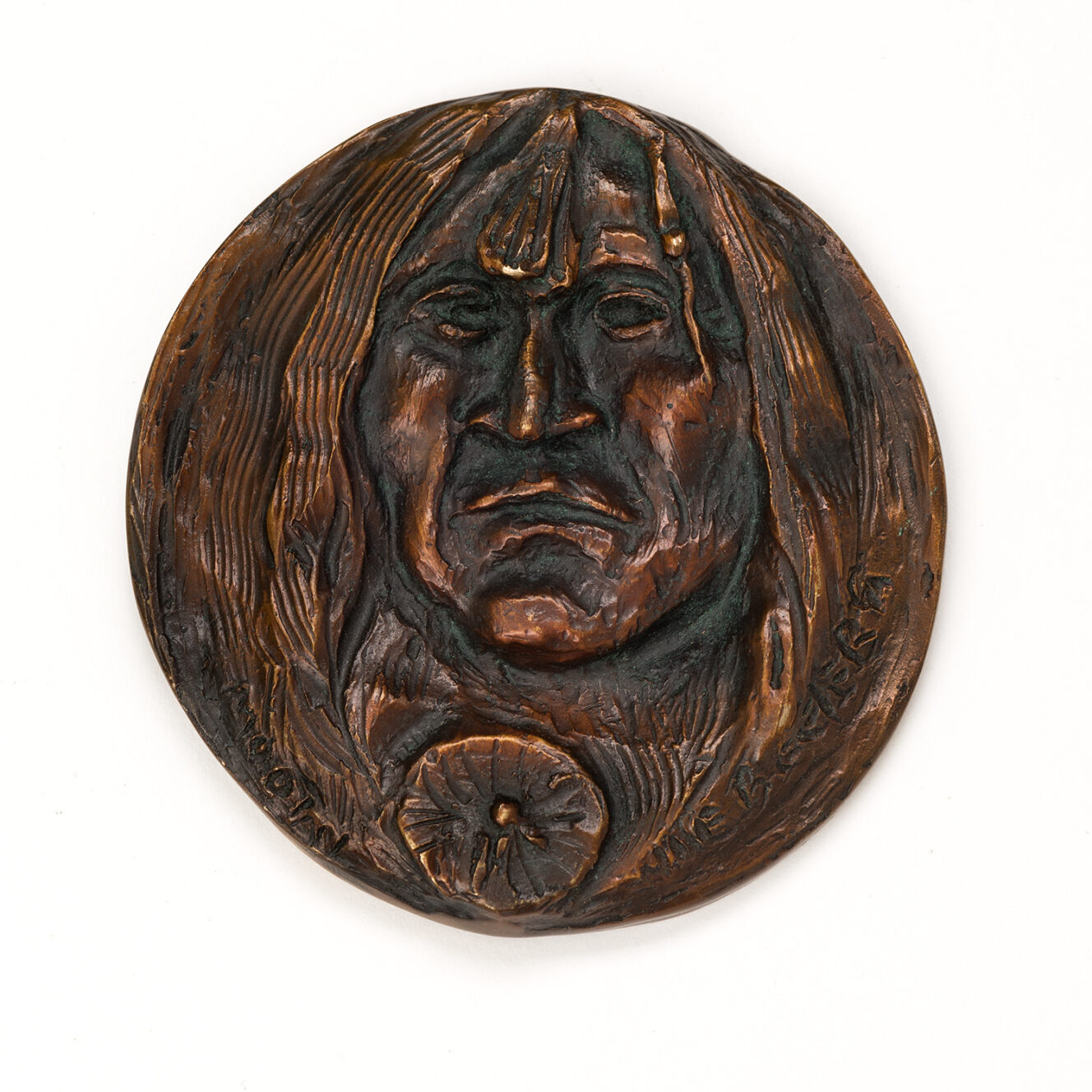
Mandan Medallion
Artist: Joe Beeler, CA Founding Member (1931-2006)
Description: Bronze (2003) | Dimensions: 3 ½” Diameterbronze
The Mandan Tribe hails from the Great Plains. Historically they lived along the Missouri River and two of its tributaries, the Heart and Knife, located in present day North and South Dakota. Their culture was primarily an agrarian one and they traded harvest surpluses for items such as bison, horses and other trade goods. In fact, the Mandan established a trading post which became a central hub for other tribes and traders. A characteristic feature of male Mandan tribal members was the hair brow which Joe Beeler featured prominently in this medallion.
Old Fort Bent
Artist: Joe Beeler, CA Founding Member (1931-2006)
Description: Watercolor (1997) | Image Size: 11”h x 8 ½"w; Framed Size: 17 ¾"h x 15 ¼"drawing
Shortly after returning to Sedona from the 1997 Cowboy Artists of America Annual Trail Ride held at the Haythorn Land & Cattle Co. located seventeen miles north of Ogallala, Nebraska, Joe Beeler penned this letter to Eddie Basha summarizing his time at the ranch and touring thru Bent’s Old Fort National Historic Site in Colorado, otherwise known as “Castle of the Plains,” on the return trip. Joe was inspired by what he saw at the ranch and at the old fort.
“The historic site features a reconstructed 1840s adobe fur trading post on the mountain branch of the Santa Fe Trail where traders, trappers, travelers, and the Cheyenne and Arapaho tribes came together in peaceful terms for trade. Today, living historians recreate the sights, sounds, and smells of the past with guided tours, demonstrations and special events.” (Source: National Park Service)
Mountain Chief
Artist: Joe Beeler, CA Founding Member (1931-2006)
Description: Oil (2002) | Image Size: 16”h x 12”w; Framed Size: 29”h x 25 1/8”wpainting
Joe Beeler, founding member of the Cowboy Artists of America, was a prolific fine artist. In addition to his many bronze sculptures and masterwork oil paintings, Beeler completed numerous profile portraits of cowboys, mountain men, and various tribal members in a variety of mediums such this well-done oil of a high-ranking Plains warrior depicted in full regalia, with horned headdress and intricately beaded shirt. White ermine pelts hang from his headdress. These details of dress and ornamentation indicate status and show that Joe Beeler was not
only adept at portraying the essence of a man’s personality through his fine art practice but was also a careful and diligent student of western history.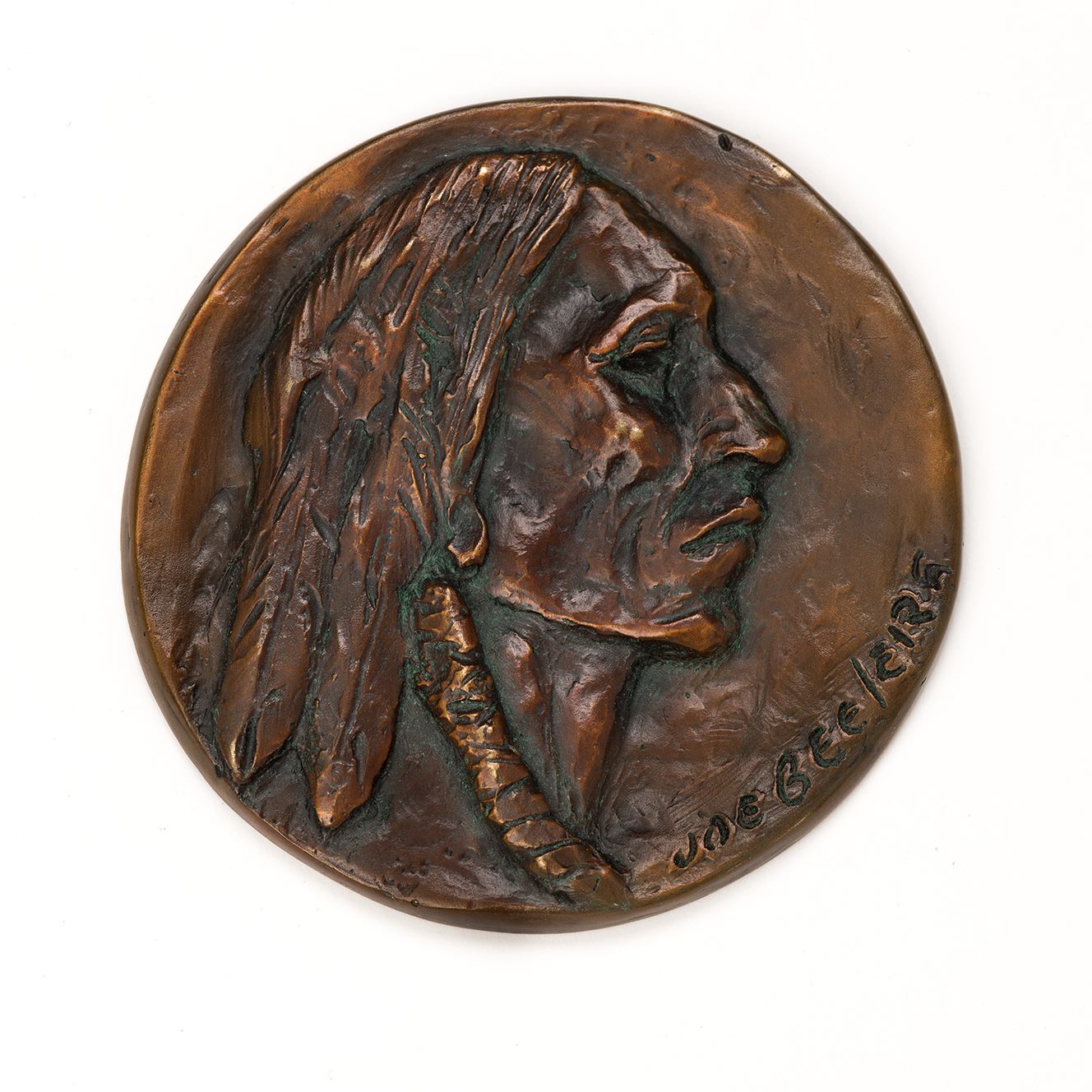
Sioux Medallion
Artist: Joe Beeler, CA Founding Member (1931-2006)
Description: Bronze (2002) | Dimensions: 3 ½” Diametersculpture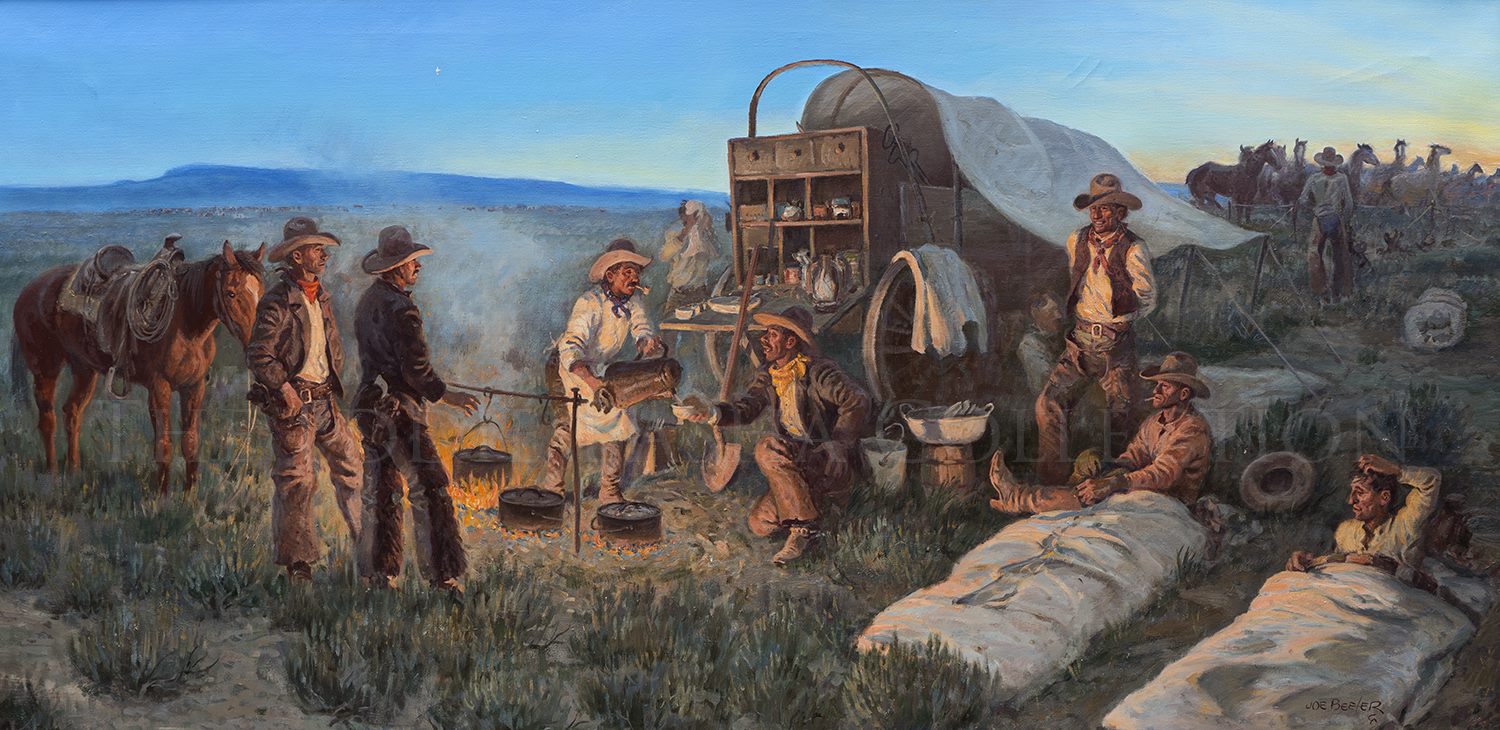
Morning in a Roundup Camp
Artist: Joe Beeler, CA Founding Member (1931-2006)
Description: Oil | Image Size: 24”h x 48”w; Framed Size: 34”h x 58”wpainting
The Chuck Wagon was essentially the heart of the home while working on a roundup. It’s where the hands gathered before and after a hard day’s work, broke bread and socialized. And it was no secret that Cookie’s job was every bit as important as the work of the hands; a fed and rested cowboy was more likely to work harder and keep a better temperament than one without. Meals frequently consisting of beans and/or beef and biscuits were prepared in Dutch ovens and cast-iron skillets and the coffee was hot. Joe Beeler’s oil, “Morning in a Roundup Camp” personifies just that.
This piece was loaned to the University of Texas Institute of Texan Cultures in San Antonio in 1985. And, more recently, to Western Spirit Scottsdale’s Museum of the West in 2018 for “The Art of Joe Beeler: A Western Original” retrospective. A photographed image of this oil painting has also appeared in three books: “Cowboy Artist: The Joe Beeler Story” published in 1979, “Cowboy Artists of America” published in 1988, and “Joe Beeler: Life of a Cowboy Artist” published in 2004.
Unknown Title
Artist: Joe Beeler, CA Founding Member (1931-2006)
Description: Watercolor | Image Size: 14”h x 10”w; Framed Size: 24”h x 21 ½"wpainting
A splash of color adds contrast and interest to this small, but detailed portrait of an American Indian wearing a headpiece embellished with feathers, a silver cross and beadwork. He holds an eagle feather in his hand. His face reveals years of experience and character.
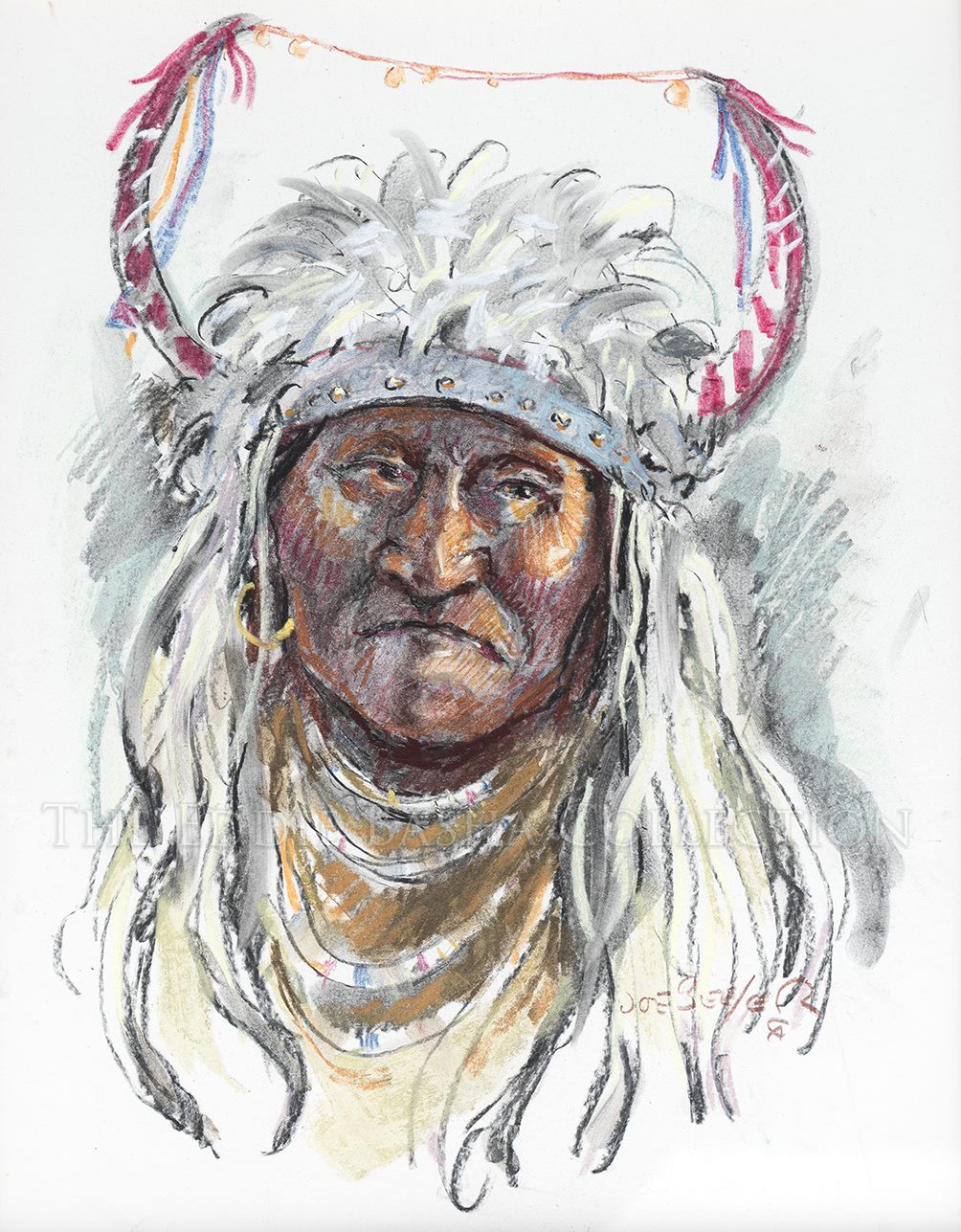
Portrait of Sundance Chief
Artist: Joe Beeler, CA Founding Member (1931-2006)
Description: Watercolor & Conte Crayon| Image Size: 14”h x 10”w; Framed Size: 21 ½"h x 18 ½"wpainting
This watercolor and crayon portrait shows a Plains Indian wearing a horned headdress. He is identified as a Sundance chief. “The Sundance” was a religious ritual practiced by several Plains tribes. It normally lasted for several days. Dancers were typically young men who often pierced their chests to achieve a trance like state.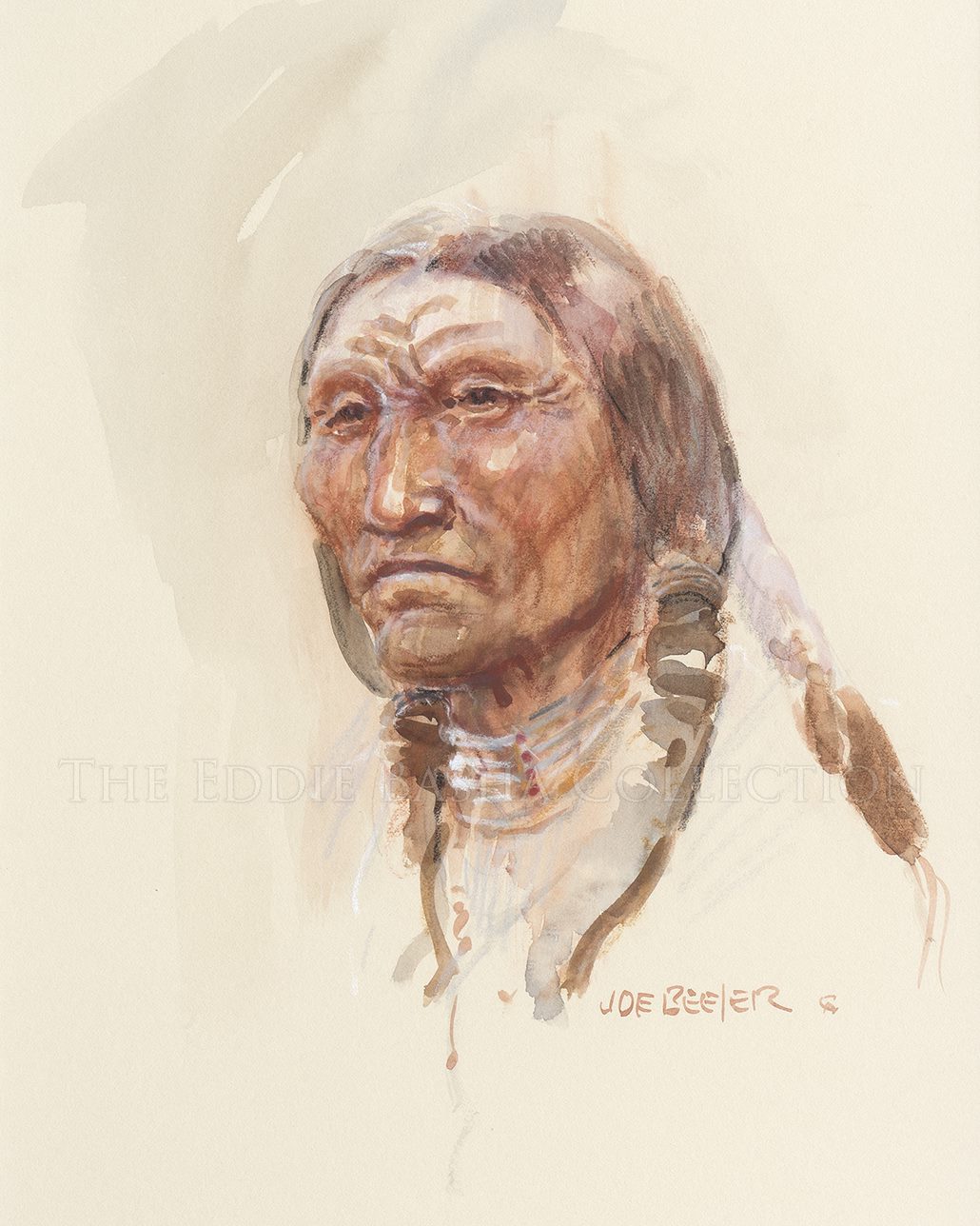
Unknown Title
Artist: Joe Beeler, CA Founding Member (1931-2006)
Description: Watercolor | Image Size: 14”h x 10”w; Framed Size: 21”h x 16 ¾"wpainting
This is a straightforward, small watercolor portrait of a Plains Indian set against a white background. The subject wears his hair in braids and is wearing a bone necklace with a medallion.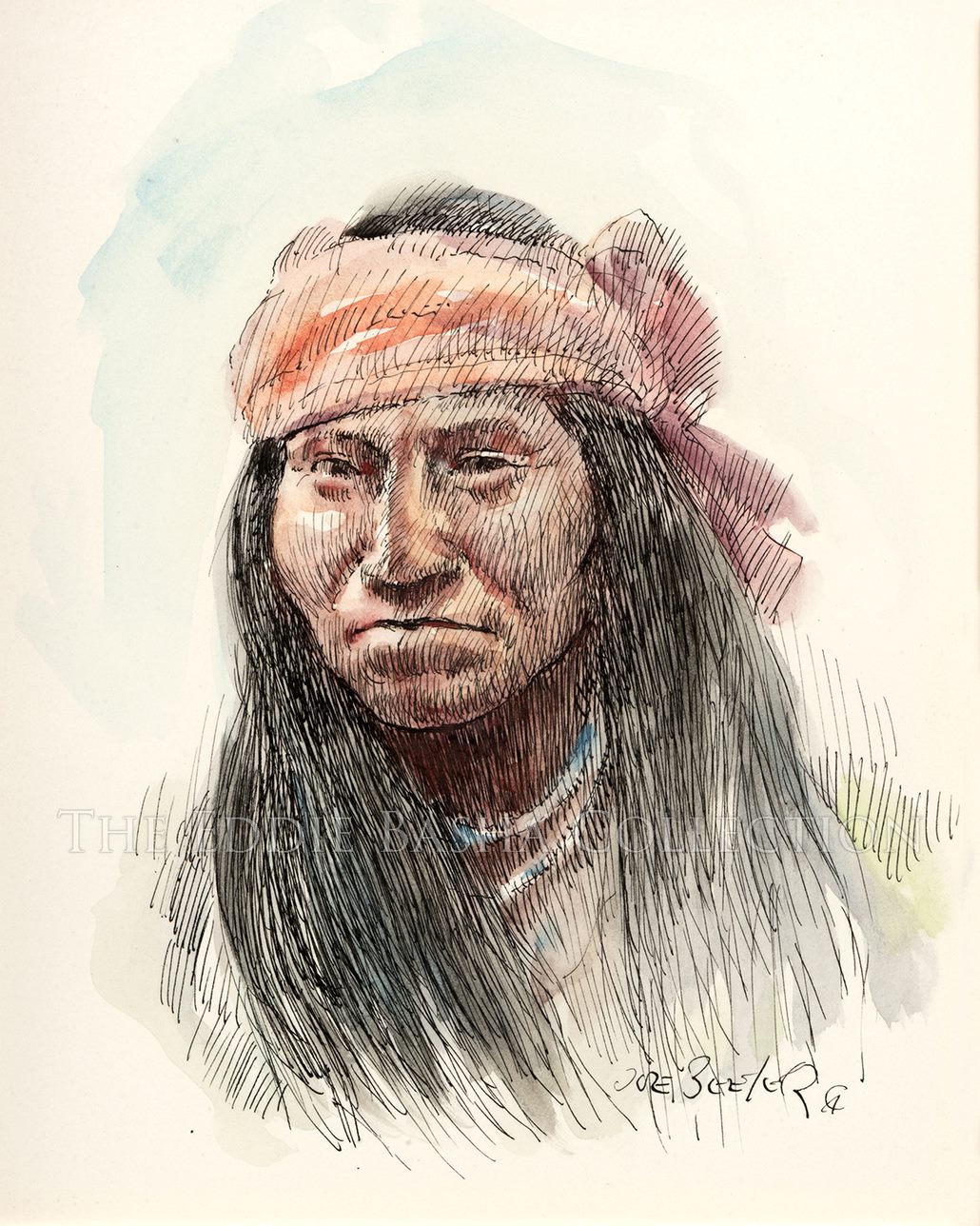
Unknown Title
Artist: Joe Beeler, CA Founding Member (1931-2006)
Description: Watercolor (Watermarker) | Image Size: 10”h x 8”w; Framed Size: 18 ¼"h x 16 ¼"wpainting
This is a small watercolor portrait of an Apache Indian gazing directly at the viewer. He has long black hair and is wearing a red scarf around his forehead. The portrait is set against a simple background of blue and white.
Unknown Title
Artist: Joe Beeler, CA Founding Member (1931-2006)
Description: Watercolor (1977) | Image Size: 11”h x 9”w; Framed Size: 19 1/8”h x 17”wpainting
This note from Joe Beeler to Eddie Basha appears on the reverse side of the watercolor: “Eddie, this cap was made of turkey feathers trimmed w/two eagle feathers and worn by a war leader among the Apaches. It also had silver conchos and red flannel or material on the top. If you were an Apache you would have worn one of these for sure. Your friend, Joe Beeler 1977”
Sharing the Cold and the Coffee
Artist: Joe Beeler, CA Founding Member (1931-2006)
Description: Oil | Image Size: 24”h x 40”w; Framed Size: 34 ½"h x 50”wpainting
Joe Beeler, Cowboy Artists of America Founding Member, conveys a sense of the frigid weather in this scene of Texas Rangers resting beside a campfire.
They are sharing a cup of coffee and the warmth of the fire with their prisoners camped beside an abandoned adobe structure on a snow covered plain. Beeler uses whites and silver blues to impart a sense of the winter weather. Light is provided by the glow
of the campfire and the rising sun. The crumbling adobe in the background adds a sense of desolation to the overall feeling of the painting.
“Sharing the Cold and the Coffee” has been exhibited at the University of Texas Institute of Texan Cultures at San Antonio in 1985 and at Western Spirit: Scottsdale Museum of the West in 2018. An image of the piece also appears on page 93 in the book entitled “Joe Beeler: Life of a Cowboy Artist” authorized by Don Hedgpeth and published by Diamond Tail Press in 2004.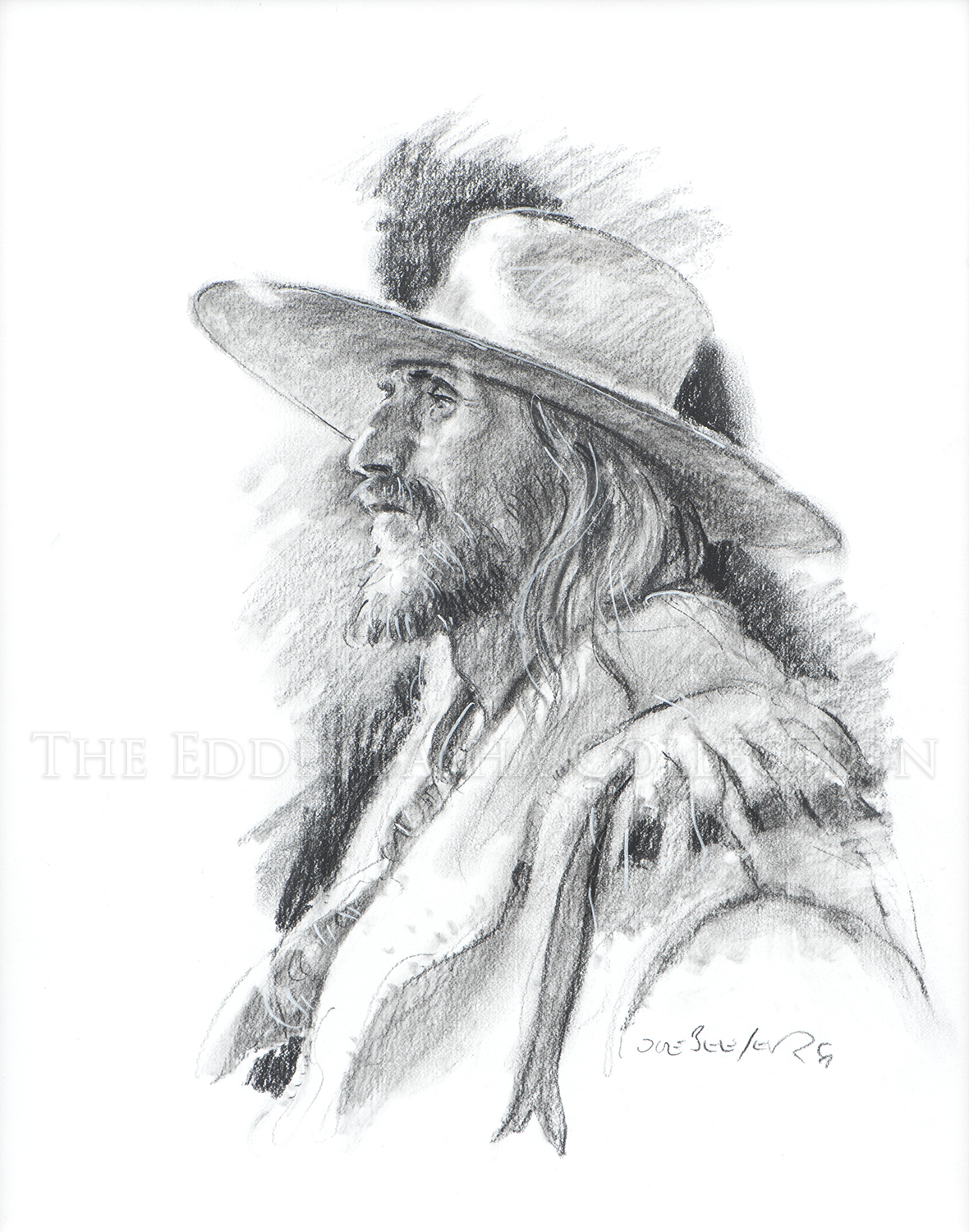
Unknown Title
Artist: Joe Beeler, CA Founding Member (1931-2006)
Description: Charcoal | Image Size: 14”h x 11”w; Framed Size: 21 ½”h x 18 ½”wdrawing
Cowboy Artists of America Founding Member Joe Beeler’s drawing of a mountain man shown in profile is a well-done charcoal depiction that is small, but rich in period
detail featuring a wide brimmed hat and pelt overcoat. The man’s weathered facial features highlight his worn squint.
This charcoal was exhibited at Western Spirit: Scottsdale’s Museum of the West 2018 retrospective “The Art of Joe Beeler: A Western Original.”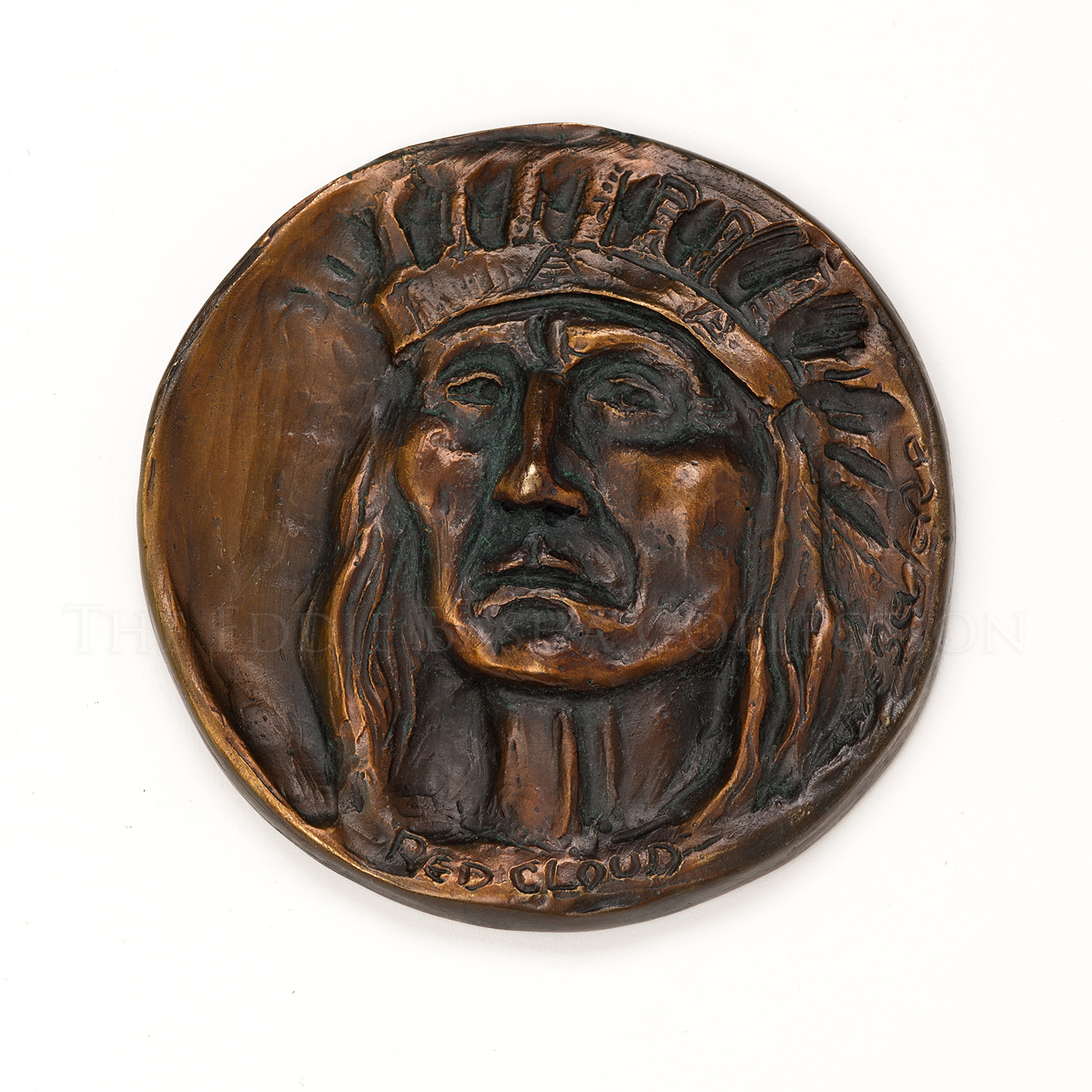
Red Cloud
Artist: Joe Beeler, CA Founding Member (1931-2006)
Description: Bronze Medallion (2000) | Dimensions: 3 ½” Diameterbronze
“Red Cloud,” the next in the series of Beeler Medallions, was a fierce warrior and leader of the Oglala Sioux. He was born in 1822 in then what was the Nebraska Territory. Following his show of strength in leadership and bravery in many battles against the Oglala traditional enemies at the time, the Pawnees, Crows, Utes and Shoshones, Red Cloud became Chief.
After the discovery of Gold in Montana during the early 1860’s, a road was constructed from Ft. Laramie to the gold fields. A series of forts were also constructed to protect what later became known as the Bozeman Trail. The Oglala, led by Red Cloud, and the Cheyenne began fighting in 1865 aggressively against the soldiers, settlers, and miners for a period of approximately two years forcing their opponents to abandon their forts and stop progress on road construction. At the end of that time, Red Cloud singed the Second Treaty of Fort Laramie and agreed to stop fighting and moved onto the Red Cloud Agency, a reservation in Nebraska.
Was it a smooth transition? Not by a long shot. However, Red Cloud began serving his people as a diplomat. In 1870 and in 1875, he travelled to Washington along with other tribal leaders and there they met with President Grant. Negotiations didn’t go so well then either after multiple promises had not been kept.
Additional details of Red Cloud’s leadership role and that of his contemporaries can be found on numerous websites, at public libraries and in historical records. Unfortunately, within this limited space only a small summary can be shared.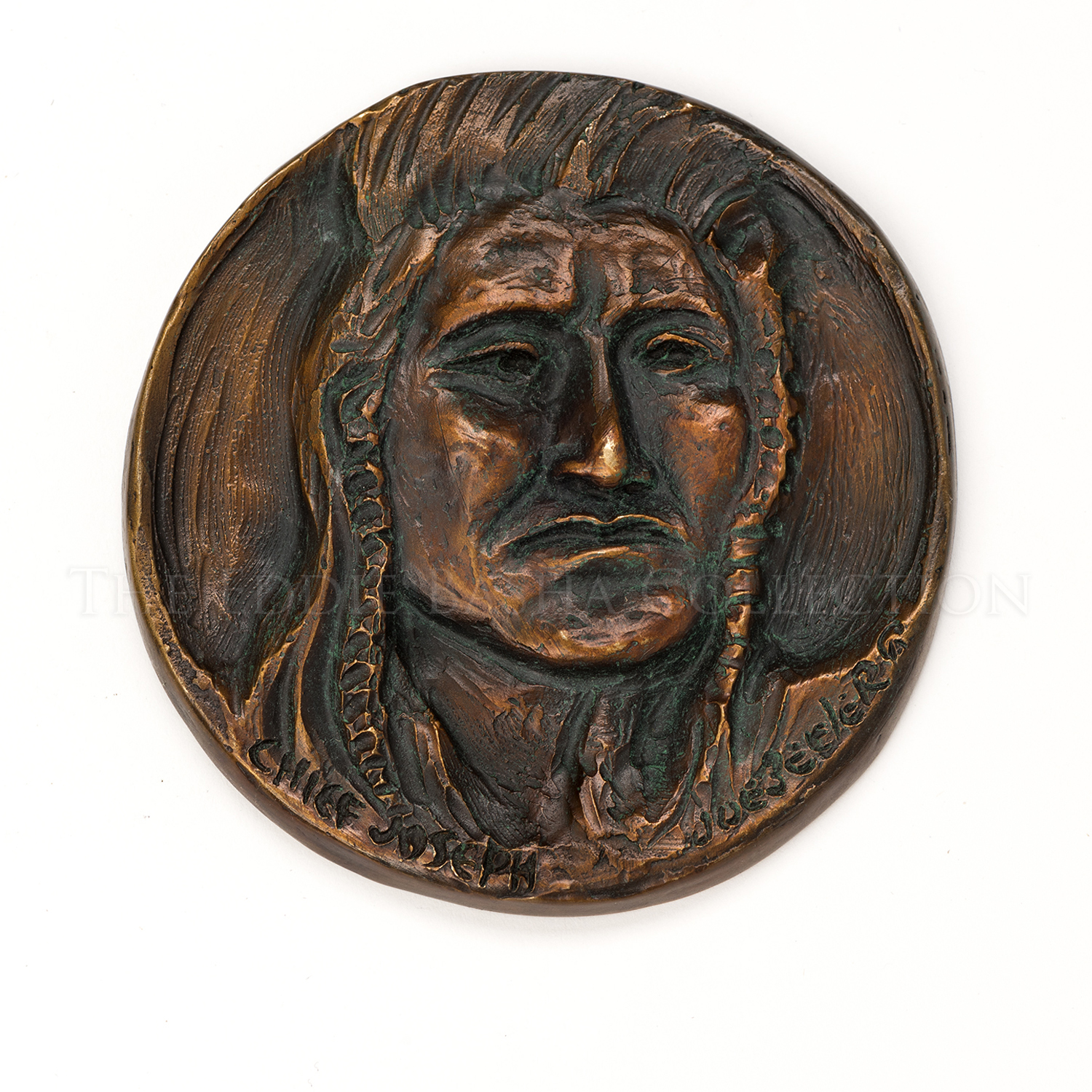
Chief Joseph
Artist: Joe Beeler, CA Founding Member (1931-2006)
Description: Bronze (1999) | Dimensions: 3 ½” Diameterbronze
Chief Joseph, led his band of Nez Perce Indians, approximately 700 men, women and children, on an epic journey, over 1100 miles, in the late 19th century across Oregon, Washington, Montana, Idaho, and Wyoming in an attempt to reach a safe haven in Canada while being pursued by the U.S. Army. Under some of the harshest conditions, the Nez Perce fought not only skillfully but their comportment earned them extensive admiration from their opponents as well as the public who followed the war coverage as reported in the newspapers. It is said Chief Joseph died of a broken heart.
Cowboy Artists of America Founding Member, Joe Beeler, sculpted this medallion in 1999.
Unknown Title
Artist: Joe Beeler, CA Founding Member (1931-2006)
Description: Pen & Ink | Image Size: 12”h x 16”w; Framed Size: 18 1/8”h x 22 ¾”wdrawing
In his book “An Uncommonly Frank Autobiography … F-F-F-Frank Polk,” illustrated by Joe Beeler, Frank shared the following: “Now I want to tell you about one of the funniest outfits I ever worked for. I was up there at Camp Wood helpin’ my best friend, Dave Hill. This was durin’ the Depression, an’ I was wantin’ to get a payin’ job. So I heard there was a couple of fellers by the name of Les Jenkins and Casey Jones who was gathering a remnant of wild cattle. I heard they was kind’a short of help, so I told Dave, I think I’ll go down there an’ see if they want to hire somebody.
Well, I saddled up a horse an’ I rode down there about thirty miles to their camp. I rode into that camp, an’ that was the goldurnest thing I ever did see. Al of them guys had—an’ ‘m tellin’ the truth—was a five-gallon keg of whiskey, a sack of jerky an’ a sack ‘a flour. That’s all the commodities they had. It was a wild outfit, an’ I guess they just stayed drunk all the time. So I went up to this ol’ Les Jenkins, an’ he say to me, “we can’t afford to hire nobody. We’re just tryin’ to get these durn wild cattle out of here.”
So I said, “Well, hell, I’ll just stay down here an’ help.”
We, we trapped a lot of cattle an’ led ‘em out of there. An’ ol’ Jenkins, he got so drunk one day he fell off his horse an’ we had to go find him ‘cause his horse came in without him.
I’ll tell you that was jist a funny doggoned outfit. I stayed with that outfit until the whiskey ran out, an’ later I’d tell the story on ‘em—that all they had in the world was a five-gallon keg of whiskey, a sack of jerky an’ a sack of flour!”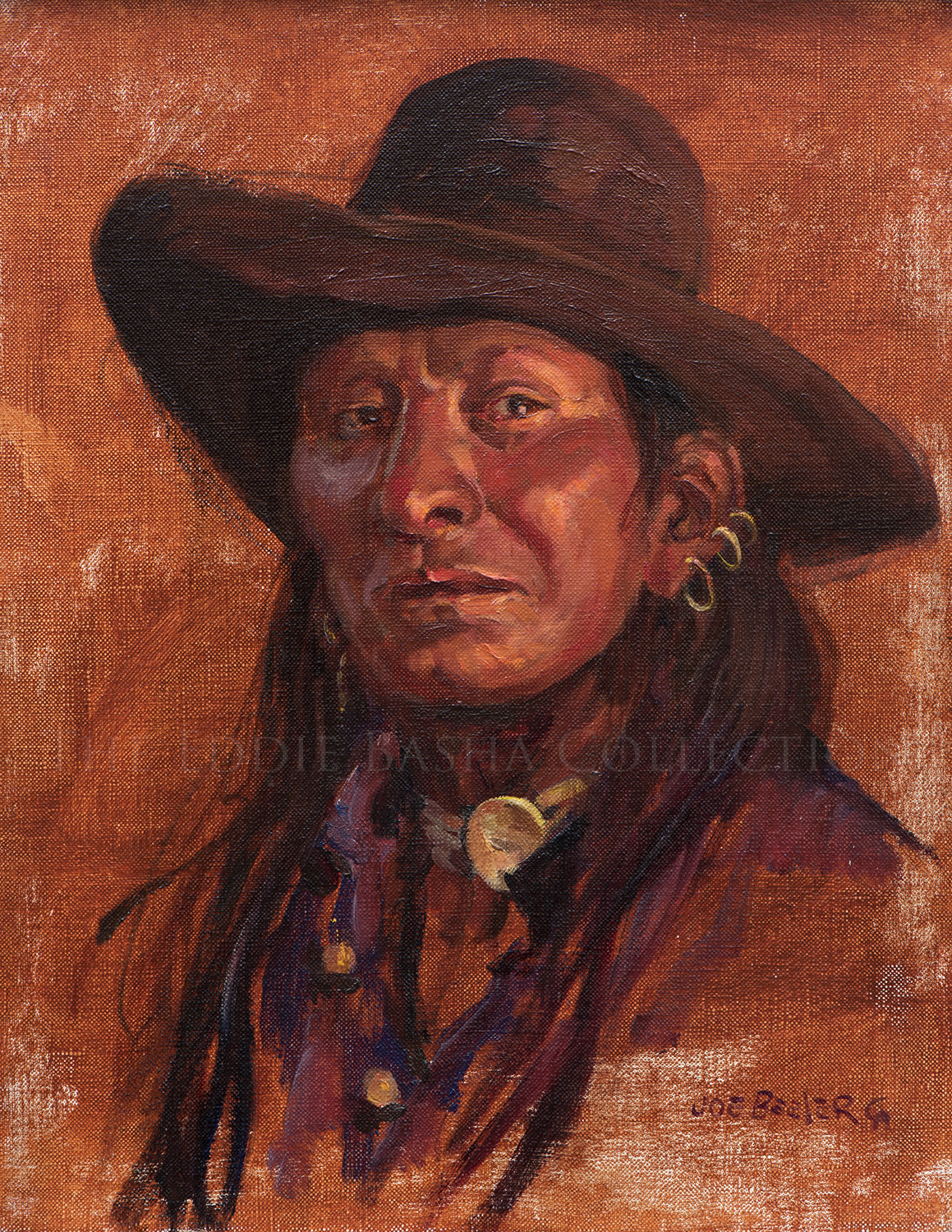
Your Enemies are Mine
Artist: Joe Beeler, CA Founding Member (1931-2006)
Description: Oil | Dimensions: Image Size: 14”h x 11”w; Framed Size: 24 ½”h x 21 ½”wpainting
A photographed image of this oil painting is depicted in the book entitled “Joe Beeler: Life of a Cowboy Artist”, authored by Don Hedgpeth and published by Diamond Tail Press in 2004. The original oil was loaned and exhibited at the Arizona State Capitol Speaker’s Conference Area May 2019-June 2022.
This well done and effective small oil portrait of an Indian shows him looking directly at the viewer with a steady and resolute gaze. Beeler successfully uses a rich, rust color in varying hues on both the man and the background thereby illuminating the subject’s earrings, bone and shell choker, and shirt buttons.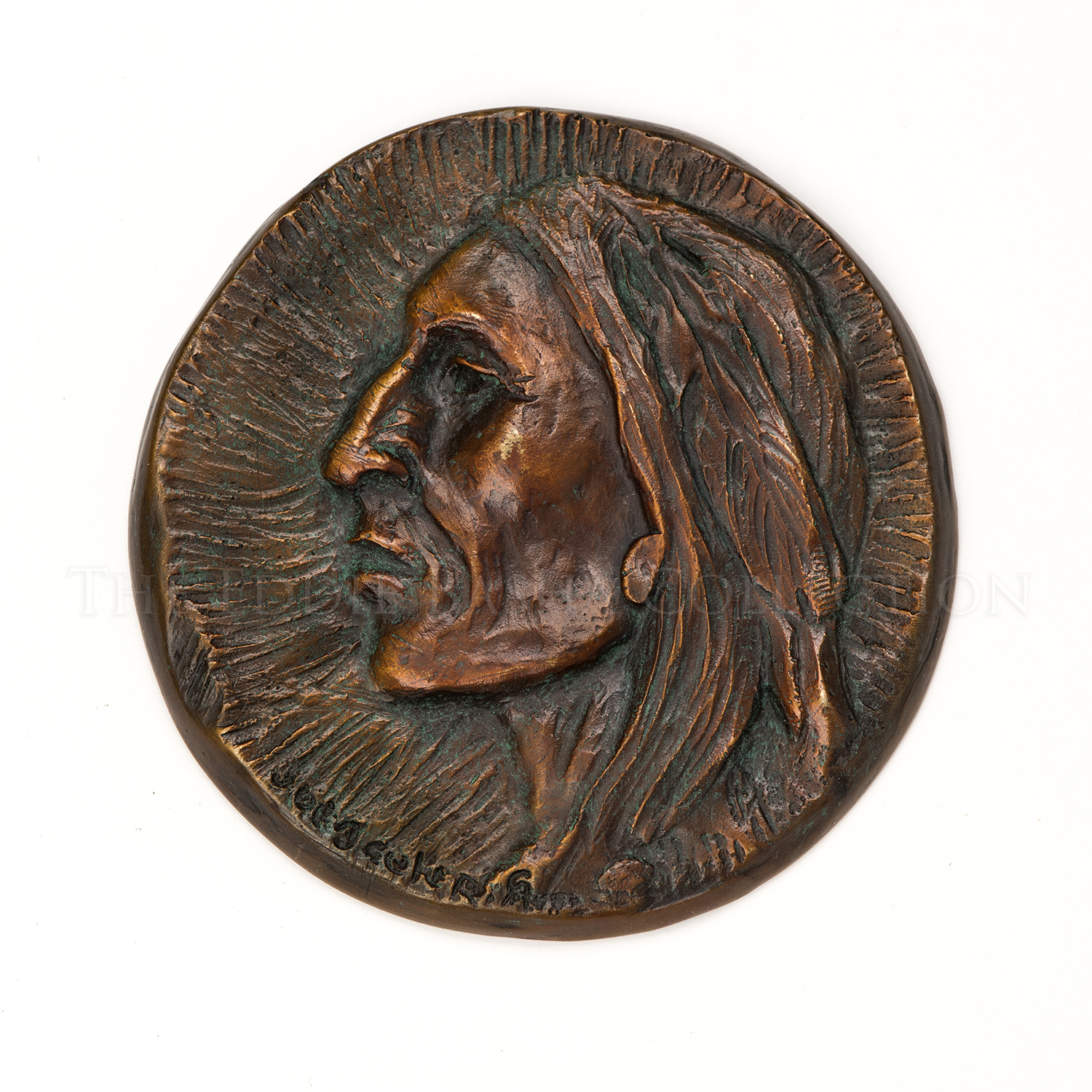
Unknown Title
Artist: Joe Beeler, CA Founding Member (1931-2006)
Description: Bronze (1998) | Dimensions: 3 ½” Diameterbronze
CAA Founding Member, Joe Beeler, sculpted this bronze in 1998; it was cast in bronze at the Bronzesmith Fine Art Foundry & Gallery in Prescott, Arizona, and subsequently gifted by Eddie Basha.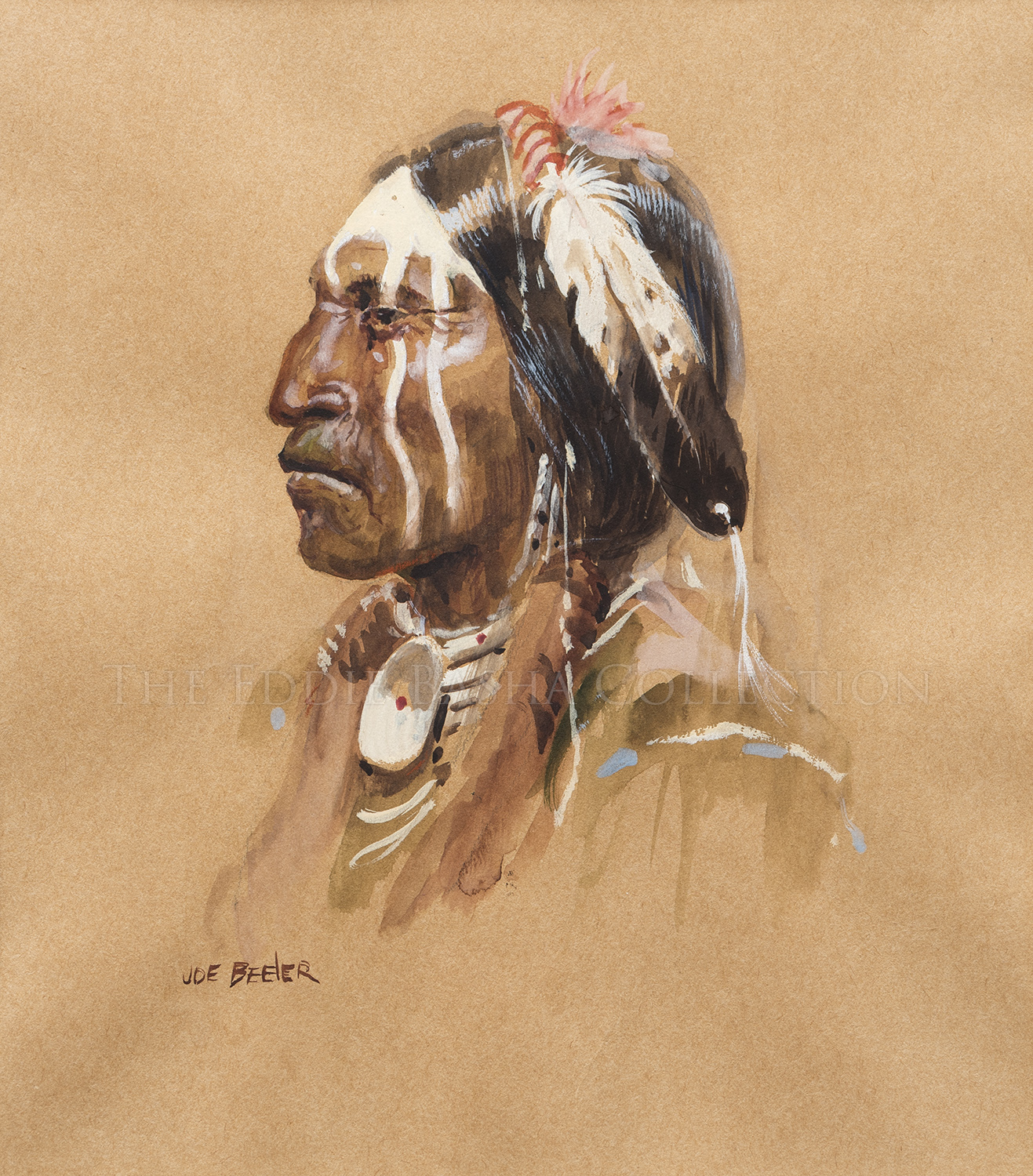
Unknown Title
Artist: Joe Beeler, CA Founding Member (1931-2006)
Description: Watercolor | Image Size: 10”h x 9”w; Framed Size: 17 ¼”h x 16”wpainting
This small profile portrait of a Plains Indian by Joe Beeler is rich in detail. The man wears eagle feathers in his hair and a shell and bone necklace. One of the most striking features, however, is the dramatic face paint which begins on the man’s forehead and extends in long lines to his chin. His expression is stoic and resolute.
This watercolor was also on loan at the Arizona State Capitol in the Speaker of the House’s Conference Area, May 2019 through June 2022.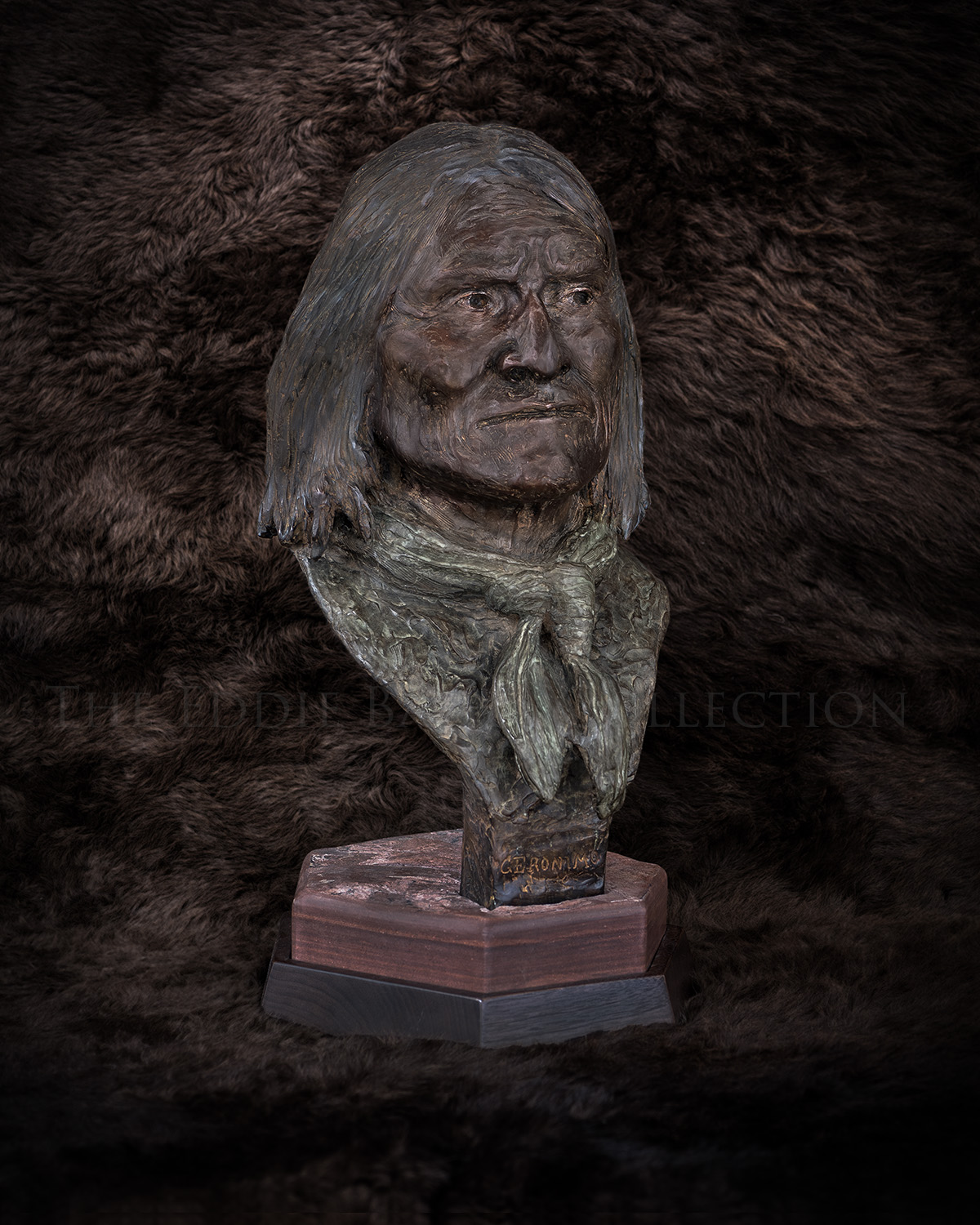
Geronimo
Artist: Joe Beeler, CA Founding Member (1931-2006)
Description: Bronze | Dimensions: 24”h x 12”w x 12”d; Edition #1 of 45bronze
Joe Beeler’s bronze bust of one of the most famous American Indians in history depicts the Apache leader and Medicine Man, Geronimo (1829-1909), in his later years. By then, he had been photographed numerous times and his likeness as well as his determination to defend his people and their land was well known. Beeler called upon those images to create a bust bearing the legendary leader’s likeness. He modeled his face to reveal within it a lifetime of fearlessness, tenacity, and experiences.
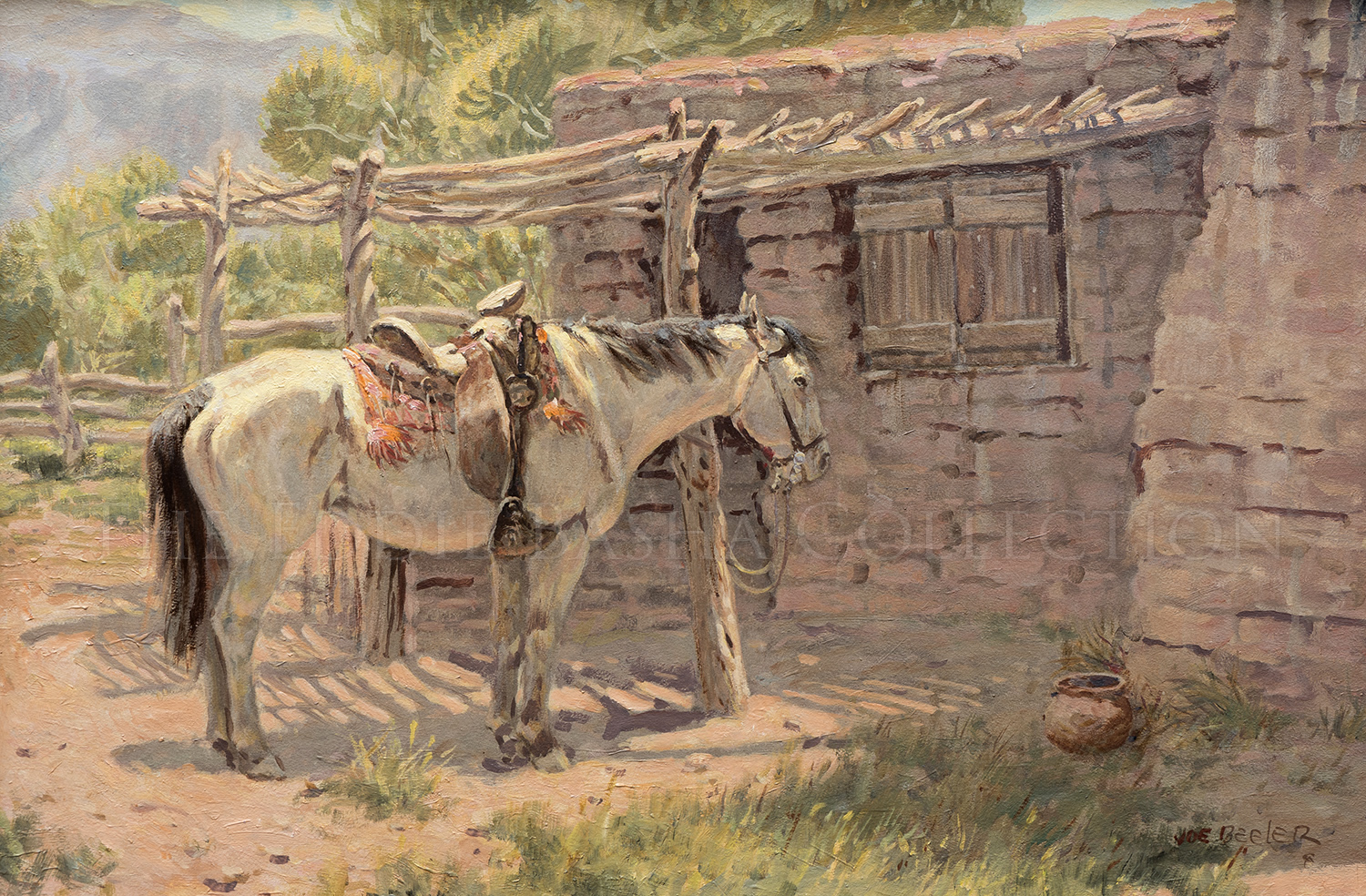
Unknown Title
Artist: Joe Beeler, CA Founding Member (1931-2006)
Description: Oil | Image Size: 16”h x 24”w; Framed Size: 23 1/8”h x 30 7/8”wpainting
This idyllic scene of a saddled horse tethered to a post outside of a brick adobe house establishes a sense of place. Joe Beeler lights his white horse with bright sunshine and shades the house in subtle shadow. He adds bits of green grass in the right foreground and green trees in the left background to give a touch of color and to frame the horse and house. In the distant background, blue-gray cliffs under just a hint of a blue sky were added. The horse contentedly awaits the return of his rider.
This lovely oil was also returned to the gallery in June after having been on loan to the Arizona State Capitol Speaker’s Office (2019-2022).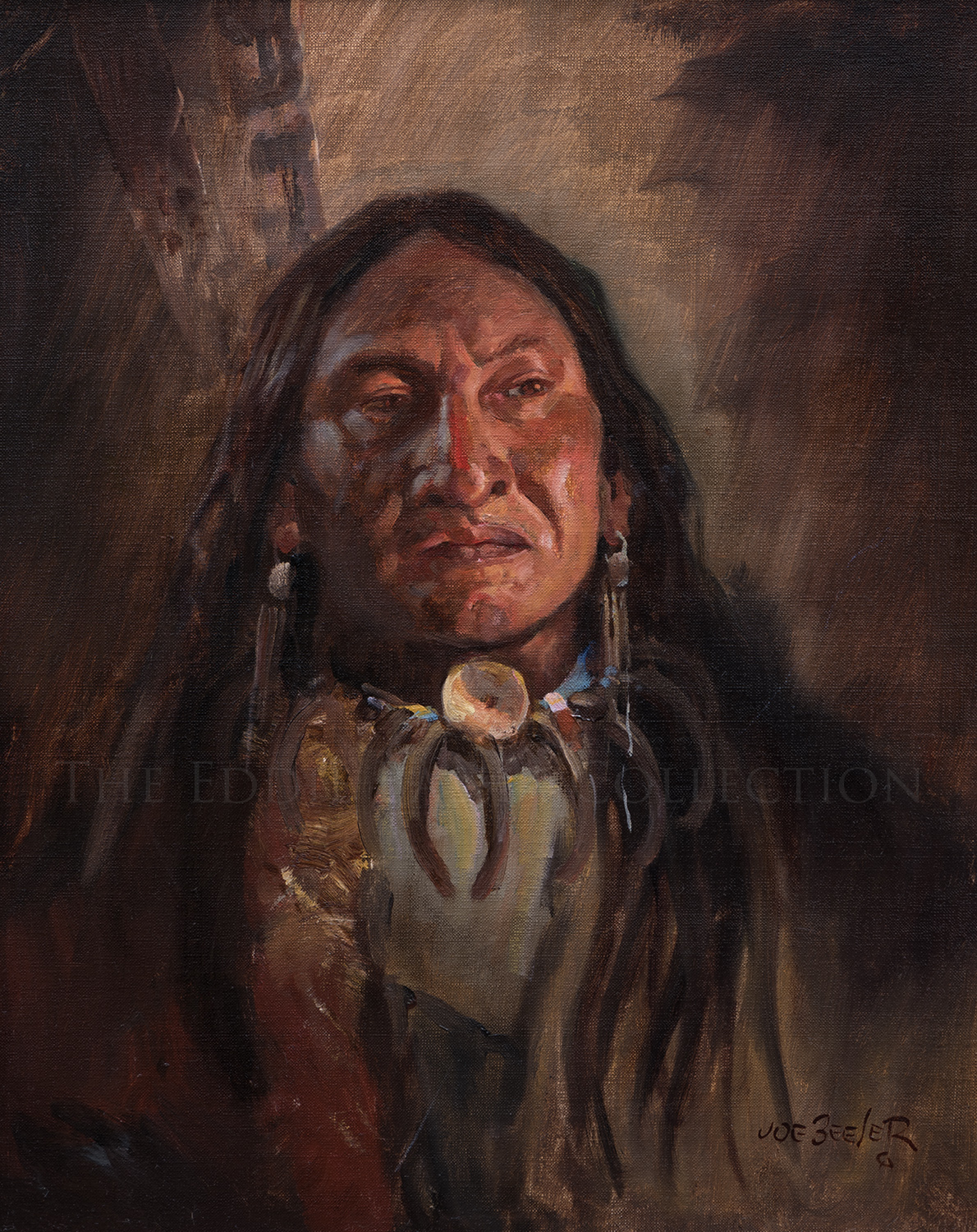
By the Council Fire
Artist: Joe Beeler, CA Founding Member (1931-2006)
Description: Oil | Image Size: 20”h x 16”w; Framed Size: 27 ¾”h x 23 ½”wpainting
Much of this well-executed painting is done in subdued lighting, except for the facial features which are bathed in the soft glow of an unseen campfire. The subject’s face is framed by his long black hair which is adorned with braided leather and beaded straps. He wears both an animal claw and shell neckpiece medallion around his neck. With a contemplative expression, Beeler endows his face with a sense of wisdom and experience.
An image of this original oil painting appears in the book entitled “Joe Beeler: Life of a Cowboy Artist.” It has been loaned twice; first to Western Spirit: Scottsdale Museum of the West for the Joe Beeler retrospective in (Jan-Oct 2018) and more recently it was displayed at the Arizona State Capitol in the Speaker of the House Conference Area (May 2019-June 2022).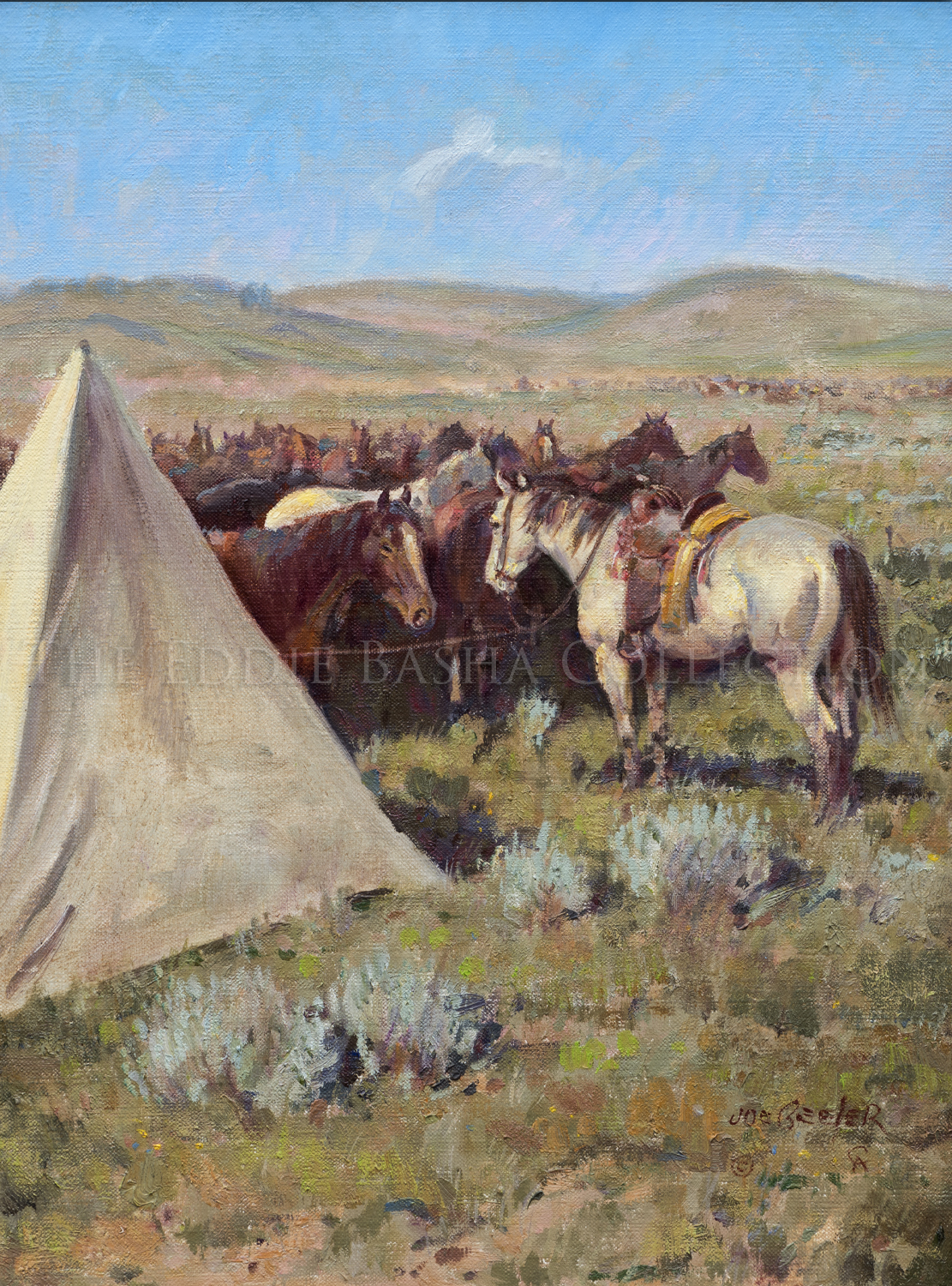
Noon Break
Artist: Joe Beeler, CA Founding Member (1931-2006)
Description: Oil | Image Size: 16”h x 12”w; Framed Size: 24 5/8”h x 20 5/8”wpainting
A brief respite in a busy day was always a welcome relief to a cowhand. Here, Beeler presents another quiet moment of ranching life in this small oil painting of horses resting beside a cowboy’s tent. The white horse in the center of the painting and the white canvas of the tent offer a sharp contrast to the surrounding pasture. A vivid blue sky provides the context for the scene.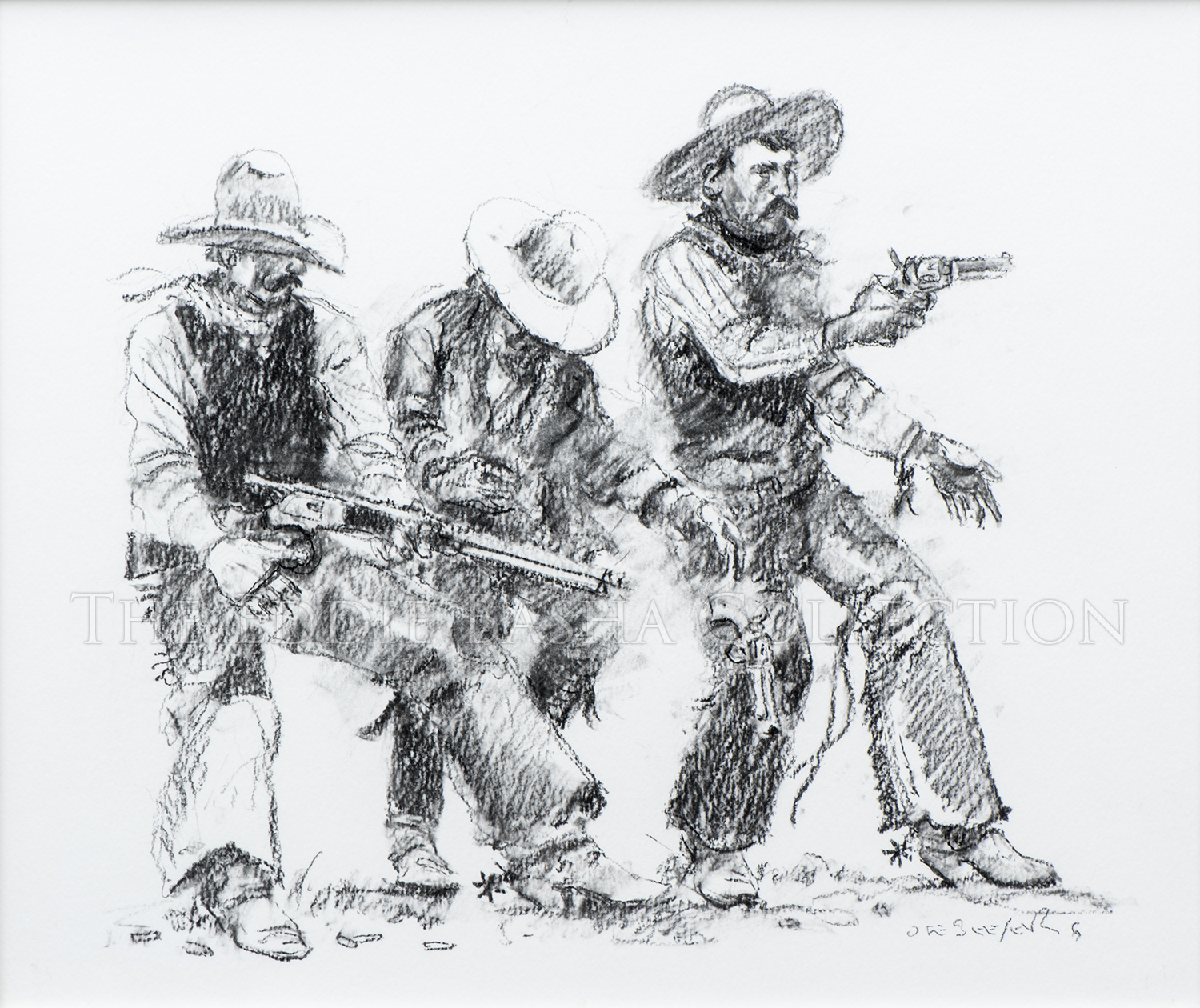
Dispute at the Water Hole
Artist: Joe Beeler, CA Founding Member (1931-2006)
Description: Charcoal | Image Size: 18”h x 22”w; Framed Size: 28”h x 30 ¾”wdrawing
Cowboy Artist of America Founding Member, Joe Beeler, portrayed modern cowboys, but he also had a great interest and frequently depicted scenes from the historic West. In this charcoal drawing, Beeler concentrates solely on three cowboys engaged in a shootout without any image background. We see only one vantage point of the conflict, the three cowboys firing their weapons; the center cowboy appears to have been wounded, while the other two continue to fire. The cowboys are realistically portrayed, and Beeler handled the action splendidly. Titling the image as he did is the viewer’s only point of reference.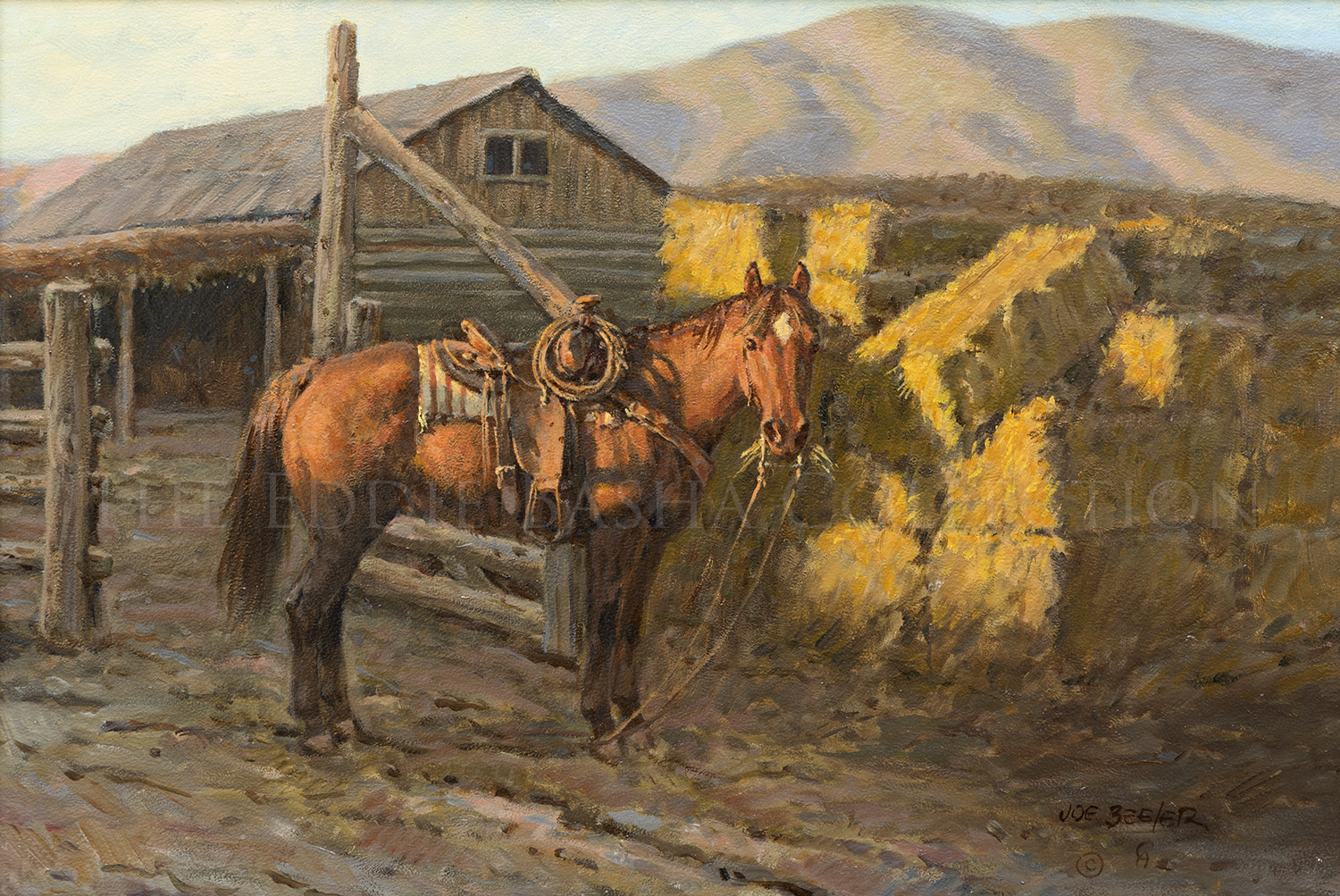
Caught in the Act
Artist: Joe Beeler, CA Founding Member (1931-2006)
Description: Oil (1973) | Image Size: 18”h x 24”w; Framed Size: 24 ½”h x 31 ½”wpainting
Cowboy Artists of America Founding Member, Joe Beeler, literally used sunlight to put a spotlight on his subject. In this case, the subject is a horse and not a cowboy. And even though an equine is the central figure, its personality shines through to the viewer. Undoubtedly, Beeler caught this guy in action at home more than once.
“Caught in the Act” has been exhibited at the Gilcrease Museum (1980), the Desert Caballeros Museum (1990) and at Western Spirit: Scottsdale Museum of the West (2018). In addition, an image of the piece appears in two of Beeler’s books; “Cowboy Artist: The Joe Beeler Story” (1979) and “Joe Beeler: Life of a Cowboy Artist” (2004).
Sentinel
Artist: Joe Beeler, CA Founding Member (1931-2006)
Description: Oil | Dimensions: Image Size: 20”h x 16”w; Framed Size: 29”h x 25”wpainting
Lighting plays a key role in Cowboy Artists of America founding member Joe Beeler’s painting of an Apache sentinel standing on a rocky outcrop facing the setting sun. The reddish glow of the sunlight washes over him and his surroundings yet doesn’t obscure the cloudless blue sky. He stands, watching in the distance to discern the arrival of any unwelcome visitors and has his rifle at the ready. Both he and a gnarled tree behind him are silhouetted against the sky by the raking light. Though the composition might be a simpler one, it’s astonishing to ponder the number of times this scenario has occurred.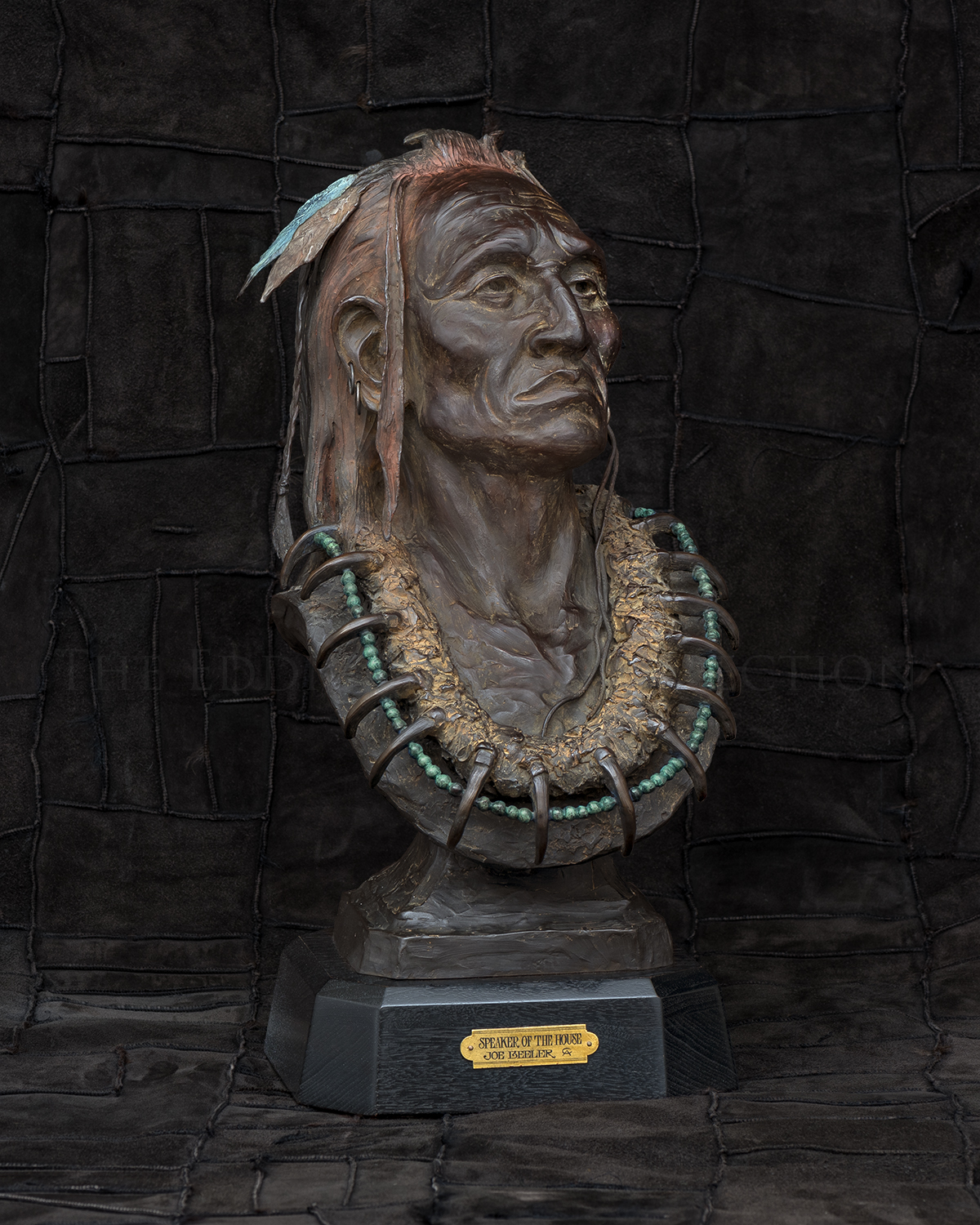
Speaker of the House
Artist: Joe Beeler, CA Founding Member (1931-2006)
Description: Bronze (1993) | Dimensions: 17”h x 11”w x 9’d; Edition #1 of 40bronze
In 1993 at the 28th Annual Cowboy Artists of America Exhibition & Sale held at the Phoenix Art Museum when it made its debut, “Speaker of the House” by Joe Beeler won not only the Gold Medal in Sculpture but also won the Best of Show Kieckhefer Award. Proudly the EBC displays Edition #1 of 40. An image of this piece is also featured in the book entitled “Joe Beeler: Life of a Cowboy Artist” authored by Don Hedgpeth and published by Diamond Tail Press in 2004.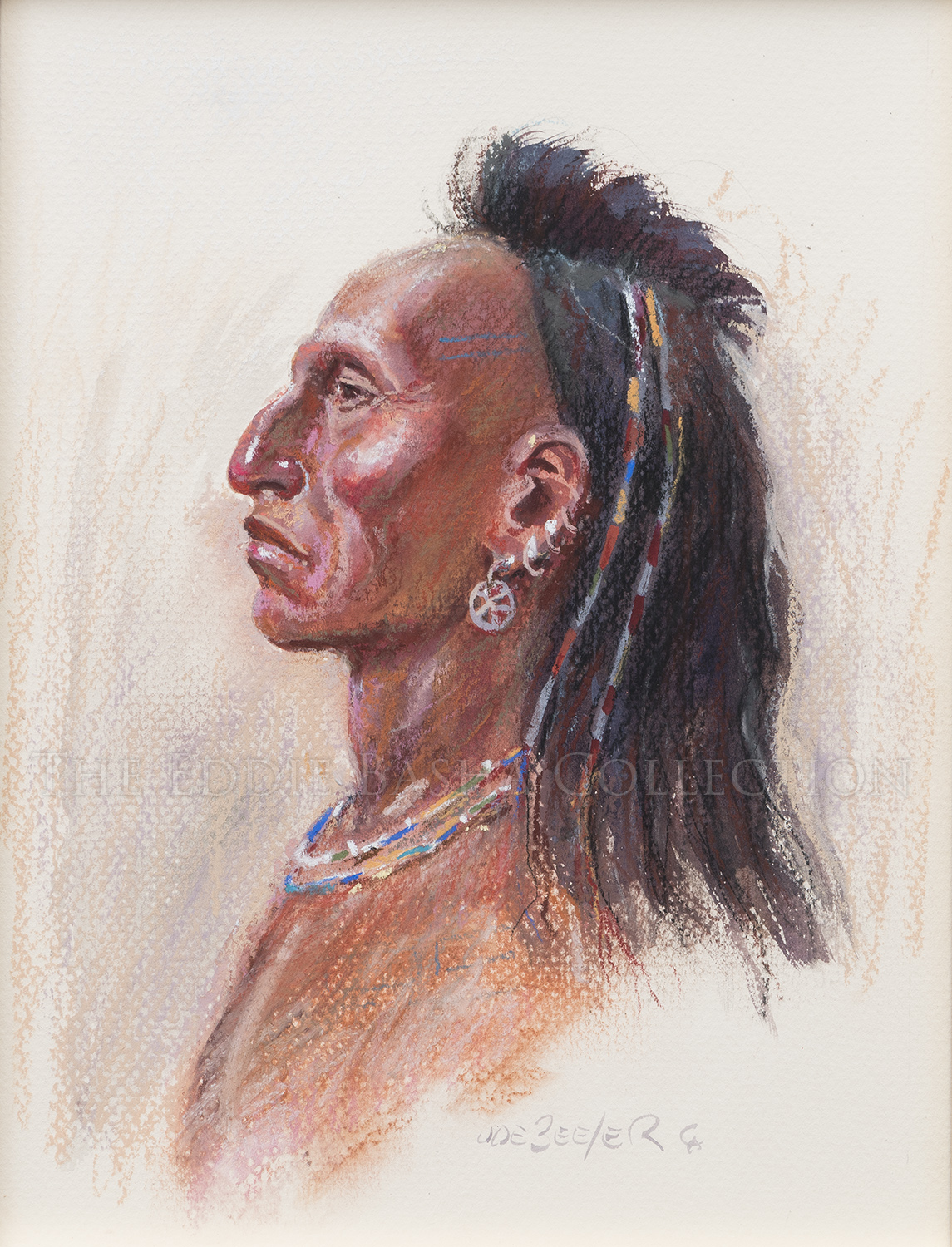
Unknown Title
Artist: Joe Beeler, CA Founding Member (1931-2006)
Description: Pastel | Image Size: 22”h x 16”w; Framed Size: 31 ½”h x 25 ½”wpainting
Founding member of the Cowboy Artists of America, Joe Beeler, was a prolific artist and disciplined in a variety of mediums such as the pastel shown here. In this medium-sized portrait of an American Indian wearing a bright red scarf and a top hat adorned with a star, perhaps a frontier marshal’s or sheriff’s badge, Beeler accurately depicts the era when warriors adopted the dress of newcomers to their territory. Many of these types of pieces were acquired by trade or by the spoils of a raid.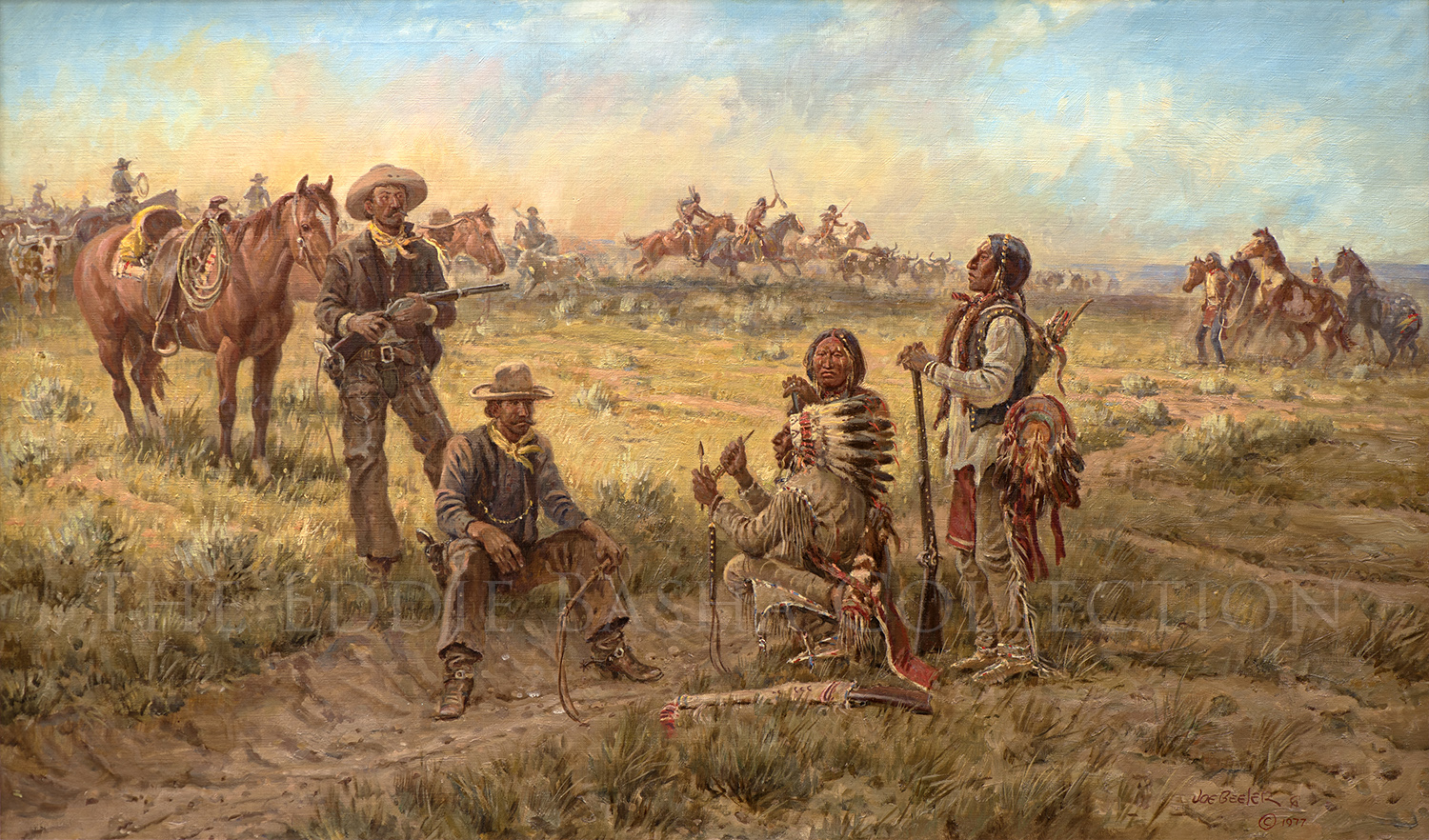
A Doubtful Promise
Artist: Joe Beeler, CA Founding Member (1931-2006)
Description: Medium (Year) | Image Size: 24”h x 40”w; Framed Size: 35”h x 50”wpainting
During the period of the early trail driving days, there was much violence and bloodshed. Herds were attacked, cattle driven off and cowboys and Indians wounded and killed. If the warriors felt they were not well-enough armed to attack during the day, attacks were made at night to cause stampedes which inflicted great losses on the cow men.
This painting portrays a group of Kiowa and Comanche holding up a trail herd. They are cutting out a small bunch of steers as payment for the herd crossing their hunting ground. Here the old chief is seen breaking an arrow as a promise to the trail boss that they are “brothers” and that his children will cause them no trouble. The looks on the faces of all the characters involved show their concern and doubt.
The painting is rich in authentic details of the period and the imagery effectively complements the narrative provided by Joe Beeler, Founding Member of the Cowboy Artists of America. It has been exhibited three times. The first at the Gilcrease Museum in Tulsa OK for the “Joe Beeler at Gilcrease” exhibition, May 2-July 6, 1980. The second at the Scottsdale Center for the Arts “Romance of the Range-The Horse in Western Art” exhibition, October 27-December 8, 1991. And more recently at Western Spirit: Scottsdale Museum of the West “The Art of Joe Beeler: A Western Original” retrospective, January 16-October 28, 2018.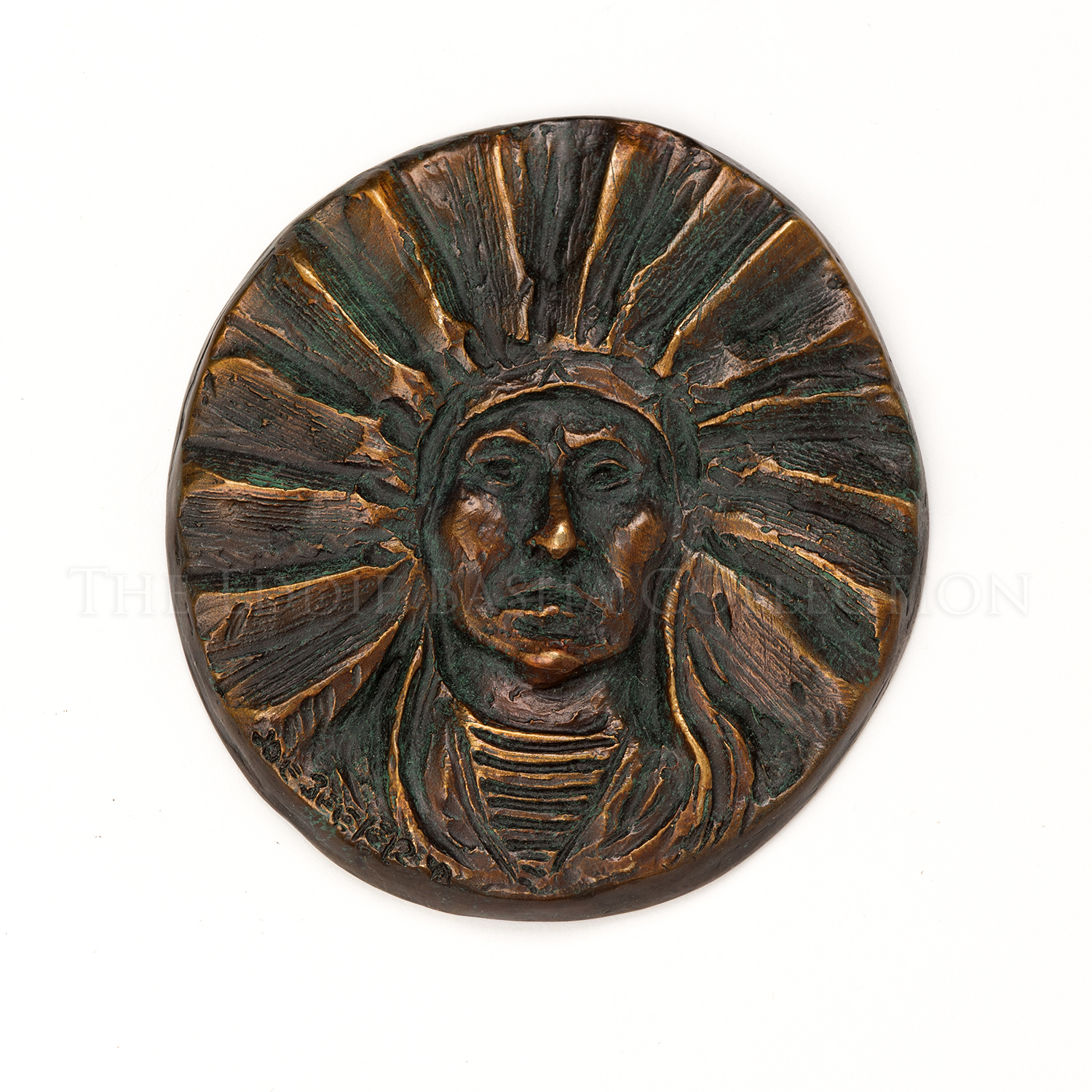
Plains Indian Medallion
Artist: Joe Beeler, CA Founding Member (1931-2006)
Description: Bronze (1997) | Dimensions: 3 ½” Diameterbronze
This Plains Indian medallion was created and gifted in 1997. We thought it fitting to highlight some information pertaining to the Plains Indians as shared by Wikipedia as follows:
“Plains Indians or Indigenous peoples of the Great Plains and Canadian Prairies are the Indian tribes and First Nation band governments who have historically lived on the plains and prairies of the North American continent. While these hunting-farming cultures lived on the Great Plains for centuries prior to European contact, the 17th century through the late 19th century horse cultures are more widely discussed in literature and art.
The Plains Indian tribes are usually divided into two broad classifications which overlap to some degree. The first group became a fully nomadic horse culture during the 18th and 19the centuries, following the vast herds of buffalo, although some tribes occasionally engaged in agriculture. These include the Arapaho, Assiniboine, Blackfoot, Cheyenne, Comanche, Crow, Gros Ventre, Kiowa, Lakota, Lipan, Plains Apache (or Kiowa Apache), Plains Cree, Plains Ojibwe, Sarsi, Nakoda (Stoney), and Tonkawa. The second group were sedentary and semi-sedentary, and, in addition to hunting buffalo, they lived in villages, raised crops, and actively traded with other tribes. These include the Arikara, Hidatsa, Iowa, Kaw (or Kansa), Kitsai, Mandan, Missouria, Omaha, Osage, Otoe, Pawnee, Ponca, Quapaw, Wichita, and the Santee Dakota, Yanktonai and Yankton Dakota.”
Additional brief summaries related to Plains Indian history, horses, bison, wars, agriculture/plants foods, hunting, clothing, religion, and gender roles may be found at https://en.wikipedia.org/wiki/Plains_Indians . And, more in depth information may be found at any public library; enjoy the research.
Working Pardners
Artist: Joe Beeler, CA Founding Member (1931-2006)
Description: Oil | Image Size: 20”h x 30”w; Framed Size: 26”h x 38”wpainting
Joe Beeler, founding member of the Cowboy Artists of America, was incredibly proficient at creating believable western personas … cowboys, Indians, hardened outlaws, trappers, and on occasion a female or two. However, he was equally talented at creating them for animals such as these two horses, seemingly old friends who have traveled many miles together, shown standing beside a corral and out building. And just as mountains rise behind them and the sun glances off of their well-worn coats, the familiarity of the pair leaps off the canvas.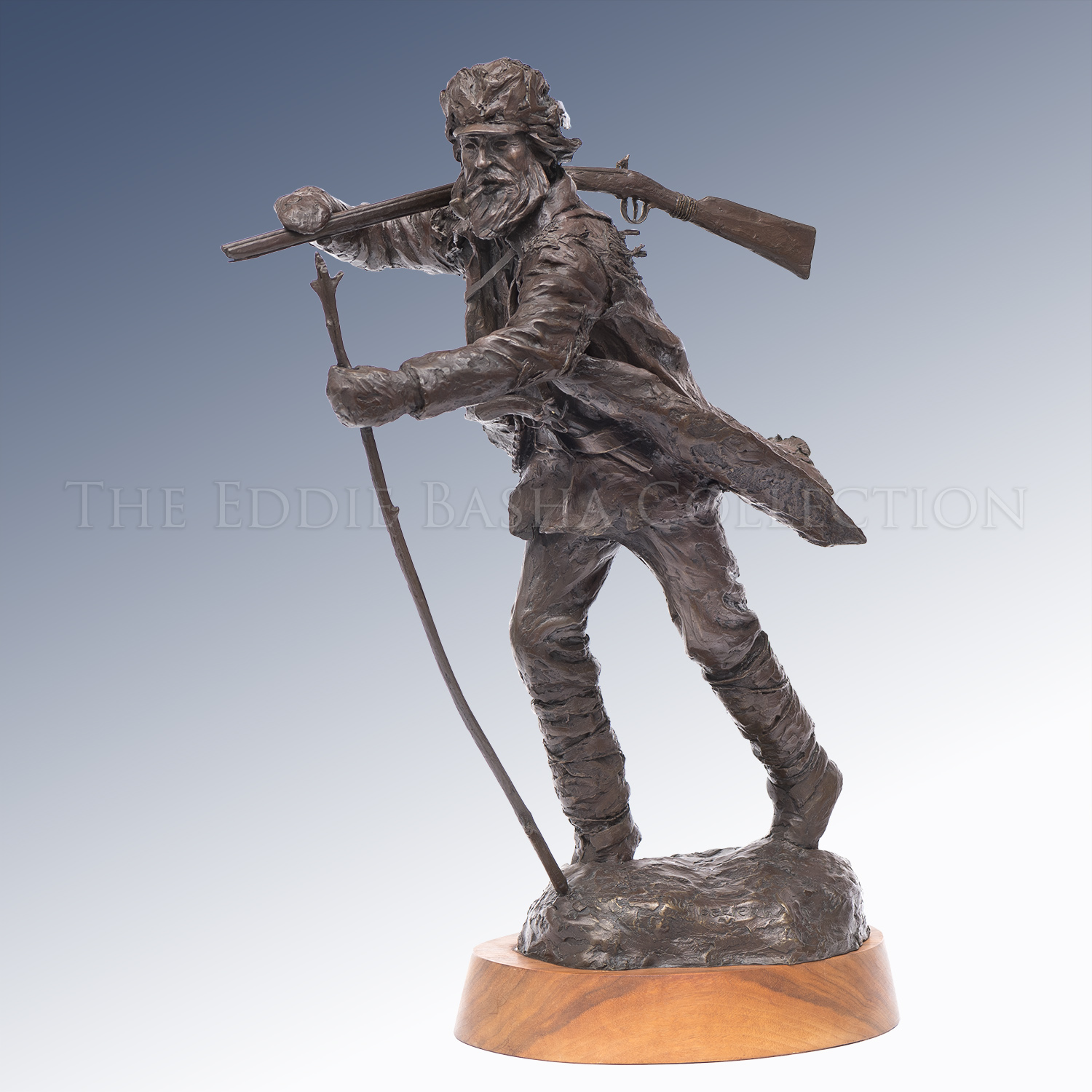
The Trapper or Into the North Wind
Artist: Joe Beeler, CA Founding Member (1931-2006)
Description: Bronze | Dimensions: 20”h x 10”w x 11”d; Edition #1 of 30bronze
“The Trapper” or “Into the North Wind” is a well done and realistic sculptural bronze portrayal of a trapper with his rifle slung over his shoulder, walking with the aid of a staff and smoking a pipe. His mittens attest to the fact that he is traveling in cold weather. Beeler has very effectively given the figure a sense of motion by pitching him forward simulating a walking gait.
Plaster Statue Massacre
Artist: Joe Beeler, CA Founding Member (1931-2006)
Description: Pencil | Image Size: 14”h x 12”w; Framed Size: 20 ¼”h x 19”wdrawing
In the book “Cowboy Artist: The Joe Beeler Story,” authored by Don Hedgpeth, published by Northland Press in 1979, the following explanation of this piece is provided: “But Joe’s career never did resemble that of an artist trying to make a name for himself in the traditional pattern. There was the incident of the “plaster statue massacre”. A dealer in Tulsa called and asked Joe to bring in some things for him to show a client. Joe loaded up some paintings and headed for Tulsa. When he got to the dealer’s shop, which specialized in plaster lawn statues, the client had not yet arrived. Joe said he would come back later, and went out to spend some time at the Gilcrease Museum.
At the Gilcrease, the Director, Jim Forrest, introduced Joe to W.B. Davis. Mr. Davis wanted to see Joe’s work and in short order purchased the painting “The Fugitive” which he presented to Forrest for the museum. Joe was delighted; he stopped to tell his Quapaw-Cherokee friend Louie Ballard about his good fortune, and together they went back to see the man at the plaster statue store.
The Tulsa dealer was mad as a hornet. It seems Mr. Davis was the client he wanted to show Joe’s work to. He felt Joe had gypped him out of a sales commission. The discussion became heated and the words began to fly fast and furious. Louie, Joe’s friend, made a comment or two to which the dealer replied, and as quick as that both men were rolling on the floor knocking over plaster statues right and left.
Joe pulled the dealer off Louie and fell backwards with him, knocking over plaster statues like a string of dominoes. This was all taking place in a big store window on a main Tulsa street. A crowd had gathered and police sirens could be heard off in the distance. Joe got up with a boot full of blood; his leg had been pierced by some wire on one of the statues. He and Louie left in a hurry, leaving the dealer among the chunks and dust of what had been a shop full of plaster statues.
#storytellers #theyrethebest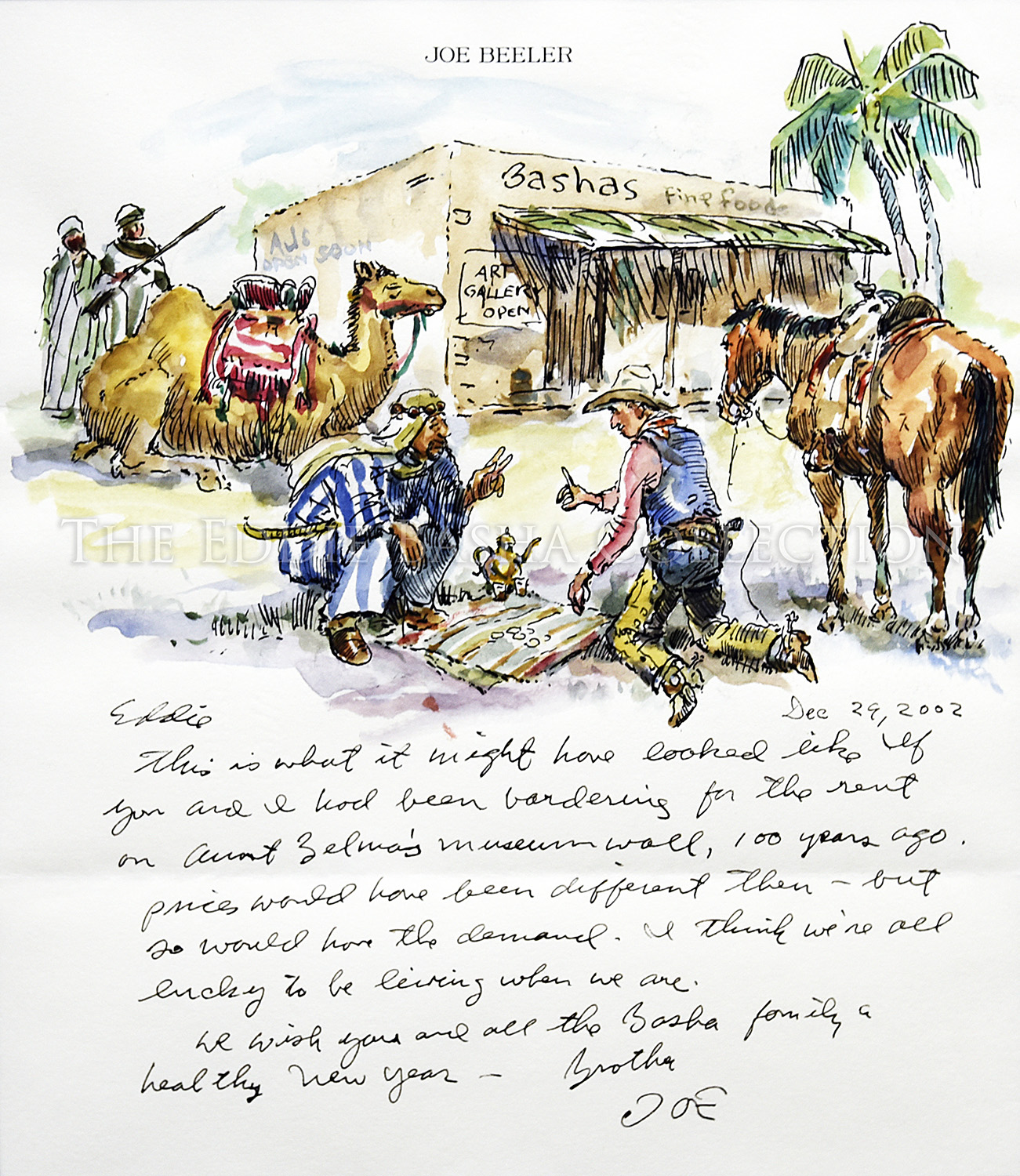
Bartering for Gallery Wall Space 100 Years Ago
Artist: Joe Beeler, CA Founding Member (1931-2006)
Description: Watermarker & Pen (2002) | Image Size: 11”h x 8 ½”w; Framed Size: 18 ¾”h x 16 ¼”wdrawing
#BeelerLetter #ArtistLetter #Humor #Banter #100YearsAgo #Bartering #GalleryWallSpace #RentalFee #Satire
Unknown Title
Artist: Joe Beeler, CA Founding Member (1931-2006)
Description: Oil | Image Size: 12”h x 18”w; Framed Size: 18 7/8”h x 24 3/4”wpainting
Joe Beeler, a founding member of the Cowboy Artists of America, used contrasting bands of color and bright shafts of sunlight set against an ominous sky to set the stage for a lone cowboy to survey the storm that missed the dry, brittle land before him. Beeler used this and similar themes in various ways; one of the more famous was titled “Thanks for the Rain” which he painted and sculpted.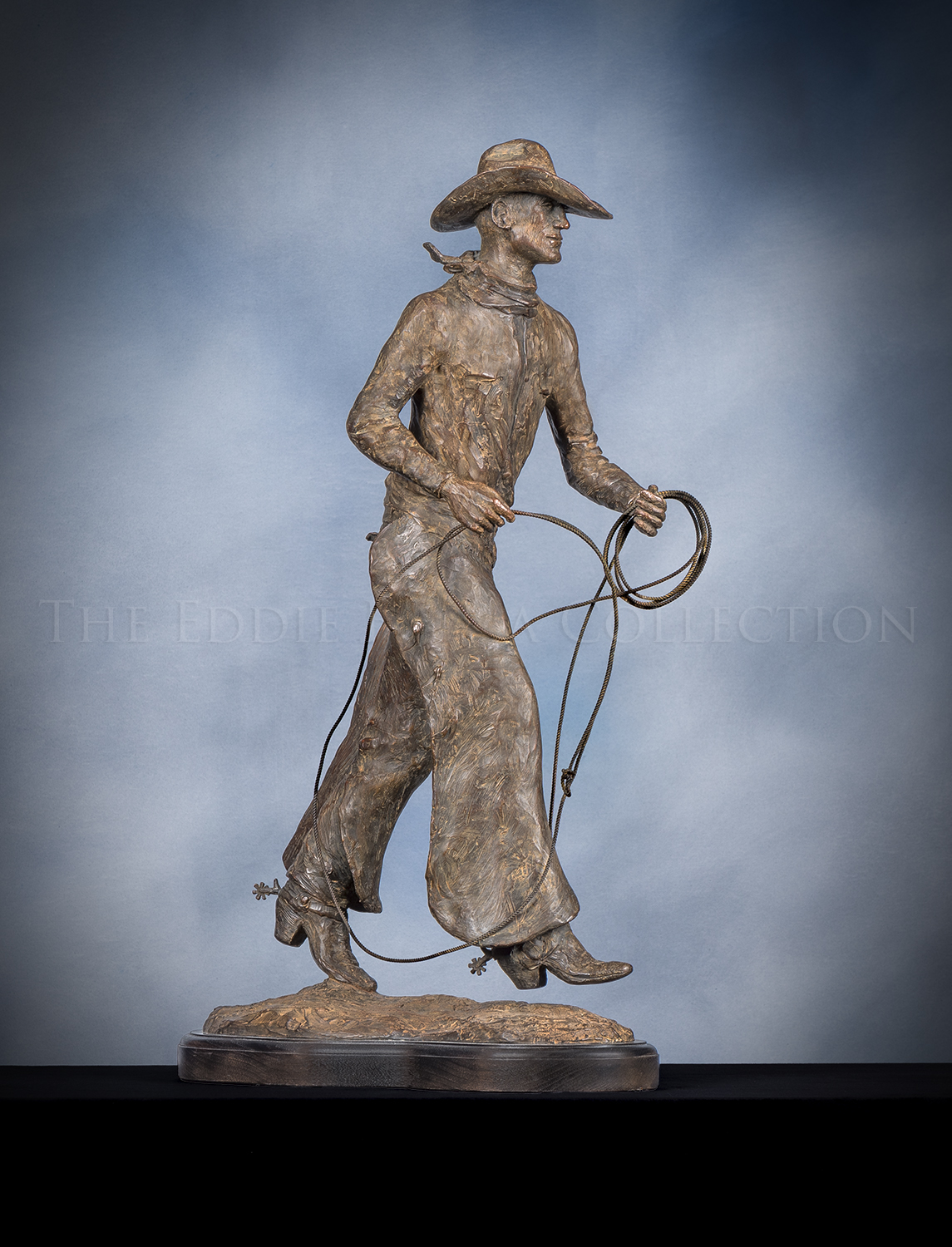
Monday Morning
Artist: Joe Beeler, CA Founding Member (1931-2006)
Description: Bronze | Dimensions: 29”h x 16”w x 9”d; Edition #1 of 45bronze
This relatively large bronze shows a long, tall and lean cowboy walking forward, with lariat in hand, ready to begin his work on a “Monday Morning”. Wearing long chaps and with a spring in his step, Joe Beeler gave his subject a sense of movement by balancing the cowboy mid-stride on his back foot while the front is in the air.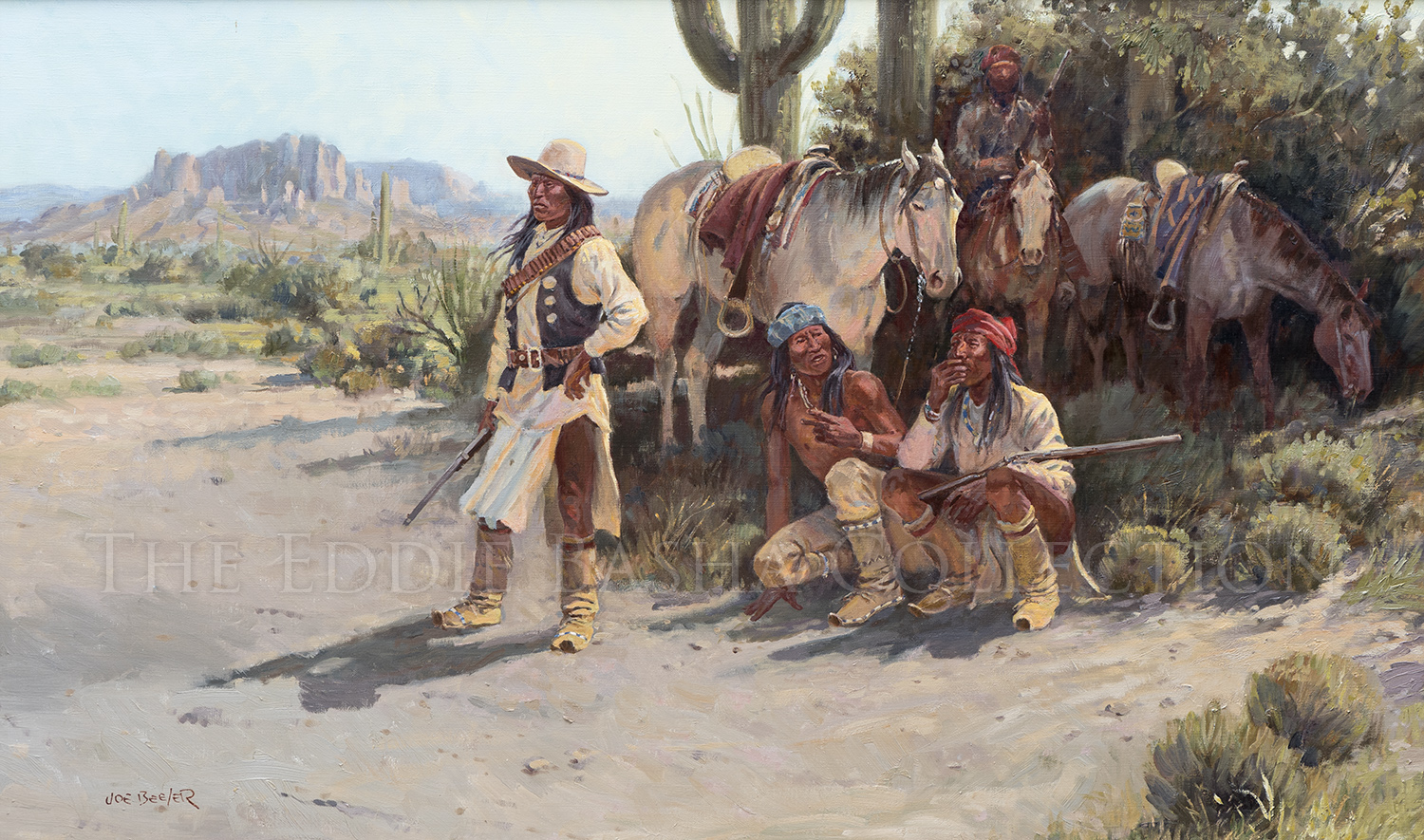
The Lost Trail
Artist: Joe Beeler, CA Founding Member (1931-2006)
Description: Oil | Image Size: 24”h x 40”w; Framed Size: 35”h x 51”wpainting
Cowboy Artists of America Founding Member Joe Beeler creates a very realistic desert landscape in this oil painting of three Apache trackers who have lost the trail. They have stopped in a dry river bed and have tethered their horses under the shade of a few scrub trees and towering Saguaro cacti. Two crouch in the shade in the right foreground, while one stands in the riverbed contemplating their next move. They are dressed in traditional clothing that is appropriate to the time period. Known for his ability to weave visual stories of the historic west and of his realistic handling of figures, here Beeler also shows his adept skills in showcasing the landscape in which he has perfectly captured the desert environment.
“The Lost Trail” was exhibited at Western Spirit Scottsdale’s Museum of the West exhibition entitled The Art of Joe Beeler: A Western Original Retrospective in 2018 and an image of the painting also appears in the book entitled Joe Beeler: Life of a Cowboy Artist authored by Don Hedgpeth and published by Diamond Tail Press in 2004.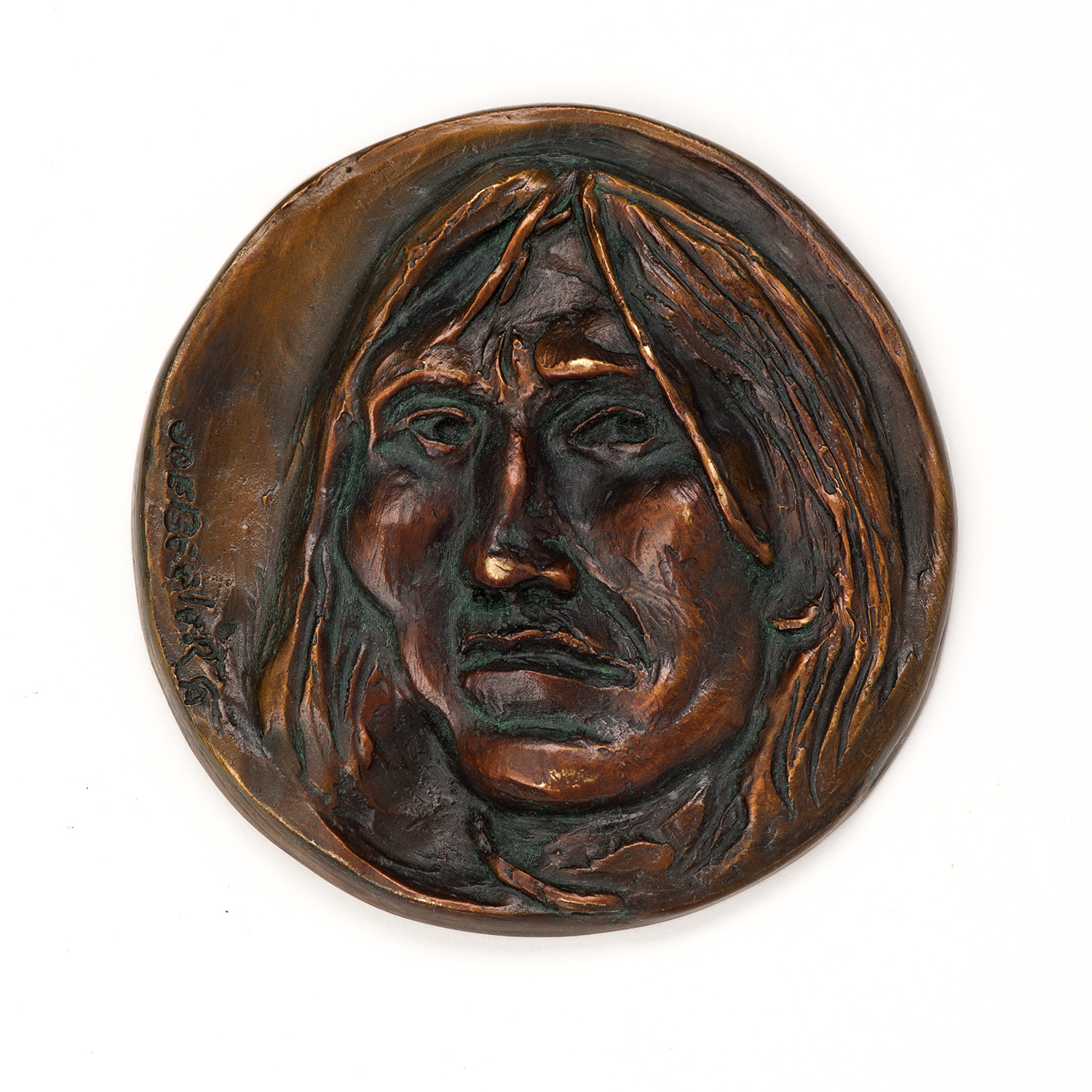
Yavapai
Artist: Joe Beeler, CA Founding Member (1931-2006)
Description: Bronze (1996) | Dimensions: 3 ½” Diameterbronze
The year was 1996 when this medallion was sculpted by CAA Founding Member Joe Beeler, cast in bronze at the Bronzesmith Fine Art Foundry & Gallery in Prescott, Arizona, and subsequently gifted by Eddie Basha.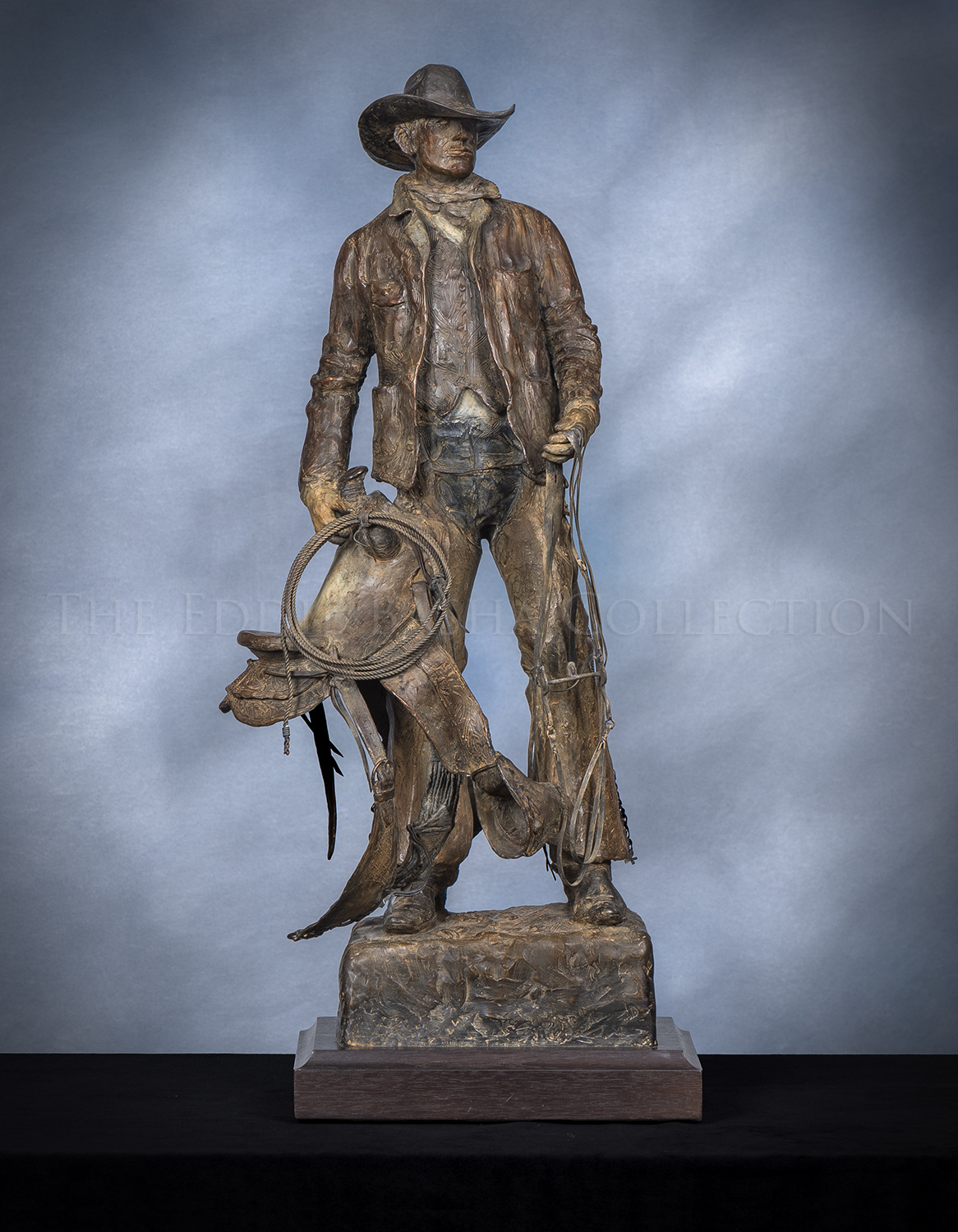
Ready to Ride
Artist: Joe Beeler, CA Founding Member (1931-2006)
Description: Bronze (2005) | Dimensions: 26”h x 12”w x 8”d; Edition #1 of 40bronze
With this relatively large, full length portrait sculpture, Joe Beeler has created the quintessential cowboy. The cowhand is lean and strong and carries the tools of his trade; a saddle, lariat, bridle and halter. The pose is characteristic of a seasoned hand and communicates an attitude of being ready for any circumstance. This man is no drugstore cowboy, but the real deal.
The Elder
Artist: Joe Beeler, CA Founding Member (1931-2006)
Description: Bronze | Dimensions: 27”h x 11”w x 10”d; Edition #1 of 25bronze
Joe Beeler was a thorough reader and researcher in the subject of nineteenth century American Indian history and culture. He frequently used his knowledge of the subject to produce evocative and historically accurate portraits and sculptures of nineteenth century Indians from many different tribes. Here, he presents an elder from a Northern Plains tribe who is wrapped in a buffalo robe. He is holding an eagle wing fan and wears an impressive bear claw necklace—both items indicate his high stature within the tribe. The sculpture shows his full length figure and depicts the subject with respect and sensitivity. It is very well done and has an impressive presence about it.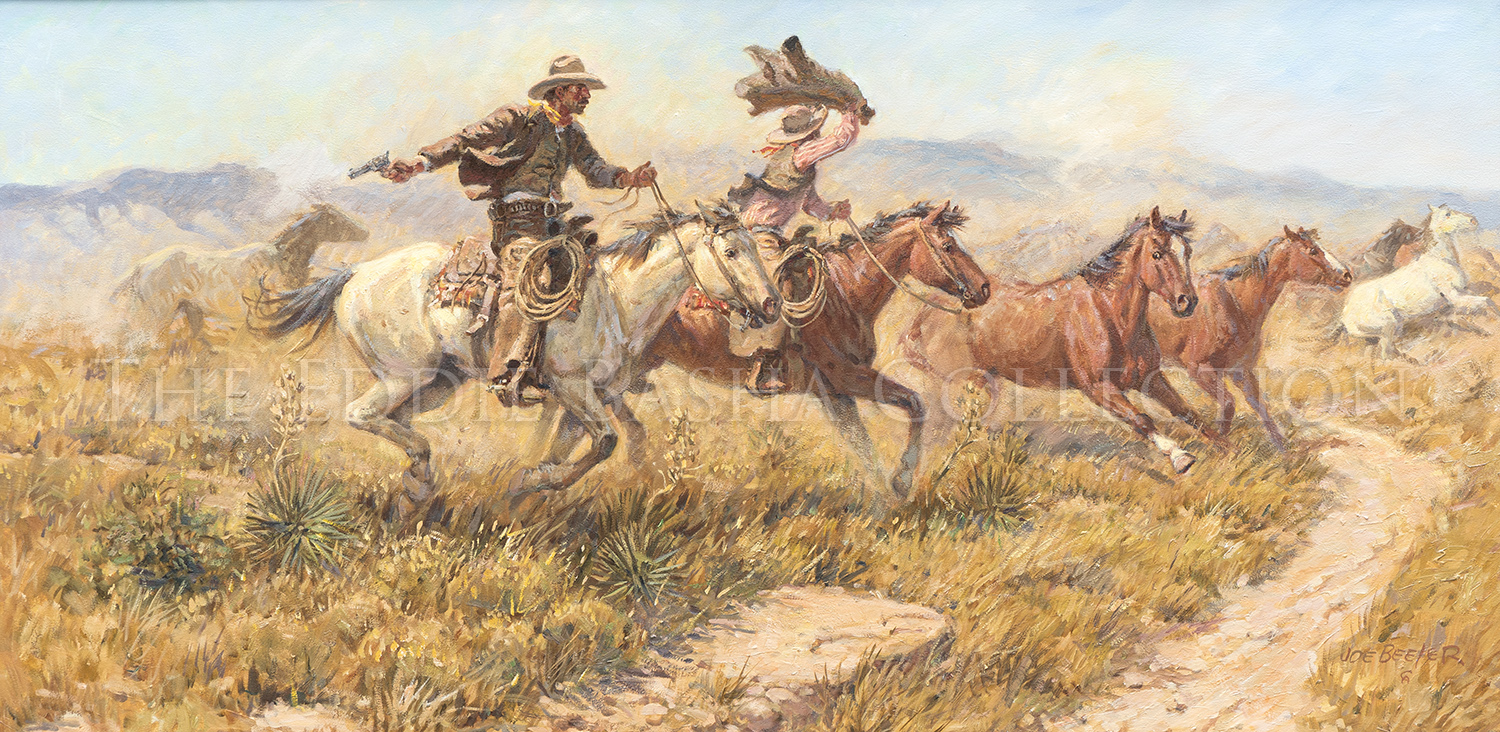
Horse Thieves
Artist: Joe Beeler, CA Founding Member (1931-2006)
Description: Oil (1974) | Image Size: 20”h x 40”w; Framed Size: 29 ¾”h x 43 ¾”wpainting
While one cowboy fires his sidearm to spook the horses, the other wildly waves his jacket high over his head to keep the stolen horses moving rapidly. In this dangerous business, speed was of the essence. The men and horses truly seem to be racing across the landscape of muted and dusty tones. The story being presented is one of intense action and drama and Joe Beeler has put the viewer right in the middle of the adventure.
Horse Thieves was exhibited at The University of Texas at San Antonio Institute of Texan Cultures, a Smithsonian affiliate, in 1985. Now a part of the permanent collection of the EBC, a signed and numbered (15) exhibition book titled “Joe Beeler: In the Cradle of the Cattle Kingdom” remains a part of our gallery library.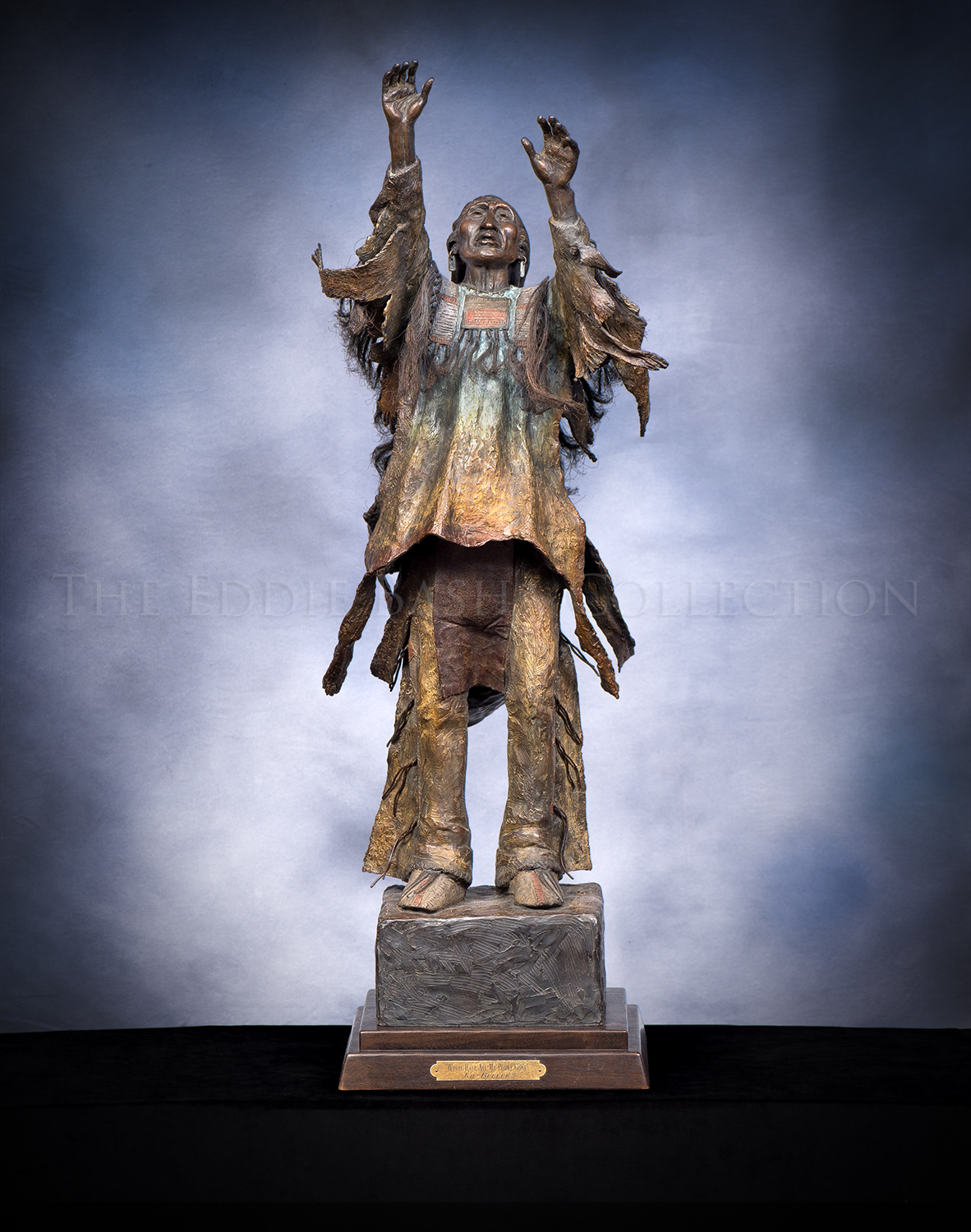
Where Have All My people Gone
Artist: Joe Beeler, CA Founding Member (1931-2006)
Description: Bronze | Dimensions: 40 ½”h x 18 ½”w x 12”d; Edition #1 of 45bronze
Longhorn
Artist: Joe Beeler, CA Founding Member (1931-2006)
Description: Bronze | Dimensions: 6 ½”h x 10 ½”w; Edition #4 of 30bronze
Did you know that longhorns, male and female, have horns? They will vary in shape and length according to gender and can range anywhere from 40 to 80 inches. Calves may begin the horn sprouting process as early as three weeks and its horns will continue to grow throughout its lifetime.
An image of “Longhorn” also appears in the book entitled “Cowboys and Indians: Characters in Oil and Bronze” which was authored by Joe Beeler and published by University of Oklahoma Press in 1967.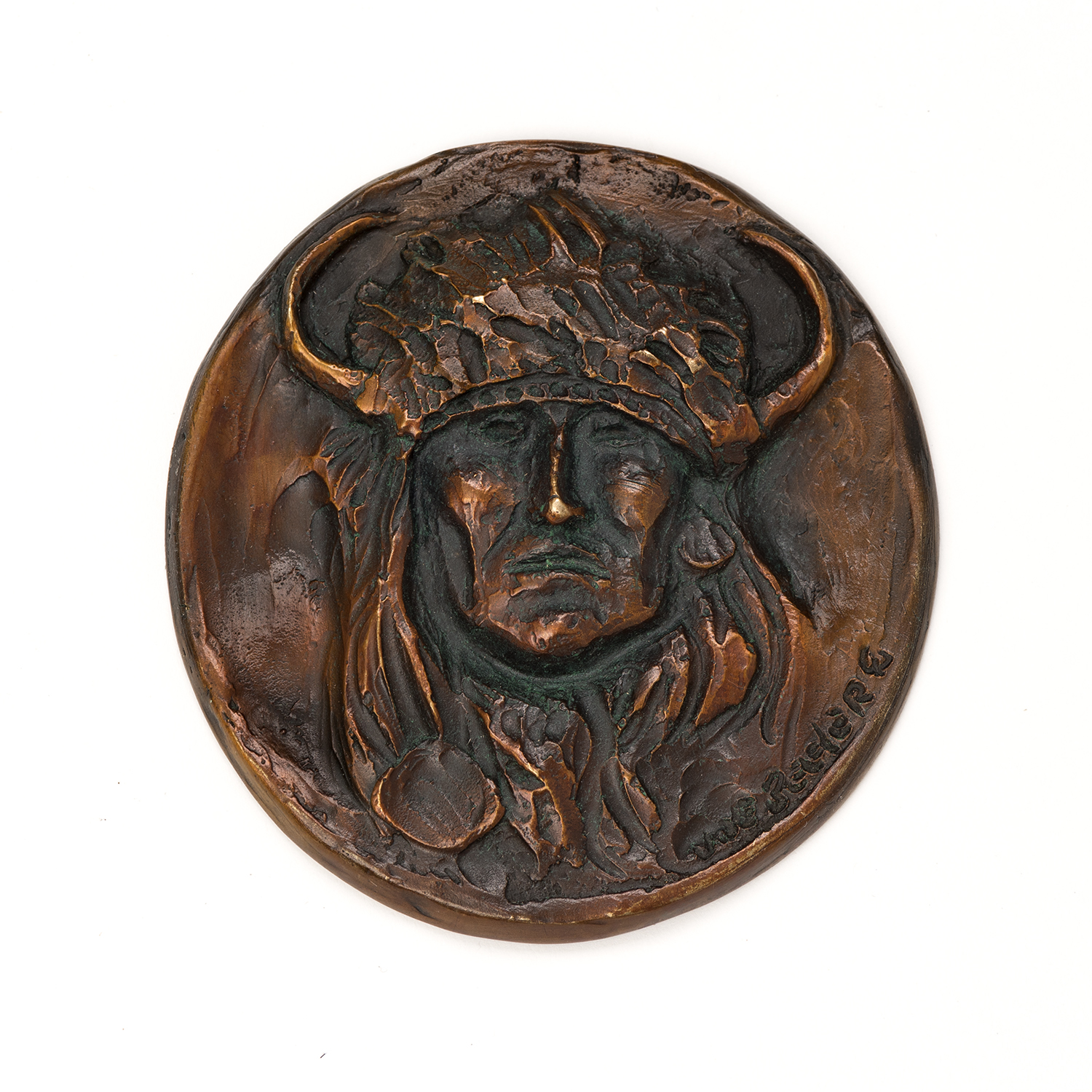
Buffalo Horn Headdress
Artist: Joe Beeler, CA Founding Member (1931-2006)
Description: Bronze (1995) | Dimensions: 3 ½” Diameterbronze
Headdresses were not worn in battle as it would have been impractical to do so. Distinguished or highly regarded warriors who “earned” a bonnet would wear it during ceremonial or spiritual practices. The horned bison hide bonnets were often embellished with “earned” accoutrements such as fur, tails trailing behind, ermine skins and feathers. In this 1995 medallion, Beeler shared a unique headdress proudly worn by its victor.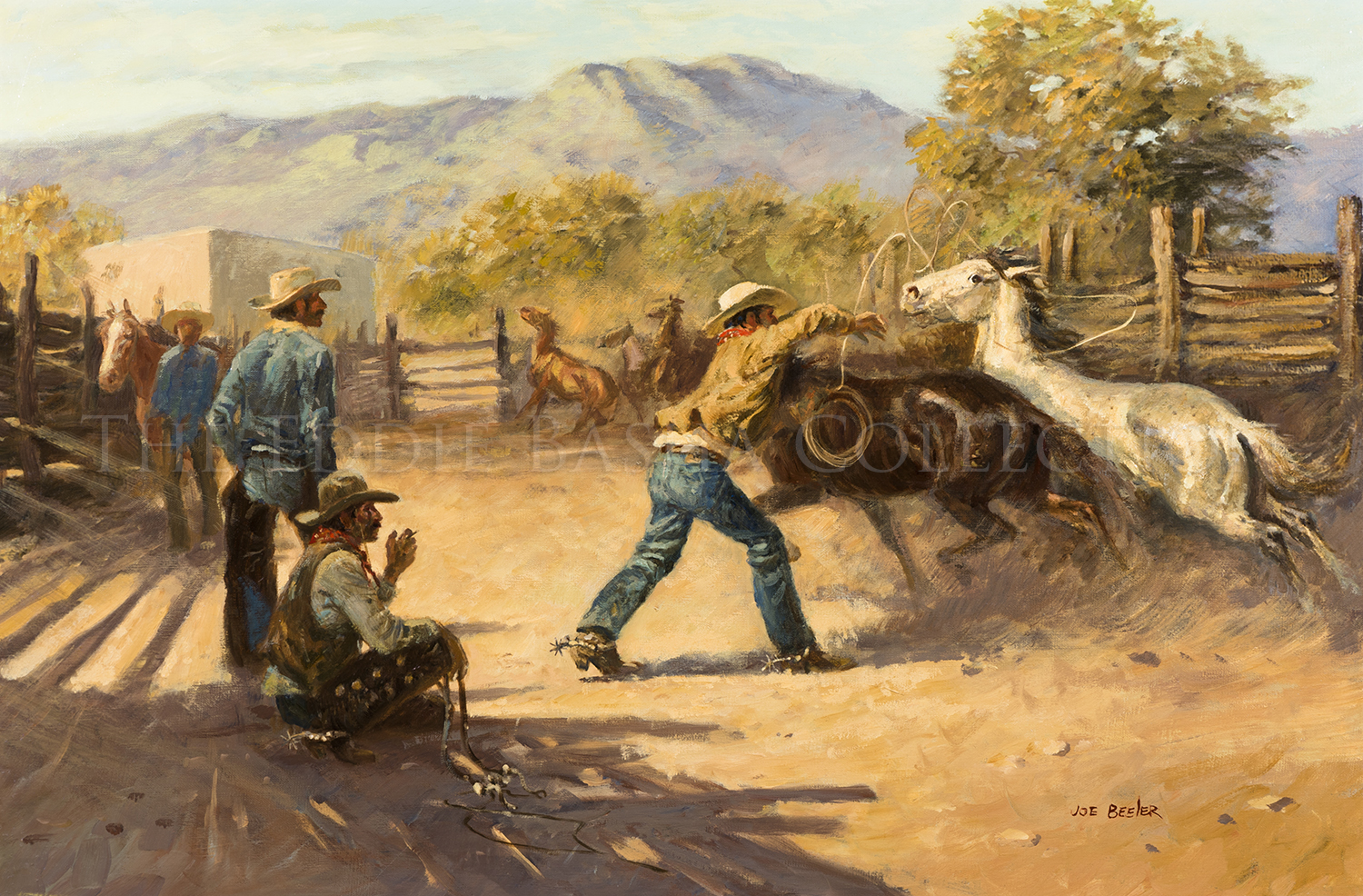
In the Corral
Artist: Joe Beeler, CA Founding Member (1931-2006)
Description: Oil (1965) | Image Size: 20”h x 30”w; Framed Size: 28 ¾”h x 38 ¾”wpainting
It was at this ranch in November of 1964 where the formulation of the Cowboy Artists of America idea was first discussed in earnest by artists Joe Beeler, John Hampton and Charlie Dye. Subsequently, the CAA was officially formed in June 1965. And in his book, “Cowboys and Indians: Characters in Oil and Bronze” by Joe Beeler, published by University of Oklahoma Press 1967, Beeler wrote the following about “In the Corral”: “Just about everything having to do with the cowboy, his gear, and his work is related somewhere up the line to the Spaniards or Mexicans, for either they invented it or named it. They also could us it pretty well, too, and the vaquero is a good man to watch today in studying horse handling and roping.
This painting was done from scenes I witnessed and participated in while working a roundup on a ranch in Sonora, Mexico. A couple of other artist friends, John Hampton and Charlie Dye, and I were the guests of an American rancher in Mexico, George Douglas.
The fellow doing the roping was the foreman. He was the best fed and had the biggest mustache and did all the roping in the horse corral, catching each cowboy’s mount for that day. He used a rawhide riata or “gut line,” as it is sometimes called. Of the fifteen or so cowboys, all but one used the rawhide; the one exception had an old, worn nylon. I was amazed to see this fellow stand, what seemed to me, too far away and flip his little thin rope far off into one corner of the corral and reel in a horse caught cleanly around his throat. The Mexican hands were artists when it came to dallying and handling cattle with these small rawhide ropes.
None of the horses looked too gentle and many were not. They were small and wiry and tough as a boot. These boys seemed to like a little “pitch” in their horses in the morning and delighted in putting on a little show when the opportunity presented itself. They were a light-hearted bunch to work with, and even though it became very cold during the roundup and they were dressed for sunny weather, they never lost their sense of humor.”
This Beeler masterwork along with several others will be a part of the Anniversary Exhibition next year of the Cowboy Artists of America at the Briscoe Museum in San Antonio, May 27 through September 5, 2022!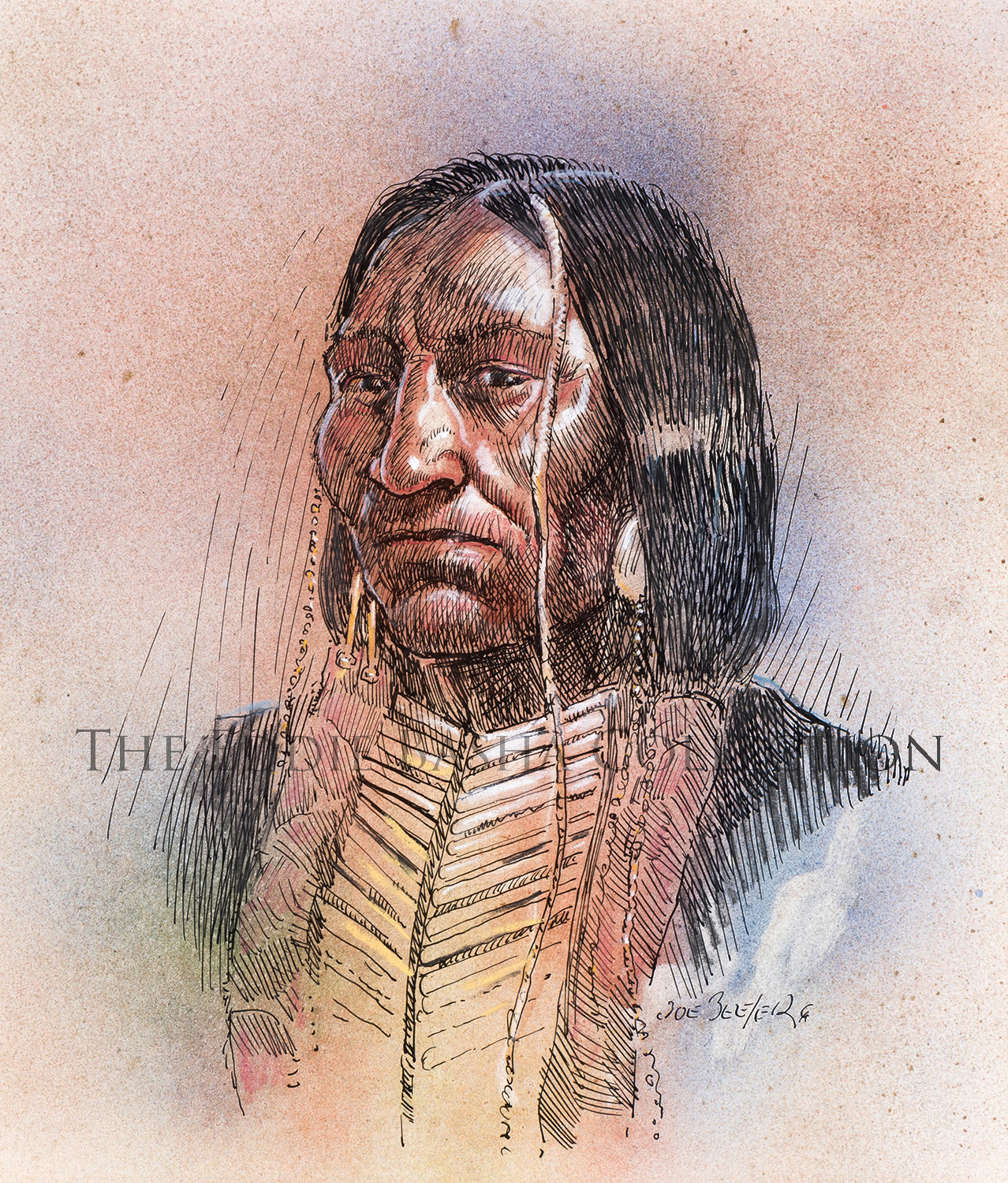
Unknown Title
Artist: Joe Beeler, CA Founding Member (1931-2006)
Description: Ink, Watercolor & Pastel | Image Size: 12”h x 11”w; Framed Size: 23 1/8”h x 21 5/8”wpainting
This well done, multi-media portrait by CA Founding Member, Joe Beeler, of a Plains Indian with braided hair and wearing a bone breastplate has a somber facial expression, but one that highlights the subject’s lined, weathered and weary features. His life experiences and story are left up to those who view it.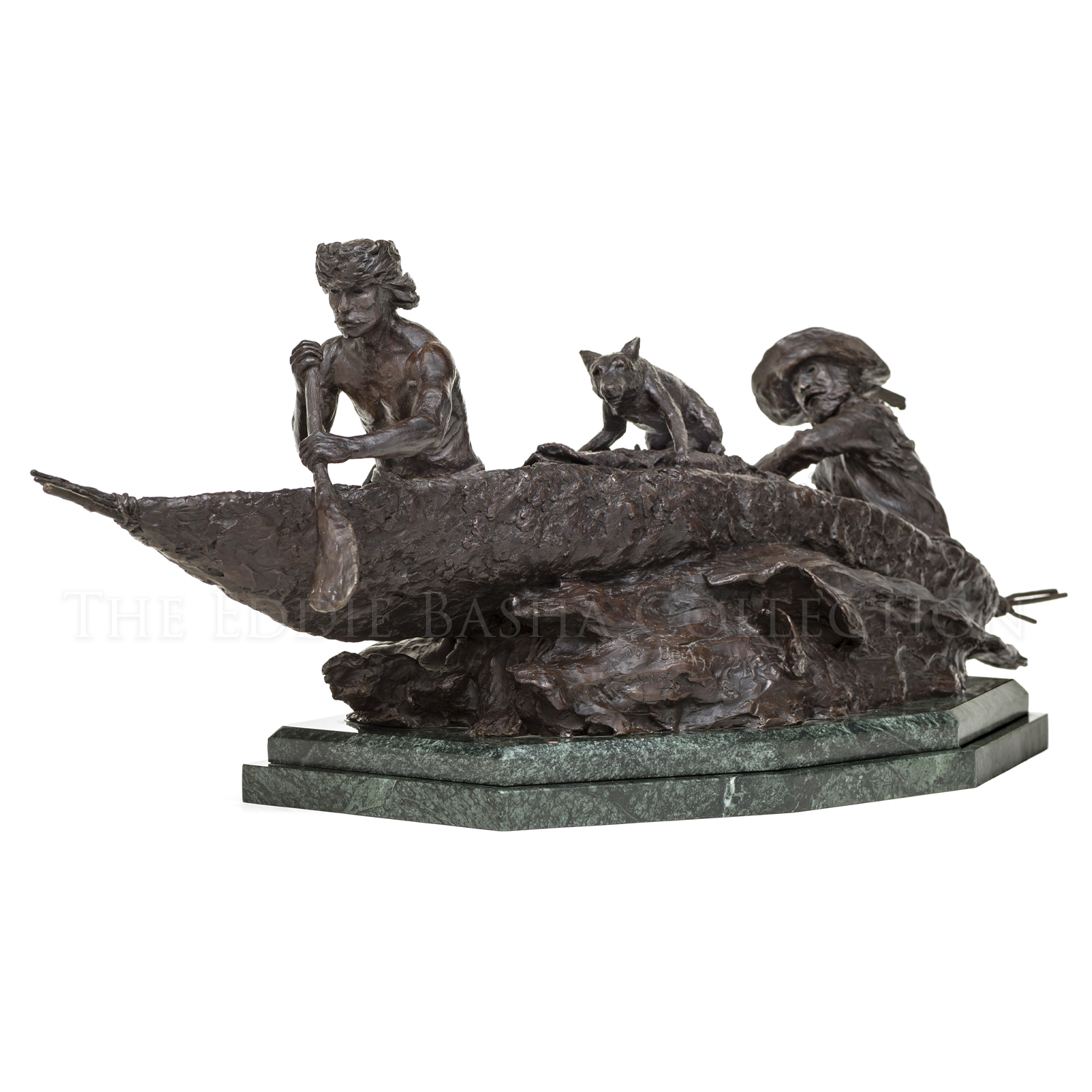
Down the Snake
Artist: Joe Beeler, CA Founding Member (1931-2006)
Description: Bronze (1974) | Dimensions: 10”h x 32”w x 9”d; Edition #1 of 22bronze
Making its debut in 1974 at the 9th Annual Cowboy Artists of America Show & Sale held at the Phoenix Art Museum and subsequently exhibited at the Phippen Museum in 2018 in its “Cool, Cool Water’ Exhibition, Joe Beeler’s bronze captures two trappers traveling down the Snake River with their dog poised between them adding a small touch of humor along with the realism. Beeler has quite effectively created the illusion of a canoe moving over rapids and its oarsmen bending to the task.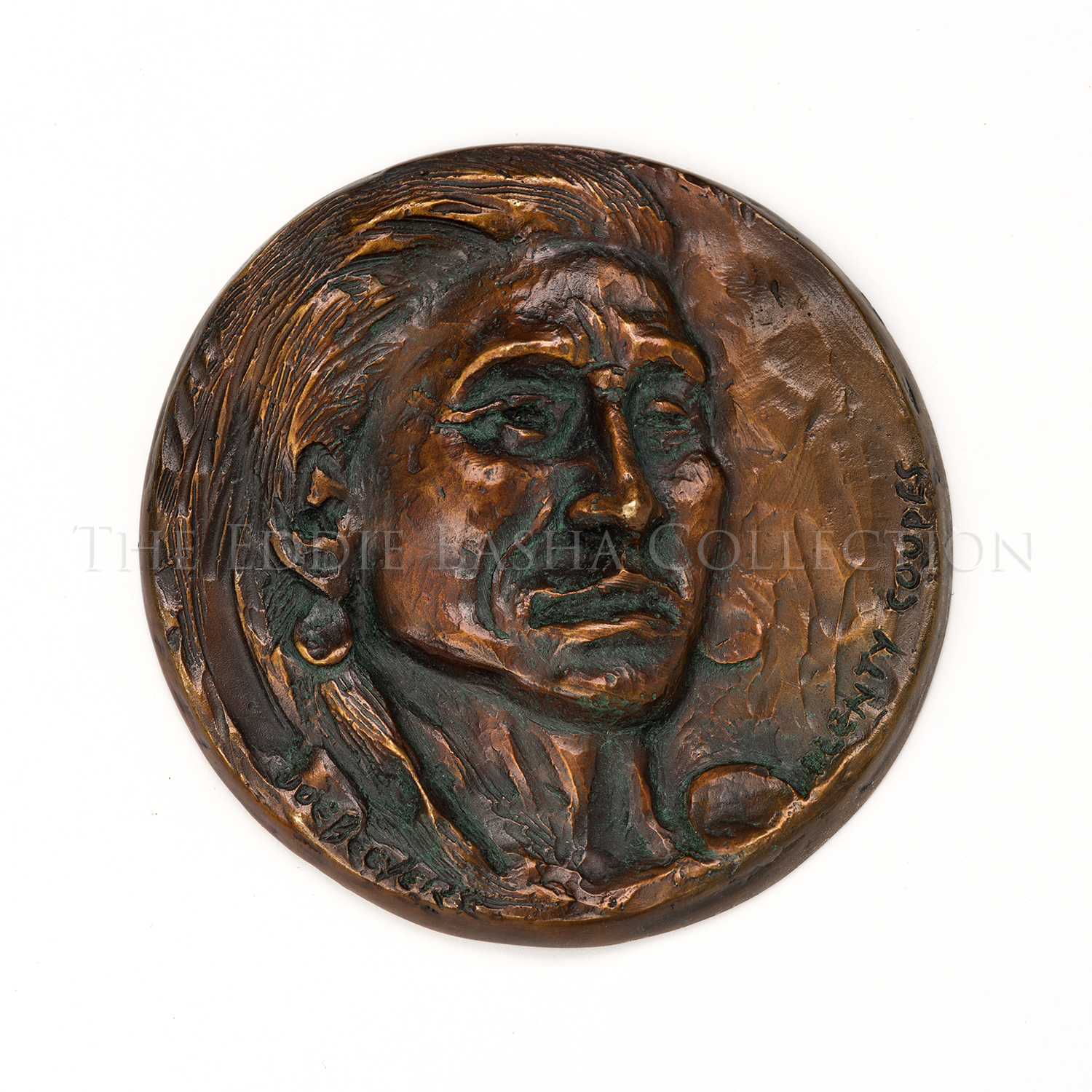
Plenty Coups
Artist: Joe Beeler, CA Founding Member (1931-2006)
Description: Bronze Medallion (1994) | Dimensions: 3 ½” Diameterbronze
Source: National Park Service
The Apsalookee (Crow) people arrived in Bighorn country in very early times and remained. They called this place home-the best place in the entire world. From their arrival in the early 1700's they were constantly challenged by strong tribes from every direction. From the north and west they fought Assiniboine, Blackfeet, and Flatheads. From the east, the Sioux and Cheyenne were constantly at war with them. Fortunately, the Crow have been blessed with great leaders. One of these leaders was Chief Plenty Coups who was born in 1848, a time of great change for the tribe.
By the time Chief Plenty Coups was born, the Crow tribe had been devastated by unrelenting outbreaks of smallpox from contact with Euro-Americans. Their population had dwindled by at least eighty percent, down to at most two thousand people. Surrounded on all sides by enemy tribes, the Crow were in dire need of allies. As a young man, Plenty Coups went on a vision quest where he foresaw the disappearance of the buffalo and cattle eventually covering the Plains. In this vision he also witnessed a strong wind blowing all the trees down in a forest, except for one. He interpreted this to mean the white man would take over the land, just as the wind had swept away all the trees in the forest. The only one left would be the Crow, but only if they worked with them. Plenty Coups vision would help bridge the gap between two distinct cultures. Recognized for his bravery and leadership he was made a chief of the Apsalookee (Crow Tribe) by age 28.
Historically, the Crow people had been friendly with the mountain men and fur traders who passed through the area. They soon befriended the U.S. Government in the area, serving as mail couriers for soldiers at Fort C.F. Smith and guided explorers safely through the area. Plenty Coups counseled that they side with the U.S. government forces throughout the Indian Wars. They brought warnings of attacks by the Sioux and Cheyenne. For help in the Indian Wars, the U.S. Government promised to reserve land in the valley of the Bighorn River and Bighorn Mountains for the Crow people. By the middle of the 1880's the Crow Indians had moved to their reservation along the Yellowstone Valley of Montana. When Plenty Coups gave up his nomadic ways in 1884 he became one of the first Crow to work and settle on a farm, which was deeded to him through the Federal Indian Allotment Act. On his 320 acre tract, located a half mile east of Pryor, Montana he opened a general store, built a home, and began farming.
Nonetheless, Plenty Coups still had to help his people not only adapt to life on the reservation, but also fend off powerful interests that wanted to take the reservation land from the Crow people. The Crow had already lost a majority of their original 38 million acre reservation. By the early 20th century the reservation was down to 1.8 million acres. In 1910, Montana Senator Thomas Walsh introduced a bill to open up the rest of Crow Reservation to white homesteaders. Plenty Coups was determined to fight Walsh’s efforts. He knew he needed educated young men with knowledge of the law to help. He called on Robert Yellowtail to assist in the battle. After seven long years Chief Plenty Coups, Yellowtail, and other tribal members stopped legislation that would open the Crow Indian reservation to general homesteading. The loss of reservation land had finally been stopped. Plenty Coups continued to defend the rights of his community and expressed no second thought about his lifelong conciliatory policy toward the whites, stating “When I think back, my heart sings because we acted as we did.” Upon his death in 1932, at the age of 84, the Apsalookee (Crow) people voted to designate him as their last traditional tribal chief.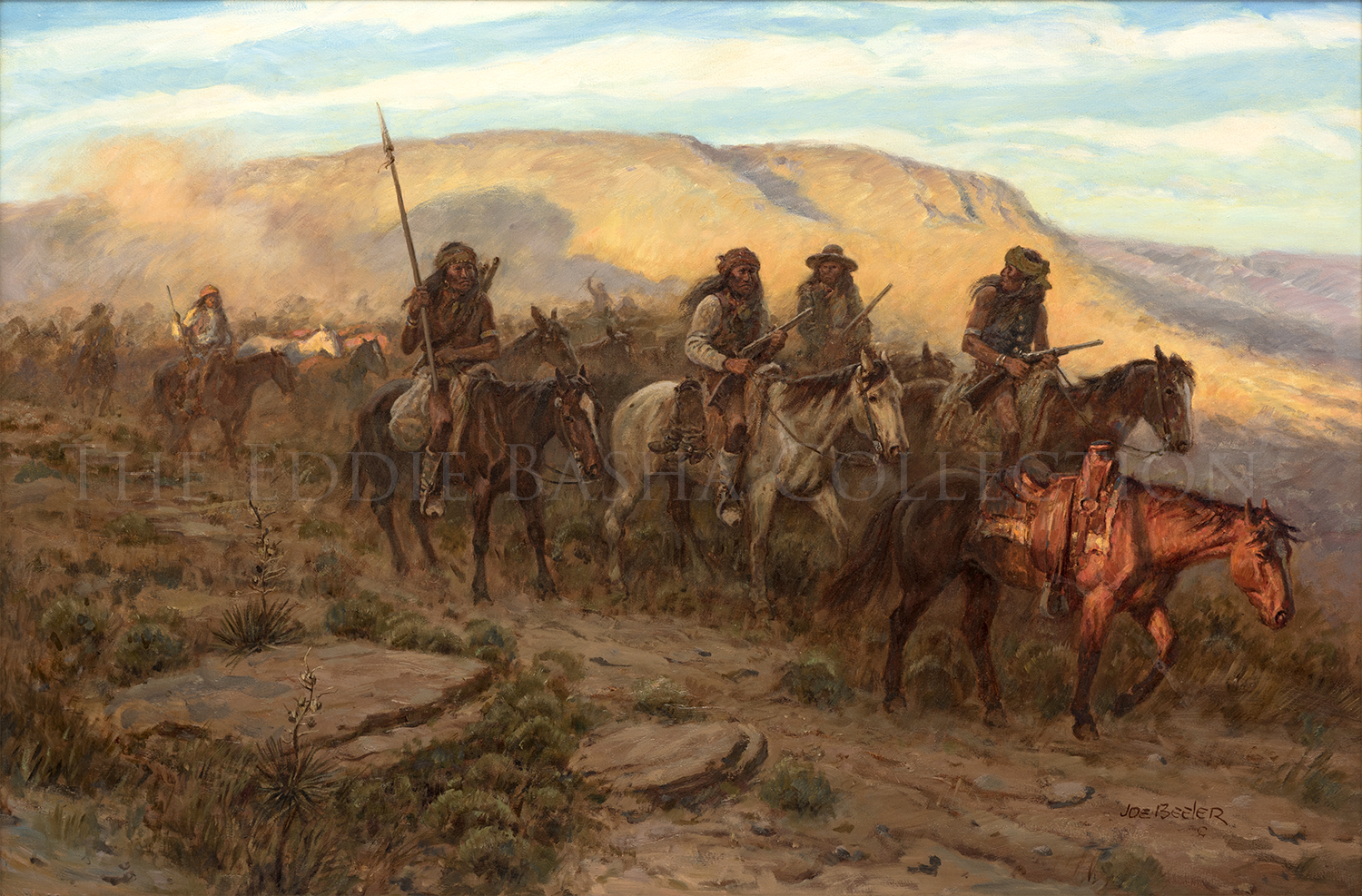
Plunderers
Artist: Joe Beeler, CA Founding Member (1931-2006)
Description: Oil (1972) | Image Size: 24”h x 36”w; Framed Size: 34 ¼”h x 46 ½”wpainting
In this masterwork oil painting of an Indian raiding party, Beeler conveys a sense of movement by placing his riders in a line from the right foreground of the painting to the distant left middle ground. His use of light and shadow adds dramatic effect with the raiding party shown in dark shadows and capped by the brightly sunlit background of distant mountains. A captured horse is placed just ahead of the figures and is brightly lit, a technique that rivets the viewer’s eye on the horse and draws him into the narrative of the tale.
“The Plunderers” first appeared in the7th Annual Cowboy Artists of America Show & Sale (1972) at the National Cowboy & Western Heritage Museum in Oklahoma City, Oklahoma, and was exhibited again at the Gilcrease Museum in 1980. It remains a much lauded painting at The EBC.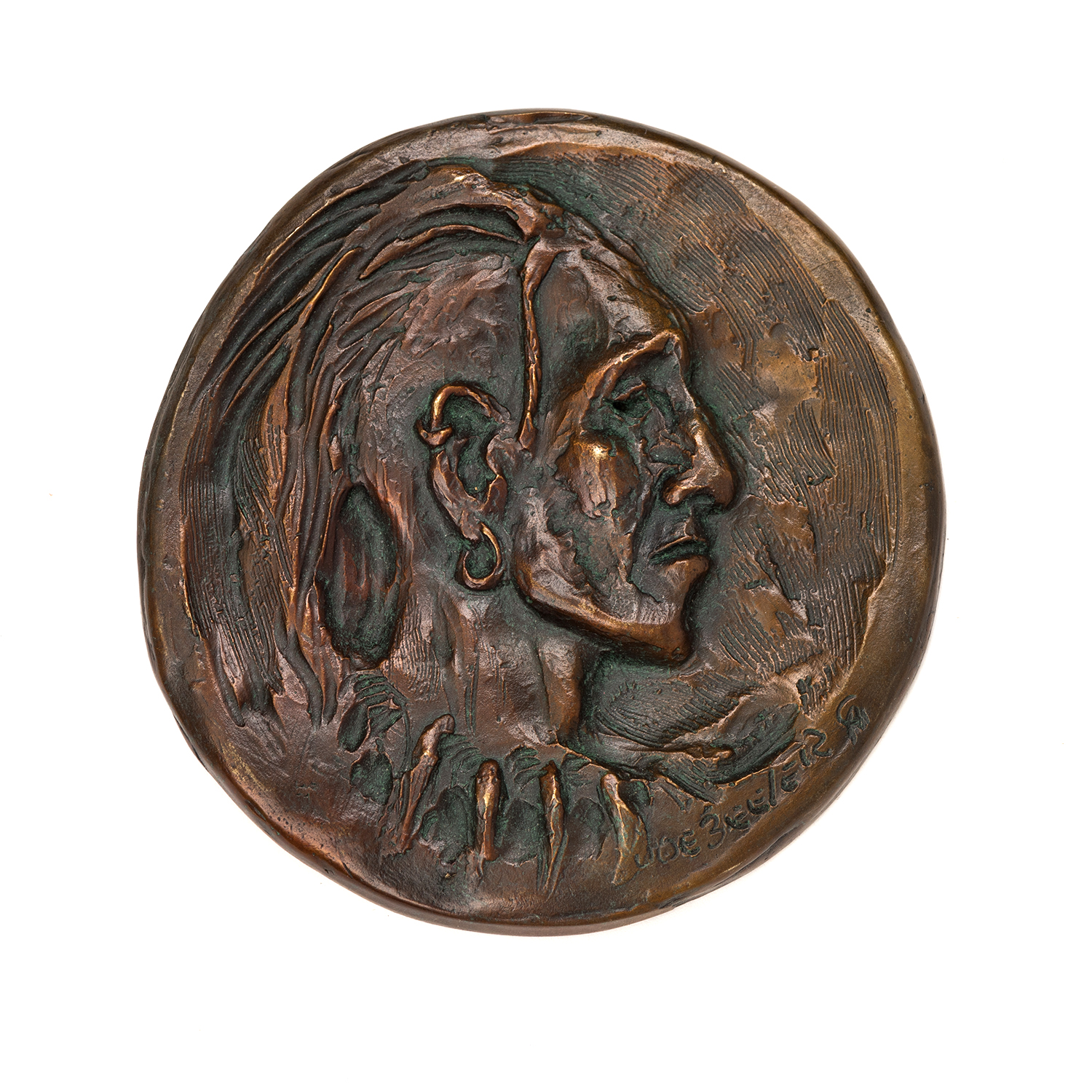
Medallion
Artist: Joe Beeler, CA Founding Member (1931-2006)
Description: Bronze (1993) | Dimensions: 3 ½” Diameterbronze
“Similar to the status symbolism of buffalo horn and eagle feather bonnets, bear claw necklaces were worn by distinguished Pawnee, Otoe, and Omaha men as emblems of their accomplishments, honors, and roles as leaders. Pawnee men, in particular, specialized in creating bear claw necklaces made from the long, broad claws of grizzly bears that once roamed the Central and Eastern Plains and guided the wearer during warfare, treaty negotiations, and other important events.
The Pawnee, like other Plains Indian people, held grizzly bears in high esteem because of their strength, power, and fighting abilities—qualities universally admired by Native warriors. Before going into battle, Pawnee warriors sought the sacred protection of animal spirits such as wolves, eagles, mountain lions, or bears—each with their own unique powers. According to Pawnee cosmology, there are four great powers represented by the stars and constellation of the sky: wolf, mountain lion, wildcat (bobcat), and bear. Pawnee men believed that, in order to find success as warriors, they required the defining characteristics of these four animals: the stealth and craftiness of the wolf, the magnetic or drawing power of the mountain lion, the cunning of the cat, and the strength of the bear. In addition to its great strength, Pawnee warriors admired the bear for its ferocity and invulnerability. Through visions, spiritual teachings, and ceremonies, men could learn about and eventually possess the special powers of the bear, including the ability to heal wounds and cure sickness. Men believed that wearing the bear claw necklaces protected them from being hit by arrows and bullets in battle.”
Source: Buffalo Bill Center of the West (March 19, 2014 by Emma Hansen)
Brush Country Cowpuncher
Artist: Joe Beeler, CA Founding Member (1931-2006)
Description: Pen 7 Ink | Image Size: 14”h x 20”w; Framed Size: 23 ½”h x 29 ½”wdrawing
This medium-sized pen and ink drawing shows Beeler’s knowledge of horses and cowboys and portrays both with precision and realism. With lariat in hand and chaps to protect his legs from the surrounding cacti, the cowboy rides through the rough brush country searching for strays.
Prior to CA Artist, Jason Scull, reaching out to the EBC in April 2021, we did not have the title of this piece. Jason recollected the image when he saw it on social media and contacted the EBC. He shared the following information with us: During the mid-eighties at the Institute of Texan Cultures in San Antonio, now the Briscoe Western Art Museum, a Joe Beeler exhibition was held entitled “In the Cradle of the Cattle Kingdom” which was accompanied by a catalogue. Jason happened to have a copy of that exhibition catalogue and in it this piece appeared with the title cited. Thank you Jason for recollecting the image and reaching out to us so that we could appropriate it with its rightful title!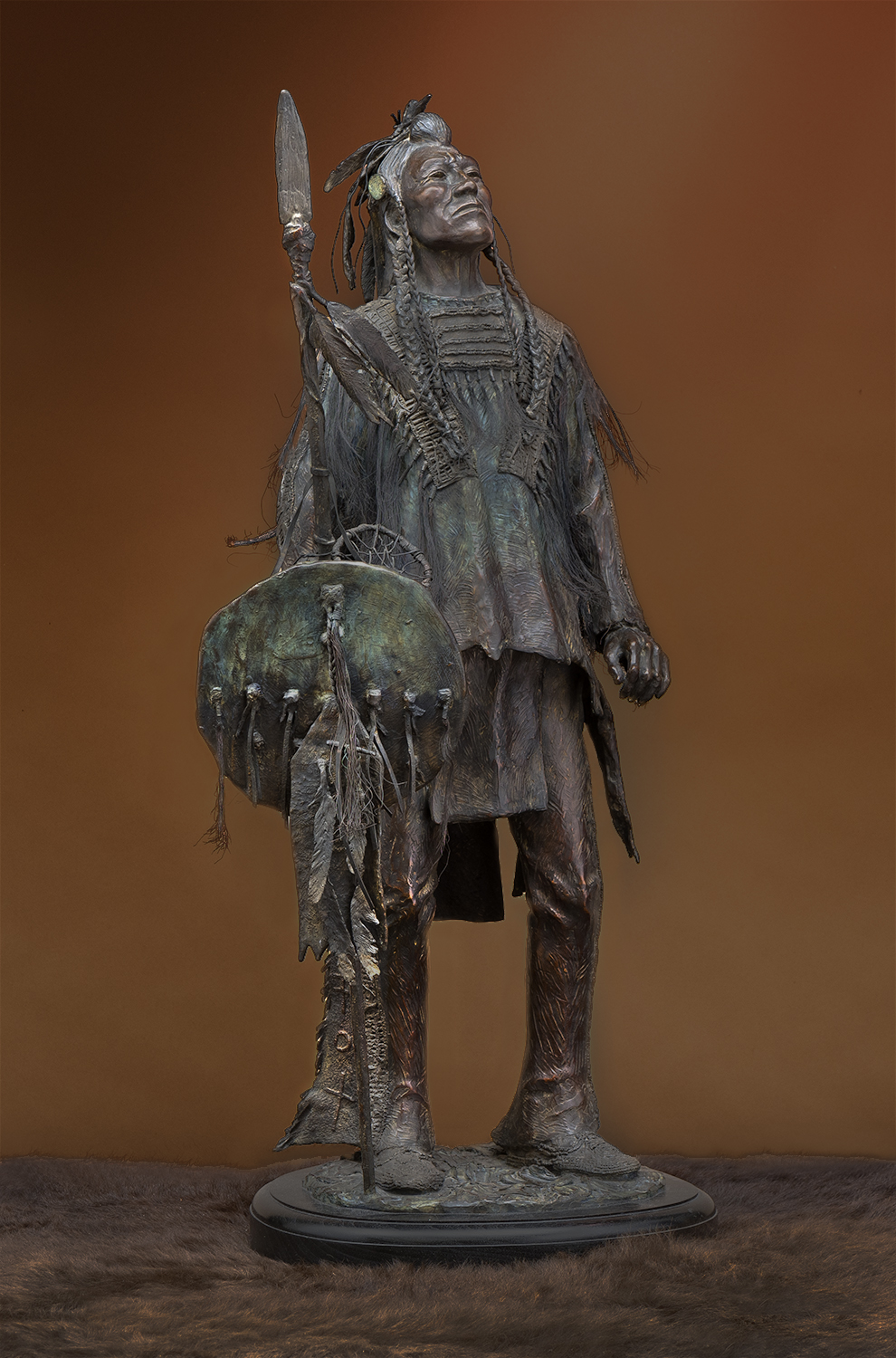
Voices in the Wind
Artist: Joe Beeler, CA Founding Member (1931-2006)
Description: Bronze | Dimensions: 30 1/2”h x 14”w x 12”d; Edition #1 of 35bronze
This large and impressive sculpture of a Plains warrior is rich in details of dress, adornment and sentiment. His face is tilted upward slightly as if listening to the prayers and lessons of his ancestors. The sculpture is particularly effective and educational in its depiction of traditional clothing— beaded buckskin shirt, pants, and moccasins, the feather-adorned, buffalo hide shield and lance, and the eagle feathers in the warrior’s hair. Such well rendered details attests to Beeler’s thorough familiarity of this historical period and his impressive skill as a sculptor.
Joe worked alongside his good friends at the Bronzesmith Fine Art Foundry and Gallery, his go to team when casting his works. This particular casting shown is Edition #1 of 35 and it is featured on the cover of the book entitled “Joe Beeler: Life of a Cowboy Artist”.
Lord of the Southern Plains
Artist: Joe Beeler, CA Founding Member (1931-2006)
Description: Bronze (2000) | Dimensions: 35”h x 18 ½”w x 19”d; Edition #1 of 25bronze
This large and impressive sculpture of the famous Comanche, Quanah Parker, was the last of the Comanche’s war chiefs. He is shown wearing a bone breast plate and medallion around his neck. His hair is adorned with eagle feathers, and he has a look of fierce pride and determination on his face. Quanah Parker is a man that Beeler obviously had great respect for and one that he had read about and studied many times. As a result, Parker’s strength and resolve are readily apparent in this depiction.
Lord of the Southern Plains took home the Silver Medal in Sculpture at the 35th Annual Cowboy Artists of America Show & Sale at the Phoenix Art Museum in 2000.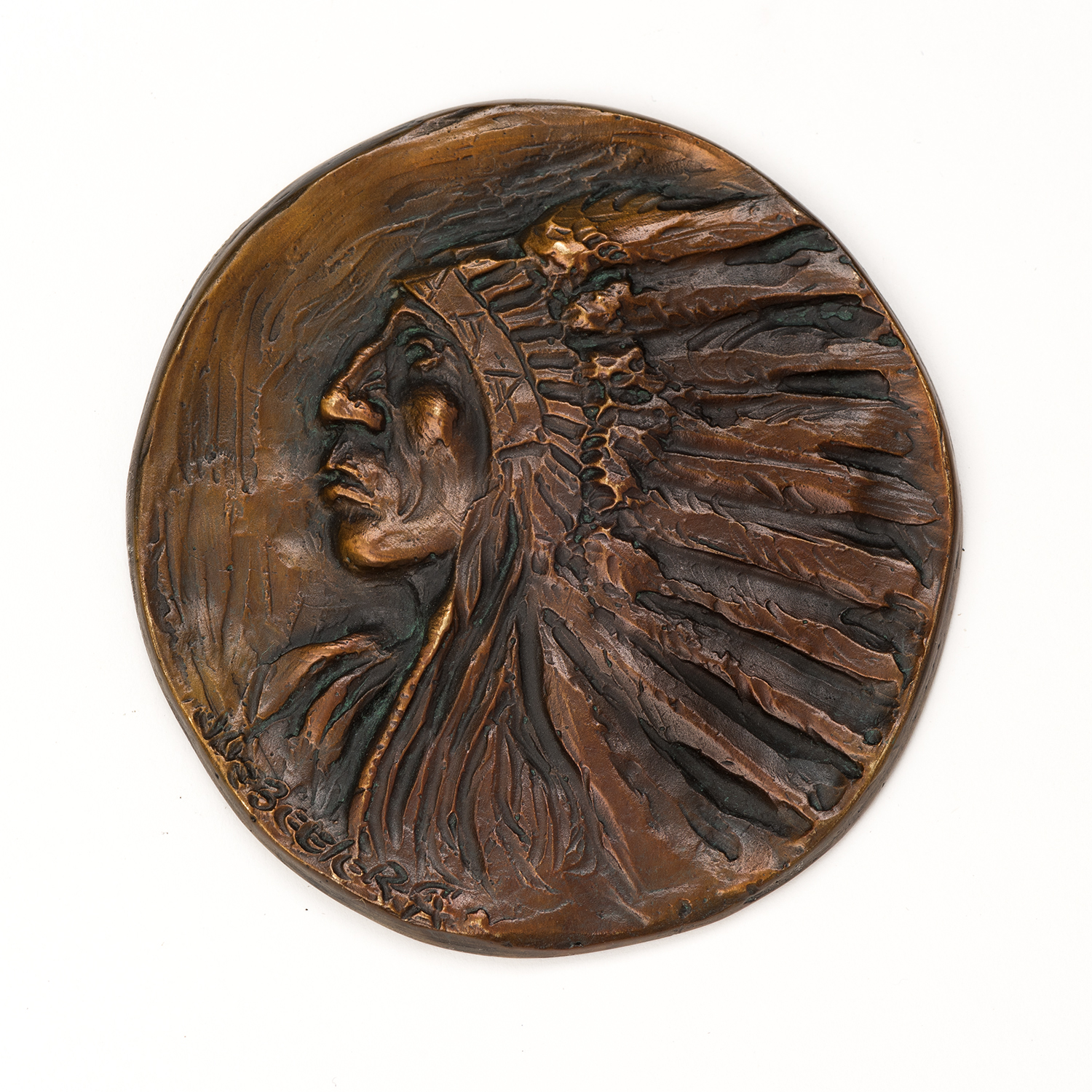
Medallion
Artist: Joe Beeler, CA Founding Member (1931-2006)
Description: Bronze (1992) | Dimensions: 3 ½” Diameterbronze
This 1992 Joe Beeler medallion, the 10th in the series, featured a profile perspective of an American Indian with a fully-feathered headdress and is even more handsome in person! The expertly applied patina accentuates the highs and lows of the piece in all the right places and was applied by Bronzesmith Fine Art Foundry in Prescott, Arizona.
Bacon Rind
Artist: Joe Beeler, CA Founding Member (1931-2006)
Description: Bronze (1991) | Dimensions: 3 ½” Diameterbronze
Joe Beeler depicted the Osage leader Bacon Rind (1860–1932) in the 1991 medallion gifted by Eddie Basha.
Bacon Rind, a political leader of the late nineteenth and early twentieth centuries, was probably born in Kansas and came to present Osage County, Oklahoma, the former Osage Nation, Indian Territory, during the Osage removal from Kansas in the 1870s. He was an Osage tribal councilman, served as assistant chief in 1904–05, and was elected principal chief in 1912. He was removed as principal chief in 1913 by Secretary of the Interior Walter L. Fisher over a 1906 bribery incident involving an oil lease. Many Osage continued to recognize Bacon Rind as their leader despite his dismissal.
Bacon Rind was politically progressive and favored the allotment of the Osage Reservation and the development of its oil and natural gas resources. He remained a traditionalist in customs, however, and always wore native dress and an otter-skin cap. Bacon Rind was a gifted speaker of the Osage language. He spent the last quarter-century of his life representing the Osage on annual visits to Washington, D.C. It has been claimed that Bacon Rind was the most photographed of all American Indian leaders. He died at Pawhuska, Oklahoma, on March 28, 1932, and was buried on a hill northeast of that community.
Source: Oklahoma Historical Society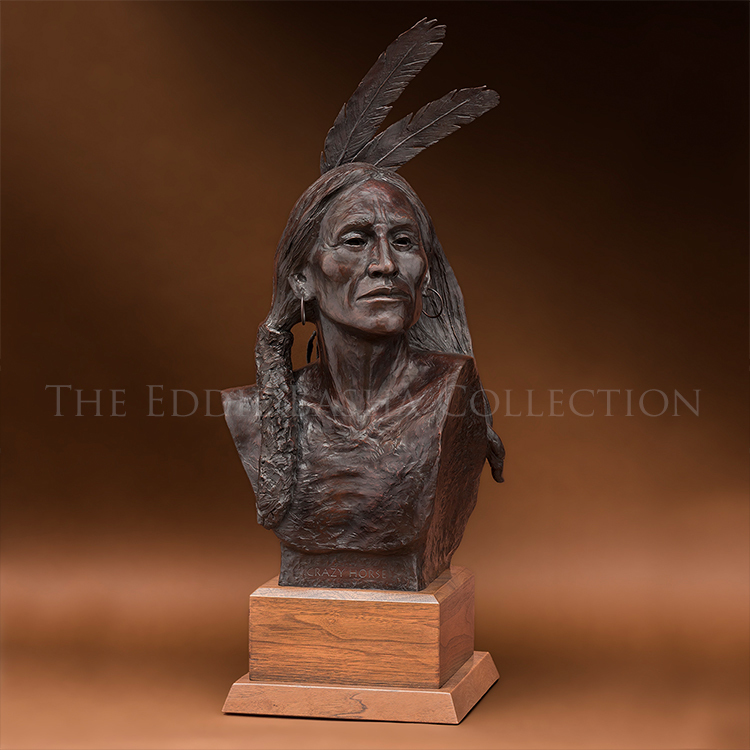
Crazy Horse
Artist: Joe Beeler, CA Founding Member (1931-2006)
Description: Bronze (1996) | Dimensions: 40 ½”h x 15 ½”w x 14”d; AP Editionbronze
Born in South Dakota, Crazy Horse, the Lakota war leader of the Oglala band, fought in numerous battles against the encroaching settlers and to preserve the traditional way of life of his people. Among the battles were the Black Hills War, the Fetterman Fight, Battle of the Rosebud and the Battle of Little Bighorn. He earned the respect of both his enemies and his own people.
Source History: Crazy Horse is remembered for his courage, leadership and tenacity of spirit in the face of near-impossible odds. His legacy is celebrated in the Crazy Horse Memorial, an uncompleted monumental sculpture located in the Black Hills, not far from Mount Rushmore. Started in 1948 by sculptor Korczak Ziółkowski (who also worked on Mount Rushmore), the Crazy Horse Memorial would be the largest sculpture in the world when completed. Operated by the nonprofit Crazy Horse Memorial Foundation, the sculpture grounds are open to the public and reportedly receive more than one million visitors each year.
Founding member of the Cowboy Artists of America, Joe Beeler, debuted his bronze tribute to the great Lakota leader in 1996 at the 31st Annual CAA Show & Sale at the Phoenix Art Museum.
Comancheros
Artist: Joe Beeler, CA Founding Member (1931-2006)
Description: Oil (1974) | Image Size: 30”h x 48”w; Framed Size: 41”h x 58”wpainting
When trade began between the native New Mexicans and the Commanche, the New Mexicans would drive their carts and pack trains out onto the Staked Plains of what now is West Texas. In the early days, the goods usually consisted of bread, cloth or other articles of low value which they would trade with the Indians for bison robes and other pelts. But as the Comanche expanded their warfare on the frontier of Texas and Northern Mexico, they began to have large herds of horses, mules and cattle for trade. The more ambitious New Mexicans then started to bring muskets, pistols, knives, lead, and whiskey to trade. The height of this trade lasted from 1850 until the mid 1870's.
By 1876, the Comanche trails were cut deep in the sands of West Texas and New Mexico. Three major trails existed that lead to the meeting places on the Staked Plains; one near Amarillo, one near Lubbock and the other east of Tucumcari, near the Texas border. It was estimated that thousands of livestock head changed hands during this period of time and most of the cattle bore Texas brands.
Manuelito
Artist: Joe Beeler, CA Founding Member (1931-2006)
Description: Bronze | Dimensions: 28”h x 13”w x 13”d; Edition #1 of 45bronze
Manuelito was a prominent Navajo leader who rallied his people against the United States military. For several years he led a group of warriors in resisting federal efforts to forcibly remove the Navajo people to Bosque Redondo, New Mexico, via the Long Walk in 1864. After being relocated to Bosque Redondo, Manuelito was among the leaders who signed the 1868 treaty and establishing a reservation for the Navajo. In 1871 he became Chief of the Navajo. Among his many accomplishments, he met with Presidents Grant and Hayes to resolve land disputes, potential land leases, whiskey trafficking as well as other issues. Though Manuelito was succeeded as Chief by Henry Chee Dodge in 1884, he remained a leader and forceful advocate of the Navajo people until he succumbed to measles complicated by pneumonia in 1893.
This large bronze depicts a seated Manuelito with clothing and other accoutrements appropriate to the late 19th century. Placed on a cube base, all four sides are in bas relief showing Manuelito and others of his band during a raid. The juxtaposition between the intense action of the bas relief and the quiet repose of Manuelito, the seated figure and primary subject of the bronze, is quite effective. The bronze is impressive in size, execution, and quality.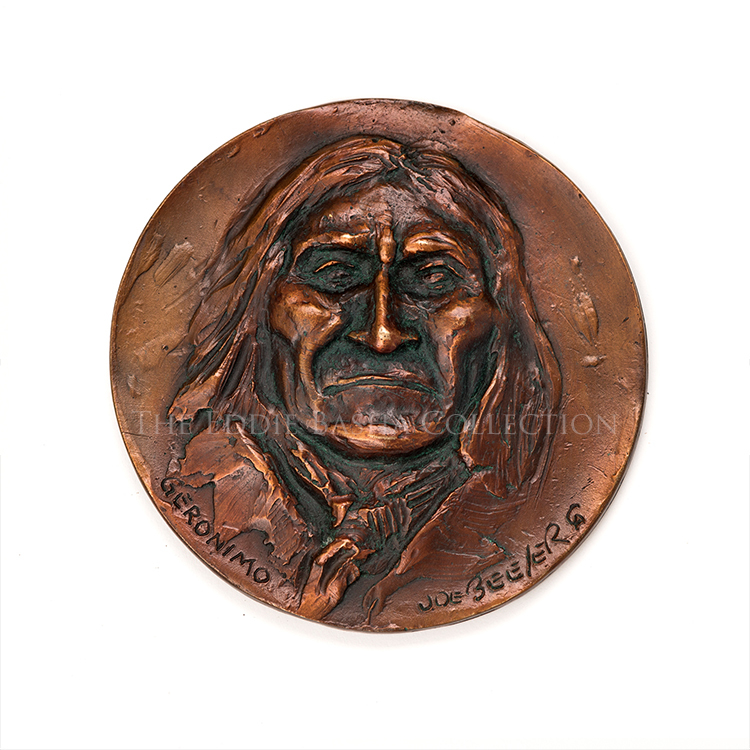
Geronimo
Artist: Joe Beeler, CA Founding Member (1931-2006)
Description: Bronze (1989) | Dimensions: 3 ½” Diameterbronze
GERONIMO (1829-1909) … the eighth Joe Beeler medallion (1990) in the series! Much has been written about the legendary Geronimo and chances are you learned about his life at home, in school, at a museum or from a book you’ve read. He was fervent in his pursuit to protect Apache lands, its people and their way of life after his wife, children, mother and other tribal members were killed by marauders.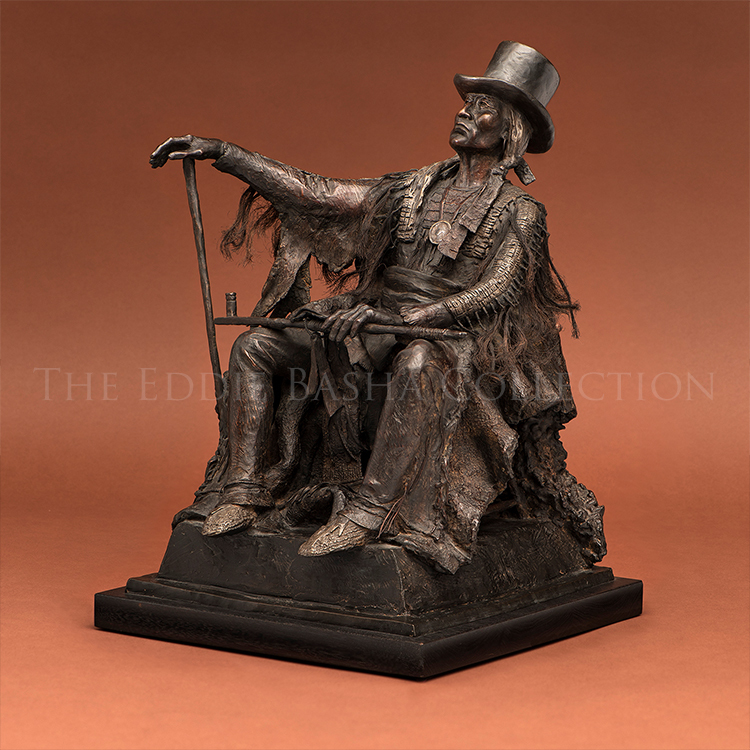
The Chief Goes to Washington
Artist: Joe Beeler, CA Founding Member (1931-2006)
Description: Bronze (1990) | Dimensions: 20”h x 15”w x 14”d; Edition #1 of 35bronze
Beeler’s interpretation of a Plains Indian chief who has traveled to Washington to represent his people is one of his major bronzes. It is an extremely well done sculpture and includes many authentic period elements and is representative of Beeler’s ability to create figures that detail remarkable realism and persona.
Wearing the President’s gifts of a peace medal and top hat, the Chief is regally posed with his buffalo hide beneath him as he watches the parade festivities passing by. His right hand rests upon the also newly gifted walking stick while his left hand steadies his peace pipe balanced across his knees. The fringed garments and moccasins appear to be from finely tanned hides. And the hair drop, it too a finely tanned hide, lays upon his chest and a long hair tail completes the representation.
“Chief Goes to Washington” won both the Gold Medal in sculpture and the Best of Show award at the 25th Annual Cowboy Artists Show & Sale at the Phoenix Art Museum in 1990.
Plains Indian with Breastplate
Artist: Joe Beeler, CA Founding Member (1931-2006)
Description: Bronze (1989) | Dimensions: 3 ½” Diameterbronze
The seventh Joe Beeler medallion in the series… 1989! The Plains Indian presented wears a breastplate which was a popular chest ornament. Typically they were worn for ceremonial purposes since they offered little in the way of protection during a battle. The long bones featured are called hair pipes and were made from bison, other animals and occasionally birds. Often the quantity of bones that appeared on a breastplate could be an indication of a warrior’s wealth and/or prowess as a hunter. Breastplates could also be further adorned with abalone shells, quills, feathers and other accoutrements.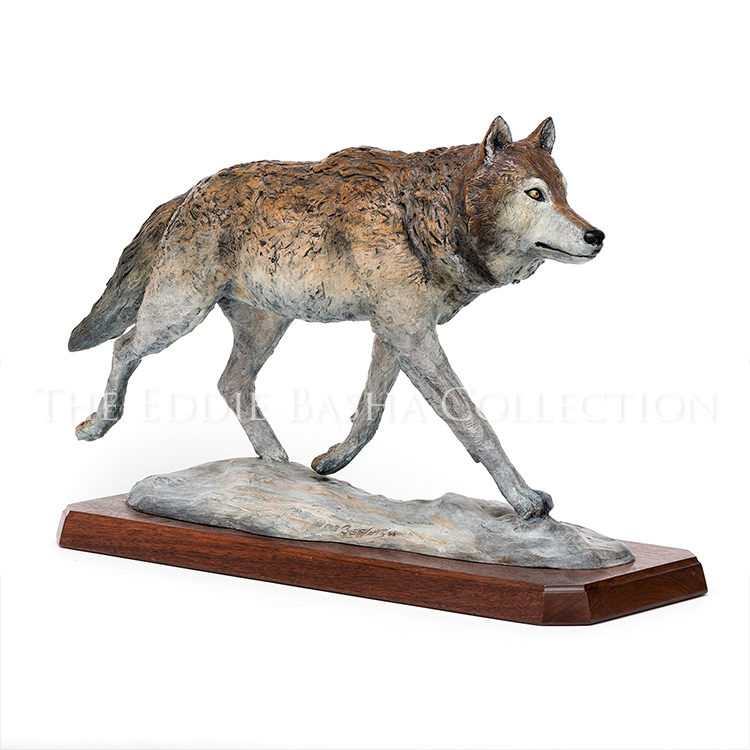
Voice of the Wilderness
Artist: Joe Beeler, CA Founding Member (1931-2006)
Description: Bronze (1998) | Dimensions: 14”h x 21 ½”w x 8”d; Edition #1 of 35bronze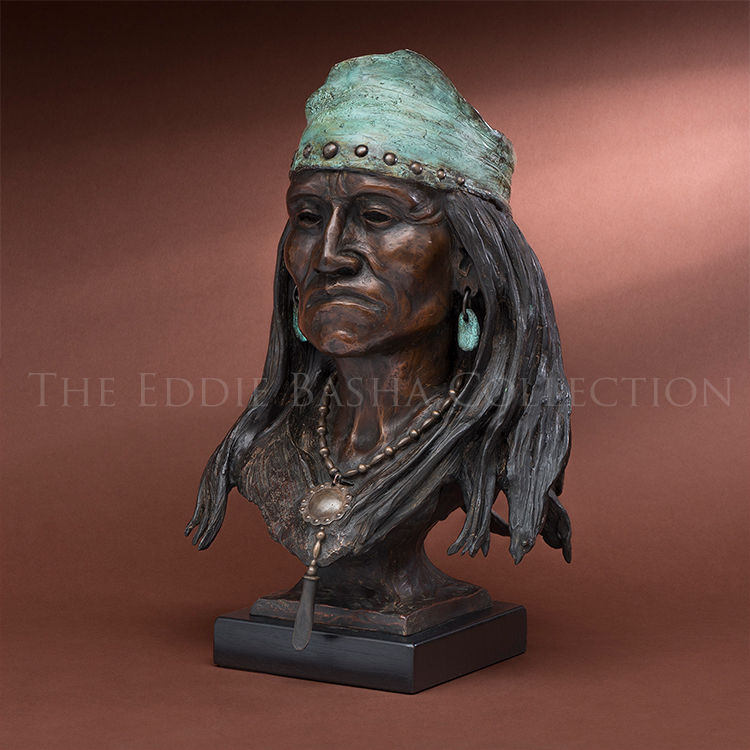
The Renegade
Artist: Joe Beeler, CA Founding Member (1931-2006)
Description: Bronze | Dimensions: 16”h x 12”w x 10”d; Edition #1 of 40bronze
The term renegade once referred to American Indians, in this case an Apache, who refused to be confined to reservations. His face shows his character and determination to control his own destiny. He wears earrings and a scarf decorated with silver buttons around his head.
Joe Beeler was of Cherokee descent and often participated in dances on the Cherokee Reservation in Oklahoma. He was proud of his heritage and that of other Indian Nations and his work is a reflection of that pride as well as the enormous reverence he felt for all.
Medallion
Artist: Joe Beeler, CA Founding Member (1931-2006)
Description: Bronze (1988) | Dimensions: 3 1/2"h x 3 1/2"wbronze
The sixth Joe Beeler medallion in the series… 1988! We’re feelin’ that hat. How about you?
Will James Society Gallery Visit
Artist: Joe Beeler, CA Founding Member (1931-2006)
Description: Watercolor Marker | Image Size: 11"h x 8 1/2"w; Framed Size: 19 ¾”h x 17 ½”wdrawing
In honor of the 128th year of author, storyteller and artist Will James’ birth, June 6, 1892, we thought it fitting to share this letter Joe Beeler penned and sent to Eddie following their co-hosting the Will James Society in the gallery in January 2000.
The letter reads, “Well Eddie, at least we know if Will James had been in Arizona in the last 20 to 30 years, he would not have gone malnourished I bet. Sharon and I had a great evening with you and the Will James Society. They are a great bunch and really enjoyed the opportunity to see your collection. Fact is, they were awestruck as are most who see the gallery for the first time.” Translation: Joe was mockingly referring to Eddie’s penchant for exchanging groceries for art which the society attendees duly noted was absent from the collection.
Evidently the society members didn’t hold it against Eddie as he was asked seven years later in January 2007 to auction a print of this same letter at the Annual Will James Society’s Fundraising Dinner. It sold quite successfully! During that same year, three log cabins from James’ Rocking R Ranch, one of which was his studio, were relocated to the Big Horn County Historical Museum & Visitor Center in Hardin, Montana.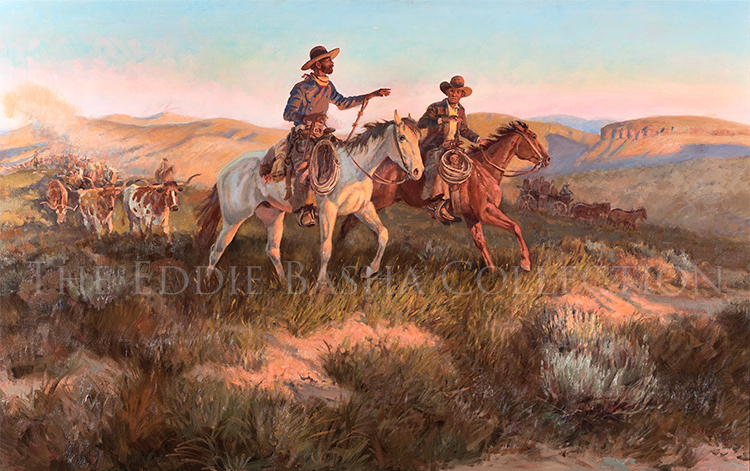
Heritage of Texas
Artist: Joe Beeler, CA Founding Member (1931-2006)
Description: Oil | Image Size: 30”h x 48”w; Framed Size: 40”h x 58”wpainting
One of the truly iconic figures of the West was born after the Civil War when great herds of untamed longhorn cattle roamed the plains of South Texas. As northern cities grew more populous, a demand rose for more and more meat to feed the people there. Texas had the cattle, but it did not have the means to transport the cattle to northern and eastern markets, thus the age of the great cattle drives was born as young men were employed to move herds of longhorns from Texas to Kansas rail heads. The men who drove the cattle used skills and tools borrowed from Mexican Vaqueros and southern stock herders and developed a few skills and tools of their own as well. In this sweeping painting, Joe Beeler reveals two cowboys riding at the head of a large herd headed north. They are riding across a rolling grassy terrain toward the sun. At their backs, the great herd stretches into the distance and to the right, the supply wagon. “The Heritage of Texas” is in essence the creation of the American cowboy.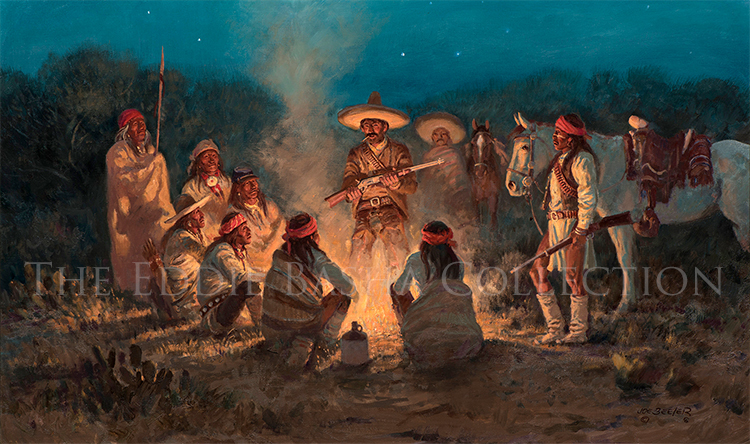
Unholy Alliance
Artist: Joe Beeler, CA Founding Member (1931-2006)
Description: Oil Painting | Image Size: 24”h x 40”w; Framed Size: 36”h x 52”wpainting
A truly unholy alliance of outlaws dealing in guns for use during raids and robberies on the frontier are gathered around a smoky campfire that casts an eerie light on the proceedings. The fire creates a circle of illumination that dissipates as the viewer’s eye moves from the center of the painting to its outer edges. Once again, Beeler spins a tale from the pages of western history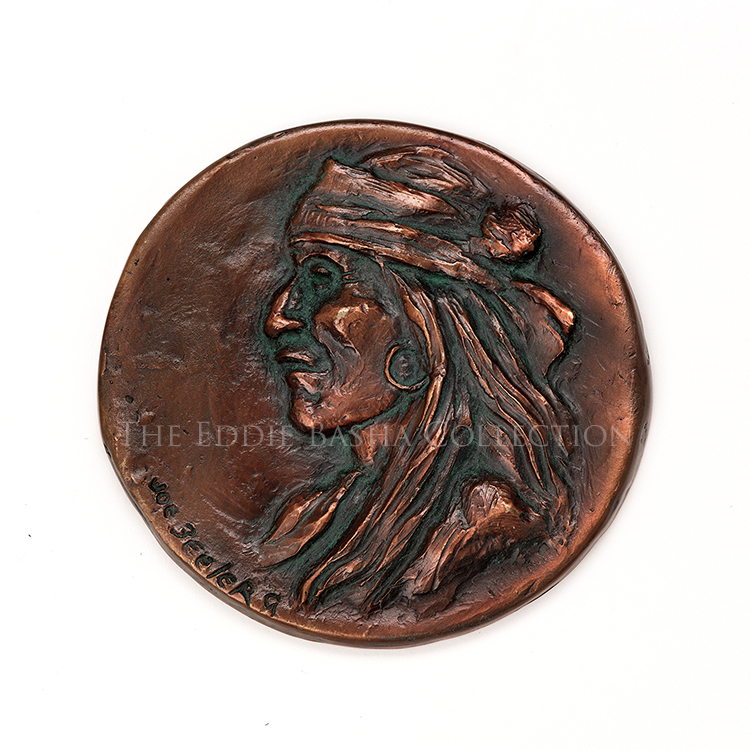
Apache Scout Profile
Artist: Joe Beeler, CA Founding Member (1931-2006)
Description: Bronze (1987) | 3 ½”h x 3 ½”wbronze
In 1987, the Apache Scout Profile medallion entered the series; it was the fifth to do so!
As you may recall, in 1983 Cowboy Artists of America Founding Member Joe Beeler and Eddie Basha collaborated on what would eventually become a hallmark series of bronze, and later, pewter medallions. At that time, neither envisioned the scope nor popularity. Individual medallions soon became sets and much later a series totaling twenty-four pieces. The medallions were used as holiday gifts or acknowledgements of gratitude.
Plains Indian
Artist: Joe Beeler, CA Founding Member (1931-2006)
Description: Bronze (1986) | 3 ½”h x 3 ½”wbronze
The second “Plains Indian” medallion entered the series in 1986! Slightly different than its predecessor, this particular likeness leans toward a depiction of a Sioux Indian.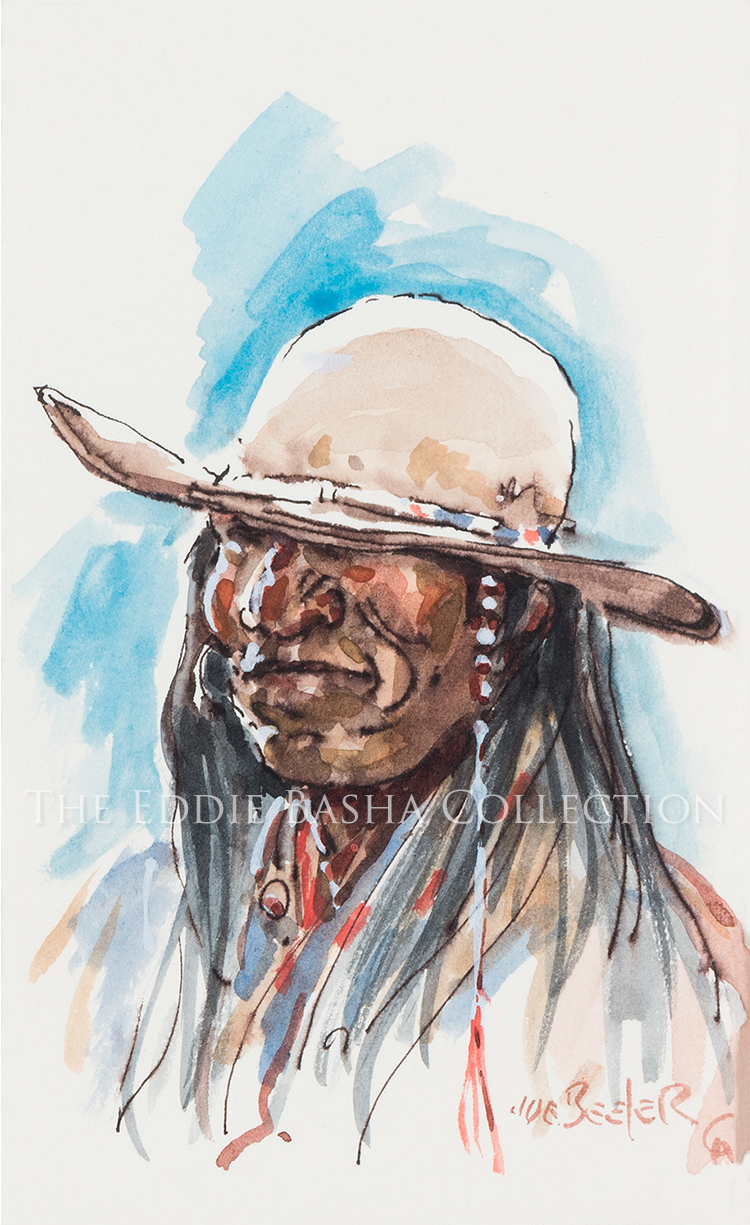
Unknown Title
Artist: Joe Beeler, CA Founding Member (1931-2006)
Description: Watercolor | Image Size: 6”h x 4”w; Framed Size: 15 7/8” h x 13 7/8”wpainting
Few western artists have been as prolific and versatile as Joe Beeler who was skilled at sculpting, drawing and painting. As a painter, he easily shifted between a variety of media, including oils, pen and ink, charcoal, pastels, pencil, and as is the case with this small Indian portrait, watercolor. Adapting to the necessities of the medium, this piece has a quick, fluid style that captures the subject and his proudly, well-worn hat; perhaps one of his favorite possessions.
What about that hat? The “boss of the plains” was designed in 1865 by John B. Stetson, specifically for the American West. Basically, it was a redesigned “bowler” that was durable, waterproof and practical, providing greater protection from the elements. Originally redesigned straight-sided, round cornered, flat brimmed and without a crease. Its appearance slowly evolved, first unintentionally by use and later deliberately by preference. In fact, those changes increasingly reflected its owner’s geographic location, occupation, and/or culture. Eventually it became referred to as the “Stetson” and more commonly, the “cowboy hat”.
Regardless of the decade, the century or the era, hats have withstood the test of time. And though styles and purpose have changed, hats remain an emblematic part of culture out of necessity or as personified in art, cinema, fashion, music, etc. Think Vincent van Gogh’s self-portrait wearing his yellow straw hat, Charlie Chaplin in his bowler, the Duke’s signature cowboy hat, Jacqueline Kennedy in her pillbox, Pharrell Williams in his boss of the plains inspired number or Billie Eilish in her beanie or bucket hat. Personas in movies such as Casablanca, Breakfast at Tiffany’s, Indiana Jones, Rocky, and The Godfather have been defined by them. Songs have been sung about them. Military service branches can be distinguished by them. They’ve been worn on solemn as well as happy occasions and at formal and informal ones too. Even in the abstract we’ve all kept something under our hats, tossed our hat into the ring, did something at the drop of a hat, worn several hats, eaten our hats, or had our hat handed to us. Maybe you’ve even pulled a rabbit out of yours.
Coco Chanel once said, “The apparent simplicity of a masterpiece is certain proof of its grace.” Who knew that a simple hat created for a specific purpose in 1865 would be so enduring? That this hat is still worn today is proof enough that it is, indeed, a masterpiece.
Prairie Madonna
Artist: Joe Beeler, CA Founding Member (1931-2006)
Description: Bronze | Dimensions: 19”h x 26 ½”w x 11”d; Edition #1 of 35bronze
American Indian women on the Great Plains were tasked with many responsibilities that were essential to the survival of their families and tribes. One of those tasks was to move camp as the men of the tribe followed the buffalo herds. In this sculpture, Beeler presents an Indian woman mounted on her horse with her child swaddled on her back. The horse is pulling a travois, a sort of sled fashioned from two of the lodge poles from her teepee. All of the family’s possessions, including their shelter, are transported on the poles. Two dogs walking alongside the mother and child complete the scene.
XIT is Born
Artist: Joe Beeler, CA Founding Member (1931-2006)
Description: Oil (1977) | Image Size: 24”h x 48”w; Framed Size: 35”h x 58.5”wpainting
This painting depicts the first herd of South Texas cattle delivered to what was to be, the XIT Ranch at Buffalo Springs. Not having arrived at a brand yet, the crew stood around Abe Blocker, the trail boss, and “Barbeque” Campbell, the ranch foreman at the time, and Abe drew on the ground the now famous XIT brand. The brand stood for ten counties in Texas and was chosen for its difficulty to vent or change. This was a historic moment in range history.
Joe Beeler thoroughly researched this piece for historical accuracy. The cowboys are realistically portrayed and appropriately reflect the time period. Included are two African American cowboys, another accurate reflection of the day as they actively participated in many trail drives during the period. The painting is large and filled with many characters. It is replete with many details of clothing and equipment and recounts an important historical aspect of the West, the founding of a legendary Texas Panhandle ranch.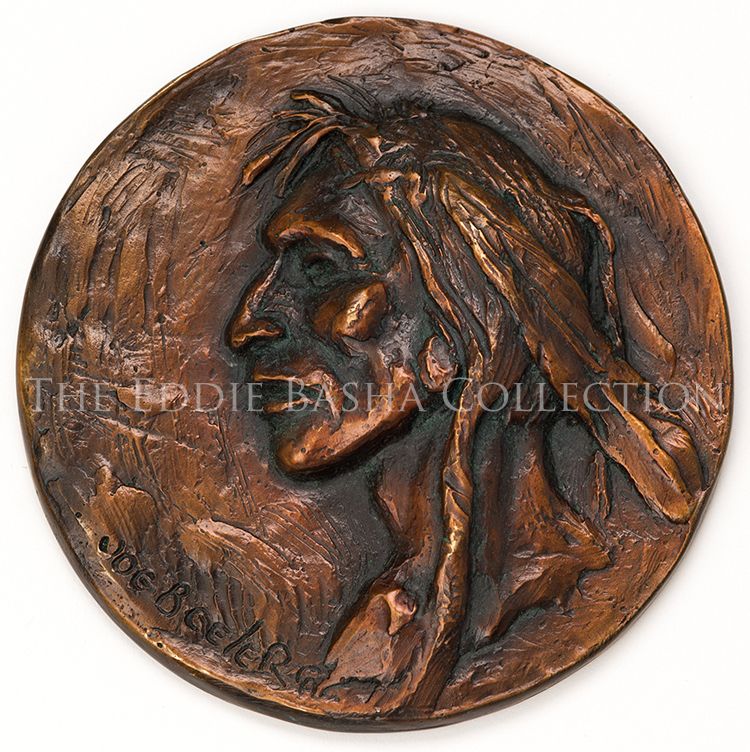
Plains Indian
Artist: Joe Beeler, CA Founding Member (1931-2006)
Description: Bronze (1984) | 3 ½”h x 3 ½”wbronze
The “Plains Indian” medallion entered the art world in 1985! Over 500 of these were gifted and put into circulation. It would be an additional five years before a specific historical figure would be recognized and depicted in the series.
Cochise Medallion
Artist: Joe Beeler, CA Founding Member (1931-2006)
Description: Bronze (September 2005) | Limited Edition of 110bronze
The Medal of Honor, the USA’s most prestigious military honor, is awarded in recognition of military service members who have distinguished themselves by acts of valor. This select group gathers in a new location annually. In September of 2005, the State of Arizona and the City of Phoenix were humbled and honored to recognize the heroism and bravery of these extraordinary individuals. Joe Beeler, founding member of the Cowboy Artists of America, was asked by Eddie Basha, a member of the host committee, to create a limited edition medallion commemorating the occasion that would be gifted to each Medal of Honor recipient. Famed and admired leader of the Chiricahua Apache, Cochise, appears on its surface in recognition of all warriors.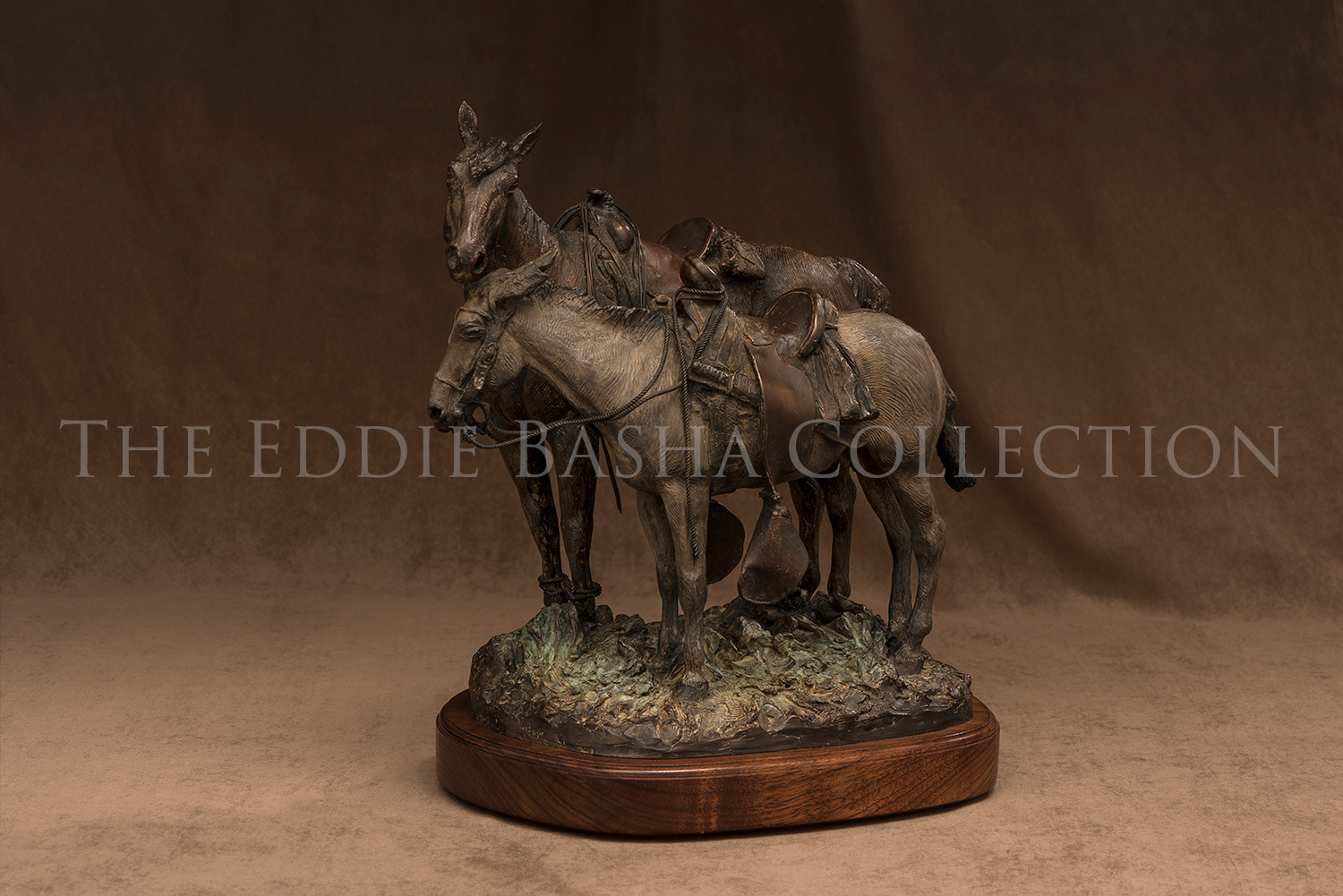
Love at First Sight
Artist: Joe Beeler, CA Founding Member (1931-2006)
Description: Bronze (2001) | 13 ¾”h x 11 ¼”w x 10”d; Edition #1 of 45bronze
“The inspiration for this piece came about as a result of a mule named Sugar. I bought it for my wife, Sharon. Once I put the mule in the same coral as the gelding, it was Love at First Sight. The gelding was no longer good for anything and he wouldn’t perform unless Sugar was by his side,” shared Joe Beeler in 2001.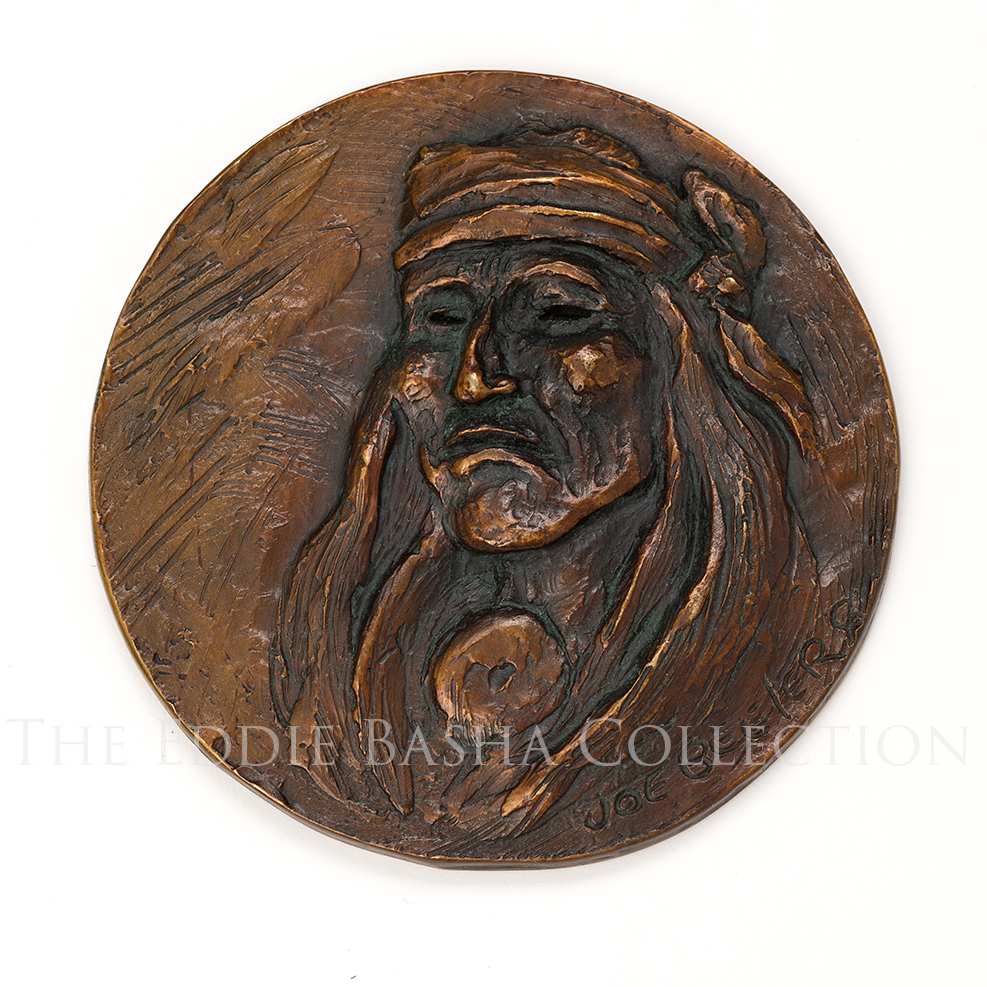
The Apache
Artist: Joe Beeler, CA Founding Member (1931-2006)
Description: Bronze (1984) | 3 ½”h x 3 ½”wbronze
The second medallion in the series, “The Apache” debuted in 1984! It, along with the entire series, is displayed routinely in the gallery. Often when discussing the next medallion in the series, Joe and Eddie would contemplate utilizing a particular or similar profile that Joe had crafted in an earlier painting or drawing which Eddie had acquired for the collection. Joe would then sculpt the image they had agreed upon in clay and a mold would be made for the bronze castings by Ed Reilly of Bronzesmith Fine Art Foundry and Gallery in Prescott Valley, Arizona.
Join us on social media by sharing your medallion story, image, card or note... remember to use our link and hashtags when you do! #24medallions #finderskeepers #showusyourmedallion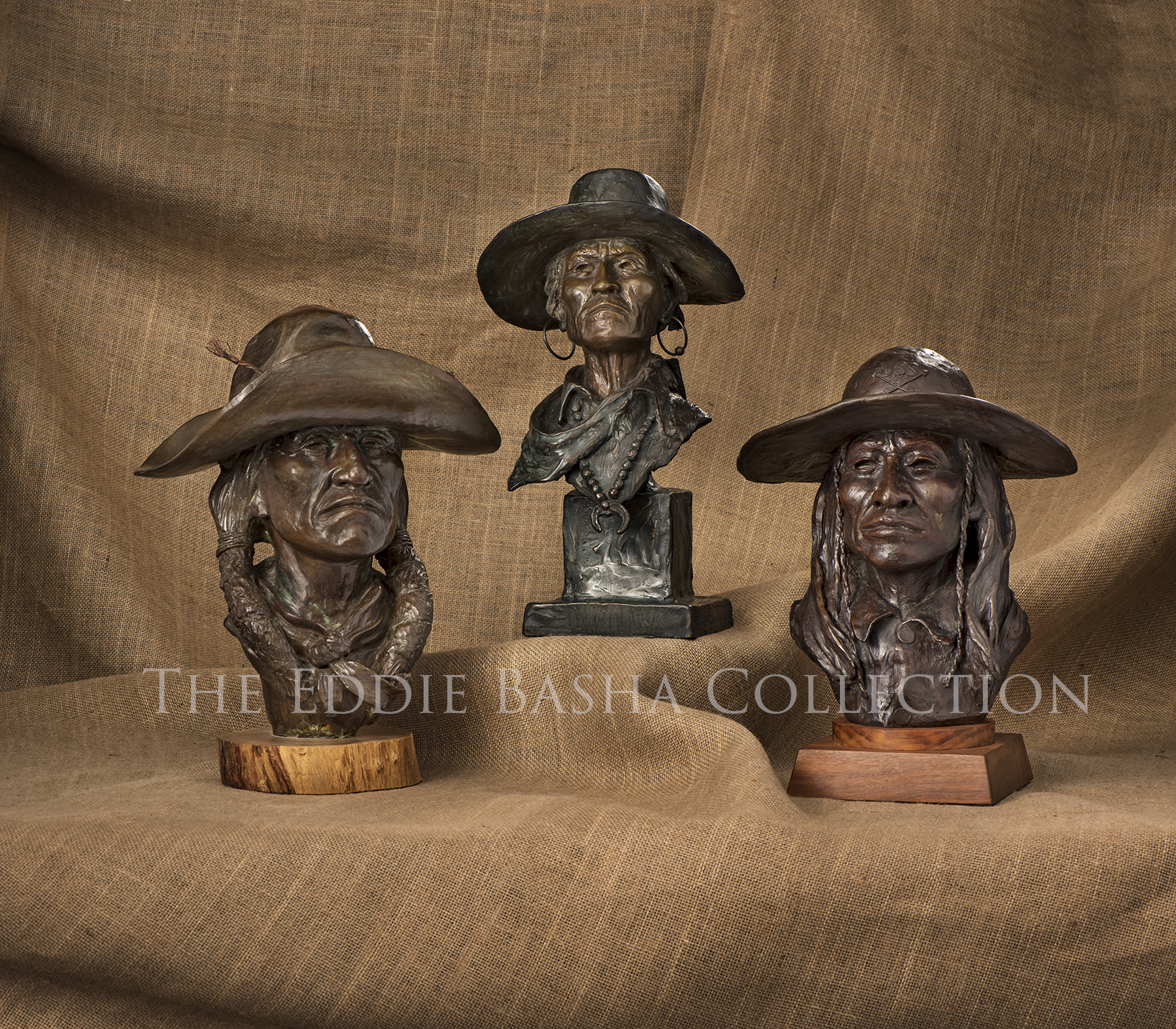
(L-R) Cheyenne Scout – The Mystic – Cheyenne
Artist: Joe Beeler, CA Founding Member (1931-2006)
Description: (L-R)bronze
Bronze | Dimensions: 14 ½”h x 14”w; Edition #13 of 20
Bronze | Dimensions: 16”h x 9”w; Edition #1 of 35
Bronze | Dimensions: 14”h x 12”w; Edition #1 of 20
One Shot Antelope Hunt (Parody)
Artist: Joe Beeler, CA Founding Member (1931-2006)
Description: Water Marker & Pen (8/3/92) | Image Size: 11”h x 8 ½”w; Framed Size: 18 ¾”h x 16 ¼”wdrawing
The Navajo
Artist: Joe Beeler, CA Founding Member (1931-2006)
Description: Bronze (1983) | 3 ½”h x 3 ½”wbronze
Though the concept wasn’t a new one, in 1983 Joe Beeler and Eddie Basha collaborated on what would eventually become a hallmark series of bronze, and later pewter, medallions. At that time, neither envisioned the scope nor popularity. Individual medallions soon became sets and much later a series totaling twenty-four pieces. The medallions were used as holiday gifts or acknowledgements of gratitude. The medallion shown here was the first of the series and reveals a Navajo profile which was fitting since the first Bashas’ Diné store opened in Chinle, Arizona, that same year.
While many enjoy the medallions displayed as beautiful artwork, some recipients creatively used them at their homes, offices and in landscapes. One had the pieces repurposed as cabinet pulls, another as an entry door knocker, an ornamental gate pull, and even artfully embedded along a garden path.
Inquiries are routinely fielded about the medallions, most often by individuals who actively pursue the entire series. And if your curiosity is piqued, rest assured The EBC is committed to sharing additional images and relevant series information here and on social media.
@TheEddieBashaCollection @bashacollection
#24medallions #finderskeepers #showusyourmedallion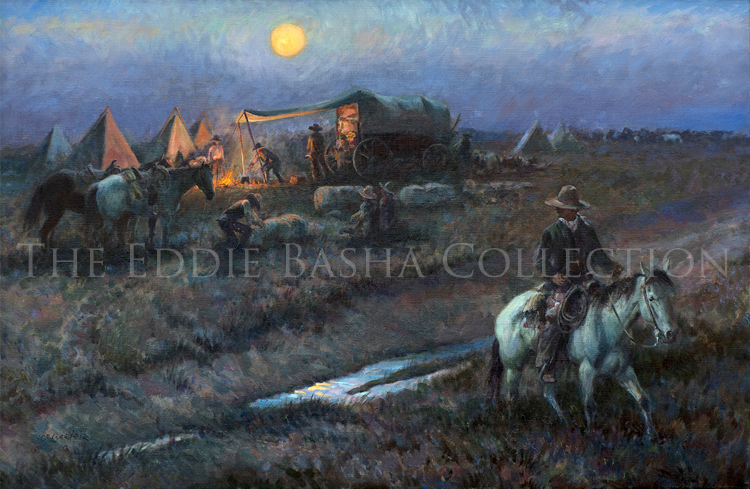
Cow Camp by Moonlight
Artist: Joe Beeler, CA Founding Member (1931-2006)
Description: Oil (1997) | Image Size: 24”h x 36”w; Framed Size: 36 ¼”h x 48”wpainting
A lone cowboy rides away from camp on a white horse, more than likely to check the herd. Meanwhile, the bedrolls are brought out and dinner preparations are underway at the chuck wagon. All the activities associated with winding down after a long day on the range. The ambient pale moonlight and firelight beautifully lend themselves as illuminators of a tranquil dusk.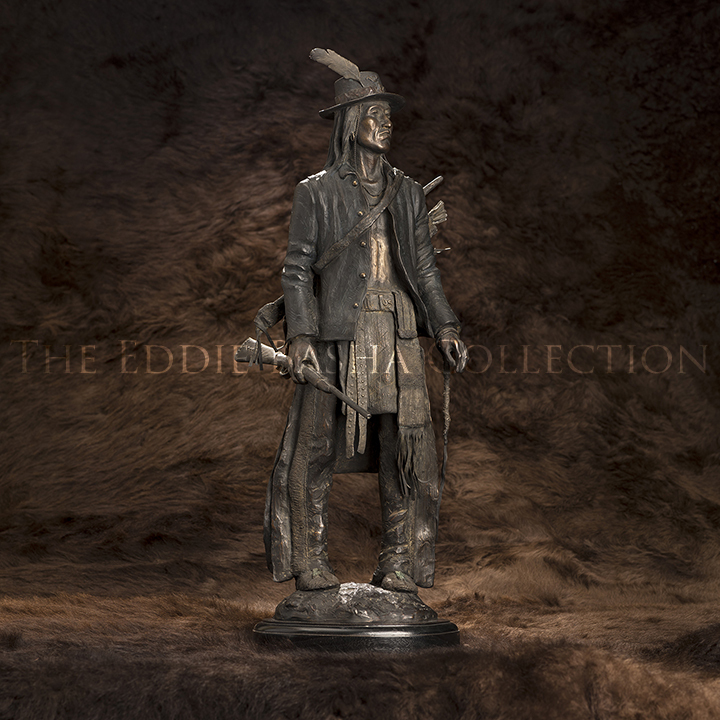
The Scout for the Long Knives
Artist: Joe Beeler, CA Founding Member (1931-2006)
Description: Bronze (2006) | 24”h x 11.25”w x 8”d; Edition #1 of 40bronze
In Joe Beeler’s bronze depiction “The Scout for the Long Knives” the Indian scout wears a unique blend of traditional garb, surplus stock issued cavalry jacket, and hat with an added feather accoutrement. Highly effective, Indian Scouts were skilled trackers, had immense knowledge of the terrain, and provided much needed intelligence. Early white settlers and subsequently soldiers were dubbed “long knives” since the knives they carried were noticeably longer than those which Indians had seen or used initially.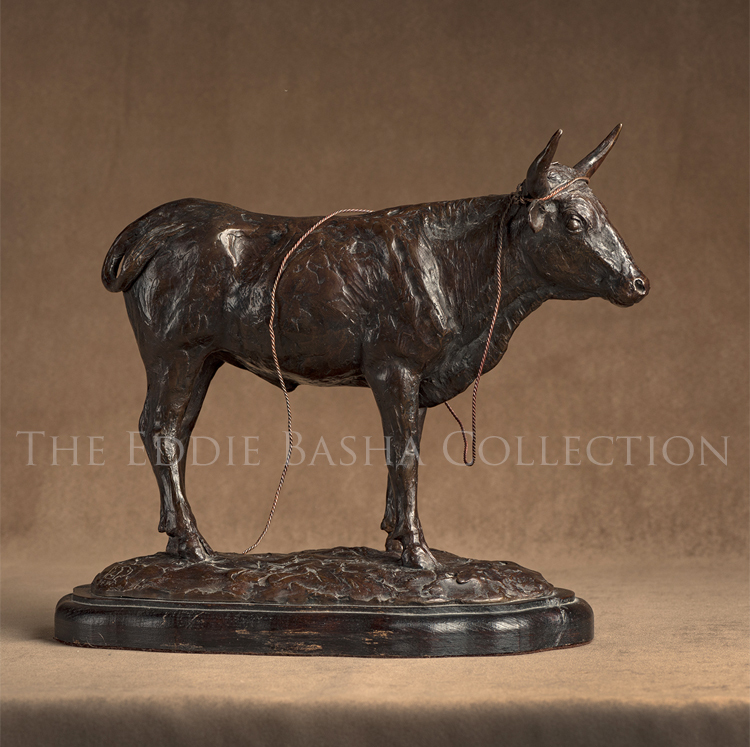
Lost Dallies
Artist: Joe Beeler, CA Founding Member (1931-2006)
Description: Bronze | Dimensions: 8”h x 10”w x 5”d; Edition #7 of 30bronze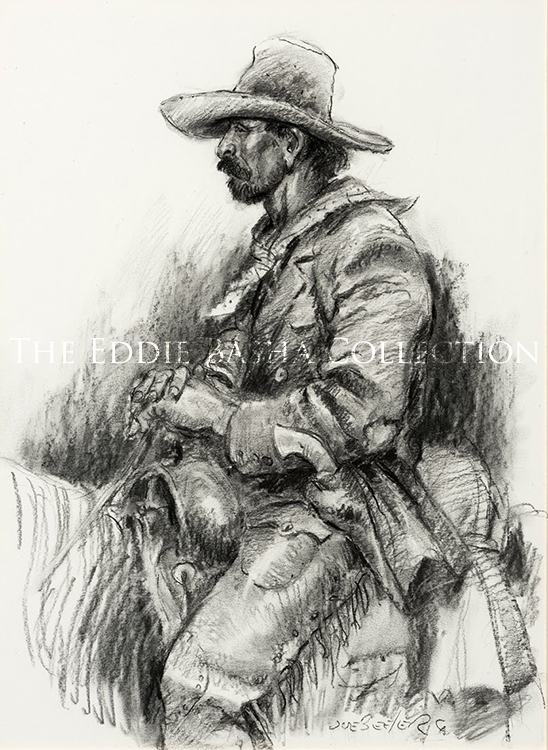
The Horse Thief
Artist: Joe Beeler, CA Founding Member (1931-2006)
Description: Charcoal (1995) | Image Size: 23"h x 16.5”w; Framed Size: 35 ½”h x 28 ½”wdrawing
Shown in profile, this armed and sinister frontier character is mounted on a partially-viewed horse which accorded Beeler the opportunity to provide many details of the character’s clothing and weapon.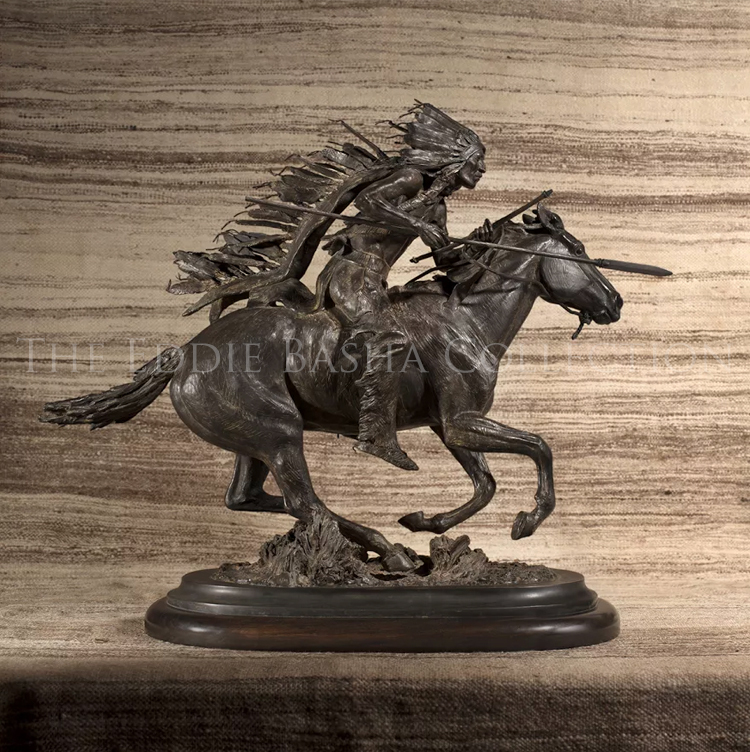
Vengeance
Artist: Joe Beeler, CA Founding Member (1931-2006)
Description: Bronze | Dimensions: 28 ½”h x 34 ½”w x 13 ½”dbronze
Joe Beeler Cowboy Artist bronze entitled “Vengeance” was based on the second battle of Adobe Walls which occurred in the Texas Panhandle in 1864. In that battle, 20 or 30 buffalo hunters held off for three days approximately 700 (+/-) Comanche, Kiowa, and Apache warriors led by Comanche Medicine Man Isatai’i and Comanche Chief Quanah Parker, son of the previously captured white woman Cynthia Ann Parker. The deciding factor was a famous long range rifle shot by hunter Billy Dixon that killed a warrior at a distance of either 1,000 or 1,500 yards (depending on who is telling the story; 1,500 yards is almost a mile in distance). Dixon used a borrowed buffalo gun, often called the “big fifty,” which refers to the large caliber. The Indians were said to have been so startled that a shot could be made from such a distance that they dispersed. For additional information, Empire of the Summer Moon by S.C. Gwynne is a detailed account of Texas history as well as the Comanches.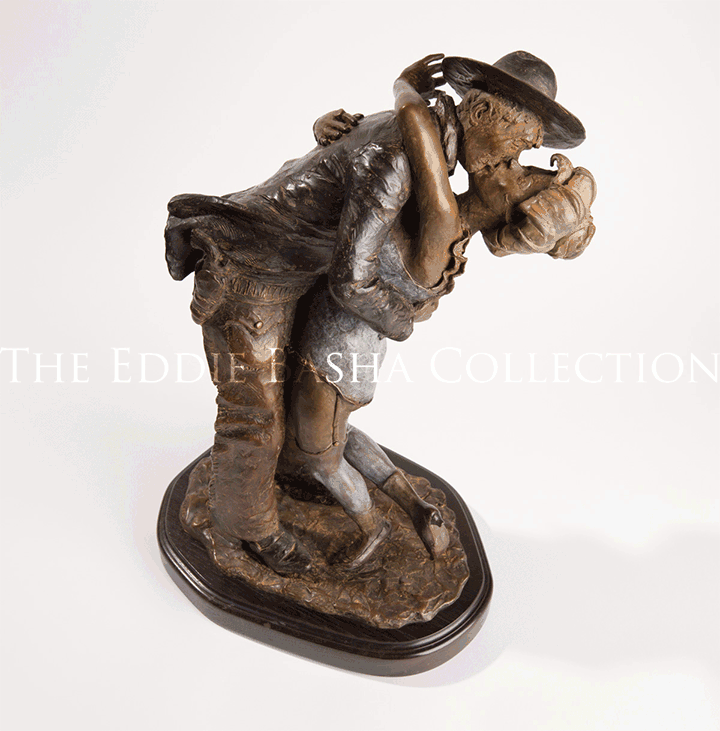
Sugar for the Trail
Artist: Joe Beeler, CA Founding Member (1931-2006)
Description: Bronze (2006) | 20”h x 10”w x 14”d; Edition #1 of 45bronze
Dog Soldiers
Artist: Joe Beeler, CA Founding Member (1931-2006)
Description: Bronze (1974) | 12”d x 21”h x 35”w; Edition #1 of 15bronze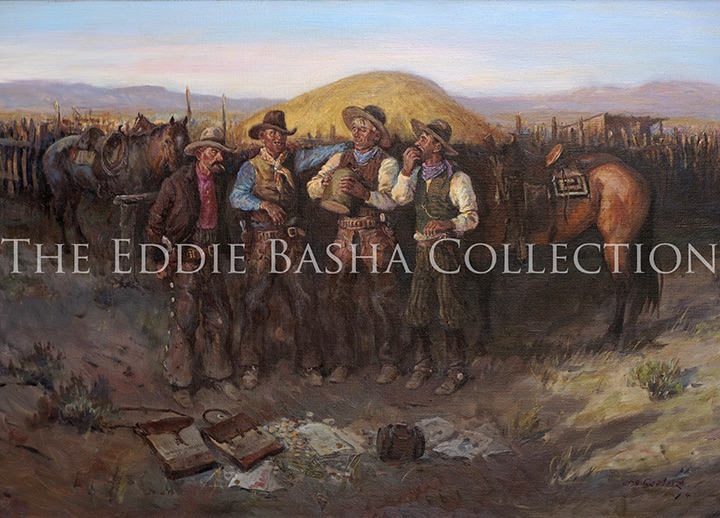
Toasting to the Union Pacific
Artist: Joe Beeler, CA Founding Member (1931-2006)
Description: Oil (2003) | Image Size: 24”h x 36”w; Framed Size: 36 ¼”h x 48”wpainting
Under the Congressional Pacific Railroad Act of 1862 which was approved by President Abraham Lincoln, the Union Pacific was incorporated. The act provided for railroad construction from the Missouri River to the Pacific. From Council Bluffs, Iowa, it was constructed westward to meet the Central Pacific Railroad line which went eastward from San Francisco. Primarily constructed by immigrant labor, the two railway lines connected at Promontory Summit, Utah, on May 10, 1869, creating the first transcontinental railroad in North America.
No longer would mail or other transactional activities be transported by horseback or stage over the rugged terrain. At the very least, a toast was in order!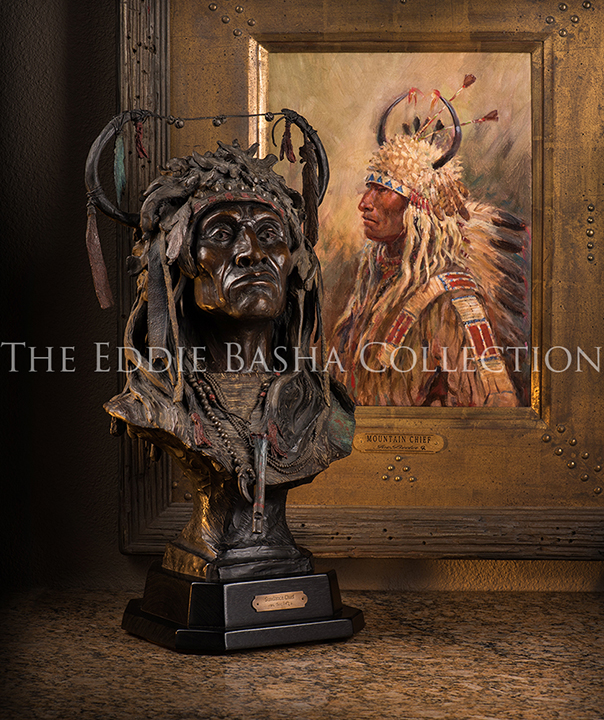
Sun Dance Chief & Mountain Chief
Artist: Joe Beeler, CA Founding Member (1931-2006)
Description: Bronze (1995) & Oil (2002)bronze
Bronze | Dimensions: 20”h x 11”w x 11”d; Edition #1 of 45
Oil | Image Size: 16”h x 12”w; Framed Size: 29”h x 25 1/8”w
There were a variety of war bonnets, however, those shown here were primarily worn by Sioux or Northern Plains Indians. Headpieces were not worn in battle as it would have been impractical to do so. Distinguished or highly regarded warriors who “earned” a bonnet would wear it during ceremonial or spiritual practices. These horned bison hide bonnets were often embellished with “earned” accoutrements such as fur, tails trailing behind, ermine skins and feathers.
In the Joe Beeler bronze "Sundance Chief" and the oil painting “Mountain Chief,” we see two unique bison bonnets proudly worn by their victors.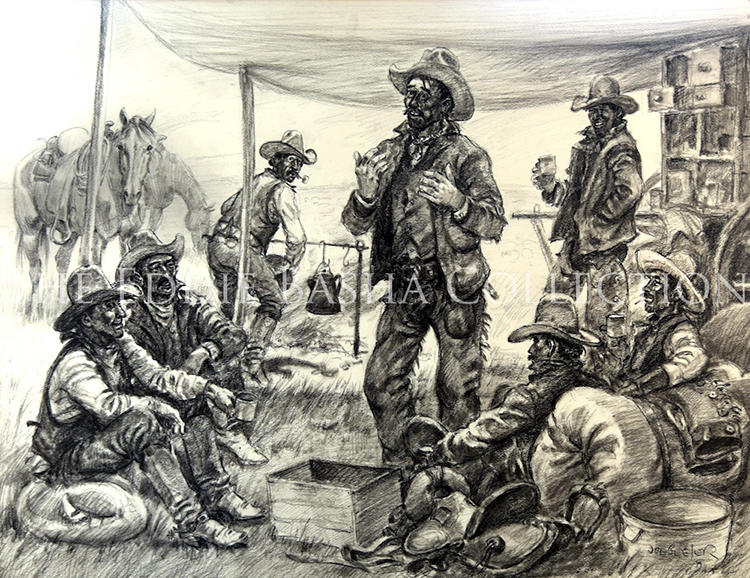
Unknown Title
Artist: Joe Beeler, CA Founding Member (1931-2006)
Description: Pencil | Image Size: 18”h x 24”w; Framed Size: 28 5/8"h x 34 ¾”wdrawing
At day's end, entertainment encamp is often filled with storytelling, song or music as well as poetry. Similar experiences can be had by attending a cowboy poetry and music activity. Check for local events in your area.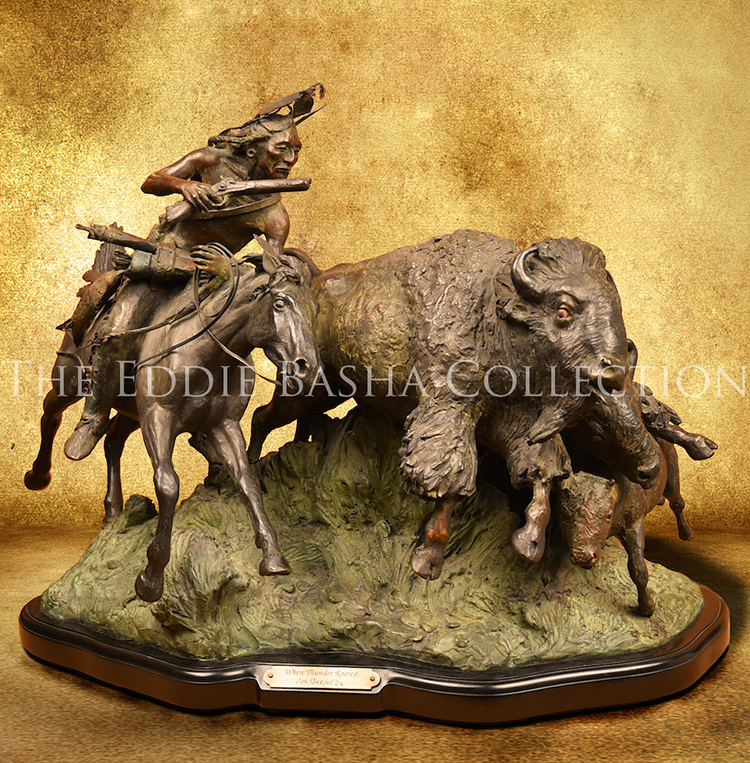
When Thunder Roared
Artist: Joe Beeler, CA Founding Member (1931-2006)
Description: Bronze | Dimensions: 18”h x 26”w x 17”d; Edition #1 of 45bronze
Bison and Buffalo! Early American settlers called bison “bufello” due to similarities between the species and the name stuck. However, bison are found in North America while the two main buffalo types are found in Africa and Asia.
Bison were the sustenance of the American Indian. They were an integral part of their history, culture, ceremonies and way of life. Bison were more than a major food source, the American Indian made clothing and tipis from the hides, soap from the fat, jewelry and weapons could be fashioned from teeth and horns, tools could be made from hooves and needles crafted from bone. Many social behaviors were learned and adapted from bison such as physical activity, equality of gender, using resources wisely, breastfeeding their young and the value of young and old alike. The bison were and remain today a spiritual reminder to American Indians of how they once lived harmoniously with nature and free.
"When Thunder Roared"… a powerful bronze by Joe Beeler that exhibits the tenacity of both the hunter and the hunted.
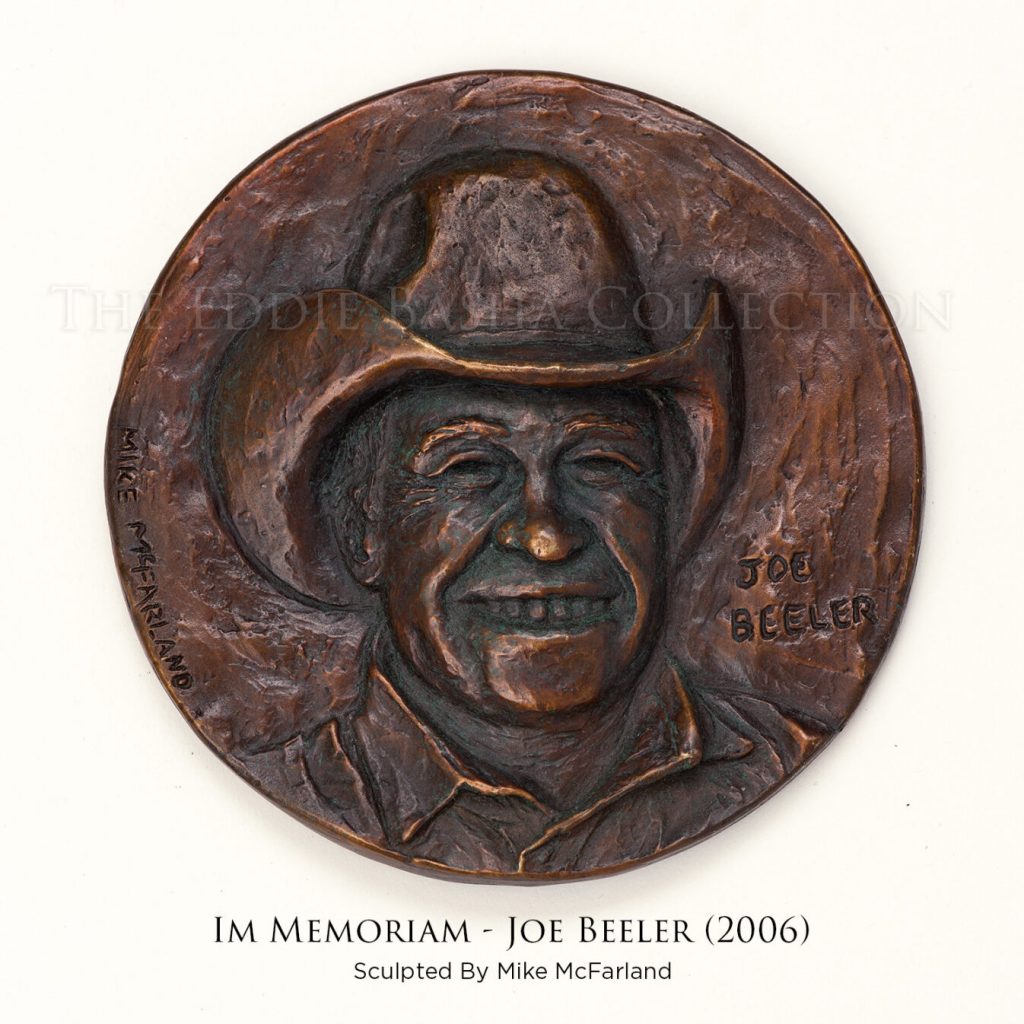 Joe Beeler, CA Founding Member (1931-2006) | Mike McFarland, Sculptor
Joe Beeler, CA Founding Member (1931-2006) | Mike McFarland, Sculptor Bronze (2006) | Dimensions: 3 ½” Diameter
Eddie Basha commissioned this medallion in 2006 following the passing of his brother, Joe Beeler. It was cast as a limited-edition series and shared with Joe’s immediate and CAA family and with other private collectors of his masterworks.
Joe Beeler, CA Founding Member (1931-2006) | Mike McFarland, Sculptor
Artist: Joe Beeler, CA Founding Member (1931-2006)
Bronze (2006) | Dimensions: 3 ½” Diameter
Eddie Basha commissioned this medallion in 2006 following the passing of his brother, Joe Beeler. It was cast as a limited-edition series and shared with Joe’s immediate and CAA family and with other private collectors of his masterworks.
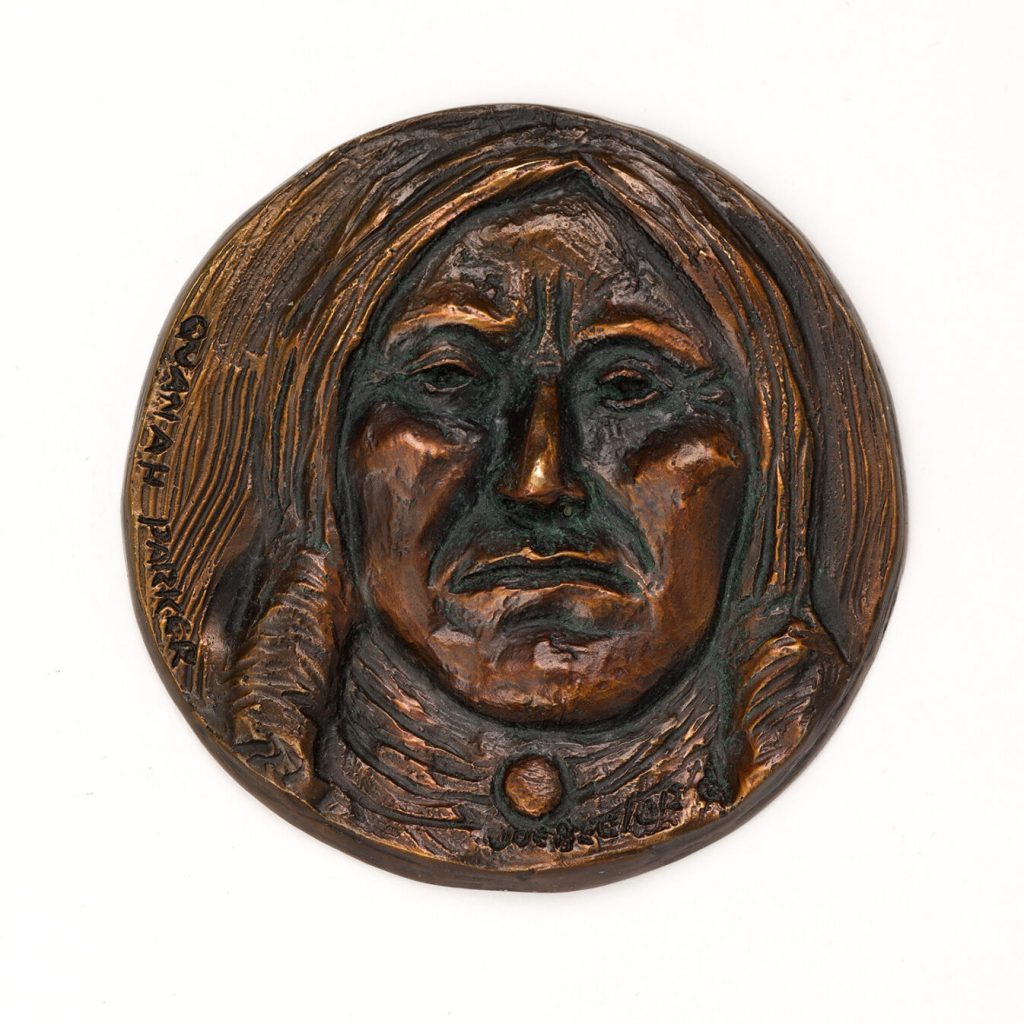 Bronze (2005) | Dimensions: 3 ½” Diameter
Bronze (2005) | Dimensions: 3 ½” Diameter In this medallion, Joe Beeler depicted the sometimes-controversial figure of the American West, Quanah Parker, who was the oldest of three mixed-race offspring of Cynthia Ann Parker and Comanche Warrior Peta Nocona. Raised in the Comanche culture, Quanah was also a warrior, chief, husband, father, rancher, deputy sheriff, church founder, community activist, and businessman. While reconnected with his maternal relatives, he studied the English language, farming techniques and culture of the white man. While varying perspectives of Quanah Parker’s life exist, there is a constant; he was an independent thinker.
Quanah Parker
Artist: Joe Beeler, CA Founding Member (1931-2006)
In this medallion, Joe Beeler depicted the sometimes-controversial figure of the American West, Quanah Parker, who was the oldest of three mixed-race offspring of Cynthia Ann Parker and Comanche Warrior Peta Nocona. Raised in the Comanche culture, Quanah was also a warrior, chief, husband, father, rancher, deputy sheriff, church founder, community activist, and businessman. While reconnected with his maternal relatives, he studied the English language, farming techniques and culture of the white man. While varying perspectives of Quanah Parker’s life exist, there is a constant; he was an independent thinker.
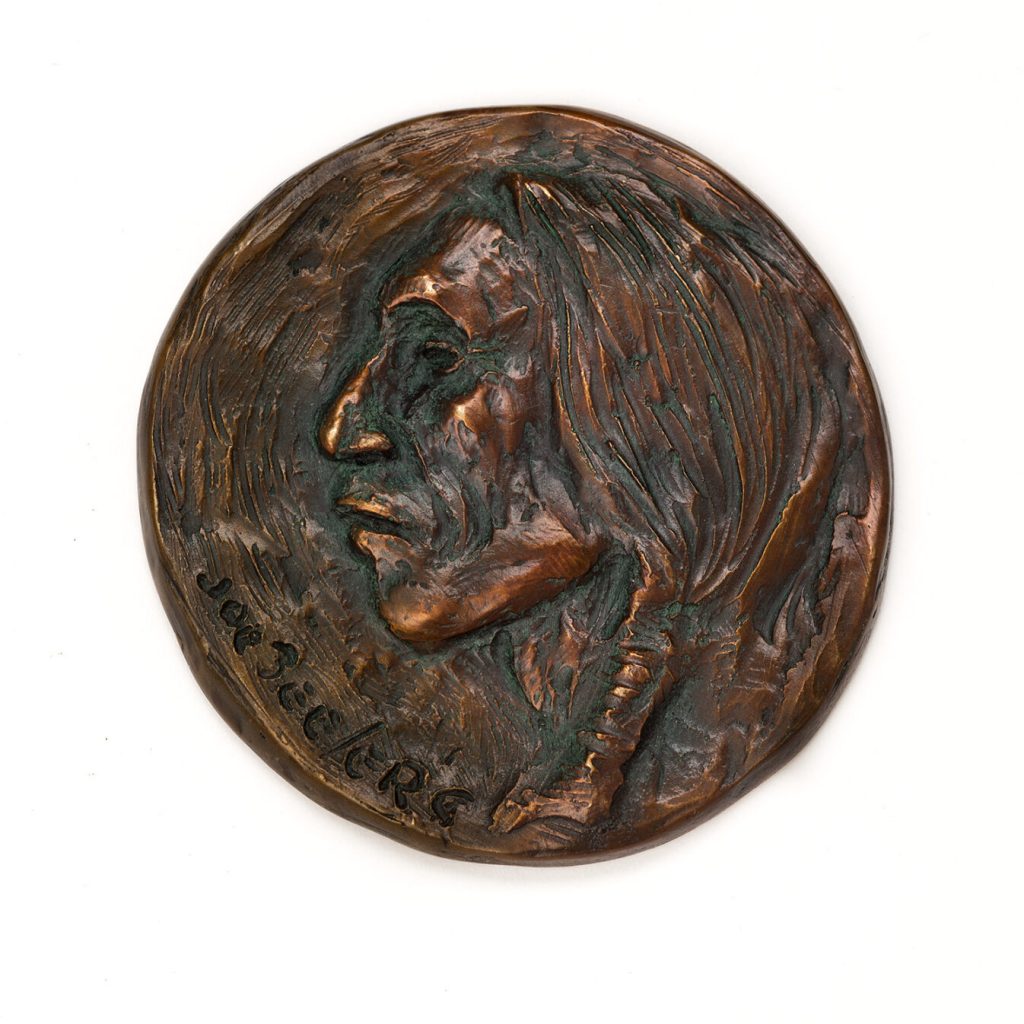 Bronze (2004) | Dimensions: 3 ½” Diameter
Bronze (2004) | Dimensions: 3 ½” Diameter The Kiowa Tribe moved from Montana to Colorado during the 17th and 18th centuries; by the early 19th century they eventually moved into the Southern Plains. And, in 1867, they were moved to an Oklahoma reservation. The Kiowa tribal headquarters is in Carnegie, OK, and there are approximately 12,000+ tribal members. In the Kiowa society, maternal and paternal lines are equally significant within its complex kinship system. And societies based on age and gender are also included within that system.
Early on the Kiowa use of tipis were preferred due to portability since they were hunters and gatherers and migrated based on the availability of bison and other wild game; women collected various varieties of wild grown berries, other fruits, seeds, nuts and vegetables. As a result, the Kiowa tended to stay in a specific locale for a longer time period. That is until they began acquiring horses from the Spanish which accorded them greater mobility.
Kiowa
Artist: Joe Beeler, CA Founding Member (1931-2006)
The Kiowa Tribe moved from Montana to Colorado during the 17th and 18th centuries; by the early 19th century they eventually moved into the Southern Plains. And, in 1867, they were moved to an Oklahoma reservation. The Kiowa tribal headquarters is in Carnegie, OK, and there are approximately 12,000+ tribal members. In the Kiowa society, maternal and paternal lines are equally significant within its complex kinship system. And societies based on age and gender are also included within that system.
Early on the Kiowa use of tipis were preferred due to portability since they were hunters and gatherers and migrated based on the availability of bison and other wild game; women collected various varieties of wild grown berries, other fruits, seeds, nuts and vegetables. As a result, the Kiowa tended to stay in a specific locale for a longer time period. That is until they began acquiring horses from the Spanish which accorded them greater mobility.
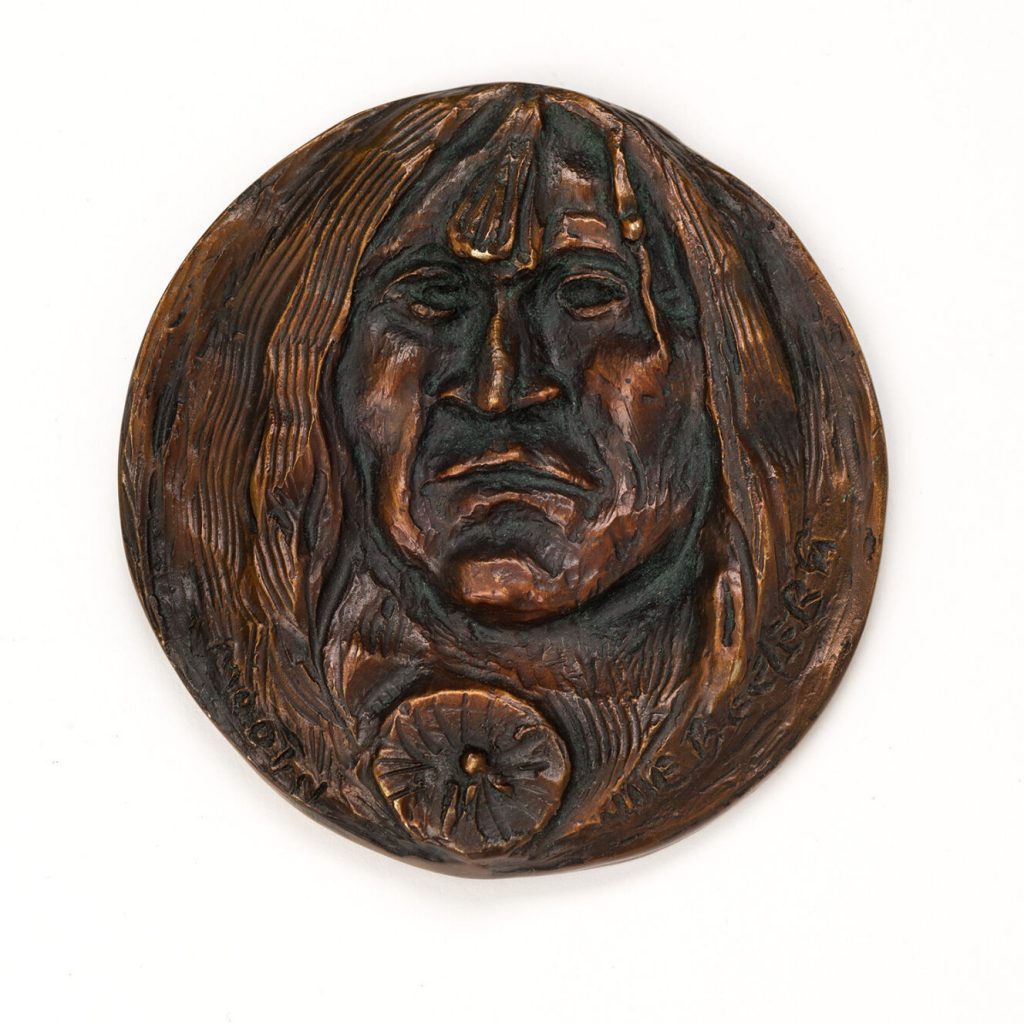 Bronze (2003) | Dimensions: 3 ½” Diameter
Bronze (2003) | Dimensions: 3 ½” Diameter The Mandan Tribe hails from the Great Plains. Historically they lived along the Missouri River and two of its tributaries, the Heart and Knife, located in present day North and South Dakota. Their culture was primarily an agrarian one and they traded harvest surpluses for items such as bison, horses and other trade goods. In fact, the Mandan established a trading post which became a central hub for other tribes and traders. A characteristic feature of male Mandan tribal members was the hair brow which Joe Beeler featured prominently in this medallion.
Mandan Medallion
Artist: Joe Beeler, CA Founding Member (1931-2006)
The Mandan Tribe hails from the Great Plains. Historically they lived along the Missouri River and two of its tributaries, the Heart and Knife, located in present day North and South Dakota. Their culture was primarily an agrarian one and they traded harvest surpluses for items such as bison, horses and other trade goods. In fact, the Mandan established a trading post which became a central hub for other tribes and traders. A characteristic feature of male Mandan tribal members was the hair brow which Joe Beeler featured prominently in this medallion.
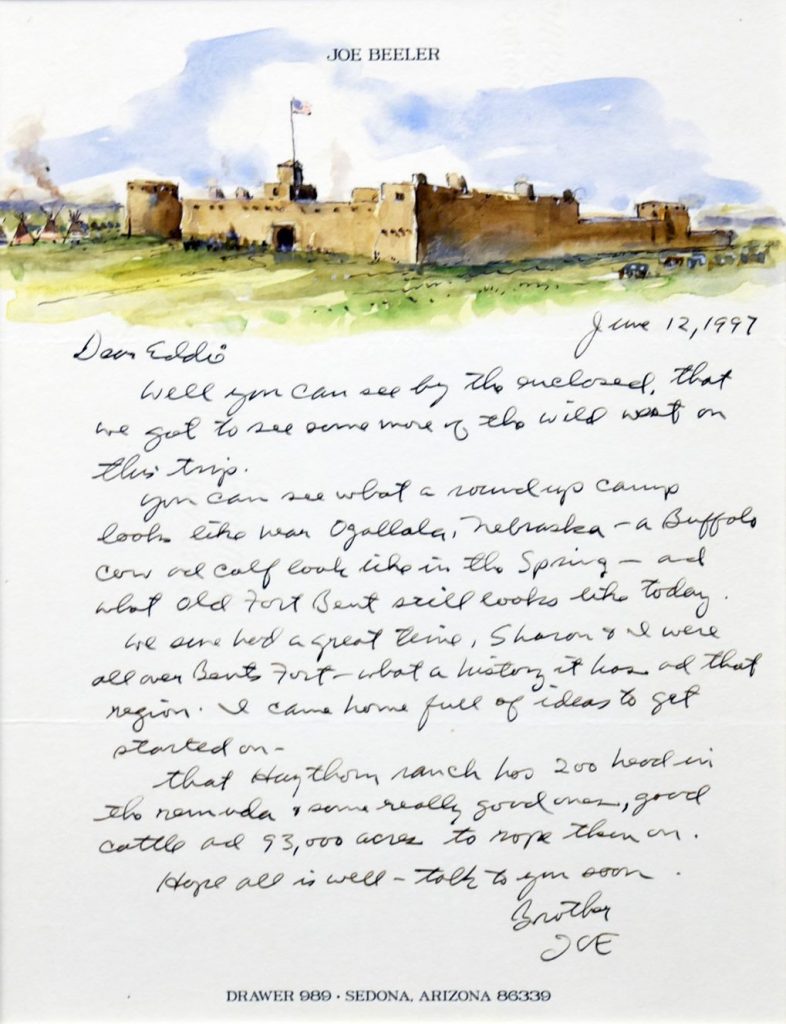 Watercolor (1997) | Image Size: 11”h x 8 ½"w; Framed Size: 17 ¾"h x 15 ¼"
Watercolor (1997) | Image Size: 11”h x 8 ½"w; Framed Size: 17 ¾"h x 15 ¼" Shortly after returning to Sedona from the 1997 Cowboy Artists of America Annual Trail Ride held at the Haythorn Land & Cattle Co. located seventeen miles north of Ogallala, Nebraska, Joe Beeler penned this letter to Eddie Basha summarizing his time at the ranch and touring thru Bent’s Old Fort National Historic Site in Colorado, otherwise known as “Castle of the Plains,” on the return trip. Joe was inspired by what he saw at the ranch and at the old fort.
“The historic site features a reconstructed 1840s adobe fur trading post on the mountain branch of the Santa Fe Trail where traders, trappers, travelers, and the Cheyenne and Arapaho tribes came together in peaceful terms for trade. Today, living historians recreate the sights, sounds, and smells of the past with guided tours, demonstrations and special events.” (Source: National Park Service)
Old Fort Bent
Artist: Joe Beeler, CA Founding Member (1931-2006)
Shortly after returning to Sedona from the 1997 Cowboy Artists of America Annual Trail Ride held at the Haythorn Land & Cattle Co. located seventeen miles north of Ogallala, Nebraska, Joe Beeler penned this letter to Eddie Basha summarizing his time at the ranch and touring thru Bent’s Old Fort National Historic Site in Colorado, otherwise known as “Castle of the Plains,” on the return trip. Joe was inspired by what he saw at the ranch and at the old fort.
“The historic site features a reconstructed 1840s adobe fur trading post on the mountain branch of the Santa Fe Trail where traders, trappers, travelers, and the Cheyenne and Arapaho tribes came together in peaceful terms for trade. Today, living historians recreate the sights, sounds, and smells of the past with guided tours, demonstrations and special events.” (Source: National Park Service)
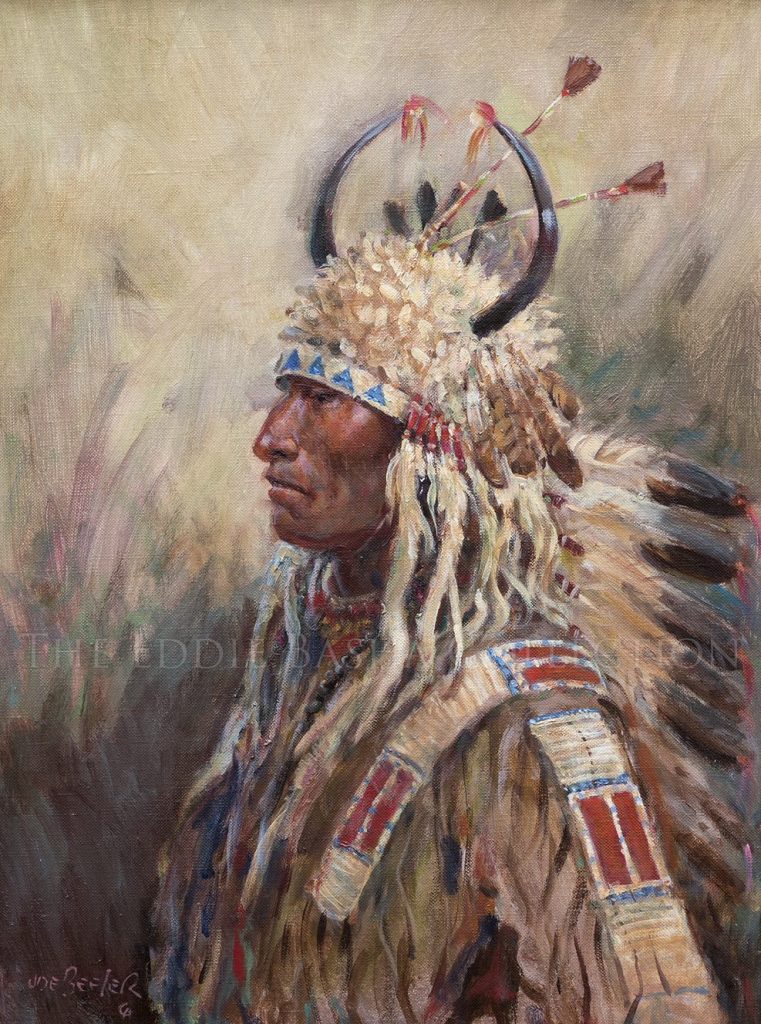 Oil (2002) | Image Size: 16”h x 12”w; Framed Size: 29”h x 25 1/8”w
Oil (2002) | Image Size: 16”h x 12”w; Framed Size: 29”h x 25 1/8”w Joe Beeler, founding member of the Cowboy Artists of America, was a prolific fine artist. In addition to his many bronze sculptures and masterwork oil paintings, Beeler completed numerous profile portraits of cowboys, mountain men, and various tribal members in a variety of mediums such this well-done oil of a high-ranking Plains warrior depicted in full regalia, with horned headdress and intricately beaded shirt. White ermine pelts hang from his headdress. These details of dress and ornamentation indicate status and show that Joe Beeler was not
only adept at portraying the essence of a man’s personality through his fine art practice but was also a careful and diligent student of western history.
Mountain Chief
Artist: Joe Beeler, CA Founding Member (1931-2006)
Joe Beeler, founding member of the Cowboy Artists of America, was a prolific fine artist. In addition to his many bronze sculptures and masterwork oil paintings, Beeler completed numerous profile portraits of cowboys, mountain men, and various tribal members in a variety of mediums such this well-done oil of a high-ranking Plains warrior depicted in full regalia, with horned headdress and intricately beaded shirt. White ermine pelts hang from his headdress. These details of dress and ornamentation indicate status and show that Joe Beeler was not
only adept at portraying the essence of a man’s personality through his fine art practice but was also a careful and diligent student of western history.
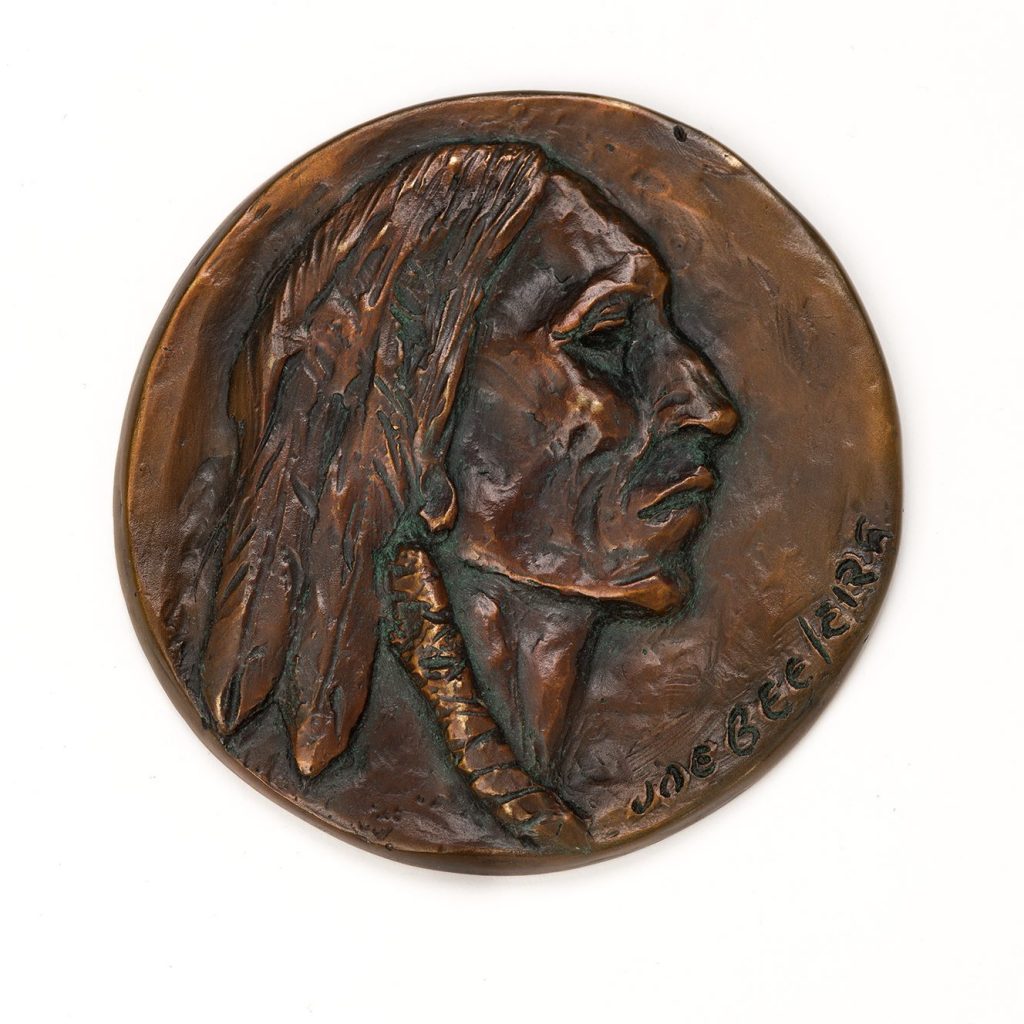 Bronze (2002) | Dimensions: 3 ½” Diameter
Bronze (2002) | Dimensions: 3 ½” Diameter Sioux Medallion
Artist: Joe Beeler, CA Founding Member (1931-2006)
 Oil | Image Size: 24”h x 48”w; Framed Size: 34”h x 58”w
Oil | Image Size: 24”h x 48”w; Framed Size: 34”h x 58”wThe Chuck Wagon was essentially the heart of the home while working on a roundup. It’s where the hands gathered before and after a hard day’s work, broke bread and socialized. And it was no secret that Cookie’s job was every bit as important as the work of the hands; a fed and rested cowboy was more likely to work harder and keep a better temperament than one without. Meals frequently consisting of beans and/or beef and biscuits were prepared in Dutch ovens and cast-iron skillets and the coffee was hot. Joe Beeler’s oil, “Morning in a Roundup Camp” personifies just that.
This piece was loaned to the University of Texas Institute of Texan Cultures in San Antonio in 1985. And, more recently, to Western Spirit Scottsdale’s Museum of the West in 2018 for “The Art of Joe Beeler: A Western Original” retrospective. A photographed image of this oil painting has also appeared in three books: “Cowboy Artist: The Joe Beeler Story” published in 1979, “Cowboy Artists of America” published in 1988, and “Joe Beeler: Life of a Cowboy Artist” published in 2004.
Morning in a Roundup Camp
Artist: Joe Beeler, CA Founding Member (1931-2006)
The Chuck Wagon was essentially the heart of the home while working on a roundup. It’s where the hands gathered before and after a hard day’s work, broke bread and socialized. And it was no secret that Cookie’s job was every bit as important as the work of the hands; a fed and rested cowboy was more likely to work harder and keep a better temperament than one without. Meals frequently consisting of beans and/or beef and biscuits were prepared in Dutch ovens and cast-iron skillets and the coffee was hot. Joe Beeler’s oil, “Morning in a Roundup Camp” personifies just that.
This piece was loaned to the University of Texas Institute of Texan Cultures in San Antonio in 1985. And, more recently, to Western Spirit Scottsdale’s Museum of the West in 2018 for “The Art of Joe Beeler: A Western Original” retrospective. A photographed image of this oil painting has also appeared in three books: “Cowboy Artist: The Joe Beeler Story” published in 1979, “Cowboy Artists of America” published in 1988, and “Joe Beeler: Life of a Cowboy Artist” published in 2004.
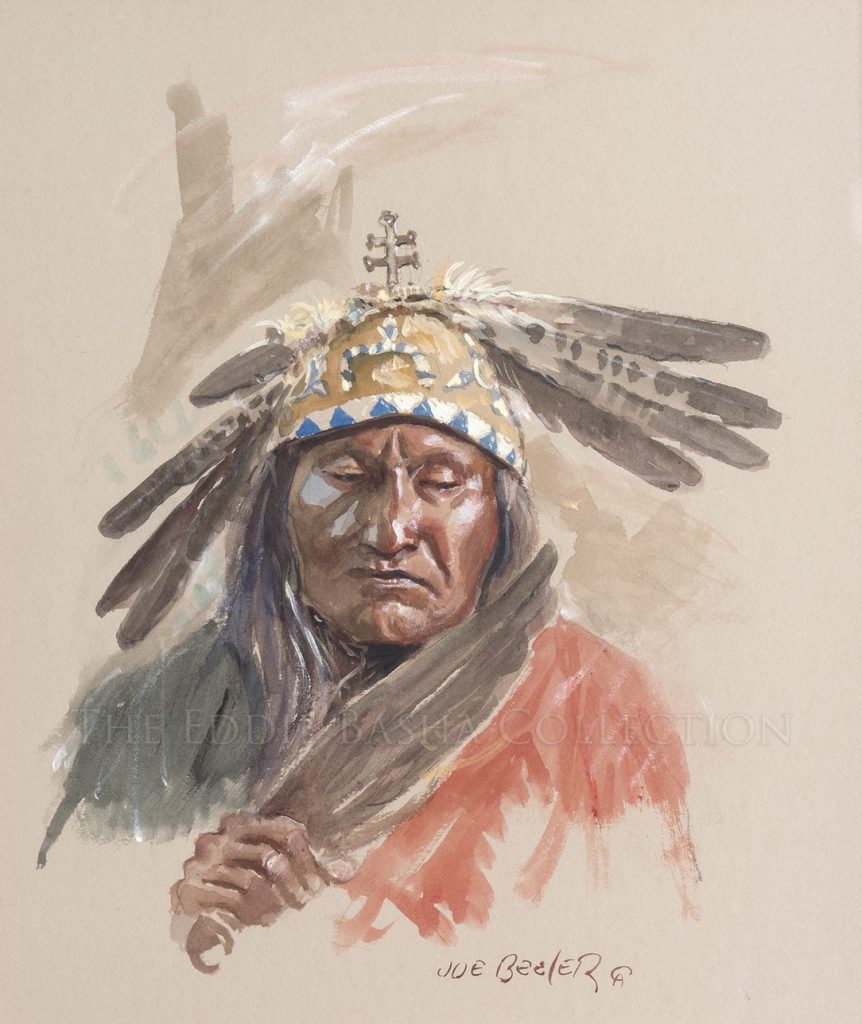 Watercolor | Image Size: 14”h x 10”w; Framed Size: 24”h x 21 ½"w
Watercolor | Image Size: 14”h x 10”w; Framed Size: 24”h x 21 ½"w A splash of color adds contrast and interest to this small, but detailed portrait of an American Indian wearing a headpiece embellished with feathers, a silver cross and beadwork. He holds an eagle feather in his hand. His face reveals years of experience and character.
Unknown Title
Artist: Joe Beeler, CA Founding Member (1931-2006)
A splash of color adds contrast and interest to this small, but detailed portrait of an American Indian wearing a headpiece embellished with feathers, a silver cross and beadwork. He holds an eagle feather in his hand. His face reveals years of experience and character.
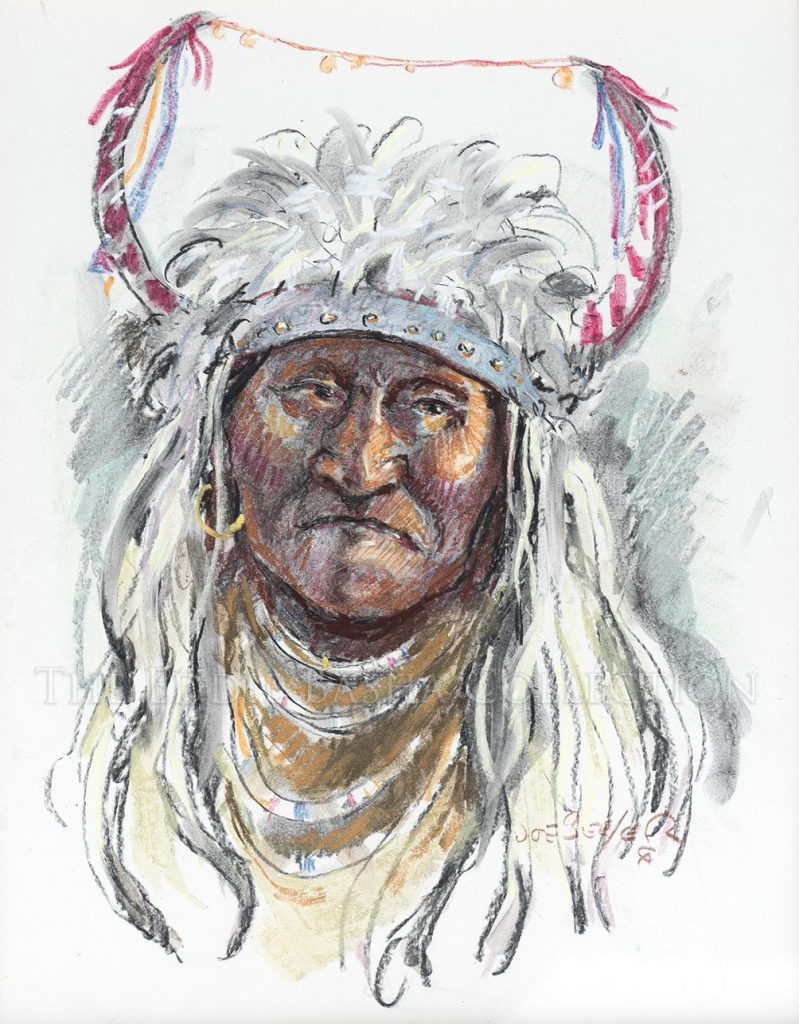 Watercolor & Conte Crayon| Image Size: 14”h x 10”w; Framed Size: 21 ½"h x 18 ½"w
Watercolor & Conte Crayon| Image Size: 14”h x 10”w; Framed Size: 21 ½"h x 18 ½"w This watercolor and crayon portrait shows a Plains Indian wearing a horned headdress. He is identified as a Sundance chief. “The Sundance” was a religious ritual practiced by several Plains tribes. It normally lasted for several days. Dancers were typically young men who often pierced their chests to achieve a trance like state.
Portrait of Sundance Chief
Artist: Joe Beeler, CA Founding Member (1931-2006)
This watercolor and crayon portrait shows a Plains Indian wearing a horned headdress. He is identified as a Sundance chief. “The Sundance” was a religious ritual practiced by several Plains tribes. It normally lasted for several days. Dancers were typically young men who often pierced their chests to achieve a trance like state.
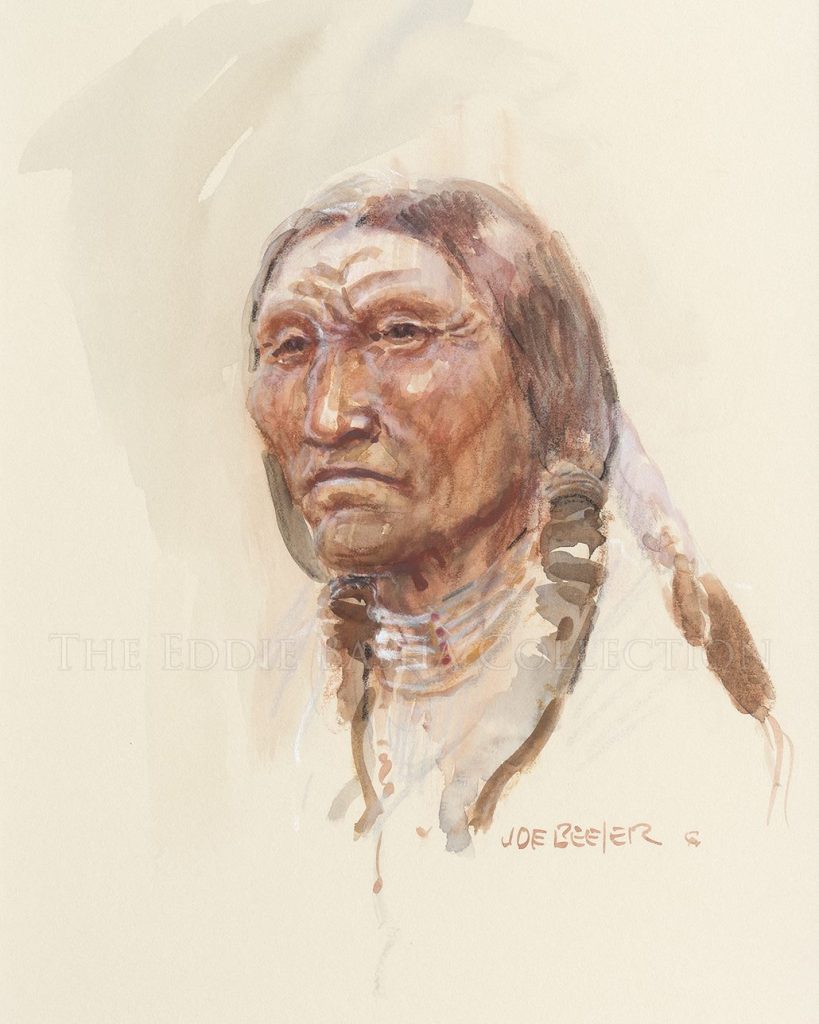 Watercolor | Image Size: 14”h x 10”w; Framed Size: 21”h x 16 ¾"w
Watercolor | Image Size: 14”h x 10”w; Framed Size: 21”h x 16 ¾"wThis is a straightforward, small watercolor portrait of a Plains Indian set against a white background. The subject wears his hair in braids and is wearing a bone necklace with a medallion.
Unknown Title
Artist: Joe Beeler, CA Founding Member (1931-2006)
This is a straightforward, small watercolor portrait of a Plains Indian set against a white background. The subject wears his hair in braids and is wearing a bone necklace with a medallion.
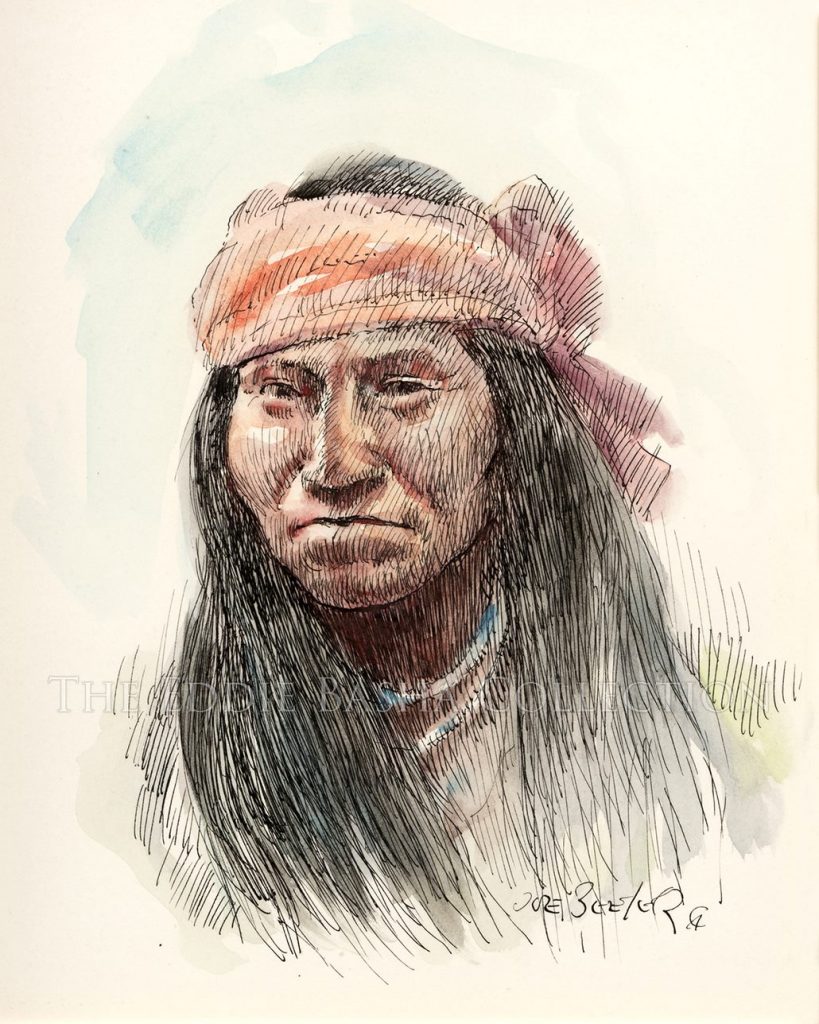 Watercolor (Watermarker) | Image Size: 10”h x 8”w; Framed Size: 18 ¼"h x 16 ¼"w
Watercolor (Watermarker) | Image Size: 10”h x 8”w; Framed Size: 18 ¼"h x 16 ¼"w This is a small watercolor portrait of an Apache Indian gazing directly at the viewer. He has long black hair and is wearing a red scarf around his forehead. The portrait is set against a simple background of blue and white.
Unknown Title
Artist: Joe Beeler, CA Founding Member (1931-2006)
This is a small watercolor portrait of an Apache Indian gazing directly at the viewer. He has long black hair and is wearing a red scarf around his forehead. The portrait is set against a simple background of blue and white.
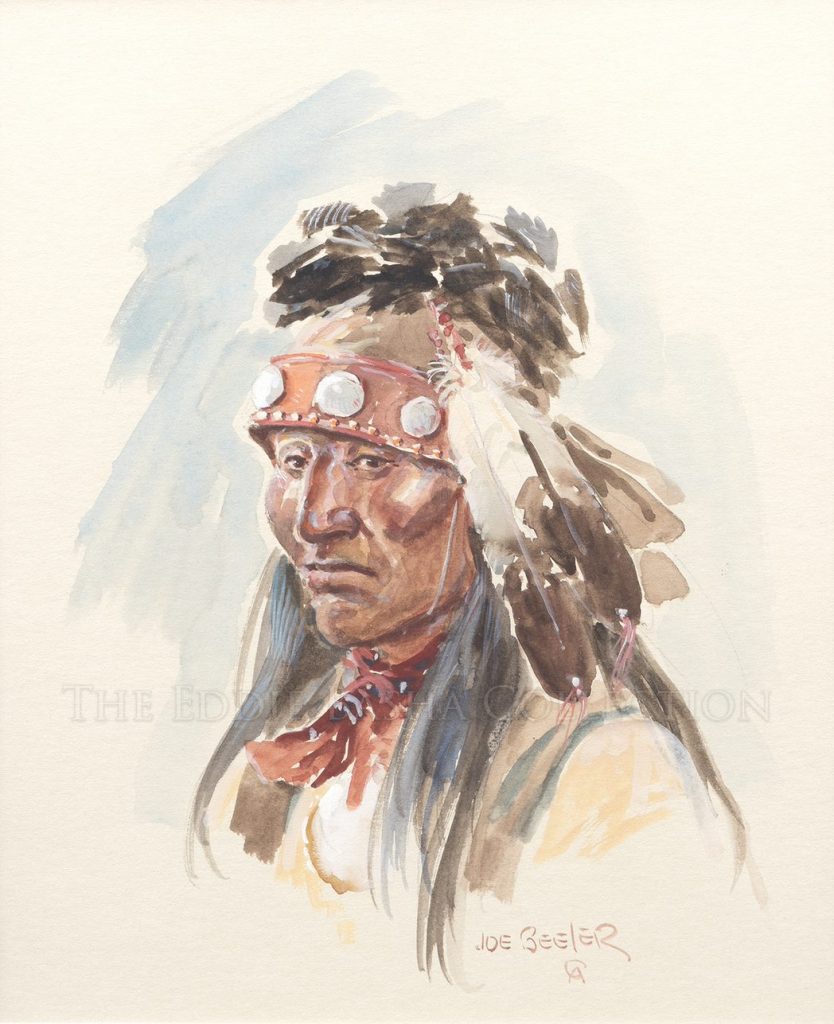 Watercolor (1977) | Image Size: 11”h x 9”w; Framed Size: 19 1/8”h x 17”w
Watercolor (1977) | Image Size: 11”h x 9”w; Framed Size: 19 1/8”h x 17”w This note from Joe Beeler to Eddie Basha appears on the reverse side of the watercolor: “Eddie, this cap was made of turkey feathers trimmed w/two eagle feathers and worn by a war leader among the Apaches. It also had silver conchos and red flannel or material on the top. If you were an Apache you would have worn one of these for sure. Your friend, Joe Beeler 1977”
Unknown Title
Artist: Joe Beeler, CA Founding Member (1931-2006)
This note from Joe Beeler to Eddie Basha appears on the reverse side of the watercolor: “Eddie, this cap was made of turkey feathers trimmed w/two eagle feathers and worn by a war leader among the Apaches. It also had silver conchos and red flannel or material on the top. If you were an Apache you would have worn one of these for sure. Your friend, Joe Beeler 1977”
 Oil | Image Size: 24”h x 40”w; Framed Size: 34 ½"h x 50”w
Oil | Image Size: 24”h x 40”w; Framed Size: 34 ½"h x 50”w Joe Beeler, Cowboy Artists of America Founding Member, conveys a sense of the frigid weather in this scene of Texas Rangers resting beside a campfire.
They are sharing a cup of coffee and the warmth of the fire with their prisoners camped beside an abandoned adobe structure on a snow covered plain. Beeler uses whites and silver blues to impart a sense of the winter weather. Light is provided by the glow
of the campfire and the rising sun. The crumbling adobe in the background adds a sense of desolation to the overall feeling of the painting.
“Sharing the Cold and the Coffee” has been exhibited at the University of Texas Institute of Texan Cultures at San Antonio in 1985 and at Western Spirit: Scottsdale Museum of the West in 2018. An image of the piece also appears on page 93 in the book entitled “Joe Beeler: Life of a Cowboy Artist” authorized by Don Hedgpeth and published by Diamond Tail Press in 2004.
Sharing the Cold and the Coffee
Artist: Joe Beeler, CA Founding Member (1931-2006)
Joe Beeler, Cowboy Artists of America Founding Member, conveys a sense of the frigid weather in this scene of Texas Rangers resting beside a campfire.
They are sharing a cup of coffee and the warmth of the fire with their prisoners camped beside an abandoned adobe structure on a snow covered plain. Beeler uses whites and silver blues to impart a sense of the winter weather. Light is provided by the glow
of the campfire and the rising sun. The crumbling adobe in the background adds a sense of desolation to the overall feeling of the painting.
“Sharing the Cold and the Coffee” has been exhibited at the University of Texas Institute of Texan Cultures at San Antonio in 1985 and at Western Spirit: Scottsdale Museum of the West in 2018. An image of the piece also appears on page 93 in the book entitled “Joe Beeler: Life of a Cowboy Artist” authorized by Don Hedgpeth and published by Diamond Tail Press in 2004.
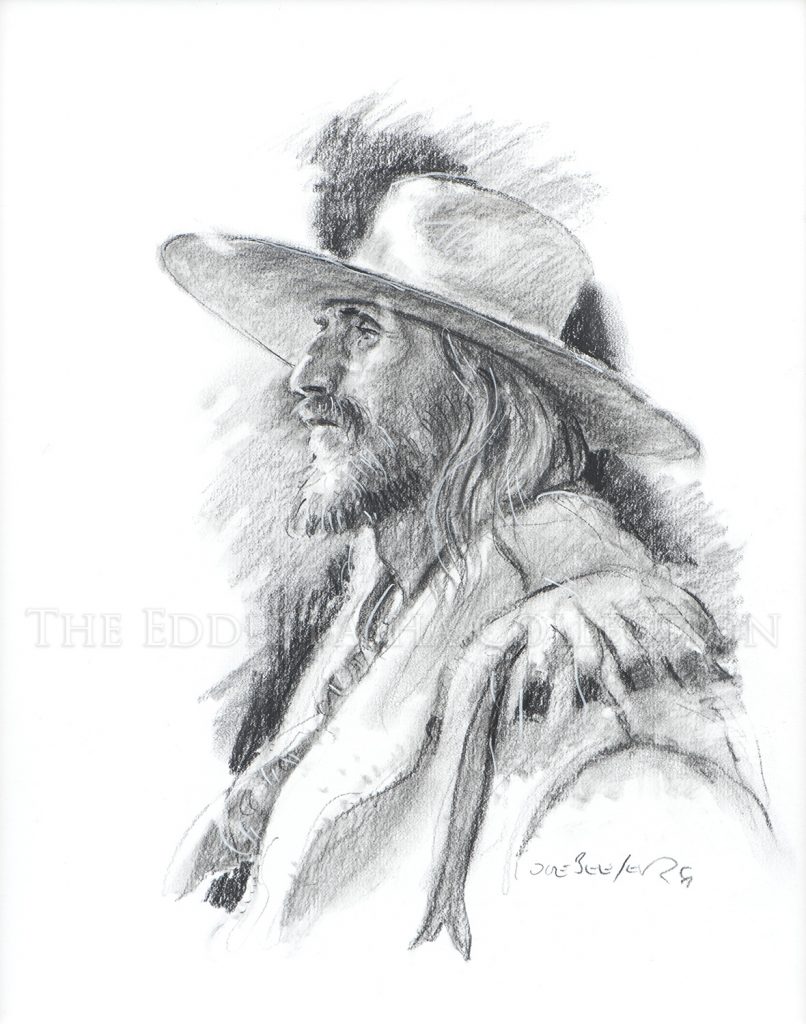 Charcoal | Image Size: 14”h x 11”w; Framed Size: 21 ½”h x 18 ½”w
Charcoal | Image Size: 14”h x 11”w; Framed Size: 21 ½”h x 18 ½”w Cowboy Artists of America Founding Member Joe Beeler’s drawing of a mountain man shown in profile is a well-done charcoal depiction that is small, but rich in period
detail featuring a wide brimmed hat and pelt overcoat. The man’s weathered facial features highlight his worn squint.
This charcoal was exhibited at Western Spirit: Scottsdale’s Museum of the West 2018 retrospective “The Art of Joe Beeler: A Western Original.”
Unknown Title
Artist: Joe Beeler, CA Founding Member (1931-2006)
Cowboy Artists of America Founding Member Joe Beeler’s drawing of a mountain man shown in profile is a well-done charcoal depiction that is small, but rich in period
detail featuring a wide brimmed hat and pelt overcoat. The man’s weathered facial features highlight his worn squint.
This charcoal was exhibited at Western Spirit: Scottsdale’s Museum of the West 2018 retrospective “The Art of Joe Beeler: A Western Original.”
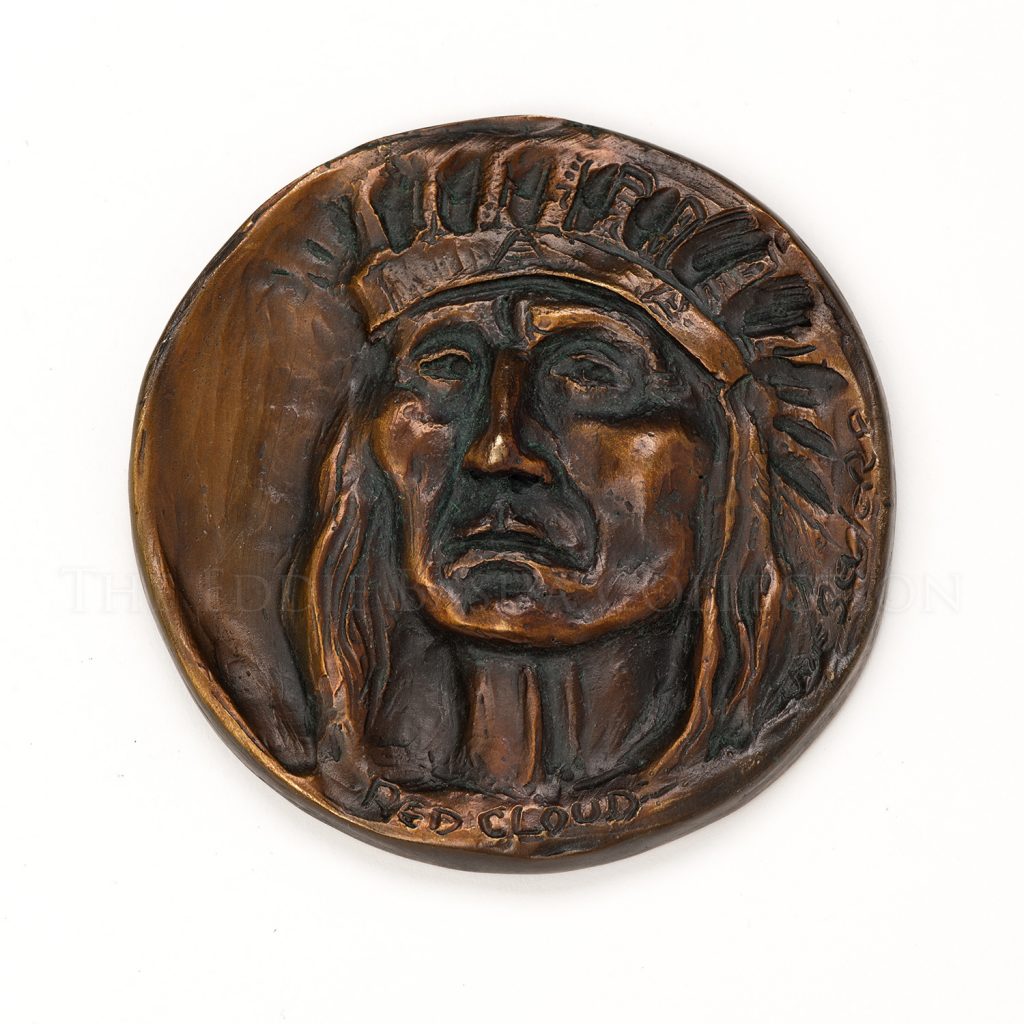 Bronze Medallion (2000) | Dimensions: 3 ½” Diameter
Bronze Medallion (2000) | Dimensions: 3 ½” Diameter“Red Cloud,” the next in the series of Beeler Medallions, was a fierce warrior and leader of the Oglala Sioux. He was born in 1822 in then what was the Nebraska Territory. Following his show of strength in leadership and bravery in many battles against the Oglala traditional enemies at the time, the Pawnees, Crows, Utes and Shoshones, Red Cloud became Chief.
After the discovery of Gold in Montana during the early 1860’s, a road was constructed from Ft. Laramie to the gold fields. A series of forts were also constructed to protect what later became known as the Bozeman Trail. The Oglala, led by Red Cloud, and the Cheyenne began fighting in 1865 aggressively against the soldiers, settlers, and miners for a period of approximately two years forcing their opponents to abandon their forts and stop progress on road construction. At the end of that time, Red Cloud singed the Second Treaty of Fort Laramie and agreed to stop fighting and moved onto the Red Cloud Agency, a reservation in Nebraska.
Was it a smooth transition? Not by a long shot. However, Red Cloud began serving his people as a diplomat. In 1870 and in 1875, he travelled to Washington along with other tribal leaders and there they met with President Grant. Negotiations didn’t go so well then either after multiple promises had not been kept.
Additional details of Red Cloud’s leadership role and that of his contemporaries can be found on numerous websites, at public libraries and in historical records. Unfortunately, within this limited space only a small summary can be shared.
Red Cloud
Artist: Joe Beeler, CA Founding Member (1931-2006)
“Red Cloud,” the next in the series of Beeler Medallions, was a fierce warrior and leader of the Oglala Sioux. He was born in 1822 in then what was the Nebraska Territory. Following his show of strength in leadership and bravery in many battles against the Oglala traditional enemies at the time, the Pawnees, Crows, Utes and Shoshones, Red Cloud became Chief.
After the discovery of Gold in Montana during the early 1860’s, a road was constructed from Ft. Laramie to the gold fields. A series of forts were also constructed to protect what later became known as the Bozeman Trail. The Oglala, led by Red Cloud, and the Cheyenne began fighting in 1865 aggressively against the soldiers, settlers, and miners for a period of approximately two years forcing their opponents to abandon their forts and stop progress on road construction. At the end of that time, Red Cloud singed the Second Treaty of Fort Laramie and agreed to stop fighting and moved onto the Red Cloud Agency, a reservation in Nebraska.
Was it a smooth transition? Not by a long shot. However, Red Cloud began serving his people as a diplomat. In 1870 and in 1875, he travelled to Washington along with other tribal leaders and there they met with President Grant. Negotiations didn’t go so well then either after multiple promises had not been kept.
Additional details of Red Cloud’s leadership role and that of his contemporaries can be found on numerous websites, at public libraries and in historical records. Unfortunately, within this limited space only a small summary can be shared.
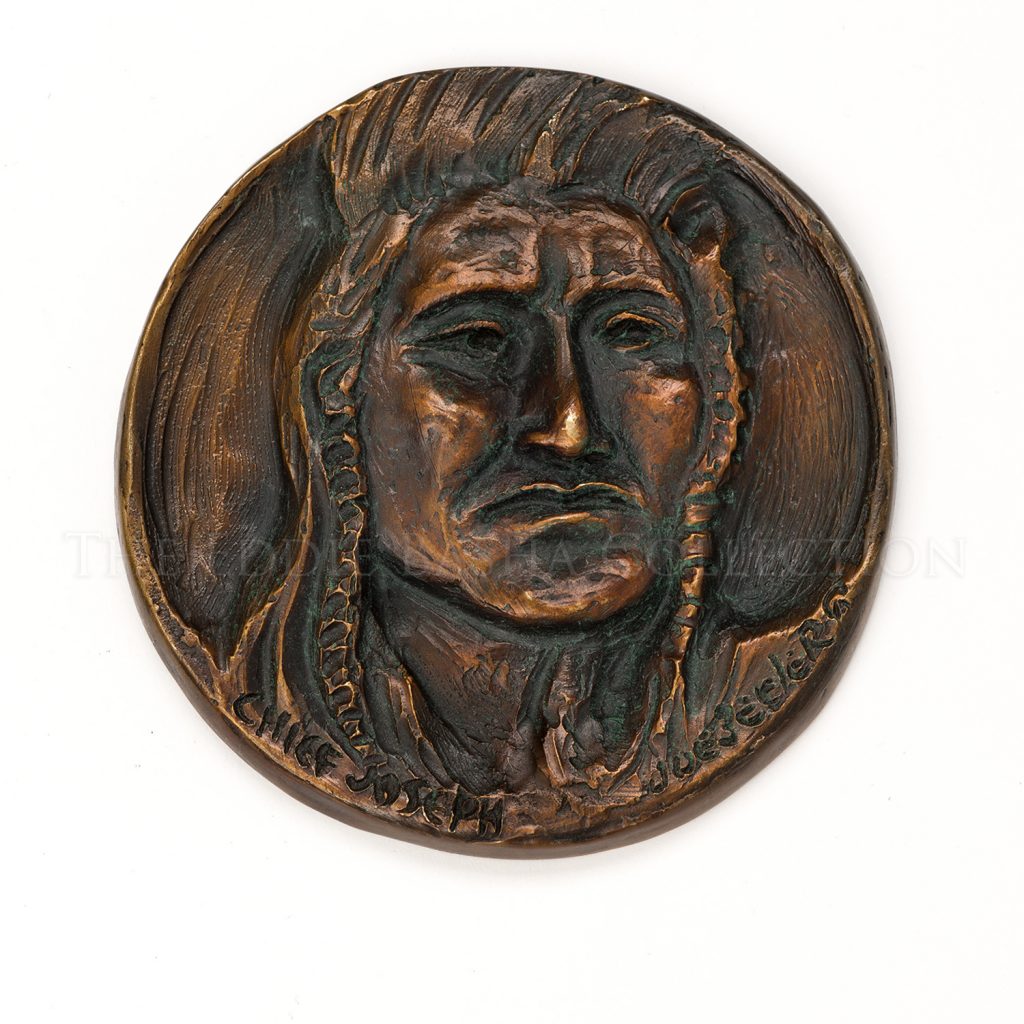 Bronze (1999) | Dimensions: 3 ½” Diameter
Bronze (1999) | Dimensions: 3 ½” DiameterChief Joseph, led his band of Nez Perce Indians, approximately 700 men, women and children, on an epic journey, over 1100 miles, in the late 19th century across Oregon, Washington, Montana, Idaho, and Wyoming in an attempt to reach a safe haven in Canada while being pursued by the U.S. Army. Under some of the harshest conditions, the Nez Perce fought not only skillfully but their comportment earned them extensive admiration from their opponents as well as the public who followed the war coverage as reported in the newspapers. It is said Chief Joseph died of a broken heart.
Cowboy Artists of America Founding Member, Joe Beeler, sculpted this medallion in 1999.
Chief Joseph
Artist: Joe Beeler, CA Founding Member (1931-2006)
Chief Joseph, led his band of Nez Perce Indians, approximately 700 men, women and children, on an epic journey, over 1100 miles, in the late 19th century across Oregon, Washington, Montana, Idaho, and Wyoming in an attempt to reach a safe haven in Canada while being pursued by the U.S. Army. Under some of the harshest conditions, the Nez Perce fought not only skillfully but their comportment earned them extensive admiration from their opponents as well as the public who followed the war coverage as reported in the newspapers. It is said Chief Joseph died of a broken heart.
Cowboy Artists of America Founding Member, Joe Beeler, sculpted this medallion in 1999.
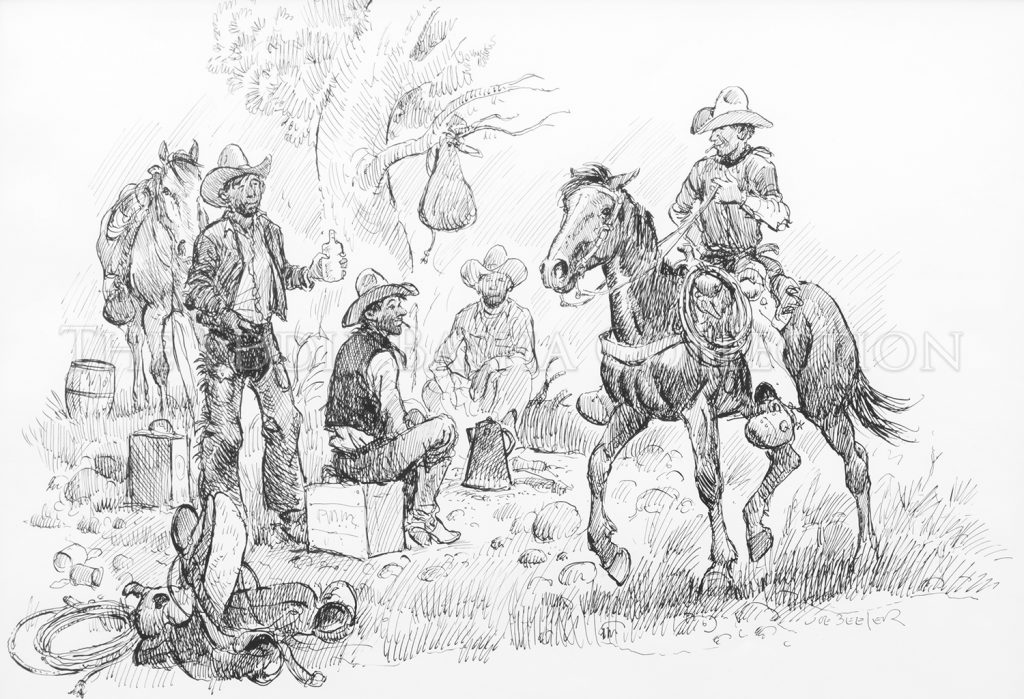 Pen & Ink | Image Size: 12”h x 16”w; Framed Size: 18 1/8”h x 22 ¾”w
Pen & Ink | Image Size: 12”h x 16”w; Framed Size: 18 1/8”h x 22 ¾”wIn his book “An Uncommonly Frank Autobiography … F-F-F-Frank Polk,” illustrated by Joe Beeler, Frank shared the following: “Now I want to tell you about one of the funniest outfits I ever worked for. I was up there at Camp Wood helpin’ my best friend, Dave Hill. This was durin’ the Depression, an’ I was wantin’ to get a payin’ job. So I heard there was a couple of fellers by the name of Les Jenkins and Casey Jones who was gathering a remnant of wild cattle. I heard they was kind’a short of help, so I told Dave, I think I’ll go down there an’ see if they want to hire somebody.
Well, I saddled up a horse an’ I rode down there about thirty miles to their camp. I rode into that camp, an’ that was the goldurnest thing I ever did see. Al of them guys had—an’ ‘m tellin’ the truth—was a five-gallon keg of whiskey, a sack of jerky an’ a sack ‘a flour. That’s all the commodities they had. It was a wild outfit, an’ I guess they just stayed drunk all the time. So I went up to this ol’ Les Jenkins, an’ he say to me, “we can’t afford to hire nobody. We’re just tryin’ to get these durn wild cattle out of here.”
So I said, “Well, hell, I’ll just stay down here an’ help.”
We, we trapped a lot of cattle an’ led ‘em out of there. An’ ol’ Jenkins, he got so drunk one day he fell off his horse an’ we had to go find him ‘cause his horse came in without him.
I’ll tell you that was jist a funny doggoned outfit. I stayed with that outfit until the whiskey ran out, an’ later I’d tell the story on ‘em—that all they had in the world was a five-gallon keg of whiskey, a sack of jerky an’ a sack of flour!”
Unknown Title
Artist: Joe Beeler, CA Founding Member (1931-2006)
In his book “An Uncommonly Frank Autobiography … F-F-F-Frank Polk,” illustrated by Joe Beeler, Frank shared the following: “Now I want to tell you about one of the funniest outfits I ever worked for. I was up there at Camp Wood helpin’ my best friend, Dave Hill. This was durin’ the Depression, an’ I was wantin’ to get a payin’ job. So I heard there was a couple of fellers by the name of Les Jenkins and Casey Jones who was gathering a remnant of wild cattle. I heard they was kind’a short of help, so I told Dave, I think I’ll go down there an’ see if they want to hire somebody.
Well, I saddled up a horse an’ I rode down there about thirty miles to their camp. I rode into that camp, an’ that was the goldurnest thing I ever did see. Al of them guys had—an’ ‘m tellin’ the truth—was a five-gallon keg of whiskey, a sack of jerky an’ a sack ‘a flour. That’s all the commodities they had. It was a wild outfit, an’ I guess they just stayed drunk all the time. So I went up to this ol’ Les Jenkins, an’ he say to me, “we can’t afford to hire nobody. We’re just tryin’ to get these durn wild cattle out of here.”
So I said, “Well, hell, I’ll just stay down here an’ help.”
We, we trapped a lot of cattle an’ led ‘em out of there. An’ ol’ Jenkins, he got so drunk one day he fell off his horse an’ we had to go find him ‘cause his horse came in without him.
I’ll tell you that was jist a funny doggoned outfit. I stayed with that outfit until the whiskey ran out, an’ later I’d tell the story on ‘em—that all they had in the world was a five-gallon keg of whiskey, a sack of jerky an’ a sack of flour!”
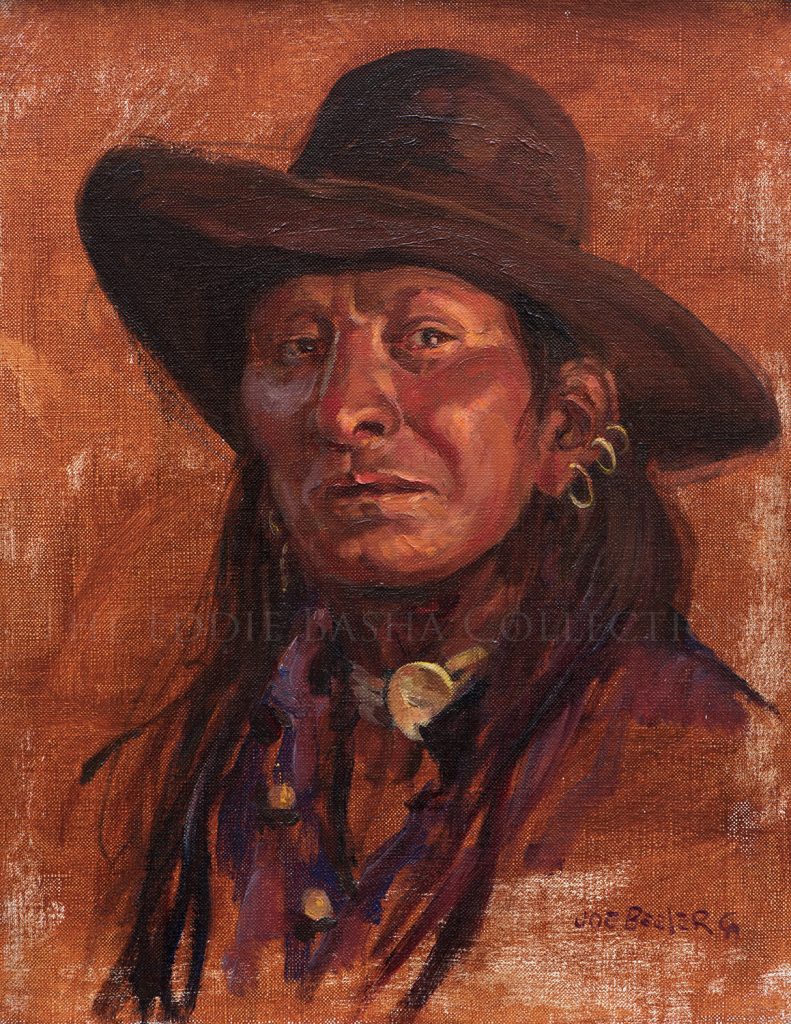 Oil | Dimensions: Image Size: 14”h x 11”w; Framed Size: 24 ½”h x 21 ½”w
Oil | Dimensions: Image Size: 14”h x 11”w; Framed Size: 24 ½”h x 21 ½”wA photographed image of this oil painting is depicted in the book entitled “Joe Beeler: Life of a Cowboy Artist”, authored by Don Hedgpeth and published by Diamond Tail Press in 2004. The original oil was loaned and exhibited at the Arizona State Capitol Speaker’s Conference Area May 2019-June 2022.
This well done and effective small oil portrait of an Indian shows him looking directly at the viewer with a steady and resolute gaze. Beeler successfully uses a rich, rust color in varying hues on both the man and the background thereby illuminating the subject’s earrings, bone and shell choker, and shirt buttons.
Your Enemies are Mine
Artist: Joe Beeler, CA Founding Member (1931-2006)
A photographed image of this oil painting is depicted in the book entitled “Joe Beeler: Life of a Cowboy Artist”, authored by Don Hedgpeth and published by Diamond Tail Press in 2004. The original oil was loaned and exhibited at the Arizona State Capitol Speaker’s Conference Area May 2019-June 2022.
This well done and effective small oil portrait of an Indian shows him looking directly at the viewer with a steady and resolute gaze. Beeler successfully uses a rich, rust color in varying hues on both the man and the background thereby illuminating the subject’s earrings, bone and shell choker, and shirt buttons.
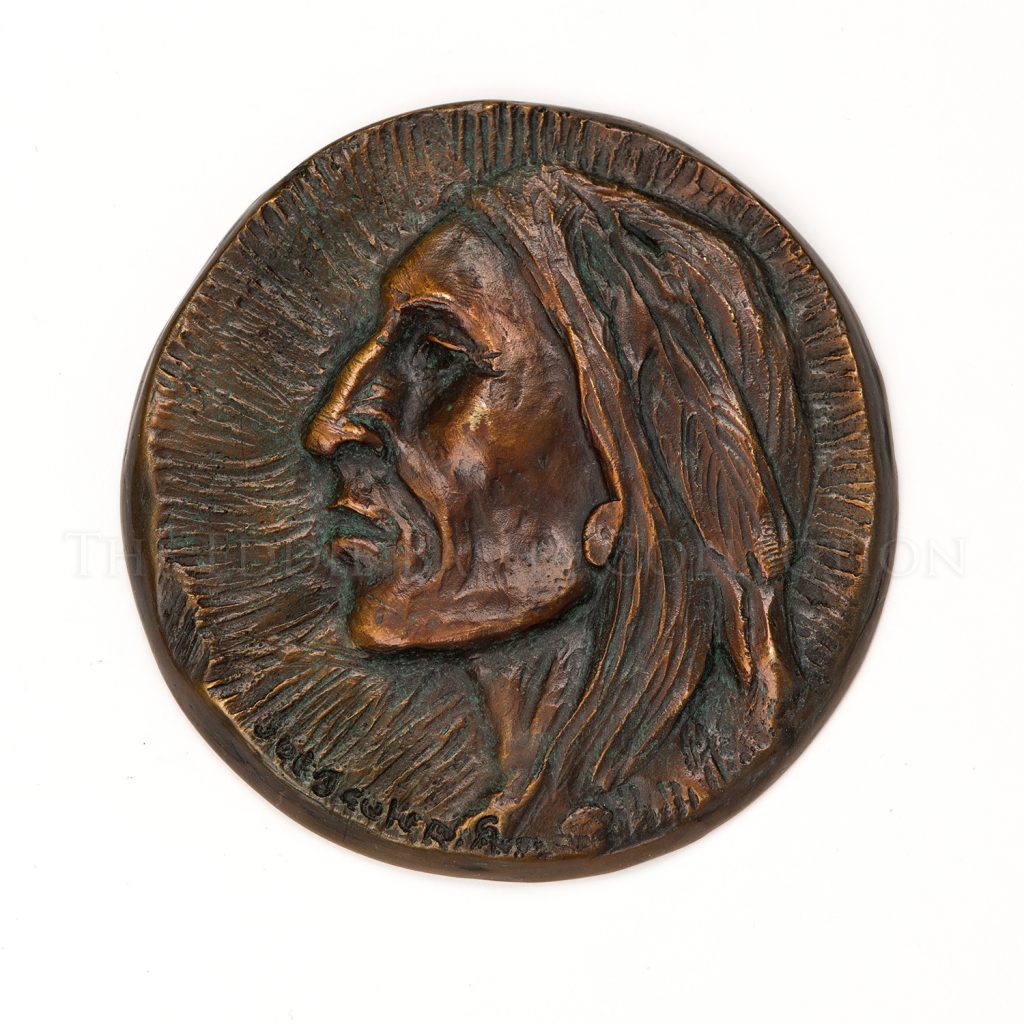 Bronze (1998) | Dimensions: 3 ½” Diameter
Bronze (1998) | Dimensions: 3 ½” DiameterCAA Founding Member, Joe Beeler, sculpted this bronze in 1998; it was cast in bronze at the Bronzesmith Fine Art Foundry & Gallery in Prescott, Arizona, and subsequently gifted by Eddie Basha.
Unknown Title
Artist: Joe Beeler, CA Founding Member (1931-2006)
CAA Founding Member, Joe Beeler, sculpted this bronze in 1998; it was cast in bronze at the Bronzesmith Fine Art Foundry & Gallery in Prescott, Arizona, and subsequently gifted by Eddie Basha.
 Watercolor | Image Size: 10”h x 9”w; Framed Size: 17 ¼”h x 16”w
Watercolor | Image Size: 10”h x 9”w; Framed Size: 17 ¼”h x 16”wThis small profile portrait of a Plains Indian by Joe Beeler is rich in detail. The man wears eagle feathers in his hair and a shell and bone necklace. One of the most striking features, however, is the dramatic face paint which begins on the man’s forehead and extends in long lines to his chin. His expression is stoic and resolute.
This watercolor was also on loan at the Arizona State Capitol in the Speaker of the House’s Conference Area, May 2019 through June 2022.
Unknown Title
Artist: Joe Beeler, CA Founding Member (1931-2006)
This small profile portrait of a Plains Indian by Joe Beeler is rich in detail. The man wears eagle feathers in his hair and a shell and bone necklace. One of the most striking features, however, is the dramatic face paint which begins on the man’s forehead and extends in long lines to his chin. His expression is stoic and resolute.
This watercolor was also on loan at the Arizona State Capitol in the Speaker of the House’s Conference Area, May 2019 through June 2022.
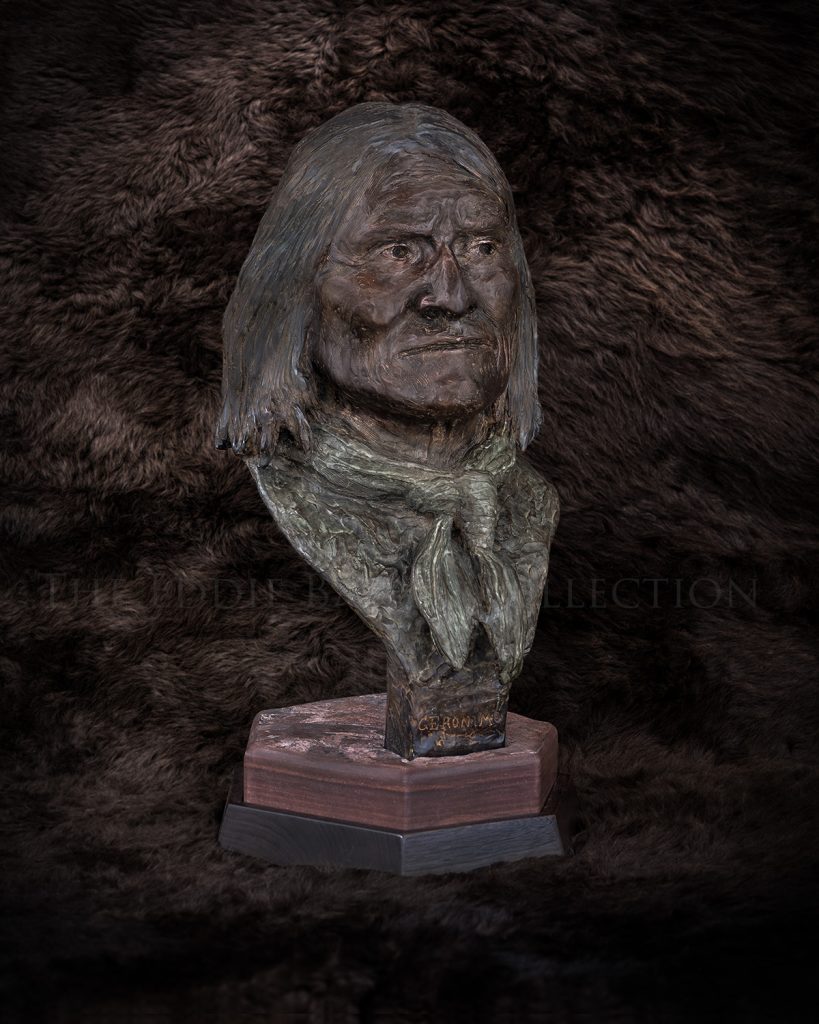 Bronze | Dimensions: 24”h x 12”w x 12”d; Edition #1 of 45
Bronze | Dimensions: 24”h x 12”w x 12”d; Edition #1 of 45Joe Beeler’s bronze bust of one of the most famous American Indians in history depicts the Apache leader and Medicine Man, Geronimo (1829-1909), in his later years. By then, he had been photographed numerous times and his likeness as well as his determination to defend his people and their land was well known. Beeler called upon those images to create a bust bearing the legendary leader’s likeness. He modeled his face to reveal within it a lifetime of fearlessness, tenacity, and experiences.
Geronimo
Artist: Joe Beeler, CA Founding Member (1931-2006)
Joe Beeler’s bronze bust of one of the most famous American Indians in history depicts the Apache leader and Medicine Man, Geronimo (1829-1909), in his later years. By then, he had been photographed numerous times and his likeness as well as his determination to defend his people and their land was well known. Beeler called upon those images to create a bust bearing the legendary leader’s likeness. He modeled his face to reveal within it a lifetime of fearlessness, tenacity, and experiences.
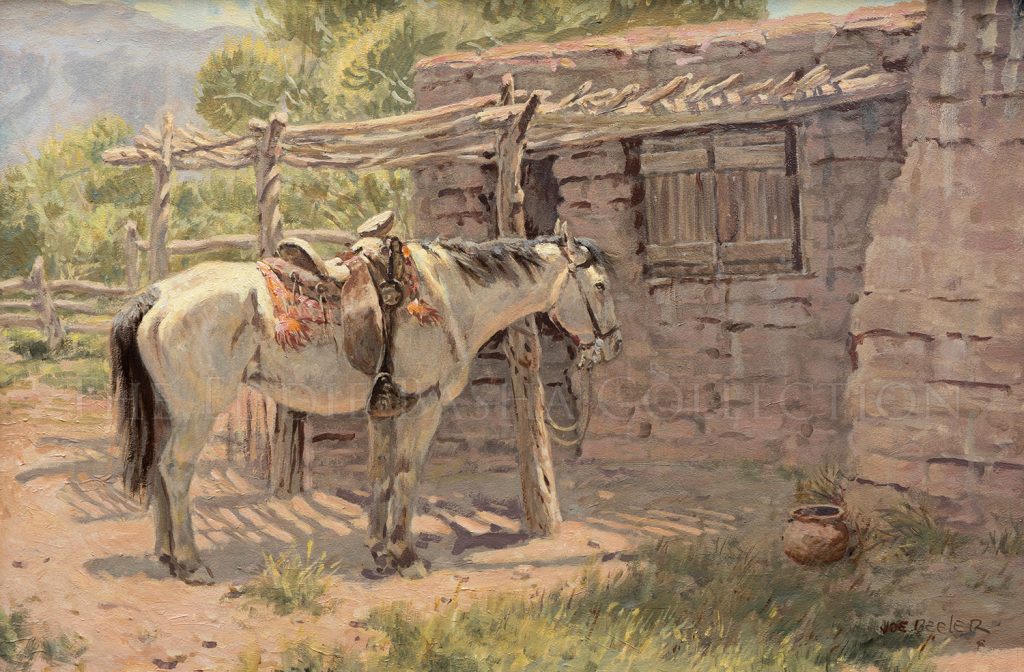 Oil | Image Size: 16”h x 24”w; Framed Size: 23 1/8”h x 30 7/8”w
Oil | Image Size: 16”h x 24”w; Framed Size: 23 1/8”h x 30 7/8”wThis idyllic scene of a saddled horse tethered to a post outside of a brick adobe house establishes a sense of place. Joe Beeler lights his white horse with bright sunshine and shades the house in subtle shadow. He adds bits of green grass in the right foreground and green trees in the left background to give a touch of color and to frame the horse and house. In the distant background, blue-gray cliffs under just a hint of a blue sky were added. The horse contentedly awaits the return of his rider.
This lovely oil was also returned to the gallery in June after having been on loan to the Arizona State Capitol Speaker’s Office (2019-2022).
Unknown Title
Artist: Joe Beeler, CA Founding Member (1931-2006)
This idyllic scene of a saddled horse tethered to a post outside of a brick adobe house establishes a sense of place. Joe Beeler lights his white horse with bright sunshine and shades the house in subtle shadow. He adds bits of green grass in the right foreground and green trees in the left background to give a touch of color and to frame the horse and house. In the distant background, blue-gray cliffs under just a hint of a blue sky were added. The horse contentedly awaits the return of his rider.
This lovely oil was also returned to the gallery in June after having been on loan to the Arizona State Capitol Speaker’s Office (2019-2022).
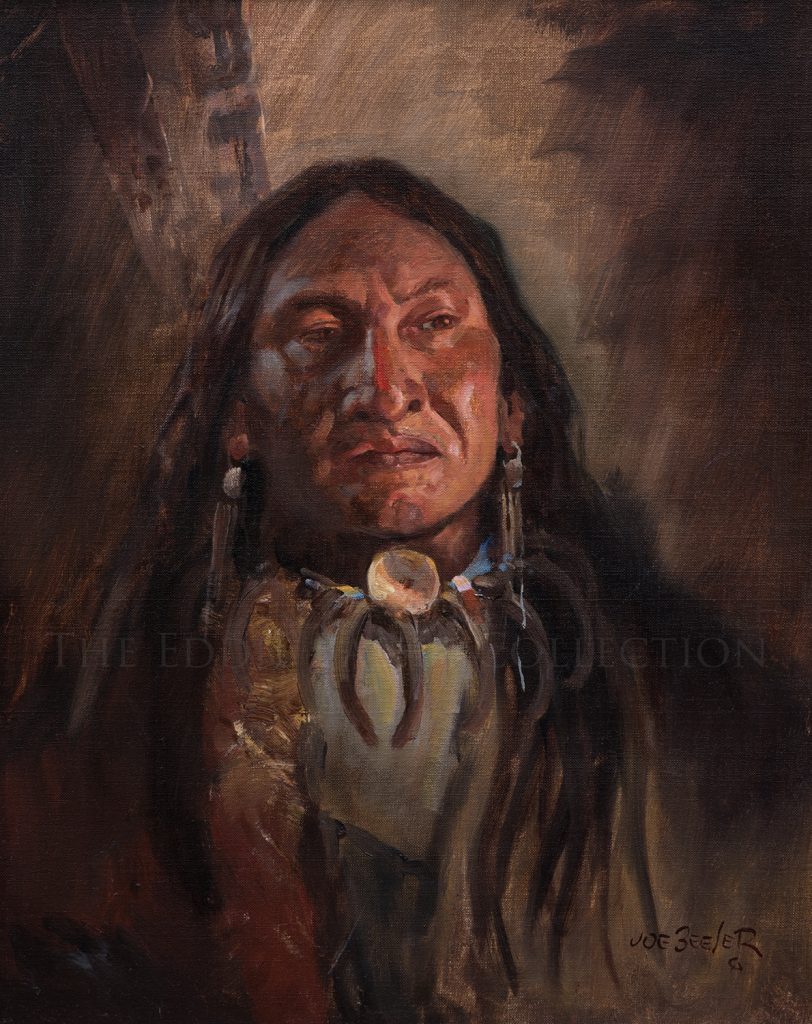 Oil | Image Size: 20”h x 16”w; Framed Size: 27 ¾”h x 23 ½”w
Oil | Image Size: 20”h x 16”w; Framed Size: 27 ¾”h x 23 ½”wMuch of this well-executed painting is done in subdued lighting, except for the facial features which are bathed in the soft glow of an unseen campfire. The subject’s face is framed by his long black hair which is adorned with braided leather and beaded straps. He wears both an animal claw and shell neckpiece medallion around his neck. With a contemplative expression, Beeler endows his face with a sense of wisdom and experience.
An image of this original oil painting appears in the book entitled “Joe Beeler: Life of a Cowboy Artist.” It has been loaned twice; first to Western Spirit: Scottsdale Museum of the West for the Joe Beeler retrospective in (Jan-Oct 2018) and more recently it was displayed at the Arizona State Capitol in the Speaker of the House Conference Area (May 2019-June 2022).
By the Council Fire
Artist: Joe Beeler, CA Founding Member (1931-2006)
Much of this well-executed painting is done in subdued lighting, except for the facial features which are bathed in the soft glow of an unseen campfire. The subject’s face is framed by his long black hair which is adorned with braided leather and beaded straps. He wears both an animal claw and shell neckpiece medallion around his neck. With a contemplative expression, Beeler endows his face with a sense of wisdom and experience.
An image of this original oil painting appears in the book entitled “Joe Beeler: Life of a Cowboy Artist.” It has been loaned twice; first to Western Spirit: Scottsdale Museum of the West for the Joe Beeler retrospective in (Jan-Oct 2018) and more recently it was displayed at the Arizona State Capitol in the Speaker of the House Conference Area (May 2019-June 2022).
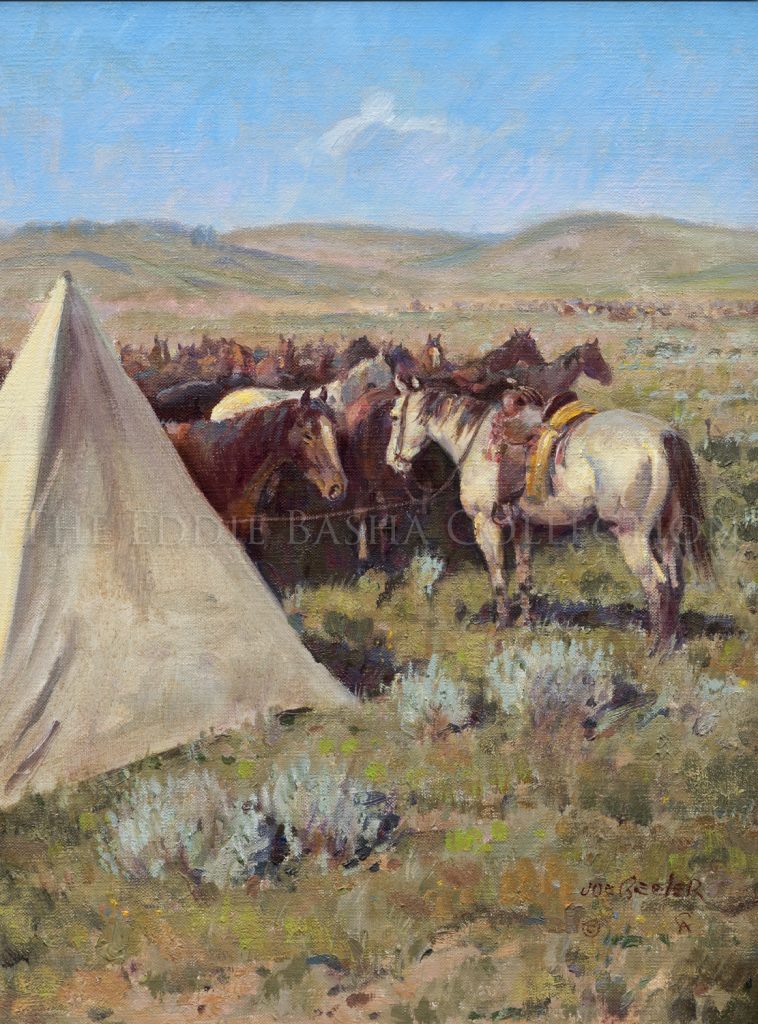 Oil | Image Size: 16”h x 12”w; Framed Size: 24 5/8”h x 20 5/8”w
Oil | Image Size: 16”h x 12”w; Framed Size: 24 5/8”h x 20 5/8”wA brief respite in a busy day was always a welcome relief to a cowhand. Here, Beeler presents another quiet moment of ranching life in this small oil painting of horses resting beside a cowboy’s tent. The white horse in the center of the painting and the white canvas of the tent offer a sharp contrast to the surrounding pasture. A vivid blue sky provides the context for the scene.
Noon Break
Artist: Joe Beeler, CA Founding Member (1931-2006)
A brief respite in a busy day was always a welcome relief to a cowhand. Here, Beeler presents another quiet moment of ranching life in this small oil painting of horses resting beside a cowboy’s tent. The white horse in the center of the painting and the white canvas of the tent offer a sharp contrast to the surrounding pasture. A vivid blue sky provides the context for the scene.
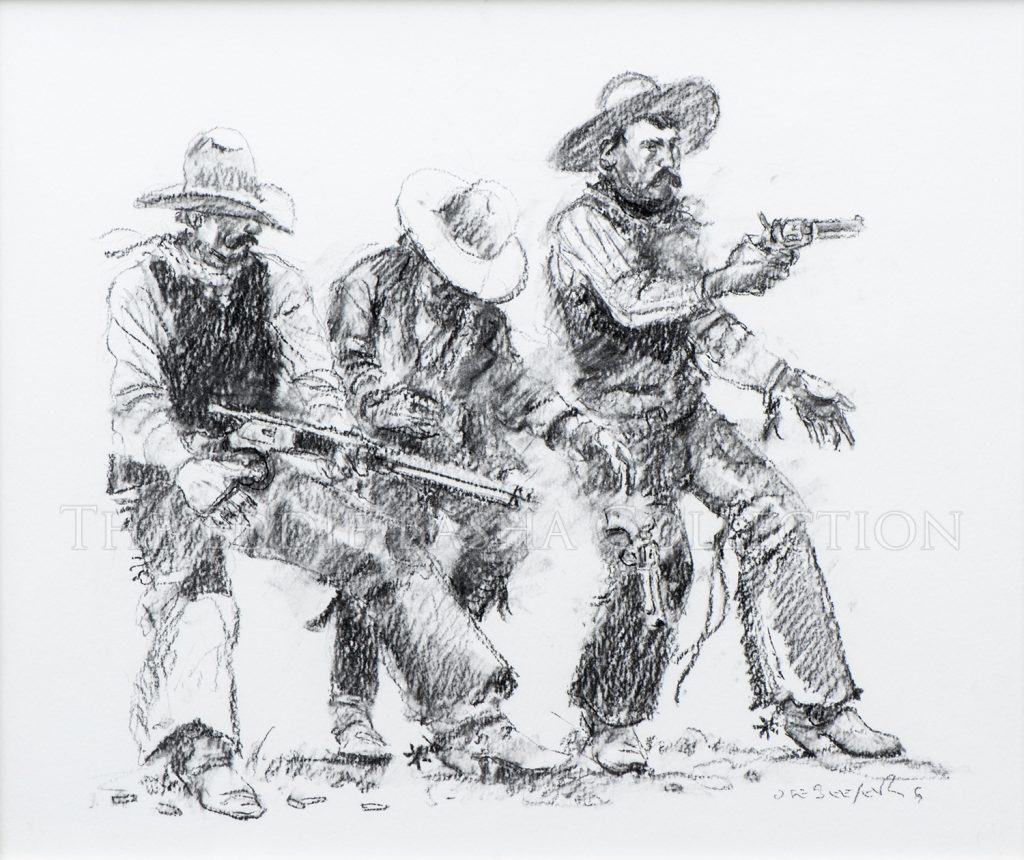 Charcoal | Image Size: 18”h x 22”w; Framed Size: 28”h x 30 ¾”w
Charcoal | Image Size: 18”h x 22”w; Framed Size: 28”h x 30 ¾”wCowboy Artist of America Founding Member, Joe Beeler, portrayed modern cowboys, but he also had a great interest and frequently depicted scenes from the historic West. In this charcoal drawing, Beeler concentrates solely on three cowboys engaged in a shootout without any image background. We see only one vantage point of the conflict, the three cowboys firing their weapons; the center cowboy appears to have been wounded, while the other two continue to fire. The cowboys are realistically portrayed, and Beeler handled the action splendidly. Titling the image as he did is the viewer’s only point of reference.
Dispute at the Water Hole
Artist: Joe Beeler, CA Founding Member (1931-2006)
Cowboy Artist of America Founding Member, Joe Beeler, portrayed modern cowboys, but he also had a great interest and frequently depicted scenes from the historic West. In this charcoal drawing, Beeler concentrates solely on three cowboys engaged in a shootout without any image background. We see only one vantage point of the conflict, the three cowboys firing their weapons; the center cowboy appears to have been wounded, while the other two continue to fire. The cowboys are realistically portrayed, and Beeler handled the action splendidly. Titling the image as he did is the viewer’s only point of reference.
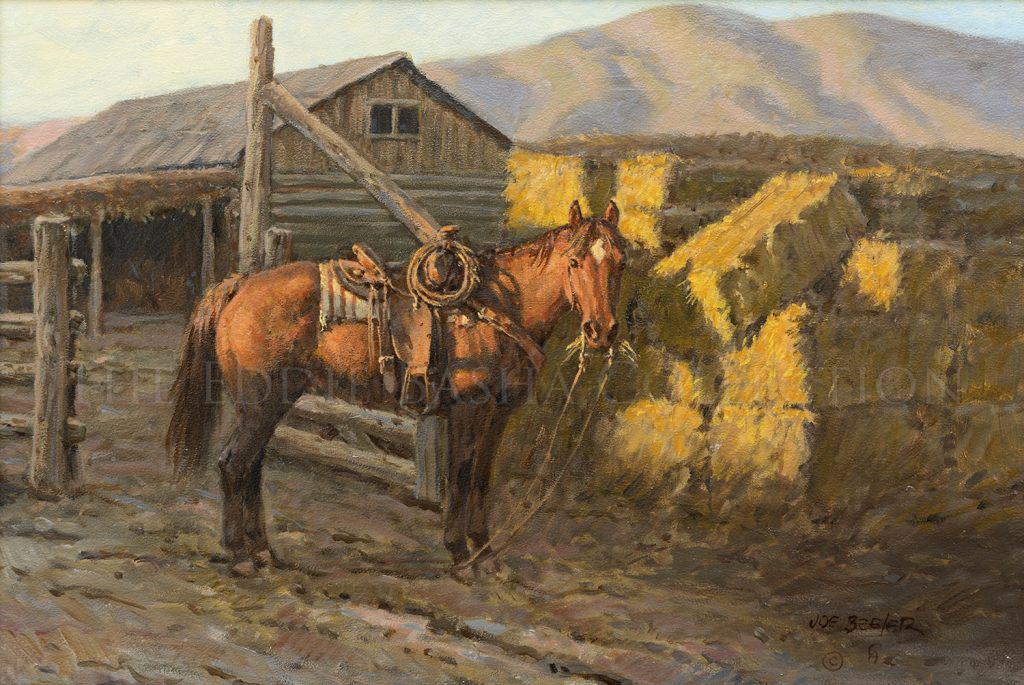 Oil (1973) | Image Size: 18”h x 24”w; Framed Size: 24 ½”h x 31 ½”w
Oil (1973) | Image Size: 18”h x 24”w; Framed Size: 24 ½”h x 31 ½”wCowboy Artists of America Founding Member, Joe Beeler, literally used sunlight to put a spotlight on his subject. In this case, the subject is a horse and not a cowboy. And even though an equine is the central figure, its personality shines through to the viewer. Undoubtedly, Beeler caught this guy in action at home more than once.
“Caught in the Act” has been exhibited at the Gilcrease Museum (1980), the Desert Caballeros Museum (1990) and at Western Spirit: Scottsdale Museum of the West (2018). In addition, an image of the piece appears in two of Beeler’s books; “Cowboy Artist: The Joe Beeler Story” (1979) and “Joe Beeler: Life of a Cowboy Artist” (2004).
Caught in the Act
Artist: Joe Beeler, CA Founding Member (1931-2006)
Cowboy Artists of America Founding Member, Joe Beeler, literally used sunlight to put a spotlight on his subject. In this case, the subject is a horse and not a cowboy. And even though an equine is the central figure, its personality shines through to the viewer. Undoubtedly, Beeler caught this guy in action at home more than once.
“Caught in the Act” has been exhibited at the Gilcrease Museum (1980), the Desert Caballeros Museum (1990) and at Western Spirit: Scottsdale Museum of the West (2018). In addition, an image of the piece appears in two of Beeler’s books; “Cowboy Artist: The Joe Beeler Story” (1979) and “Joe Beeler: Life of a Cowboy Artist” (2004).
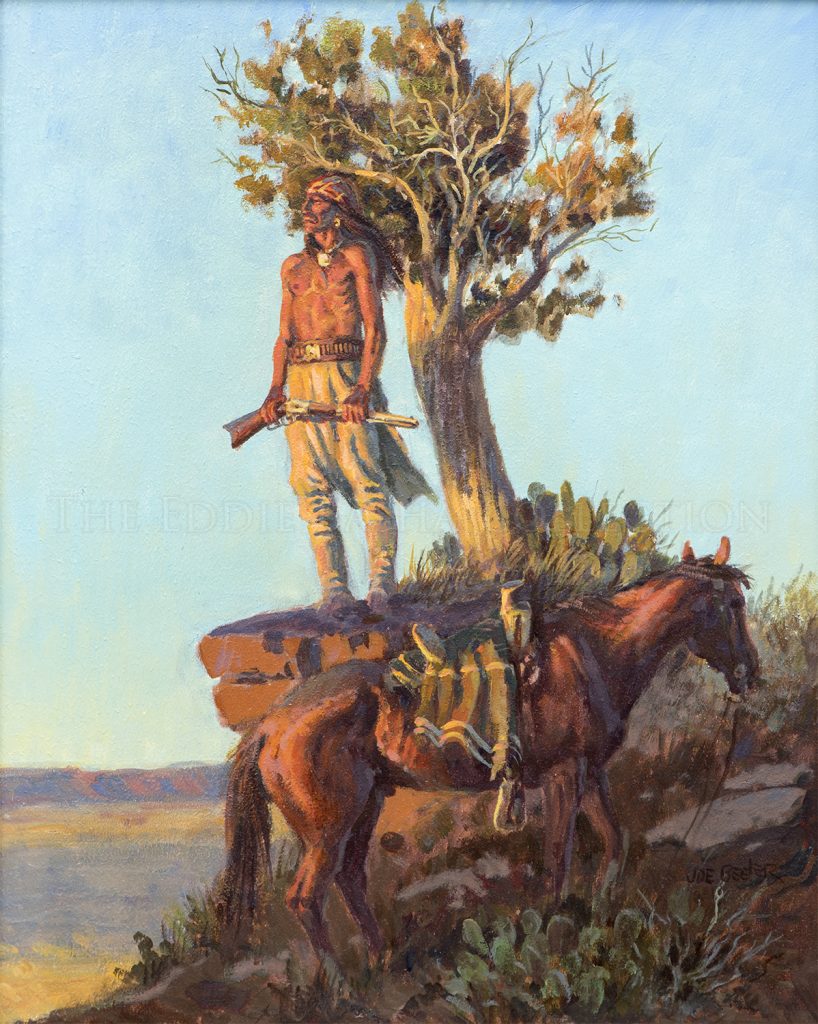 Oil | Dimensions: Image Size: 20”h x 16”w; Framed Size: 29”h x 25”w
Oil | Dimensions: Image Size: 20”h x 16”w; Framed Size: 29”h x 25”wLighting plays a key role in Cowboy Artists of America founding member Joe Beeler’s painting of an Apache sentinel standing on a rocky outcrop facing the setting sun. The reddish glow of the sunlight washes over him and his surroundings yet doesn’t obscure the cloudless blue sky. He stands, watching in the distance to discern the arrival of any unwelcome visitors and has his rifle at the ready. Both he and a gnarled tree behind him are silhouetted against the sky by the raking light. Though the composition might be a simpler one, it’s astonishing to ponder the number of times this scenario has occurred.
Sentinel
Artist: Joe Beeler, CA Founding Member (1931-2006)
Lighting plays a key role in Cowboy Artists of America founding member Joe Beeler’s painting of an Apache sentinel standing on a rocky outcrop facing the setting sun. The reddish glow of the sunlight washes over him and his surroundings yet doesn’t obscure the cloudless blue sky. He stands, watching in the distance to discern the arrival of any unwelcome visitors and has his rifle at the ready. Both he and a gnarled tree behind him are silhouetted against the sky by the raking light. Though the composition might be a simpler one, it’s astonishing to ponder the number of times this scenario has occurred.
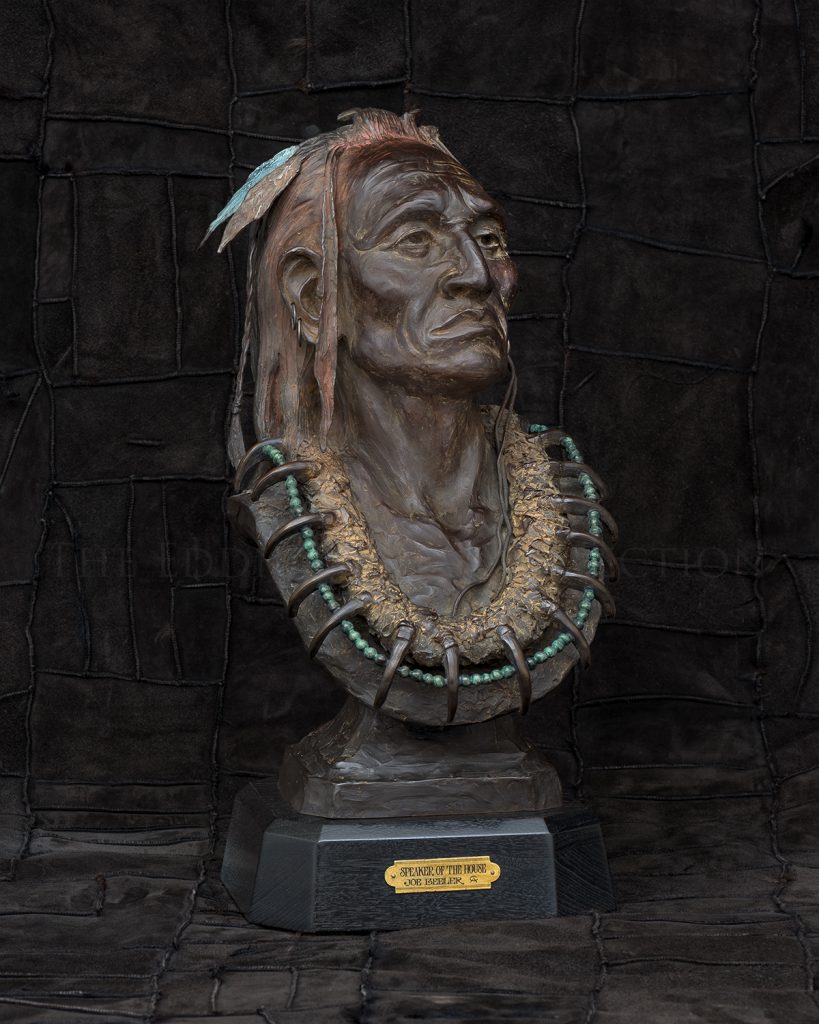 Bronze (1993) | Dimensions: 17”h x 11”w x 9’d; Edition #1 of 40
Bronze (1993) | Dimensions: 17”h x 11”w x 9’d; Edition #1 of 40In 1993 at the 28th Annual Cowboy Artists of America Exhibition & Sale held at the Phoenix Art Museum when it made its debut, “Speaker of the House” by Joe Beeler won not only the Gold Medal in Sculpture but also won the Best of Show Kieckhefer Award. Proudly the EBC displays Edition #1 of 40. An image of this piece is also featured in the book entitled “Joe Beeler: Life of a Cowboy Artist” authored by Don Hedgpeth and published by Diamond Tail Press in 2004.
Speaker of the House
Artist: Joe Beeler, CA Founding Member (1931-2006)
In 1993 at the 28th Annual Cowboy Artists of America Exhibition & Sale held at the Phoenix Art Museum when it made its debut, “Speaker of the House” by Joe Beeler won not only the Gold Medal in Sculpture but also won the Best of Show Kieckhefer Award. Proudly the EBC displays Edition #1 of 40. An image of this piece is also featured in the book entitled “Joe Beeler: Life of a Cowboy Artist” authored by Don Hedgpeth and published by Diamond Tail Press in 2004.
 Pastel | Image Size: 22”h x 16”w; Framed Size: 31 ½”h x 25 ½”w
Pastel | Image Size: 22”h x 16”w; Framed Size: 31 ½”h x 25 ½”wFounding member of the Cowboy Artists of America, Joe Beeler, was a prolific artist and disciplined in a variety of mediums such as the pastel shown here. In this medium-sized portrait of an American Indian wearing a bright red scarf and a top hat adorned with a star, perhaps a frontier marshal’s or sheriff’s badge, Beeler accurately depicts the era when warriors adopted the dress of newcomers to their territory. Many of these types of pieces were acquired by trade or by the spoils of a raid.
Unknown Title
Artist: Joe Beeler, CA Founding Member (1931-2006)
Founding member of the Cowboy Artists of America, Joe Beeler, was a prolific artist and disciplined in a variety of mediums such as the pastel shown here. In this medium-sized portrait of an American Indian wearing a bright red scarf and a top hat adorned with a star, perhaps a frontier marshal’s or sheriff’s badge, Beeler accurately depicts the era when warriors adopted the dress of newcomers to their territory. Many of these types of pieces were acquired by trade or by the spoils of a raid.
 Medium (Year) | Image Size: 24”h x 40”w; Framed Size: 35”h x 50”w
Medium (Year) | Image Size: 24”h x 40”w; Framed Size: 35”h x 50”w During the period of the early trail driving days, there was much violence and bloodshed. Herds were attacked, cattle driven off and cowboys and Indians wounded and killed. If the warriors felt they were not well-enough armed to attack during the day, attacks were made at night to cause stampedes which inflicted great losses on the cow men.
This painting portrays a group of Kiowa and Comanche holding up a trail herd. They are cutting out a small bunch of steers as payment for the herd crossing their hunting ground. Here the old chief is seen breaking an arrow as a promise to the trail boss that they are “brothers” and that his children will cause them no trouble. The looks on the faces of all the characters involved show their concern and doubt.
The painting is rich in authentic details of the period and the imagery effectively complements the narrative provided by Joe Beeler, Founding Member of the Cowboy Artists of America. It has been exhibited three times. The first at the Gilcrease Museum in Tulsa OK for the “Joe Beeler at Gilcrease” exhibition, May 2-July 6, 1980. The second at the Scottsdale Center for the Arts “Romance of the Range-The Horse in Western Art” exhibition, October 27-December 8, 1991. And more recently at Western Spirit: Scottsdale Museum of the West “The Art of Joe Beeler: A Western Original” retrospective, January 16-October 28, 2018.
A Doubtful Promise
Artist: Joe Beeler, CA Founding Member (1931-2006)
During the period of the early trail driving days, there was much violence and bloodshed. Herds were attacked, cattle driven off and cowboys and Indians wounded and killed. If the warriors felt they were not well-enough armed to attack during the day, attacks were made at night to cause stampedes which inflicted great losses on the cow men.
This painting portrays a group of Kiowa and Comanche holding up a trail herd. They are cutting out a small bunch of steers as payment for the herd crossing their hunting ground. Here the old chief is seen breaking an arrow as a promise to the trail boss that they are “brothers” and that his children will cause them no trouble. The looks on the faces of all the characters involved show their concern and doubt.
The painting is rich in authentic details of the period and the imagery effectively complements the narrative provided by Joe Beeler, Founding Member of the Cowboy Artists of America. It has been exhibited three times. The first at the Gilcrease Museum in Tulsa OK for the “Joe Beeler at Gilcrease” exhibition, May 2-July 6, 1980. The second at the Scottsdale Center for the Arts “Romance of the Range-The Horse in Western Art” exhibition, October 27-December 8, 1991. And more recently at Western Spirit: Scottsdale Museum of the West “The Art of Joe Beeler: A Western Original” retrospective, January 16-October 28, 2018.
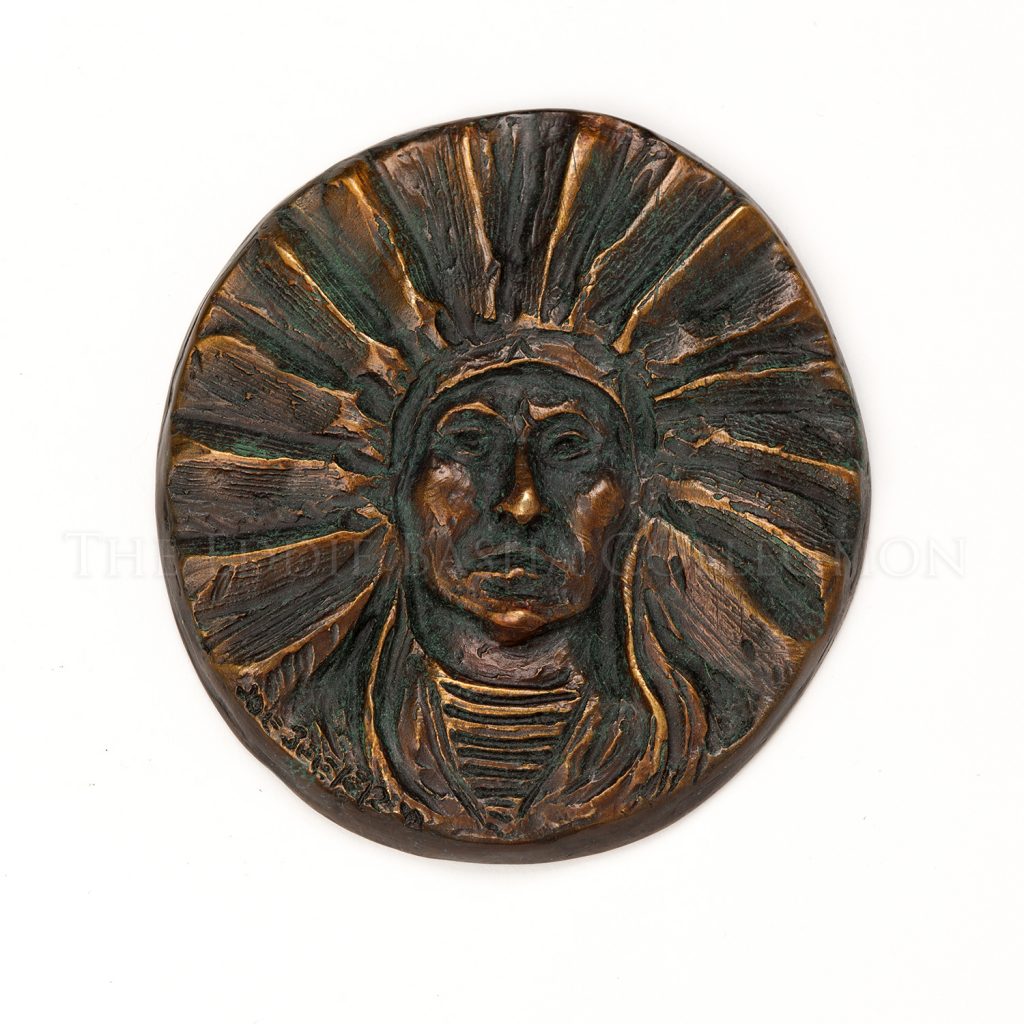 Bronze (1997) | Dimensions: 3 ½” Diameter
Bronze (1997) | Dimensions: 3 ½” DiameterThis Plains Indian medallion was created and gifted in 1997. We thought it fitting to highlight some information pertaining to the Plains Indians as shared by Wikipedia as follows:
“Plains Indians or Indigenous peoples of the Great Plains and Canadian Prairies are the Indian tribes and First Nation band governments who have historically lived on the plains and prairies of the North American continent. While these hunting-farming cultures lived on the Great Plains for centuries prior to European contact, the 17th century through the late 19th century horse cultures are more widely discussed in literature and art.
The Plains Indian tribes are usually divided into two broad classifications which overlap to some degree. The first group became a fully nomadic horse culture during the 18th and 19the centuries, following the vast herds of buffalo, although some tribes occasionally engaged in agriculture. These include the Arapaho, Assiniboine, Blackfoot, Cheyenne, Comanche, Crow, Gros Ventre, Kiowa, Lakota, Lipan, Plains Apache (or Kiowa Apache), Plains Cree, Plains Ojibwe, Sarsi, Nakoda (Stoney), and Tonkawa. The second group were sedentary and semi-sedentary, and, in addition to hunting buffalo, they lived in villages, raised crops, and actively traded with other tribes. These include the Arikara, Hidatsa, Iowa, Kaw (or Kansa), Kitsai, Mandan, Missouria, Omaha, Osage, Otoe, Pawnee, Ponca, Quapaw, Wichita, and the Santee Dakota, Yanktonai and Yankton Dakota.”
Additional brief summaries related to Plains Indian history, horses, bison, wars, agriculture/plants foods, hunting, clothing, religion, and gender roles may be found at https://en.wikipedia.org/wiki/Plains_Indians . And, more in depth information may be found at any public library; enjoy the research.
Plains Indian Medallion
Artist: Joe Beeler, CA Founding Member (1931-2006)
This Plains Indian medallion was created and gifted in 1997. We thought it fitting to highlight some information pertaining to the Plains Indians as shared by Wikipedia as follows:
“Plains Indians or Indigenous peoples of the Great Plains and Canadian Prairies are the Indian tribes and First Nation band governments who have historically lived on the plains and prairies of the North American continent. While these hunting-farming cultures lived on the Great Plains for centuries prior to European contact, the 17th century through the late 19th century horse cultures are more widely discussed in literature and art.
The Plains Indian tribes are usually divided into two broad classifications which overlap to some degree. The first group became a fully nomadic horse culture during the 18th and 19the centuries, following the vast herds of buffalo, although some tribes occasionally engaged in agriculture. These include the Arapaho, Assiniboine, Blackfoot, Cheyenne, Comanche, Crow, Gros Ventre, Kiowa, Lakota, Lipan, Plains Apache (or Kiowa Apache), Plains Cree, Plains Ojibwe, Sarsi, Nakoda (Stoney), and Tonkawa. The second group were sedentary and semi-sedentary, and, in addition to hunting buffalo, they lived in villages, raised crops, and actively traded with other tribes. These include the Arikara, Hidatsa, Iowa, Kaw (or Kansa), Kitsai, Mandan, Missouria, Omaha, Osage, Otoe, Pawnee, Ponca, Quapaw, Wichita, and the Santee Dakota, Yanktonai and Yankton Dakota.”
Additional brief summaries related to Plains Indian history, horses, bison, wars, agriculture/plants foods, hunting, clothing, religion, and gender roles may be found at https://en.wikipedia.org/wiki/Plains_Indians . And, more in depth information may be found at any public library; enjoy the research.
 Oil | Image Size: 20”h x 30”w; Framed Size: 26”h x 38”w
Oil | Image Size: 20”h x 30”w; Framed Size: 26”h x 38”wJoe Beeler, founding member of the Cowboy Artists of America, was incredibly proficient at creating believable western personas … cowboys, Indians, hardened outlaws, trappers, and on occasion a female or two. However, he was equally talented at creating them for animals such as these two horses, seemingly old friends who have traveled many miles together, shown standing beside a corral and out building. And just as mountains rise behind them and the sun glances off of their well-worn coats, the familiarity of the pair leaps off the canvas.
Working Pardners
Artist: Joe Beeler, CA Founding Member (1931-2006)
Joe Beeler, founding member of the Cowboy Artists of America, was incredibly proficient at creating believable western personas … cowboys, Indians, hardened outlaws, trappers, and on occasion a female or two. However, he was equally talented at creating them for animals such as these two horses, seemingly old friends who have traveled many miles together, shown standing beside a corral and out building. And just as mountains rise behind them and the sun glances off of their well-worn coats, the familiarity of the pair leaps off the canvas.
 Bronze | Dimensions: 20”h x 10”w x 11”d; Edition #1 of 30
Bronze | Dimensions: 20”h x 10”w x 11”d; Edition #1 of 30“The Trapper” or “Into the North Wind” is a well done and realistic sculptural bronze portrayal of a trapper with his rifle slung over his shoulder, walking with the aid of a staff and smoking a pipe. His mittens attest to the fact that he is traveling in cold weather. Beeler has very effectively given the figure a sense of motion by pitching him forward simulating a walking gait.
The Trapper or Into the North Wind
Artist: Joe Beeler, CA Founding Member (1931-2006)
“The Trapper” or “Into the North Wind” is a well done and realistic sculptural bronze portrayal of a trapper with his rifle slung over his shoulder, walking with the aid of a staff and smoking a pipe. His mittens attest to the fact that he is traveling in cold weather. Beeler has very effectively given the figure a sense of motion by pitching him forward simulating a walking gait.
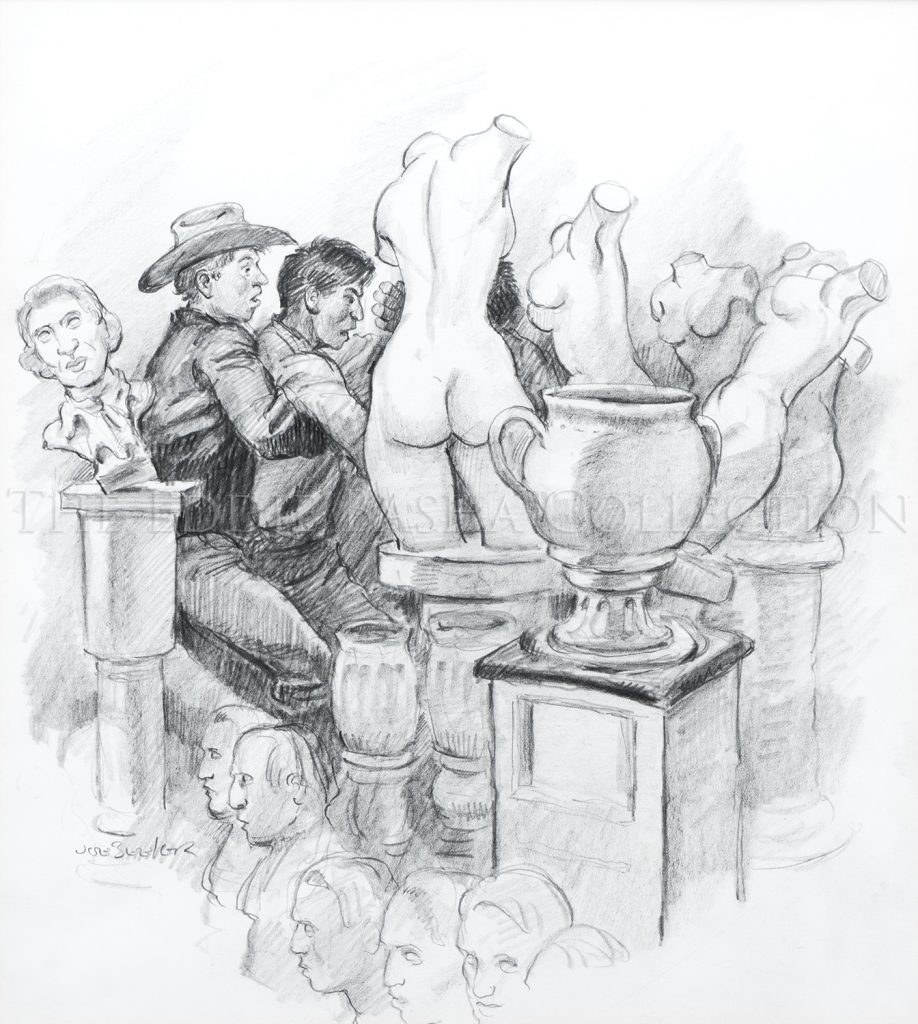 Pencil | Image Size: 14”h x 12”w; Framed Size: 20 ¼”h x 19”w
Pencil | Image Size: 14”h x 12”w; Framed Size: 20 ¼”h x 19”wIn the book “Cowboy Artist: The Joe Beeler Story,” authored by Don Hedgpeth, published by Northland Press in 1979, the following explanation of this piece is provided: “But Joe’s career never did resemble that of an artist trying to make a name for himself in the traditional pattern. There was the incident of the “plaster statue massacre”. A dealer in Tulsa called and asked Joe to bring in some things for him to show a client. Joe loaded up some paintings and headed for Tulsa. When he got to the dealer’s shop, which specialized in plaster lawn statues, the client had not yet arrived. Joe said he would come back later, and went out to spend some time at the Gilcrease Museum.
At the Gilcrease, the Director, Jim Forrest, introduced Joe to W.B. Davis. Mr. Davis wanted to see Joe’s work and in short order purchased the painting “The Fugitive” which he presented to Forrest for the museum. Joe was delighted; he stopped to tell his Quapaw-Cherokee friend Louie Ballard about his good fortune, and together they went back to see the man at the plaster statue store.
The Tulsa dealer was mad as a hornet. It seems Mr. Davis was the client he wanted to show Joe’s work to. He felt Joe had gypped him out of a sales commission. The discussion became heated and the words began to fly fast and furious. Louie, Joe’s friend, made a comment or two to which the dealer replied, and as quick as that both men were rolling on the floor knocking over plaster statues right and left.
Joe pulled the dealer off Louie and fell backwards with him, knocking over plaster statues like a string of dominoes. This was all taking place in a big store window on a main Tulsa street. A crowd had gathered and police sirens could be heard off in the distance. Joe got up with a boot full of blood; his leg had been pierced by some wire on one of the statues. He and Louie left in a hurry, leaving the dealer among the chunks and dust of what had been a shop full of plaster statues.
#storytellers #theyrethebest
Plaster Statue Massacre
Artist: Joe Beeler, CA Founding Member (1931-2006)
In the book “Cowboy Artist: The Joe Beeler Story,” authored by Don Hedgpeth, published by Northland Press in 1979, the following explanation of this piece is provided: “But Joe’s career never did resemble that of an artist trying to make a name for himself in the traditional pattern. There was the incident of the “plaster statue massacre”. A dealer in Tulsa called and asked Joe to bring in some things for him to show a client. Joe loaded up some paintings and headed for Tulsa. When he got to the dealer’s shop, which specialized in plaster lawn statues, the client had not yet arrived. Joe said he would come back later, and went out to spend some time at the Gilcrease Museum.
At the Gilcrease, the Director, Jim Forrest, introduced Joe to W.B. Davis. Mr. Davis wanted to see Joe’s work and in short order purchased the painting “The Fugitive” which he presented to Forrest for the museum. Joe was delighted; he stopped to tell his Quapaw-Cherokee friend Louie Ballard about his good fortune, and together they went back to see the man at the plaster statue store.
The Tulsa dealer was mad as a hornet. It seems Mr. Davis was the client he wanted to show Joe’s work to. He felt Joe had gypped him out of a sales commission. The discussion became heated and the words began to fly fast and furious. Louie, Joe’s friend, made a comment or two to which the dealer replied, and as quick as that both men were rolling on the floor knocking over plaster statues right and left.
Joe pulled the dealer off Louie and fell backwards with him, knocking over plaster statues like a string of dominoes. This was all taking place in a big store window on a main Tulsa street. A crowd had gathered and police sirens could be heard off in the distance. Joe got up with a boot full of blood; his leg had been pierced by some wire on one of the statues. He and Louie left in a hurry, leaving the dealer among the chunks and dust of what had been a shop full of plaster statues.
#storytellers #theyrethebest
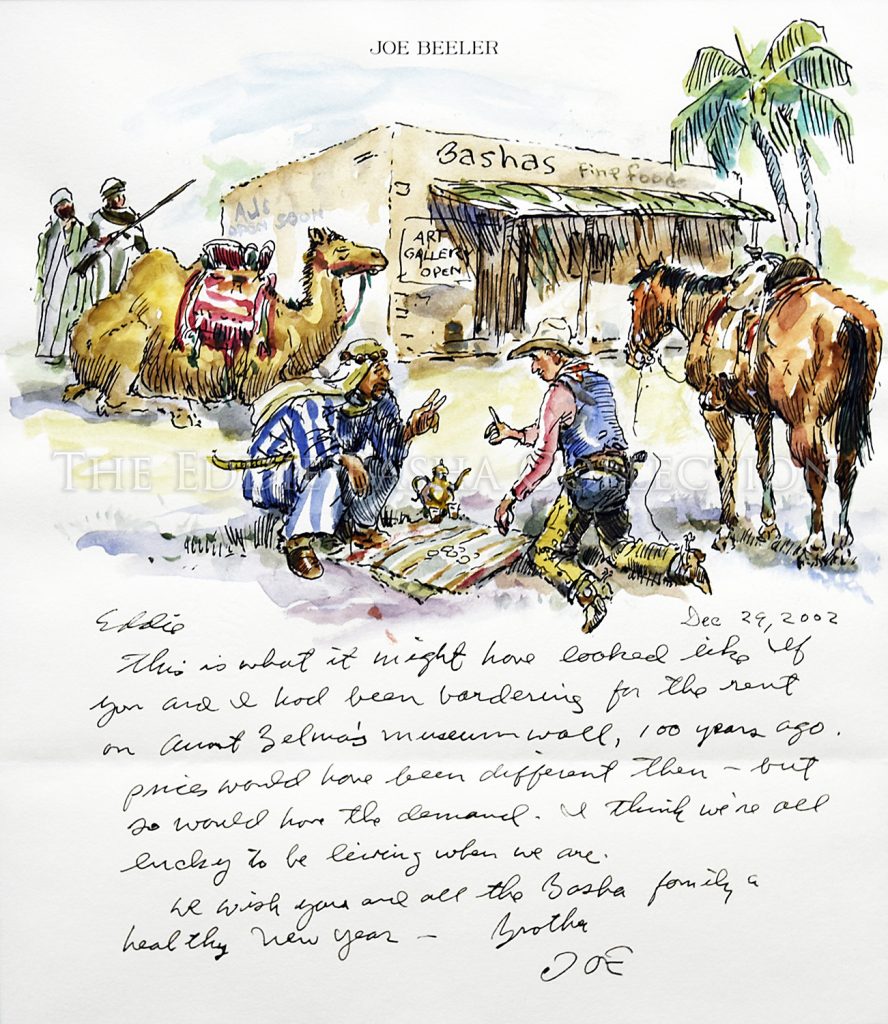 Watermarker & Pen (2002) | Image Size: 11”h x 8 ½”w; Framed Size: 18 ¾”h x 16 ¼”w
Watermarker & Pen (2002) | Image Size: 11”h x 8 ½”w; Framed Size: 18 ¾”h x 16 ¼”w#BeelerLetter #ArtistLetter #Humor #Banter #100YearsAgo #Bartering #GalleryWallSpace #RentalFee #Satire
Bartering for Gallery Wall Space 100 Years Ago
Artist: Joe Beeler, CA Founding Member (1931-2006)
#BeelerLetter #ArtistLetter #Humor #Banter #100YearsAgo #Bartering #GalleryWallSpace #RentalFee #Satire
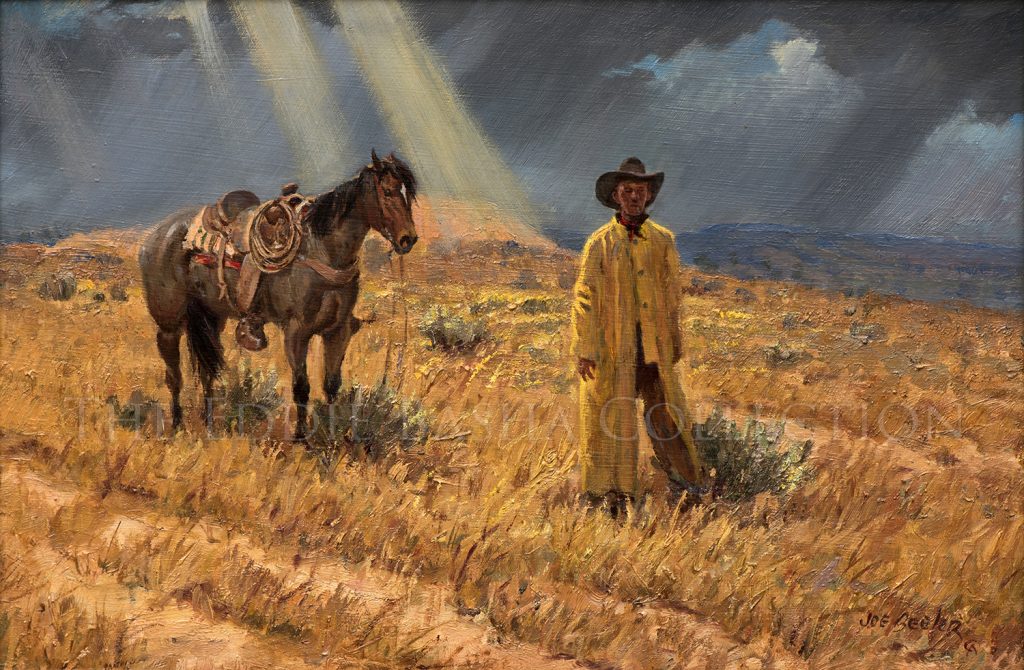 Oil | Image Size: 12”h x 18”w; Framed Size: 18 7/8”h x 24 3/4”w
Oil | Image Size: 12”h x 18”w; Framed Size: 18 7/8”h x 24 3/4”wJoe Beeler, a founding member of the Cowboy Artists of America, used contrasting bands of color and bright shafts of sunlight set against an ominous sky to set the stage for a lone cowboy to survey the storm that missed the dry, brittle land before him. Beeler used this and similar themes in various ways; one of the more famous was titled “Thanks for the Rain” which he painted and sculpted.
Unknown Title
Artist: Joe Beeler, CA Founding Member (1931-2006)
Joe Beeler, a founding member of the Cowboy Artists of America, used contrasting bands of color and bright shafts of sunlight set against an ominous sky to set the stage for a lone cowboy to survey the storm that missed the dry, brittle land before him. Beeler used this and similar themes in various ways; one of the more famous was titled “Thanks for the Rain” which he painted and sculpted.
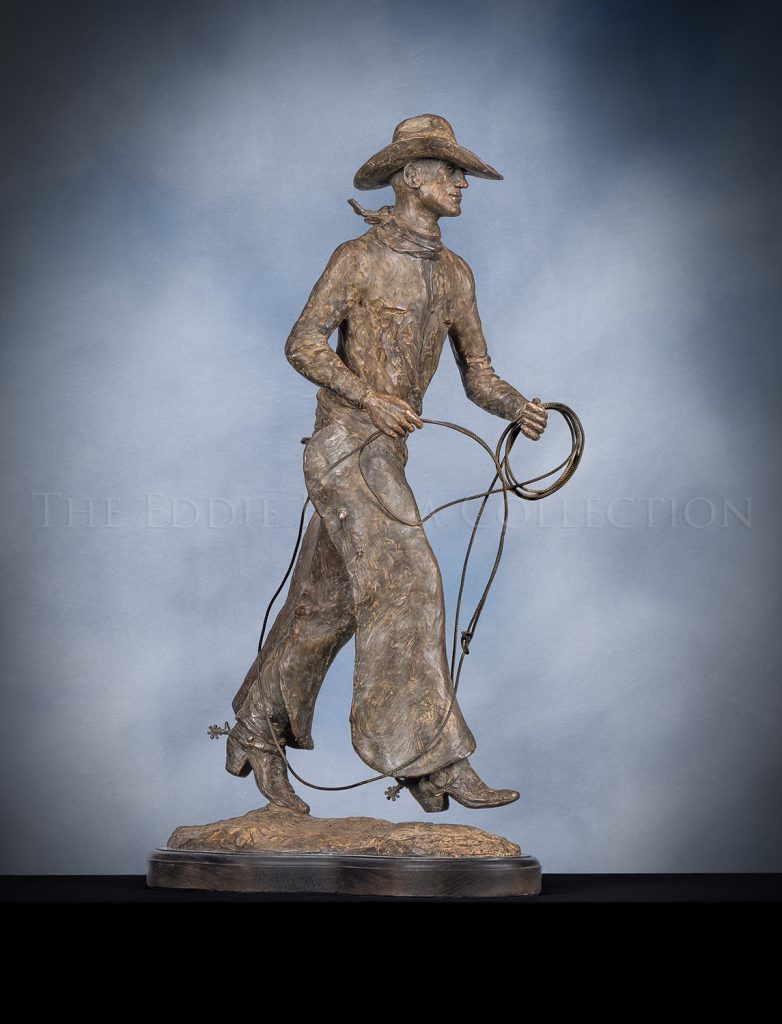 Bronze | Dimensions: 29”h x 16”w x 9”d; Edition #1 of 45
Bronze | Dimensions: 29”h x 16”w x 9”d; Edition #1 of 45This relatively large bronze shows a long, tall and lean cowboy walking forward, with lariat in hand, ready to begin his work on a “Monday Morning”. Wearing long chaps and with a spring in his step, Joe Beeler gave his subject a sense of movement by balancing the cowboy mid-stride on his back foot while the front is in the air.
Monday Morning
Artist: Joe Beeler, CA Founding Member (1931-2006)
This relatively large bronze shows a long, tall and lean cowboy walking forward, with lariat in hand, ready to begin his work on a “Monday Morning”. Wearing long chaps and with a spring in his step, Joe Beeler gave his subject a sense of movement by balancing the cowboy mid-stride on his back foot while the front is in the air.
 Oil | Image Size: 24”h x 40”w; Framed Size: 35”h x 51”w
Oil | Image Size: 24”h x 40”w; Framed Size: 35”h x 51”wCowboy Artists of America Founding Member Joe Beeler creates a very realistic desert landscape in this oil painting of three Apache trackers who have lost the trail. They have stopped in a dry river bed and have tethered their horses under the shade of a few scrub trees and towering Saguaro cacti. Two crouch in the shade in the right foreground, while one stands in the riverbed contemplating their next move. They are dressed in traditional clothing that is appropriate to the time period. Known for his ability to weave visual stories of the historic west and of his realistic handling of figures, here Beeler also shows his adept skills in showcasing the landscape in which he has perfectly captured the desert environment.
“The Lost Trail” was exhibited at Western Spirit Scottsdale’s Museum of the West exhibition entitled The Art of Joe Beeler: A Western Original Retrospective in 2018 and an image of the painting also appears in the book entitled Joe Beeler: Life of a Cowboy Artist authored by Don Hedgpeth and published by Diamond Tail Press in 2004.
The Lost Trail
Artist: Joe Beeler, CA Founding Member (1931-2006)
Cowboy Artists of America Founding Member Joe Beeler creates a very realistic desert landscape in this oil painting of three Apache trackers who have lost the trail. They have stopped in a dry river bed and have tethered their horses under the shade of a few scrub trees and towering Saguaro cacti. Two crouch in the shade in the right foreground, while one stands in the riverbed contemplating their next move. They are dressed in traditional clothing that is appropriate to the time period. Known for his ability to weave visual stories of the historic west and of his realistic handling of figures, here Beeler also shows his adept skills in showcasing the landscape in which he has perfectly captured the desert environment.
“The Lost Trail” was exhibited at Western Spirit Scottsdale’s Museum of the West exhibition entitled The Art of Joe Beeler: A Western Original Retrospective in 2018 and an image of the painting also appears in the book entitled Joe Beeler: Life of a Cowboy Artist authored by Don Hedgpeth and published by Diamond Tail Press in 2004.
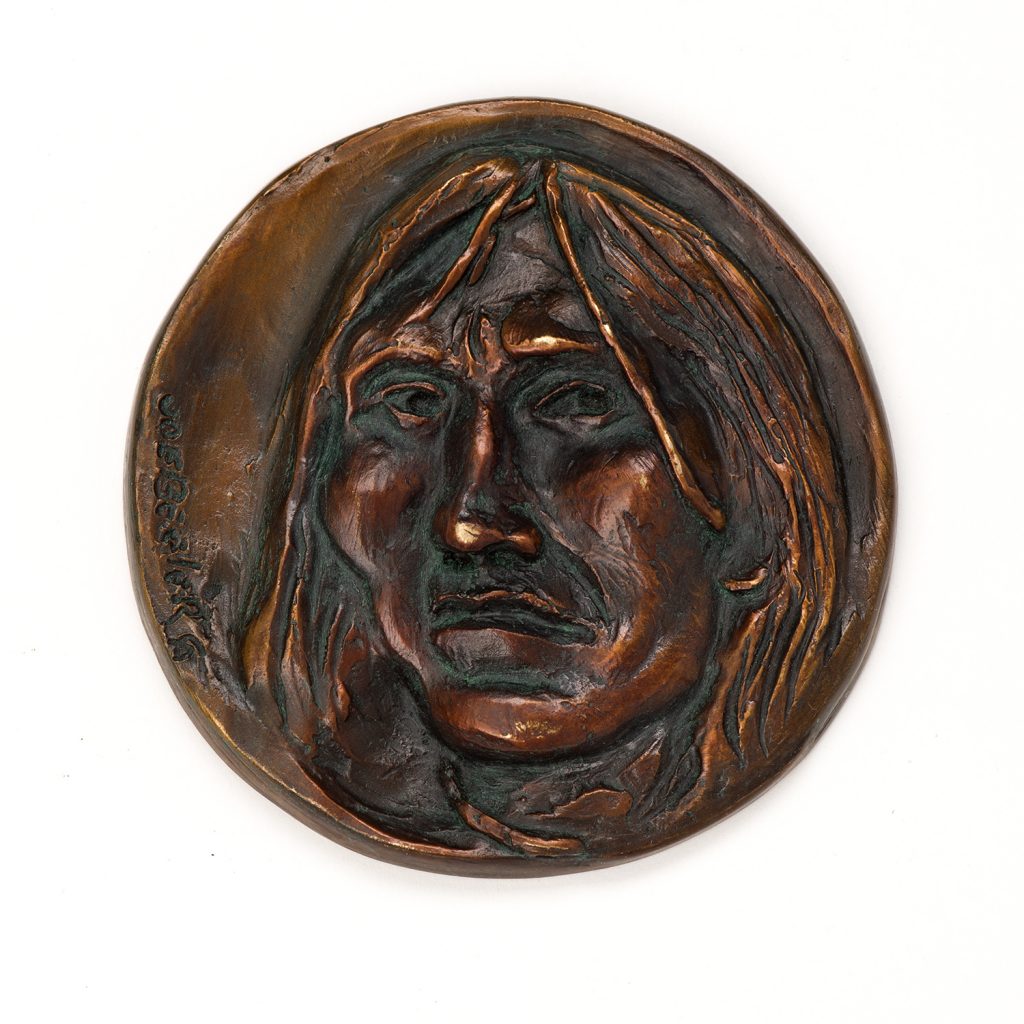 Bronze (1996) | Dimensions: 3 ½” Diameter
Bronze (1996) | Dimensions: 3 ½” DiameterThe year was 1996 when this medallion was sculpted by CAA Founding Member Joe Beeler, cast in bronze at the Bronzesmith Fine Art Foundry & Gallery in Prescott, Arizona, and subsequently gifted by Eddie Basha.
Yavapai
Artist: Joe Beeler, CA Founding Member (1931-2006)
The year was 1996 when this medallion was sculpted by CAA Founding Member Joe Beeler, cast in bronze at the Bronzesmith Fine Art Foundry & Gallery in Prescott, Arizona, and subsequently gifted by Eddie Basha.
 Bronze (2005) | Dimensions: 26”h x 12”w x 8”d; Edition #1 of 40
Bronze (2005) | Dimensions: 26”h x 12”w x 8”d; Edition #1 of 40With this relatively large, full length portrait sculpture, Joe Beeler has created the quintessential cowboy. The cowhand is lean and strong and carries the tools of his trade; a saddle, lariat, bridle and halter. The pose is characteristic of a seasoned hand and communicates an attitude of being ready for any circumstance. This man is no drugstore cowboy, but the real deal.
Ready to Ride
Artist: Joe Beeler, CA Founding Member (1931-2006)
With this relatively large, full length portrait sculpture, Joe Beeler has created the quintessential cowboy. The cowhand is lean and strong and carries the tools of his trade; a saddle, lariat, bridle and halter. The pose is characteristic of a seasoned hand and communicates an attitude of being ready for any circumstance. This man is no drugstore cowboy, but the real deal.
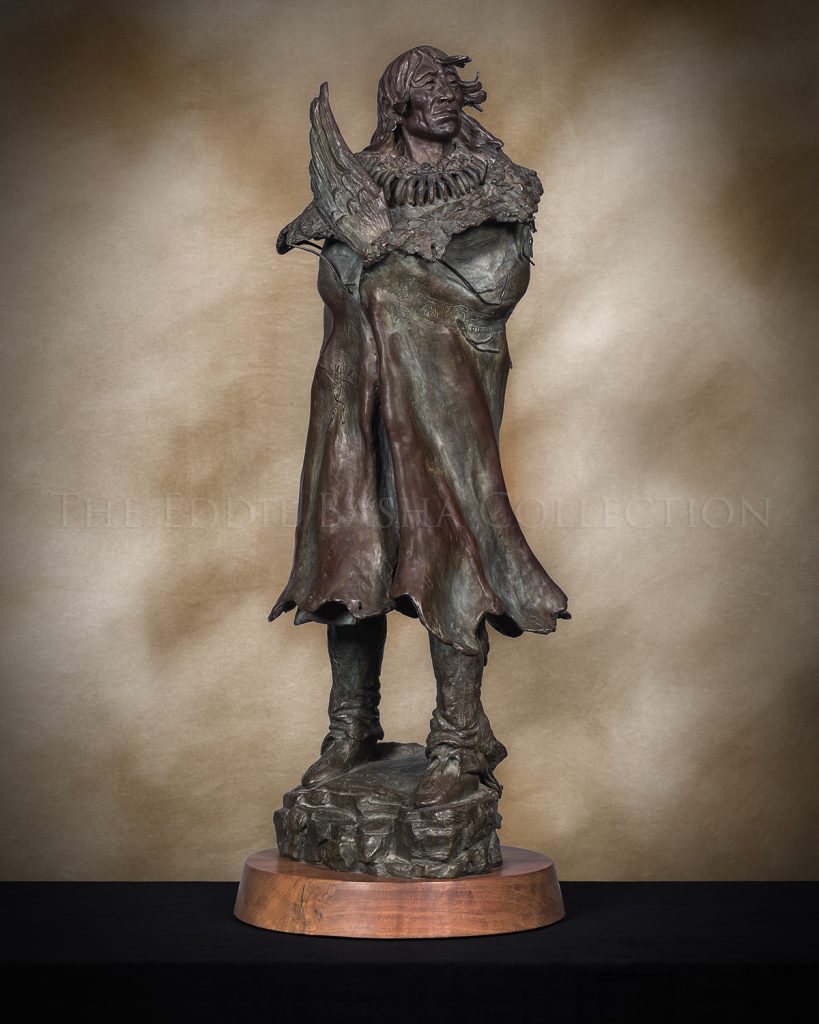 Bronze | Dimensions: 27”h x 11”w x 10”d; Edition #1 of 25
Bronze | Dimensions: 27”h x 11”w x 10”d; Edition #1 of 25Joe Beeler was a thorough reader and researcher in the subject of nineteenth century American Indian history and culture. He frequently used his knowledge of the subject to produce evocative and historically accurate portraits and sculptures of nineteenth century Indians from many different tribes. Here, he presents an elder from a Northern Plains tribe who is wrapped in a buffalo robe. He is holding an eagle wing fan and wears an impressive bear claw necklace—both items indicate his high stature within the tribe. The sculpture shows his full length figure and depicts the subject with respect and sensitivity. It is very well done and has an impressive presence about it.
The Elder
Artist: Joe Beeler, CA Founding Member (1931-2006)
Joe Beeler was a thorough reader and researcher in the subject of nineteenth century American Indian history and culture. He frequently used his knowledge of the subject to produce evocative and historically accurate portraits and sculptures of nineteenth century Indians from many different tribes. Here, he presents an elder from a Northern Plains tribe who is wrapped in a buffalo robe. He is holding an eagle wing fan and wears an impressive bear claw necklace—both items indicate his high stature within the tribe. The sculpture shows his full length figure and depicts the subject with respect and sensitivity. It is very well done and has an impressive presence about it.
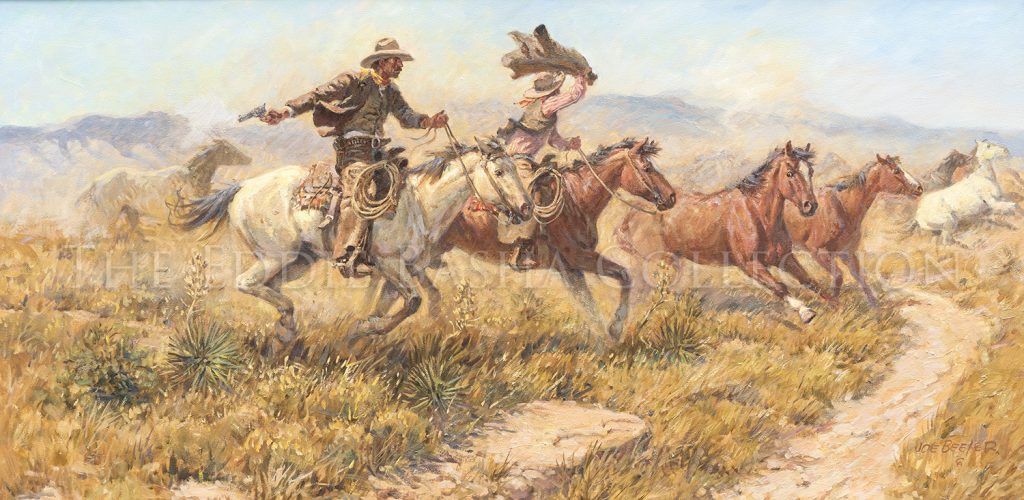 Oil (1974) | Image Size: 20”h x 40”w; Framed Size: 29 ¾”h x 43 ¾”w
Oil (1974) | Image Size: 20”h x 40”w; Framed Size: 29 ¾”h x 43 ¾”wWhile one cowboy fires his sidearm to spook the horses, the other wildly waves his jacket high over his head to keep the stolen horses moving rapidly. In this dangerous business, speed was of the essence. The men and horses truly seem to be racing across the landscape of muted and dusty tones. The story being presented is one of intense action and drama and Joe Beeler has put the viewer right in the middle of the adventure.
Horse Thieves was exhibited at The University of Texas at San Antonio Institute of Texan Cultures, a Smithsonian affiliate, in 1985. Now a part of the permanent collection of the EBC, a signed and numbered (15) exhibition book titled “Joe Beeler: In the Cradle of the Cattle Kingdom” remains a part of our gallery library.
Horse Thieves
Artist: Joe Beeler, CA Founding Member (1931-2006)
While one cowboy fires his sidearm to spook the horses, the other wildly waves his jacket high over his head to keep the stolen horses moving rapidly. In this dangerous business, speed was of the essence. The men and horses truly seem to be racing across the landscape of muted and dusty tones. The story being presented is one of intense action and drama and Joe Beeler has put the viewer right in the middle of the adventure.
Horse Thieves was exhibited at The University of Texas at San Antonio Institute of Texan Cultures, a Smithsonian affiliate, in 1985. Now a part of the permanent collection of the EBC, a signed and numbered (15) exhibition book titled “Joe Beeler: In the Cradle of the Cattle Kingdom” remains a part of our gallery library.
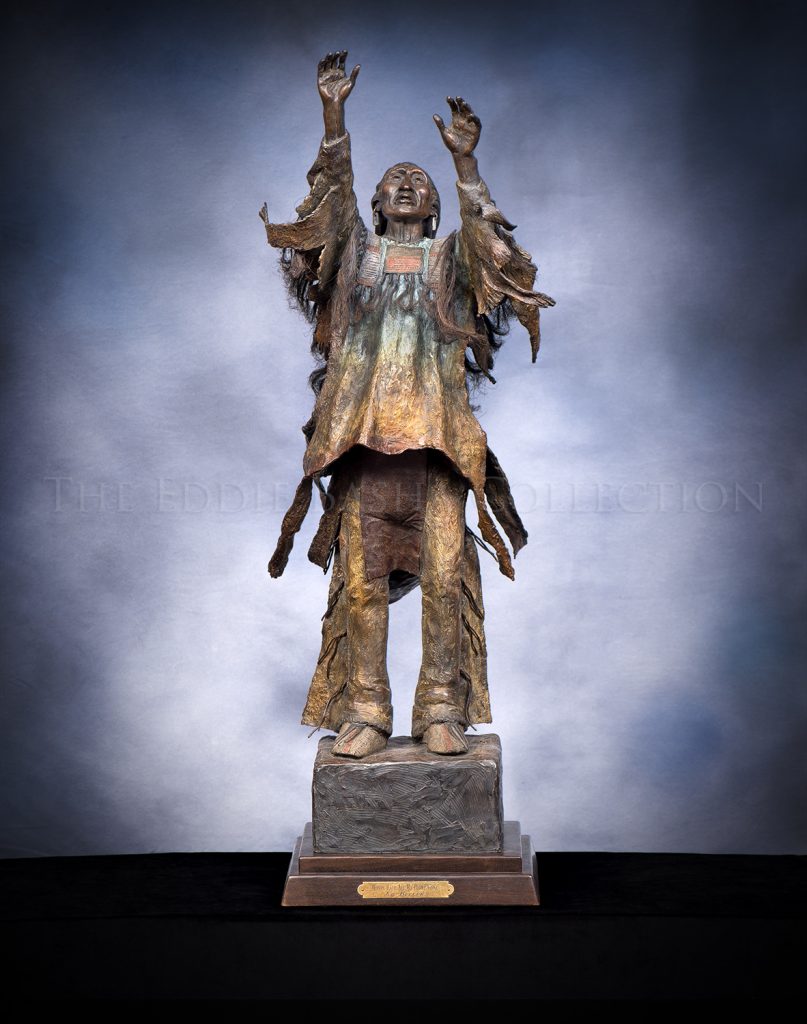 Bronze | Dimensions: 40 ½”h x 18 ½”w x 12”d; Edition #1 of 45
Bronze | Dimensions: 40 ½”h x 18 ½”w x 12”d; Edition #1 of 45Where Have All My people Gone
Artist: Joe Beeler, CA Founding Member (1931-2006)
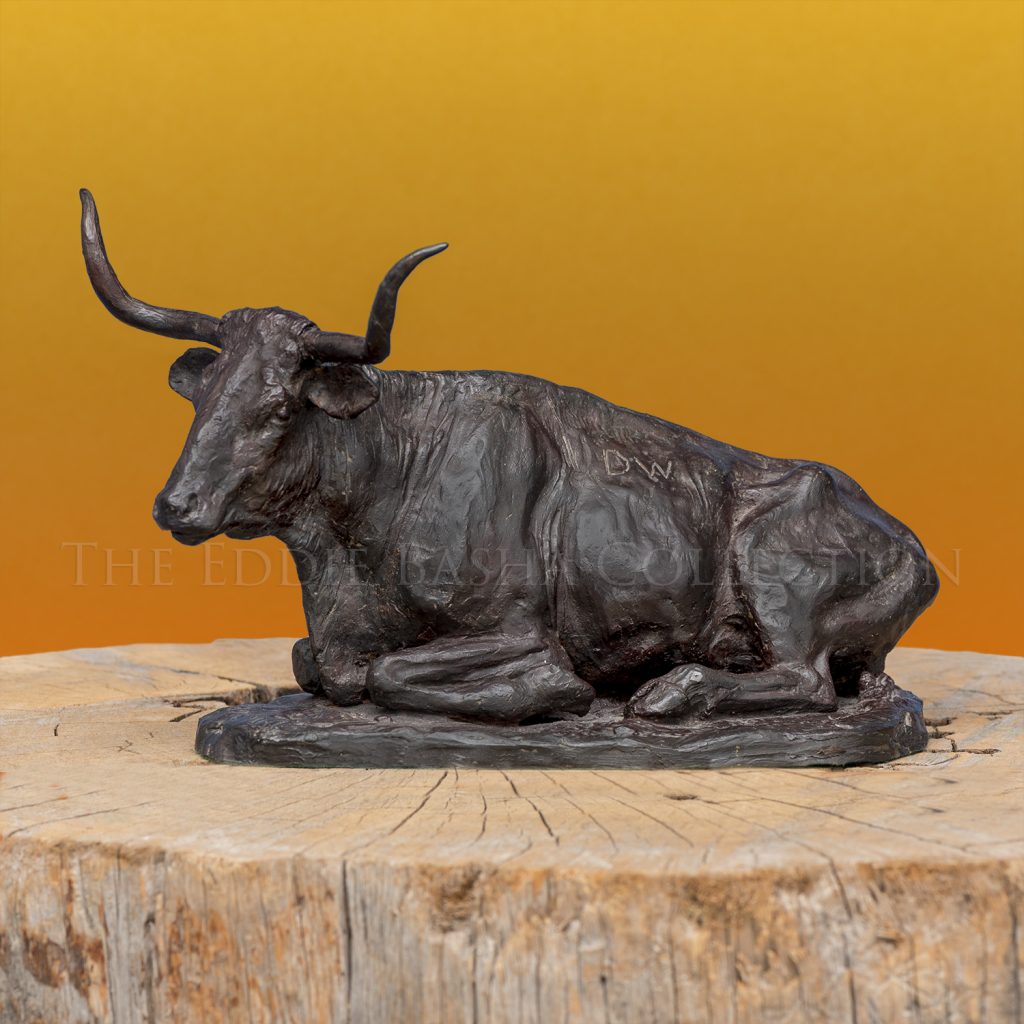 Bronze | Dimensions: 6 ½”h x 10 ½”w; Edition #4 of 30
Bronze | Dimensions: 6 ½”h x 10 ½”w; Edition #4 of 30Did you know that longhorns, male and female, have horns? They will vary in shape and length according to gender and can range anywhere from 40 to 80 inches. Calves may begin the horn sprouting process as early as three weeks and its horns will continue to grow throughout its lifetime.
An image of “Longhorn” also appears in the book entitled “Cowboys and Indians: Characters in Oil and Bronze” which was authored by Joe Beeler and published by University of Oklahoma Press in 1967.
Longhorn
Artist: Joe Beeler, CA Founding Member (1931-2006)
Did you know that longhorns, male and female, have horns? They will vary in shape and length according to gender and can range anywhere from 40 to 80 inches. Calves may begin the horn sprouting process as early as three weeks and its horns will continue to grow throughout its lifetime.
An image of “Longhorn” also appears in the book entitled “Cowboys and Indians: Characters in Oil and Bronze” which was authored by Joe Beeler and published by University of Oklahoma Press in 1967.
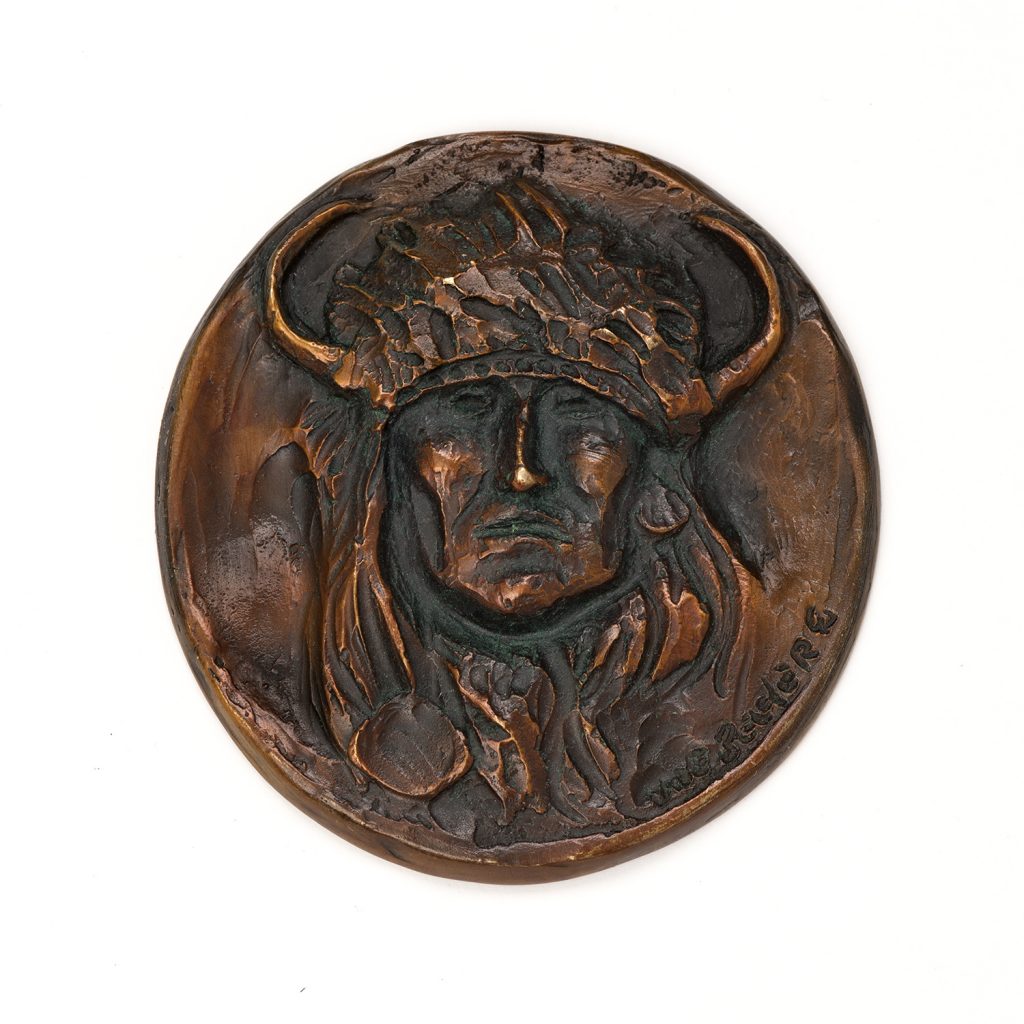 Bronze (1995) | Dimensions: 3 ½” Diameter
Bronze (1995) | Dimensions: 3 ½” DiameterHeaddresses were not worn in battle as it would have been impractical to do so. Distinguished or highly regarded warriors who “earned” a bonnet would wear it during ceremonial or spiritual practices. The horned bison hide bonnets were often embellished with “earned” accoutrements such as fur, tails trailing behind, ermine skins and feathers. In this 1995 medallion, Beeler shared a unique headdress proudly worn by its victor.
Buffalo Horn Headdress
Artist: Joe Beeler, CA Founding Member (1931-2006)
Headdresses were not worn in battle as it would have been impractical to do so. Distinguished or highly regarded warriors who “earned” a bonnet would wear it during ceremonial or spiritual practices. The horned bison hide bonnets were often embellished with “earned” accoutrements such as fur, tails trailing behind, ermine skins and feathers. In this 1995 medallion, Beeler shared a unique headdress proudly worn by its victor.
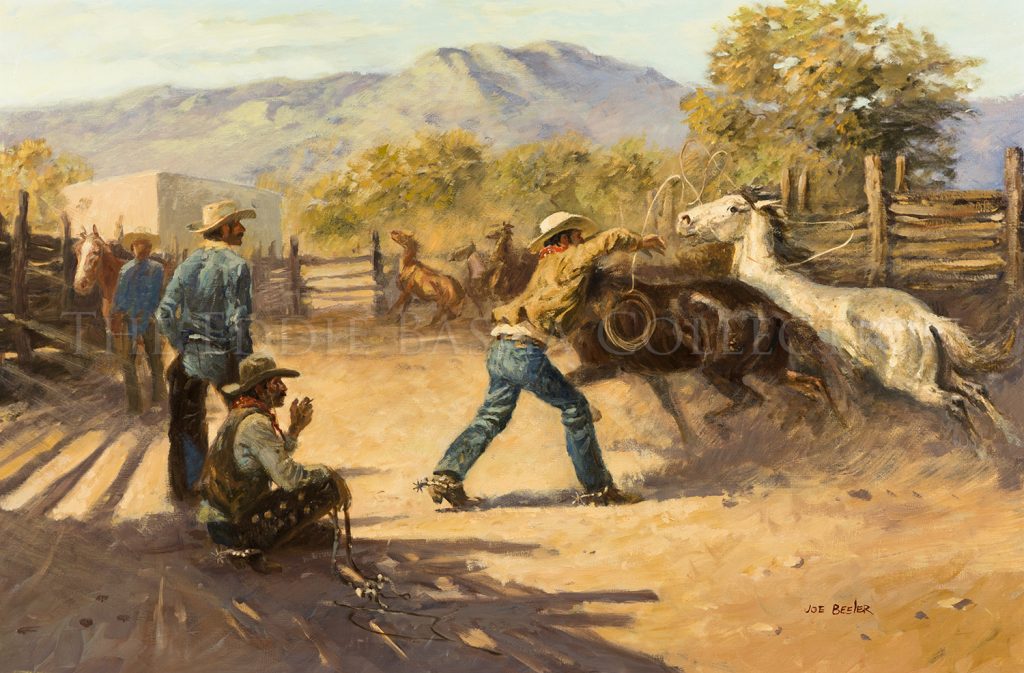 Oil (1965) | Image Size: 20”h x 30”w; Framed Size: 28 ¾”h x 38 ¾”w
Oil (1965) | Image Size: 20”h x 30”w; Framed Size: 28 ¾”h x 38 ¾”wIt was at this ranch in November of 1964 where the formulation of the Cowboy Artists of America idea was first discussed in earnest by artists Joe Beeler, John Hampton and Charlie Dye. Subsequently, the CAA was officially formed in June 1965. And in his book, “Cowboys and Indians: Characters in Oil and Bronze” by Joe Beeler, published by University of Oklahoma Press 1967, Beeler wrote the following about “In the Corral”: “Just about everything having to do with the cowboy, his gear, and his work is related somewhere up the line to the Spaniards or Mexicans, for either they invented it or named it. They also could us it pretty well, too, and the vaquero is a good man to watch today in studying horse handling and roping.
This painting was done from scenes I witnessed and participated in while working a roundup on a ranch in Sonora, Mexico. A couple of other artist friends, John Hampton and Charlie Dye, and I were the guests of an American rancher in Mexico, George Douglas.
The fellow doing the roping was the foreman. He was the best fed and had the biggest mustache and did all the roping in the horse corral, catching each cowboy’s mount for that day. He used a rawhide riata or “gut line,” as it is sometimes called. Of the fifteen or so cowboys, all but one used the rawhide; the one exception had an old, worn nylon. I was amazed to see this fellow stand, what seemed to me, too far away and flip his little thin rope far off into one corner of the corral and reel in a horse caught cleanly around his throat. The Mexican hands were artists when it came to dallying and handling cattle with these small rawhide ropes.
None of the horses looked too gentle and many were not. They were small and wiry and tough as a boot. These boys seemed to like a little “pitch” in their horses in the morning and delighted in putting on a little show when the opportunity presented itself. They were a light-hearted bunch to work with, and even though it became very cold during the roundup and they were dressed for sunny weather, they never lost their sense of humor.”
This Beeler masterwork along with several others will be a part of the Anniversary Exhibition next year of the Cowboy Artists of America at the Briscoe Museum in San Antonio, May 27 through September 5, 2022!
In the Corral
Artist: Joe Beeler, CA Founding Member (1931-2006)
It was at this ranch in November of 1964 where the formulation of the Cowboy Artists of America idea was first discussed in earnest by artists Joe Beeler, John Hampton and Charlie Dye. Subsequently, the CAA was officially formed in June 1965. And in his book, “Cowboys and Indians: Characters in Oil and Bronze” by Joe Beeler, published by University of Oklahoma Press 1967, Beeler wrote the following about “In the Corral”: “Just about everything having to do with the cowboy, his gear, and his work is related somewhere up the line to the Spaniards or Mexicans, for either they invented it or named it. They also could us it pretty well, too, and the vaquero is a good man to watch today in studying horse handling and roping.
This painting was done from scenes I witnessed and participated in while working a roundup on a ranch in Sonora, Mexico. A couple of other artist friends, John Hampton and Charlie Dye, and I were the guests of an American rancher in Mexico, George Douglas.
The fellow doing the roping was the foreman. He was the best fed and had the biggest mustache and did all the roping in the horse corral, catching each cowboy’s mount for that day. He used a rawhide riata or “gut line,” as it is sometimes called. Of the fifteen or so cowboys, all but one used the rawhide; the one exception had an old, worn nylon. I was amazed to see this fellow stand, what seemed to me, too far away and flip his little thin rope far off into one corner of the corral and reel in a horse caught cleanly around his throat. The Mexican hands were artists when it came to dallying and handling cattle with these small rawhide ropes.
None of the horses looked too gentle and many were not. They were small and wiry and tough as a boot. These boys seemed to like a little “pitch” in their horses in the morning and delighted in putting on a little show when the opportunity presented itself. They were a light-hearted bunch to work with, and even though it became very cold during the roundup and they were dressed for sunny weather, they never lost their sense of humor.”
This Beeler masterwork along with several others will be a part of the Anniversary Exhibition next year of the Cowboy Artists of America at the Briscoe Museum in San Antonio, May 27 through September 5, 2022!
 Ink, Watercolor & Pastel | Image Size: 12”h x 11”w; Framed Size: 23 1/8”h x 21 5/8”w
Ink, Watercolor & Pastel | Image Size: 12”h x 11”w; Framed Size: 23 1/8”h x 21 5/8”wThis well done, multi-media portrait by CA Founding Member, Joe Beeler, of a Plains Indian with braided hair and wearing a bone breastplate has a somber facial expression, but one that highlights the subject’s lined, weathered and weary features. His life experiences and story are left up to those who view it.
Unknown Title
Artist: Joe Beeler, CA Founding Member (1931-2006)
This well done, multi-media portrait by CA Founding Member, Joe Beeler, of a Plains Indian with braided hair and wearing a bone breastplate has a somber facial expression, but one that highlights the subject’s lined, weathered and weary features. His life experiences and story are left up to those who view it.
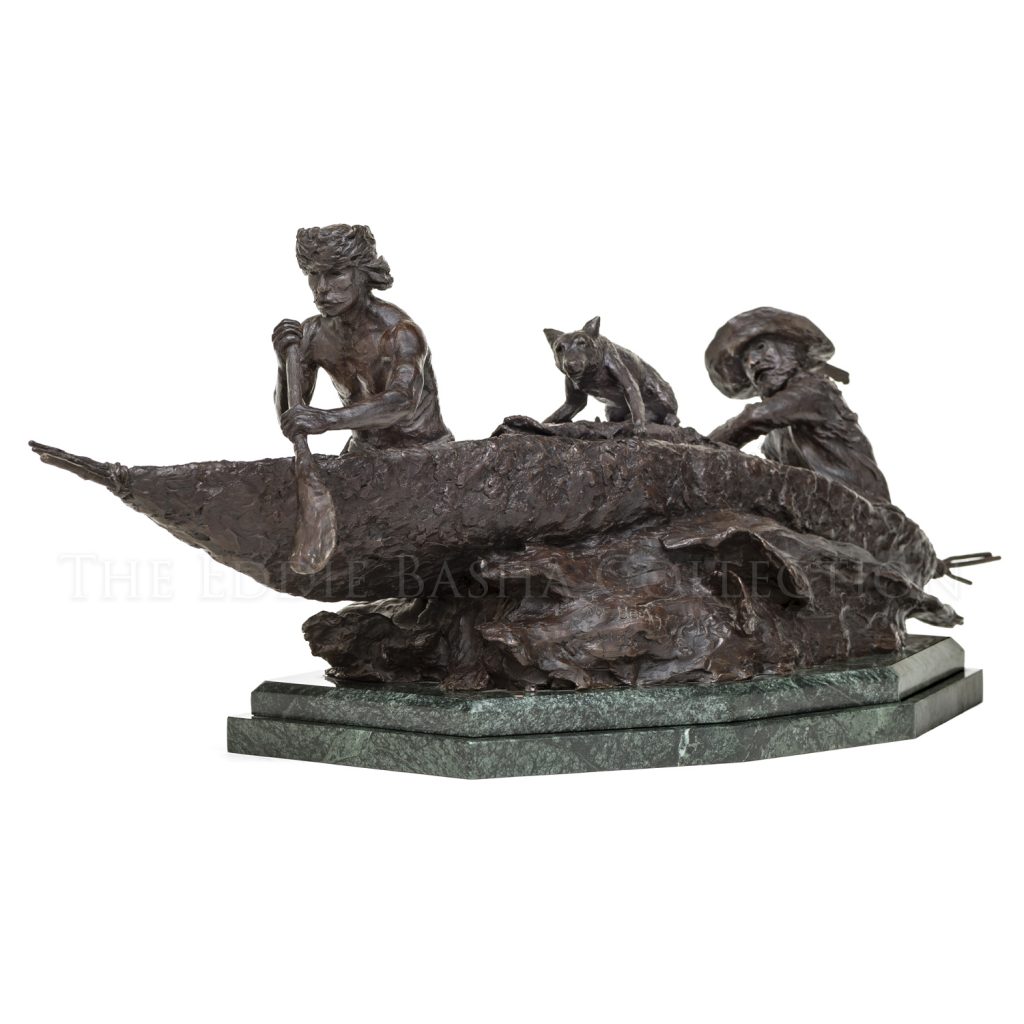 Bronze (1974) | Dimensions: 10”h x 32”w x 9”d; Edition #1 of 22
Bronze (1974) | Dimensions: 10”h x 32”w x 9”d; Edition #1 of 22Making its debut in 1974 at the 9th Annual Cowboy Artists of America Show & Sale held at the Phoenix Art Museum and subsequently exhibited at the Phippen Museum in 2018 in its “Cool, Cool Water’ Exhibition, Joe Beeler’s bronze captures two trappers traveling down the Snake River with their dog poised between them adding a small touch of humor along with the realism. Beeler has quite effectively created the illusion of a canoe moving over rapids and its oarsmen bending to the task.
Down the Snake
Artist: Joe Beeler, CA Founding Member (1931-2006)
Making its debut in 1974 at the 9th Annual Cowboy Artists of America Show & Sale held at the Phoenix Art Museum and subsequently exhibited at the Phippen Museum in 2018 in its “Cool, Cool Water’ Exhibition, Joe Beeler’s bronze captures two trappers traveling down the Snake River with their dog poised between them adding a small touch of humor along with the realism. Beeler has quite effectively created the illusion of a canoe moving over rapids and its oarsmen bending to the task.
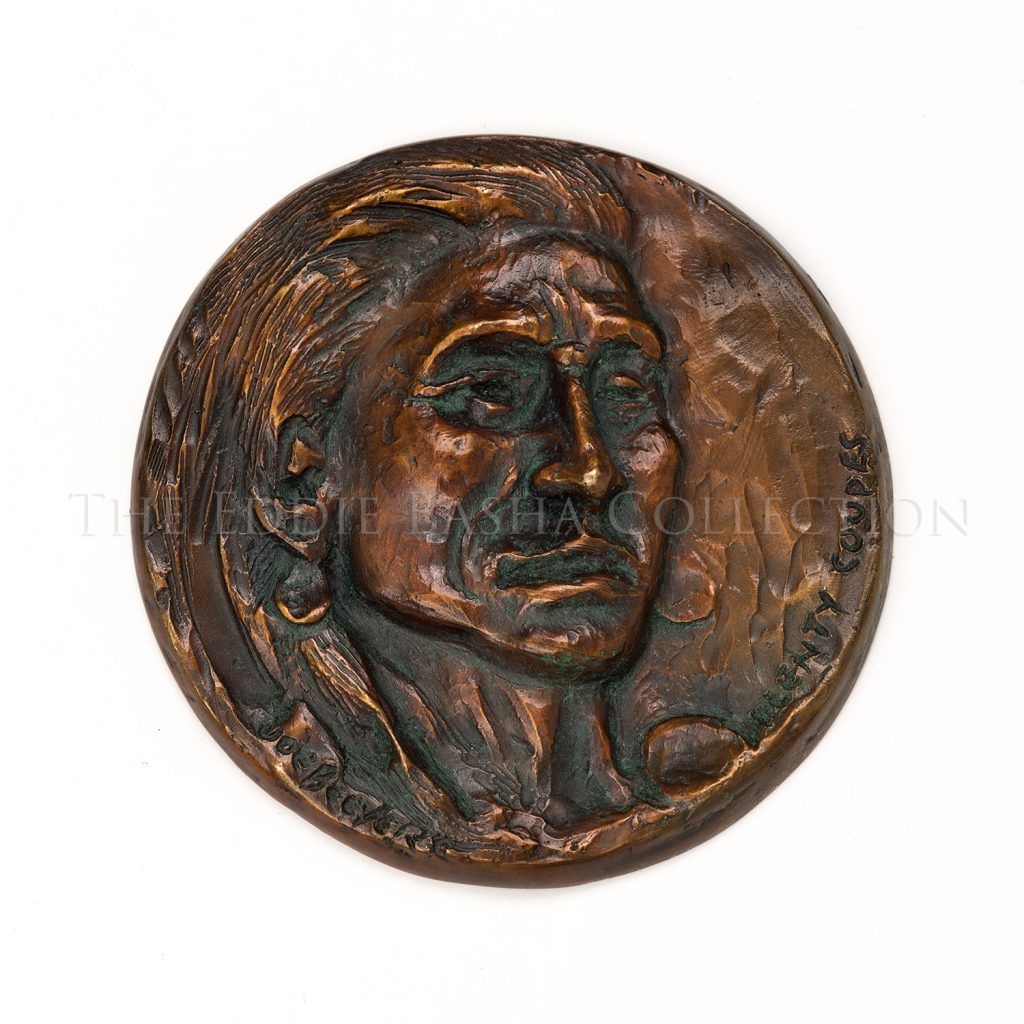 Bronze Medallion (1994) | Dimensions: 3 ½” Diameter
Bronze Medallion (1994) | Dimensions: 3 ½” DiameterSource: National Park Service
The Apsalookee (Crow) people arrived in Bighorn country in very early times and remained. They called this place home-the best place in the entire world. From their arrival in the early 1700's they were constantly challenged by strong tribes from every direction. From the north and west they fought Assiniboine, Blackfeet, and Flatheads. From the east, the Sioux and Cheyenne were constantly at war with them. Fortunately, the Crow have been blessed with great leaders. One of these leaders was Chief Plenty Coups who was born in 1848, a time of great change for the tribe.
By the time Chief Plenty Coups was born, the Crow tribe had been devastated by unrelenting outbreaks of smallpox from contact with Euro-Americans. Their population had dwindled by at least eighty percent, down to at most two thousand people. Surrounded on all sides by enemy tribes, the Crow were in dire need of allies. As a young man, Plenty Coups went on a vision quest where he foresaw the disappearance of the buffalo and cattle eventually covering the Plains. In this vision he also witnessed a strong wind blowing all the trees down in a forest, except for one. He interpreted this to mean the white man would take over the land, just as the wind had swept away all the trees in the forest. The only one left would be the Crow, but only if they worked with them. Plenty Coups vision would help bridge the gap between two distinct cultures. Recognized for his bravery and leadership he was made a chief of the Apsalookee (Crow Tribe) by age 28.
Historically, the Crow people had been friendly with the mountain men and fur traders who passed through the area. They soon befriended the U.S. Government in the area, serving as mail couriers for soldiers at Fort C.F. Smith and guided explorers safely through the area. Plenty Coups counseled that they side with the U.S. government forces throughout the Indian Wars. They brought warnings of attacks by the Sioux and Cheyenne. For help in the Indian Wars, the U.S. Government promised to reserve land in the valley of the Bighorn River and Bighorn Mountains for the Crow people. By the middle of the 1880's the Crow Indians had moved to their reservation along the Yellowstone Valley of Montana. When Plenty Coups gave up his nomadic ways in 1884 he became one of the first Crow to work and settle on a farm, which was deeded to him through the Federal Indian Allotment Act. On his 320 acre tract, located a half mile east of Pryor, Montana he opened a general store, built a home, and began farming.
Nonetheless, Plenty Coups still had to help his people not only adapt to life on the reservation, but also fend off powerful interests that wanted to take the reservation land from the Crow people. The Crow had already lost a majority of their original 38 million acre reservation. By the early 20th century the reservation was down to 1.8 million acres. In 1910, Montana Senator Thomas Walsh introduced a bill to open up the rest of Crow Reservation to white homesteaders. Plenty Coups was determined to fight Walsh’s efforts. He knew he needed educated young men with knowledge of the law to help. He called on Robert Yellowtail to assist in the battle. After seven long years Chief Plenty Coups, Yellowtail, and other tribal members stopped legislation that would open the Crow Indian reservation to general homesteading. The loss of reservation land had finally been stopped. Plenty Coups continued to defend the rights of his community and expressed no second thought about his lifelong conciliatory policy toward the whites, stating “When I think back, my heart sings because we acted as we did.” Upon his death in 1932, at the age of 84, the Apsalookee (Crow) people voted to designate him as their last traditional tribal chief.
Plenty Coups
Artist: Joe Beeler, CA Founding Member (1931-2006)
Source: National Park Service
The Apsalookee (Crow) people arrived in Bighorn country in very early times and remained. They called this place home-the best place in the entire world. From their arrival in the early 1700's they were constantly challenged by strong tribes from every direction. From the north and west they fought Assiniboine, Blackfeet, and Flatheads. From the east, the Sioux and Cheyenne were constantly at war with them. Fortunately, the Crow have been blessed with great leaders. One of these leaders was Chief Plenty Coups who was born in 1848, a time of great change for the tribe.
By the time Chief Plenty Coups was born, the Crow tribe had been devastated by unrelenting outbreaks of smallpox from contact with Euro-Americans. Their population had dwindled by at least eighty percent, down to at most two thousand people. Surrounded on all sides by enemy tribes, the Crow were in dire need of allies. As a young man, Plenty Coups went on a vision quest where he foresaw the disappearance of the buffalo and cattle eventually covering the Plains. In this vision he also witnessed a strong wind blowing all the trees down in a forest, except for one. He interpreted this to mean the white man would take over the land, just as the wind had swept away all the trees in the forest. The only one left would be the Crow, but only if they worked with them. Plenty Coups vision would help bridge the gap between two distinct cultures. Recognized for his bravery and leadership he was made a chief of the Apsalookee (Crow Tribe) by age 28.
Historically, the Crow people had been friendly with the mountain men and fur traders who passed through the area. They soon befriended the U.S. Government in the area, serving as mail couriers for soldiers at Fort C.F. Smith and guided explorers safely through the area. Plenty Coups counseled that they side with the U.S. government forces throughout the Indian Wars. They brought warnings of attacks by the Sioux and Cheyenne. For help in the Indian Wars, the U.S. Government promised to reserve land in the valley of the Bighorn River and Bighorn Mountains for the Crow people. By the middle of the 1880's the Crow Indians had moved to their reservation along the Yellowstone Valley of Montana. When Plenty Coups gave up his nomadic ways in 1884 he became one of the first Crow to work and settle on a farm, which was deeded to him through the Federal Indian Allotment Act. On his 320 acre tract, located a half mile east of Pryor, Montana he opened a general store, built a home, and began farming.
Nonetheless, Plenty Coups still had to help his people not only adapt to life on the reservation, but also fend off powerful interests that wanted to take the reservation land from the Crow people. The Crow had already lost a majority of their original 38 million acre reservation. By the early 20th century the reservation was down to 1.8 million acres. In 1910, Montana Senator Thomas Walsh introduced a bill to open up the rest of Crow Reservation to white homesteaders. Plenty Coups was determined to fight Walsh’s efforts. He knew he needed educated young men with knowledge of the law to help. He called on Robert Yellowtail to assist in the battle. After seven long years Chief Plenty Coups, Yellowtail, and other tribal members stopped legislation that would open the Crow Indian reservation to general homesteading. The loss of reservation land had finally been stopped. Plenty Coups continued to defend the rights of his community and expressed no second thought about his lifelong conciliatory policy toward the whites, stating “When I think back, my heart sings because we acted as we did.” Upon his death in 1932, at the age of 84, the Apsalookee (Crow) people voted to designate him as their last traditional tribal chief.
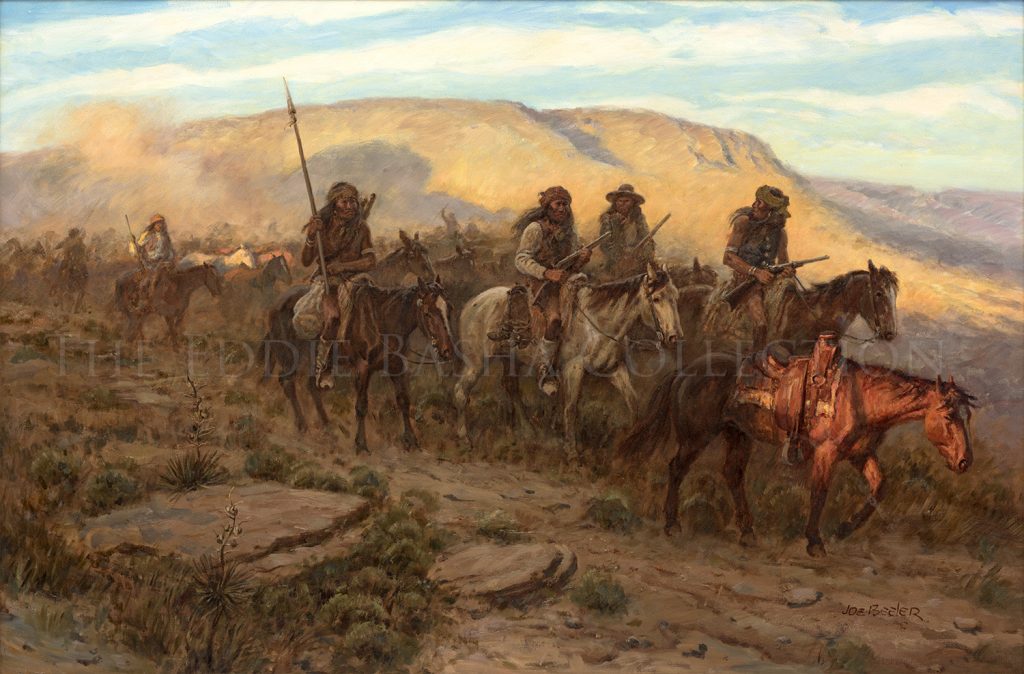 Oil (1972) | Image Size: 24”h x 36”w; Framed Size: 34 ¼”h x 46 ½”w
Oil (1972) | Image Size: 24”h x 36”w; Framed Size: 34 ¼”h x 46 ½”wIn this masterwork oil painting of an Indian raiding party, Beeler conveys a sense of movement by placing his riders in a line from the right foreground of the painting to the distant left middle ground. His use of light and shadow adds dramatic effect with the raiding party shown in dark shadows and capped by the brightly sunlit background of distant mountains. A captured horse is placed just ahead of the figures and is brightly lit, a technique that rivets the viewer’s eye on the horse and draws him into the narrative of the tale.
“The Plunderers” first appeared in the7th Annual Cowboy Artists of America Show & Sale (1972) at the National Cowboy & Western Heritage Museum in Oklahoma City, Oklahoma, and was exhibited again at the Gilcrease Museum in 1980. It remains a much lauded painting at The EBC.
Plunderers
Artist: Joe Beeler, CA Founding Member (1931-2006)
In this masterwork oil painting of an Indian raiding party, Beeler conveys a sense of movement by placing his riders in a line from the right foreground of the painting to the distant left middle ground. His use of light and shadow adds dramatic effect with the raiding party shown in dark shadows and capped by the brightly sunlit background of distant mountains. A captured horse is placed just ahead of the figures and is brightly lit, a technique that rivets the viewer’s eye on the horse and draws him into the narrative of the tale.
“The Plunderers” first appeared in the7th Annual Cowboy Artists of America Show & Sale (1972) at the National Cowboy & Western Heritage Museum in Oklahoma City, Oklahoma, and was exhibited again at the Gilcrease Museum in 1980. It remains a much lauded painting at The EBC.
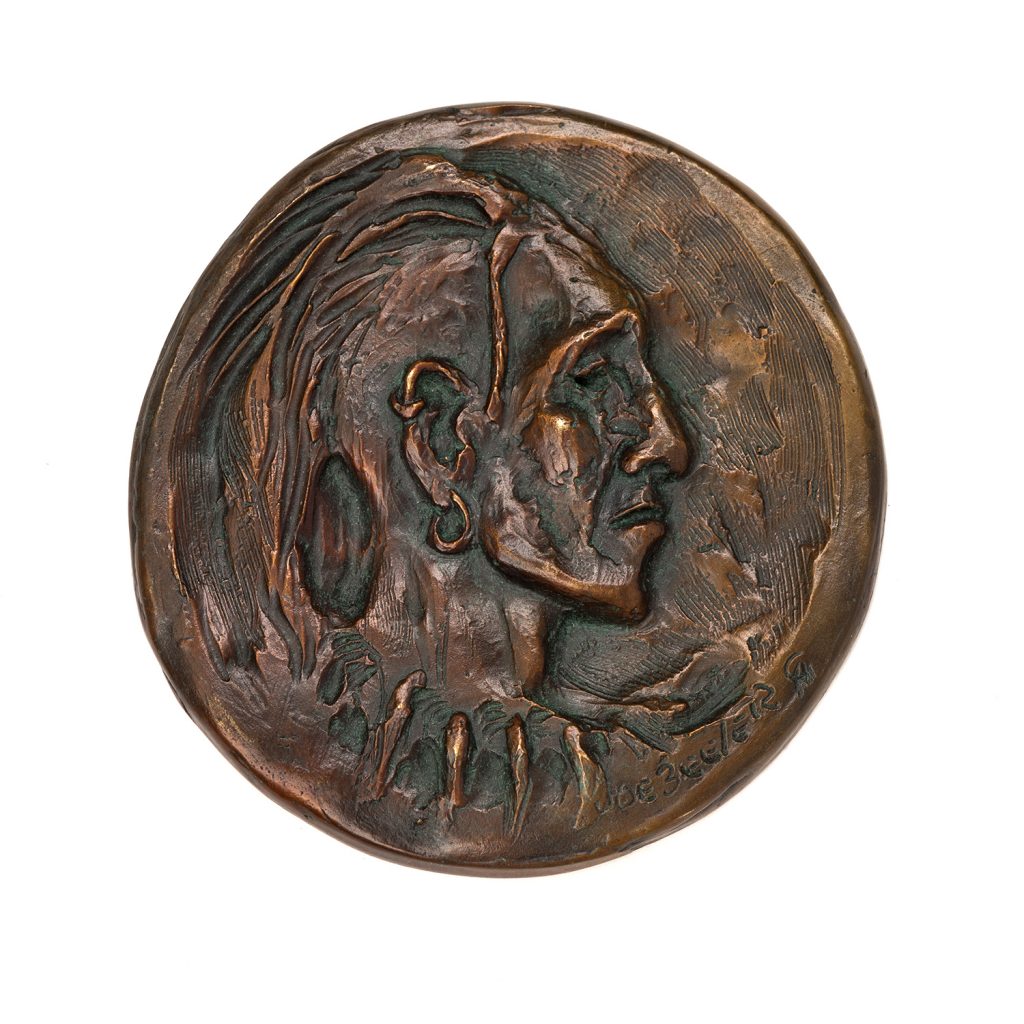 Bronze (1993) | Dimensions: 3 ½” Diameter
Bronze (1993) | Dimensions: 3 ½” Diameter“Similar to the status symbolism of buffalo horn and eagle feather bonnets, bear claw necklaces were worn by distinguished Pawnee, Otoe, and Omaha men as emblems of their accomplishments, honors, and roles as leaders. Pawnee men, in particular, specialized in creating bear claw necklaces made from the long, broad claws of grizzly bears that once roamed the Central and Eastern Plains and guided the wearer during warfare, treaty negotiations, and other important events.
The Pawnee, like other Plains Indian people, held grizzly bears in high esteem because of their strength, power, and fighting abilities—qualities universally admired by Native warriors. Before going into battle, Pawnee warriors sought the sacred protection of animal spirits such as wolves, eagles, mountain lions, or bears—each with their own unique powers. According to Pawnee cosmology, there are four great powers represented by the stars and constellation of the sky: wolf, mountain lion, wildcat (bobcat), and bear. Pawnee men believed that, in order to find success as warriors, they required the defining characteristics of these four animals: the stealth and craftiness of the wolf, the magnetic or drawing power of the mountain lion, the cunning of the cat, and the strength of the bear. In addition to its great strength, Pawnee warriors admired the bear for its ferocity and invulnerability. Through visions, spiritual teachings, and ceremonies, men could learn about and eventually possess the special powers of the bear, including the ability to heal wounds and cure sickness. Men believed that wearing the bear claw necklaces protected them from being hit by arrows and bullets in battle.”
Source: Buffalo Bill Center of the West (March 19, 2014 by Emma Hansen)
Medallion
Artist: Joe Beeler, CA Founding Member (1931-2006)
“Similar to the status symbolism of buffalo horn and eagle feather bonnets, bear claw necklaces were worn by distinguished Pawnee, Otoe, and Omaha men as emblems of their accomplishments, honors, and roles as leaders. Pawnee men, in particular, specialized in creating bear claw necklaces made from the long, broad claws of grizzly bears that once roamed the Central and Eastern Plains and guided the wearer during warfare, treaty negotiations, and other important events.
The Pawnee, like other Plains Indian people, held grizzly bears in high esteem because of their strength, power, and fighting abilities—qualities universally admired by Native warriors. Before going into battle, Pawnee warriors sought the sacred protection of animal spirits such as wolves, eagles, mountain lions, or bears—each with their own unique powers. According to Pawnee cosmology, there are four great powers represented by the stars and constellation of the sky: wolf, mountain lion, wildcat (bobcat), and bear. Pawnee men believed that, in order to find success as warriors, they required the defining characteristics of these four animals: the stealth and craftiness of the wolf, the magnetic or drawing power of the mountain lion, the cunning of the cat, and the strength of the bear. In addition to its great strength, Pawnee warriors admired the bear for its ferocity and invulnerability. Through visions, spiritual teachings, and ceremonies, men could learn about and eventually possess the special powers of the bear, including the ability to heal wounds and cure sickness. Men believed that wearing the bear claw necklaces protected them from being hit by arrows and bullets in battle.”
Source: Buffalo Bill Center of the West (March 19, 2014 by Emma Hansen)
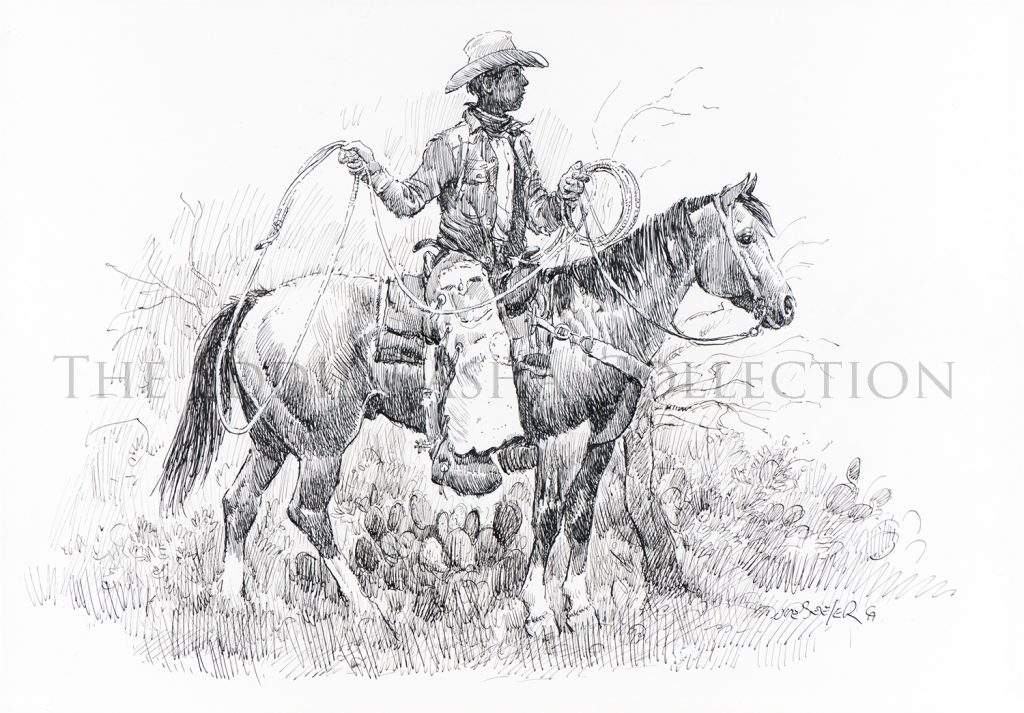 Pen 7 Ink | Image Size: 14”h x 20”w; Framed Size: 23 ½”h x 29 ½”w
Pen 7 Ink | Image Size: 14”h x 20”w; Framed Size: 23 ½”h x 29 ½”wThis medium-sized pen and ink drawing shows Beeler’s knowledge of horses and cowboys and portrays both with precision and realism. With lariat in hand and chaps to protect his legs from the surrounding cacti, the cowboy rides through the rough brush country searching for strays.
Prior to CA Artist, Jason Scull, reaching out to the EBC in April 2021, we did not have the title of this piece. Jason recollected the image when he saw it on social media and contacted the EBC. He shared the following information with us: During the mid-eighties at the Institute of Texan Cultures in San Antonio, now the Briscoe Western Art Museum, a Joe Beeler exhibition was held entitled “In the Cradle of the Cattle Kingdom” which was accompanied by a catalogue. Jason happened to have a copy of that exhibition catalogue and in it this piece appeared with the title cited. Thank you Jason for recollecting the image and reaching out to us so that we could appropriate it with its rightful title!
Brush Country Cowpuncher
Artist: Joe Beeler, CA Founding Member (1931-2006)
This medium-sized pen and ink drawing shows Beeler’s knowledge of horses and cowboys and portrays both with precision and realism. With lariat in hand and chaps to protect his legs from the surrounding cacti, the cowboy rides through the rough brush country searching for strays.
Prior to CA Artist, Jason Scull, reaching out to the EBC in April 2021, we did not have the title of this piece. Jason recollected the image when he saw it on social media and contacted the EBC. He shared the following information with us: During the mid-eighties at the Institute of Texan Cultures in San Antonio, now the Briscoe Western Art Museum, a Joe Beeler exhibition was held entitled “In the Cradle of the Cattle Kingdom” which was accompanied by a catalogue. Jason happened to have a copy of that exhibition catalogue and in it this piece appeared with the title cited. Thank you Jason for recollecting the image and reaching out to us so that we could appropriate it with its rightful title!
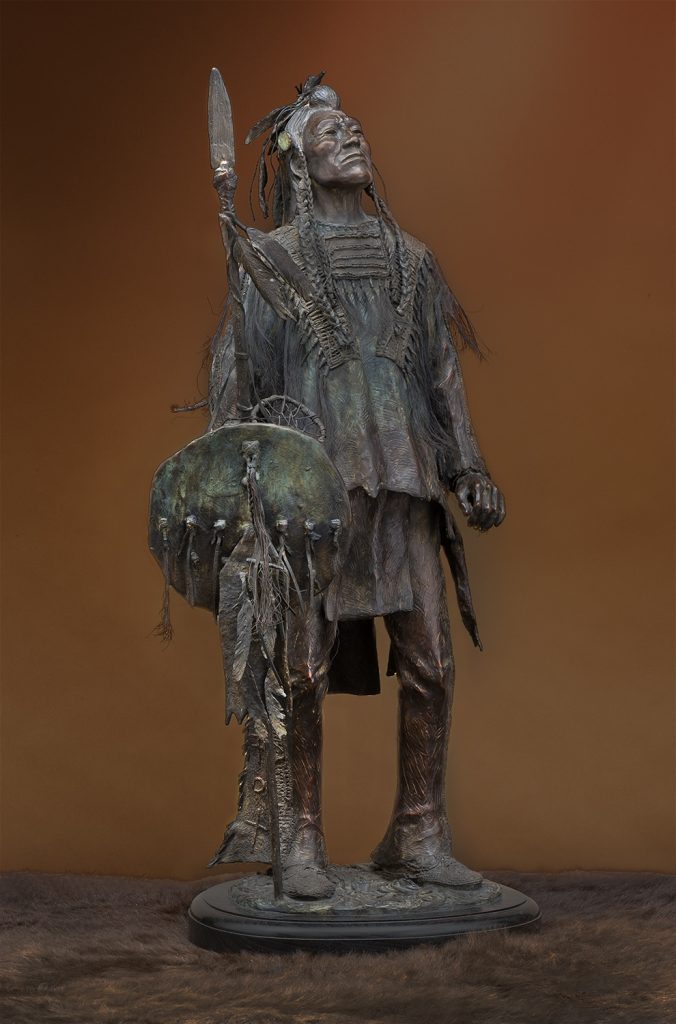 Bronze | Dimensions: 30 1/2”h x 14”w x 12”d; Edition #1 of 35
Bronze | Dimensions: 30 1/2”h x 14”w x 12”d; Edition #1 of 35This large and impressive sculpture of a Plains warrior is rich in details of dress, adornment and sentiment. His face is tilted upward slightly as if listening to the prayers and lessons of his ancestors. The sculpture is particularly effective and educational in its depiction of traditional clothing— beaded buckskin shirt, pants, and moccasins, the feather-adorned, buffalo hide shield and lance, and the eagle feathers in the warrior’s hair. Such well rendered details attests to Beeler’s thorough familiarity of this historical period and his impressive skill as a sculptor.
Joe worked alongside his good friends at the Bronzesmith Fine Art Foundry and Gallery, his go to team when casting his works. This particular casting shown is Edition #1 of 35 and it is featured on the cover of the book entitled “Joe Beeler: Life of a Cowboy Artist”.
Voices in the Wind
Artist: Joe Beeler, CA Founding Member (1931-2006)
This large and impressive sculpture of a Plains warrior is rich in details of dress, adornment and sentiment. His face is tilted upward slightly as if listening to the prayers and lessons of his ancestors. The sculpture is particularly effective and educational in its depiction of traditional clothing— beaded buckskin shirt, pants, and moccasins, the feather-adorned, buffalo hide shield and lance, and the eagle feathers in the warrior’s hair. Such well rendered details attests to Beeler’s thorough familiarity of this historical period and his impressive skill as a sculptor.
Joe worked alongside his good friends at the Bronzesmith Fine Art Foundry and Gallery, his go to team when casting his works. This particular casting shown is Edition #1 of 35 and it is featured on the cover of the book entitled “Joe Beeler: Life of a Cowboy Artist”.
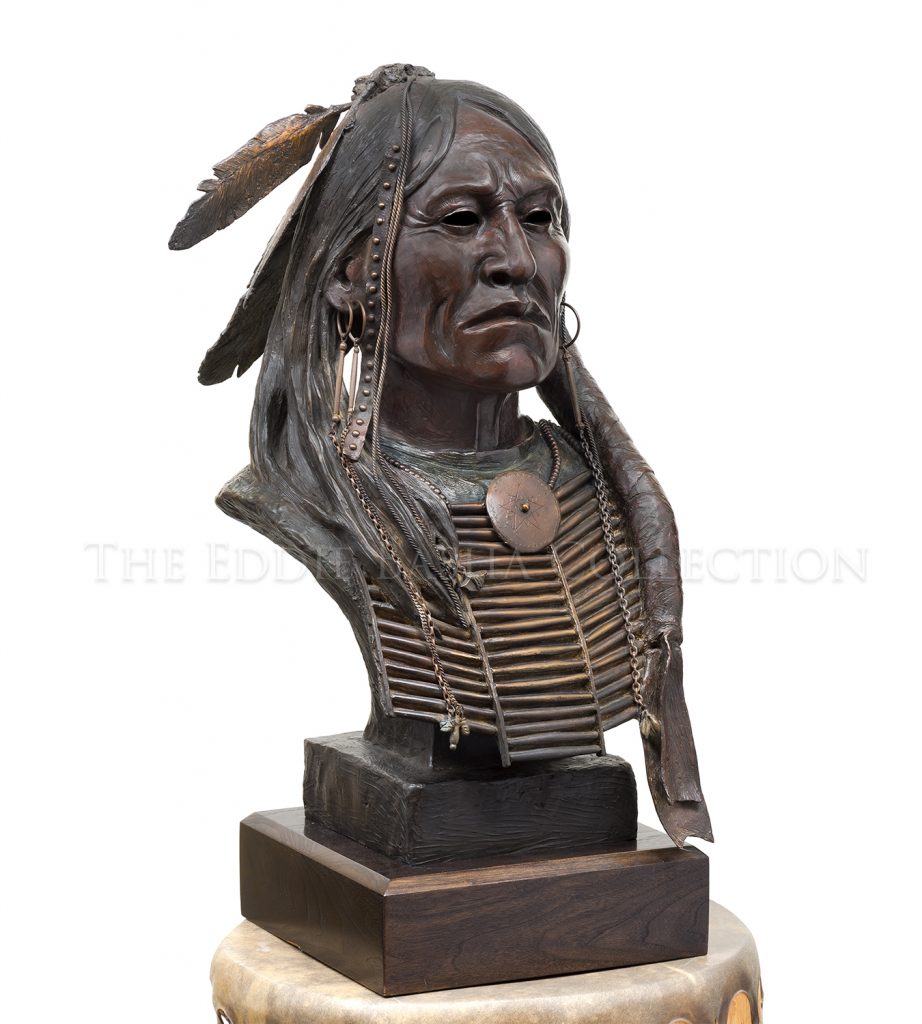 Bronze (2000) | Dimensions: 35”h x 18 ½”w x 19”d; Edition #1 of 25
Bronze (2000) | Dimensions: 35”h x 18 ½”w x 19”d; Edition #1 of 25This large and impressive sculpture of the famous Comanche, Quanah Parker, was the last of the Comanche’s war chiefs. He is shown wearing a bone breast plate and medallion around his neck. His hair is adorned with eagle feathers, and he has a look of fierce pride and determination on his face. Quanah Parker is a man that Beeler obviously had great respect for and one that he had read about and studied many times. As a result, Parker’s strength and resolve are readily apparent in this depiction.
Lord of the Southern Plains took home the Silver Medal in Sculpture at the 35th Annual Cowboy Artists of America Show & Sale at the Phoenix Art Museum in 2000.
Lord of the Southern Plains
Artist: Joe Beeler, CA Founding Member (1931-2006)
This large and impressive sculpture of the famous Comanche, Quanah Parker, was the last of the Comanche’s war chiefs. He is shown wearing a bone breast plate and medallion around his neck. His hair is adorned with eagle feathers, and he has a look of fierce pride and determination on his face. Quanah Parker is a man that Beeler obviously had great respect for and one that he had read about and studied many times. As a result, Parker’s strength and resolve are readily apparent in this depiction.
Lord of the Southern Plains took home the Silver Medal in Sculpture at the 35th Annual Cowboy Artists of America Show & Sale at the Phoenix Art Museum in 2000.
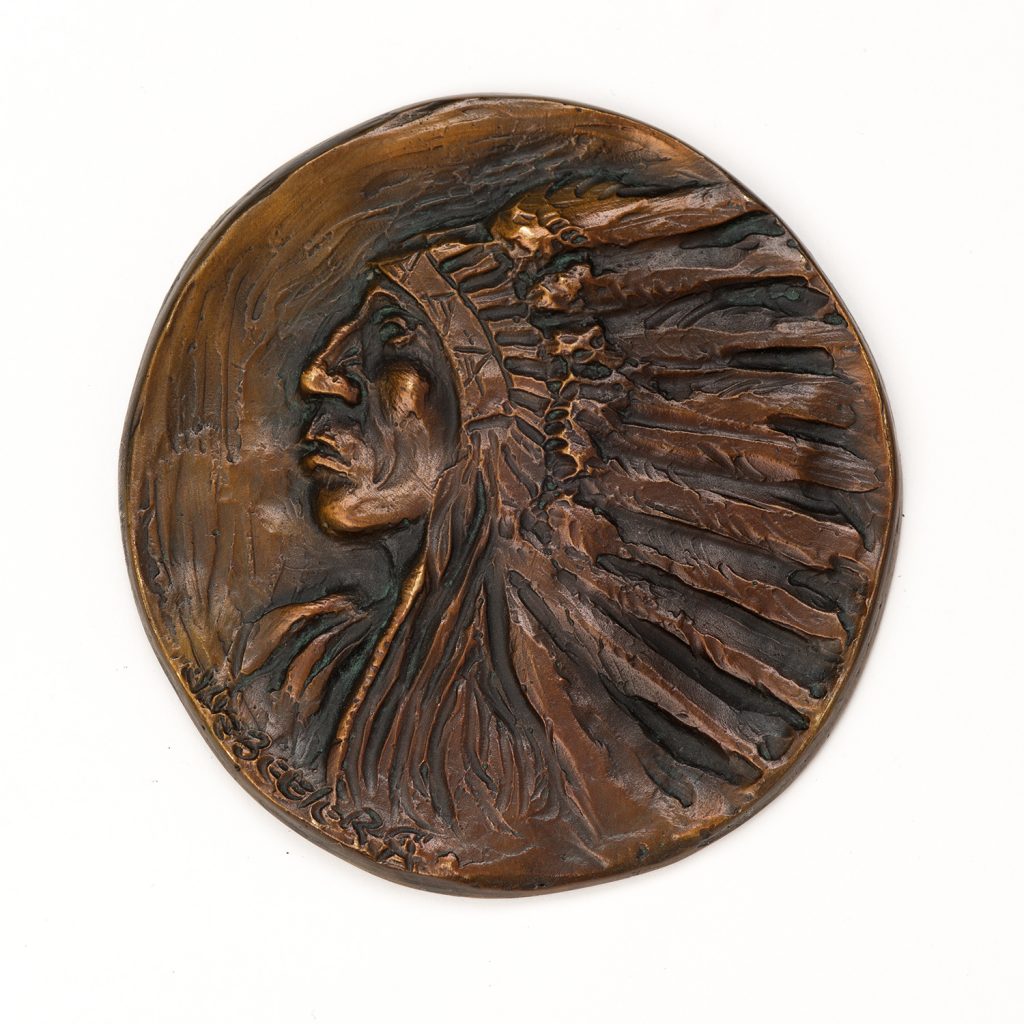 Bronze (1992) | Dimensions: 3 ½” Diameter
Bronze (1992) | Dimensions: 3 ½” DiameterThis 1992 Joe Beeler medallion, the 10th in the series, featured a profile perspective of an American Indian with a fully-feathered headdress and is even more handsome in person! The expertly applied patina accentuates the highs and lows of the piece in all the right places and was applied by Bronzesmith Fine Art Foundry in Prescott, Arizona.
Medallion
Artist: Joe Beeler, CA Founding Member (1931-2006)
This 1992 Joe Beeler medallion, the 10th in the series, featured a profile perspective of an American Indian with a fully-feathered headdress and is even more handsome in person! The expertly applied patina accentuates the highs and lows of the piece in all the right places and was applied by Bronzesmith Fine Art Foundry in Prescott, Arizona.
 Bronze (1991) | Dimensions: 3 ½” Diameter
Bronze (1991) | Dimensions: 3 ½” DiameterJoe Beeler depicted the Osage leader Bacon Rind (1860–1932) in the 1991 medallion gifted by Eddie Basha.
Bacon Rind, a political leader of the late nineteenth and early twentieth centuries, was probably born in Kansas and came to present Osage County, Oklahoma, the former Osage Nation, Indian Territory, during the Osage removal from Kansas in the 1870s. He was an Osage tribal councilman, served as assistant chief in 1904–05, and was elected principal chief in 1912. He was removed as principal chief in 1913 by Secretary of the Interior Walter L. Fisher over a 1906 bribery incident involving an oil lease. Many Osage continued to recognize Bacon Rind as their leader despite his dismissal.
Bacon Rind was politically progressive and favored the allotment of the Osage Reservation and the development of its oil and natural gas resources. He remained a traditionalist in customs, however, and always wore native dress and an otter-skin cap. Bacon Rind was a gifted speaker of the Osage language. He spent the last quarter-century of his life representing the Osage on annual visits to Washington, D.C. It has been claimed that Bacon Rind was the most photographed of all American Indian leaders. He died at Pawhuska, Oklahoma, on March 28, 1932, and was buried on a hill northeast of that community.
Source: Oklahoma Historical Society
Bacon Rind
Artist: Joe Beeler, CA Founding Member (1931-2006)
Joe Beeler depicted the Osage leader Bacon Rind (1860–1932) in the 1991 medallion gifted by Eddie Basha.
Bacon Rind, a political leader of the late nineteenth and early twentieth centuries, was probably born in Kansas and came to present Osage County, Oklahoma, the former Osage Nation, Indian Territory, during the Osage removal from Kansas in the 1870s. He was an Osage tribal councilman, served as assistant chief in 1904–05, and was elected principal chief in 1912. He was removed as principal chief in 1913 by Secretary of the Interior Walter L. Fisher over a 1906 bribery incident involving an oil lease. Many Osage continued to recognize Bacon Rind as their leader despite his dismissal.
Bacon Rind was politically progressive and favored the allotment of the Osage Reservation and the development of its oil and natural gas resources. He remained a traditionalist in customs, however, and always wore native dress and an otter-skin cap. Bacon Rind was a gifted speaker of the Osage language. He spent the last quarter-century of his life representing the Osage on annual visits to Washington, D.C. It has been claimed that Bacon Rind was the most photographed of all American Indian leaders. He died at Pawhuska, Oklahoma, on March 28, 1932, and was buried on a hill northeast of that community.
Source: Oklahoma Historical Society
 Bronze (1996) | Dimensions: 40 ½”h x 15 ½”w x 14”d; AP Edition
Bronze (1996) | Dimensions: 40 ½”h x 15 ½”w x 14”d; AP EditionBorn in South Dakota, Crazy Horse, the Lakota war leader of the Oglala band, fought in numerous battles against the encroaching settlers and to preserve the traditional way of life of his people. Among the battles were the Black Hills War, the Fetterman Fight, Battle of the Rosebud and the Battle of Little Bighorn. He earned the respect of both his enemies and his own people.
Source History: Crazy Horse is remembered for his courage, leadership and tenacity of spirit in the face of near-impossible odds. His legacy is celebrated in the Crazy Horse Memorial, an uncompleted monumental sculpture located in the Black Hills, not far from Mount Rushmore. Started in 1948 by sculptor Korczak Ziółkowski (who also worked on Mount Rushmore), the Crazy Horse Memorial would be the largest sculpture in the world when completed. Operated by the nonprofit Crazy Horse Memorial Foundation, the sculpture grounds are open to the public and reportedly receive more than one million visitors each year.
Founding member of the Cowboy Artists of America, Joe Beeler, debuted his bronze tribute to the great Lakota leader in 1996 at the 31st Annual CAA Show & Sale at the Phoenix Art Museum.
Crazy Horse
Artist: Joe Beeler, CA Founding Member (1931-2006)
Born in South Dakota, Crazy Horse, the Lakota war leader of the Oglala band, fought in numerous battles against the encroaching settlers and to preserve the traditional way of life of his people. Among the battles were the Black Hills War, the Fetterman Fight, Battle of the Rosebud and the Battle of Little Bighorn. He earned the respect of both his enemies and his own people.
Source History: Crazy Horse is remembered for his courage, leadership and tenacity of spirit in the face of near-impossible odds. His legacy is celebrated in the Crazy Horse Memorial, an uncompleted monumental sculpture located in the Black Hills, not far from Mount Rushmore. Started in 1948 by sculptor Korczak Ziółkowski (who also worked on Mount Rushmore), the Crazy Horse Memorial would be the largest sculpture in the world when completed. Operated by the nonprofit Crazy Horse Memorial Foundation, the sculpture grounds are open to the public and reportedly receive more than one million visitors each year.
Founding member of the Cowboy Artists of America, Joe Beeler, debuted his bronze tribute to the great Lakota leader in 1996 at the 31st Annual CAA Show & Sale at the Phoenix Art Museum.
 Oil (1974) | Image Size: 30”h x 48”w; Framed Size: 41”h x 58”w
Oil (1974) | Image Size: 30”h x 48”w; Framed Size: 41”h x 58”wWhen trade began between the native New Mexicans and the Commanche, the New Mexicans would drive their carts and pack trains out onto the Staked Plains of what now is West Texas. In the early days, the goods usually consisted of bread, cloth or other articles of low value which they would trade with the Indians for bison robes and other pelts. But as the Comanche expanded their warfare on the frontier of Texas and Northern Mexico, they began to have large herds of horses, mules and cattle for trade. The more ambitious New Mexicans then started to bring muskets, pistols, knives, lead, and whiskey to trade. The height of this trade lasted from 1850 until the mid 1870's.
By 1876, the Comanche trails were cut deep in the sands of West Texas and New Mexico. Three major trails existed that lead to the meeting places on the Staked Plains; one near Amarillo, one near Lubbock and the other east of Tucumcari, near the Texas border. It was estimated that thousands of livestock head changed hands during this period of time and most of the cattle bore Texas brands.
Comancheros
Artist: Joe Beeler, CA Founding Member (1931-2006)
When trade began between the native New Mexicans and the Commanche, the New Mexicans would drive their carts and pack trains out onto the Staked Plains of what now is West Texas. In the early days, the goods usually consisted of bread, cloth or other articles of low value which they would trade with the Indians for bison robes and other pelts. But as the Comanche expanded their warfare on the frontier of Texas and Northern Mexico, they began to have large herds of horses, mules and cattle for trade. The more ambitious New Mexicans then started to bring muskets, pistols, knives, lead, and whiskey to trade. The height of this trade lasted from 1850 until the mid 1870's.
By 1876, the Comanche trails were cut deep in the sands of West Texas and New Mexico. Three major trails existed that lead to the meeting places on the Staked Plains; one near Amarillo, one near Lubbock and the other east of Tucumcari, near the Texas border. It was estimated that thousands of livestock head changed hands during this period of time and most of the cattle bore Texas brands.
 Bronze | Dimensions: 28”h x 13”w x 13”d; Edition #1 of 45
Bronze | Dimensions: 28”h x 13”w x 13”d; Edition #1 of 45Manuelito was a prominent Navajo leader who rallied his people against the United States military. For several years he led a group of warriors in resisting federal efforts to forcibly remove the Navajo people to Bosque Redondo, New Mexico, via the Long Walk in 1864. After being relocated to Bosque Redondo, Manuelito was among the leaders who signed the 1868 treaty and establishing a reservation for the Navajo. In 1871 he became Chief of the Navajo. Among his many accomplishments, he met with Presidents Grant and Hayes to resolve land disputes, potential land leases, whiskey trafficking as well as other issues. Though Manuelito was succeeded as Chief by Henry Chee Dodge in 1884, he remained a leader and forceful advocate of the Navajo people until he succumbed to measles complicated by pneumonia in 1893.
This large bronze depicts a seated Manuelito with clothing and other accoutrements appropriate to the late 19th century. Placed on a cube base, all four sides are in bas relief showing Manuelito and others of his band during a raid. The juxtaposition between the intense action of the bas relief and the quiet repose of Manuelito, the seated figure and primary subject of the bronze, is quite effective. The bronze is impressive in size, execution, and quality.
Manuelito
Artist: Joe Beeler, CA Founding Member (1931-2006)
Manuelito was a prominent Navajo leader who rallied his people against the United States military. For several years he led a group of warriors in resisting federal efforts to forcibly remove the Navajo people to Bosque Redondo, New Mexico, via the Long Walk in 1864. After being relocated to Bosque Redondo, Manuelito was among the leaders who signed the 1868 treaty and establishing a reservation for the Navajo. In 1871 he became Chief of the Navajo. Among his many accomplishments, he met with Presidents Grant and Hayes to resolve land disputes, potential land leases, whiskey trafficking as well as other issues. Though Manuelito was succeeded as Chief by Henry Chee Dodge in 1884, he remained a leader and forceful advocate of the Navajo people until he succumbed to measles complicated by pneumonia in 1893.
This large bronze depicts a seated Manuelito with clothing and other accoutrements appropriate to the late 19th century. Placed on a cube base, all four sides are in bas relief showing Manuelito and others of his band during a raid. The juxtaposition between the intense action of the bas relief and the quiet repose of Manuelito, the seated figure and primary subject of the bronze, is quite effective. The bronze is impressive in size, execution, and quality.
 Bronze (1989) | Dimensions: 3 ½” Diameter
Bronze (1989) | Dimensions: 3 ½” DiameterGERONIMO (1829-1909) … the eighth Joe Beeler medallion (1990) in the series! Much has been written about the legendary Geronimo and chances are you learned about his life at home, in school, at a museum or from a book you’ve read. He was fervent in his pursuit to protect Apache lands, its people and their way of life after his wife, children, mother and other tribal members were killed by marauders.
Geronimo
Artist: Joe Beeler, CA Founding Member (1931-2006)
GERONIMO (1829-1909) … the eighth Joe Beeler medallion (1990) in the series! Much has been written about the legendary Geronimo and chances are you learned about his life at home, in school, at a museum or from a book you’ve read. He was fervent in his pursuit to protect Apache lands, its people and their way of life after his wife, children, mother and other tribal members were killed by marauders.
 Bronze (1990) | Dimensions: 20”h x 15”w x 14”d; Edition #1 of 35
Bronze (1990) | Dimensions: 20”h x 15”w x 14”d; Edition #1 of 35Beeler’s interpretation of a Plains Indian chief who has traveled to Washington to represent his people is one of his major bronzes. It is an extremely well done sculpture and includes many authentic period elements and is representative of Beeler’s ability to create figures that detail remarkable realism and persona.
Wearing the President’s gifts of a peace medal and top hat, the Chief is regally posed with his buffalo hide beneath him as he watches the parade festivities passing by. His right hand rests upon the also newly gifted walking stick while his left hand steadies his peace pipe balanced across his knees. The fringed garments and moccasins appear to be from finely tanned hides. And the hair drop, it too a finely tanned hide, lays upon his chest and a long hair tail completes the representation.
“Chief Goes to Washington” won both the Gold Medal in sculpture and the Best of Show award at the 25th Annual Cowboy Artists Show & Sale at the Phoenix Art Museum in 1990.
The Chief Goes to Washington
Artist: Joe Beeler, CA Founding Member (1931-2006)
Beeler’s interpretation of a Plains Indian chief who has traveled to Washington to represent his people is one of his major bronzes. It is an extremely well done sculpture and includes many authentic period elements and is representative of Beeler’s ability to create figures that detail remarkable realism and persona.
Wearing the President’s gifts of a peace medal and top hat, the Chief is regally posed with his buffalo hide beneath him as he watches the parade festivities passing by. His right hand rests upon the also newly gifted walking stick while his left hand steadies his peace pipe balanced across his knees. The fringed garments and moccasins appear to be from finely tanned hides. And the hair drop, it too a finely tanned hide, lays upon his chest and a long hair tail completes the representation.
“Chief Goes to Washington” won both the Gold Medal in sculpture and the Best of Show award at the 25th Annual Cowboy Artists Show & Sale at the Phoenix Art Museum in 1990.
 Bronze (1989) | Dimensions: 3 ½” Diameter
Bronze (1989) | Dimensions: 3 ½” DiameterThe seventh Joe Beeler medallion in the series… 1989! The Plains Indian presented wears a breastplate which was a popular chest ornament. Typically they were worn for ceremonial purposes since they offered little in the way of protection during a battle. The long bones featured are called hair pipes and were made from bison, other animals and occasionally birds. Often the quantity of bones that appeared on a breastplate could be an indication of a warrior’s wealth and/or prowess as a hunter. Breastplates could also be further adorned with abalone shells, quills, feathers and other accoutrements.
Plains Indian with Breastplate
Artist: Joe Beeler, CA Founding Member (1931-2006)
The seventh Joe Beeler medallion in the series… 1989! The Plains Indian presented wears a breastplate which was a popular chest ornament. Typically they were worn for ceremonial purposes since they offered little in the way of protection during a battle. The long bones featured are called hair pipes and were made from bison, other animals and occasionally birds. Often the quantity of bones that appeared on a breastplate could be an indication of a warrior’s wealth and/or prowess as a hunter. Breastplates could also be further adorned with abalone shells, quills, feathers and other accoutrements.
 Bronze (1998) | Dimensions: 14”h x 21 ½”w x 8”d; Edition #1 of 35
Bronze (1998) | Dimensions: 14”h x 21 ½”w x 8”d; Edition #1 of 35Voice of the Wilderness
Artist: Joe Beeler, CA Founding Member (1931-2006)
 Bronze | Dimensions: 16”h x 12”w x 10”d; Edition #1 of 40
Bronze | Dimensions: 16”h x 12”w x 10”d; Edition #1 of 40The term renegade once referred to American Indians, in this case an Apache, who refused to be confined to reservations. His face shows his character and determination to control his own destiny. He wears earrings and a scarf decorated with silver buttons around his head.
Joe Beeler was of Cherokee descent and often participated in dances on the Cherokee Reservation in Oklahoma. He was proud of his heritage and that of other Indian Nations and his work is a reflection of that pride as well as the enormous reverence he felt for all.
The Renegade
Artist: Joe Beeler, CA Founding Member (1931-2006)
The term renegade once referred to American Indians, in this case an Apache, who refused to be confined to reservations. His face shows his character and determination to control his own destiny. He wears earrings and a scarf decorated with silver buttons around his head.
Joe Beeler was of Cherokee descent and often participated in dances on the Cherokee Reservation in Oklahoma. He was proud of his heritage and that of other Indian Nations and his work is a reflection of that pride as well as the enormous reverence he felt for all.
 Bronze (1988) | Dimensions: 3 1/2"h x 3 1/2"w
Bronze (1988) | Dimensions: 3 1/2"h x 3 1/2"wThe sixth Joe Beeler medallion in the series… 1988! We’re feelin’ that hat. How about you?
Medallion
Artist: Joe Beeler, CA Founding Member (1931-2006)
The sixth Joe Beeler medallion in the series… 1988! We’re feelin’ that hat. How about you?
 Watercolor Marker | Image Size: 11"h x 8 1/2"w; Framed Size: 19 ¾”h x 17 ½”w
Watercolor Marker | Image Size: 11"h x 8 1/2"w; Framed Size: 19 ¾”h x 17 ½”wIn honor of the 128th year of author, storyteller and artist Will James’ birth, June 6, 1892, we thought it fitting to share this letter Joe Beeler penned and sent to Eddie following their co-hosting the Will James Society in the gallery in January 2000.
The letter reads, “Well Eddie, at least we know if Will James had been in Arizona in the last 20 to 30 years, he would not have gone malnourished I bet. Sharon and I had a great evening with you and the Will James Society. They are a great bunch and really enjoyed the opportunity to see your collection. Fact is, they were awestruck as are most who see the gallery for the first time.” Translation: Joe was mockingly referring to Eddie’s penchant for exchanging groceries for art which the society attendees duly noted was absent from the collection.
Evidently the society members didn’t hold it against Eddie as he was asked seven years later in January 2007 to auction a print of this same letter at the Annual Will James Society’s Fundraising Dinner. It sold quite successfully! During that same year, three log cabins from James’ Rocking R Ranch, one of which was his studio, were relocated to the Big Horn County Historical Museum & Visitor Center in Hardin, Montana.
Will James Society Gallery Visit
Artist: Joe Beeler, CA Founding Member (1931-2006)
In honor of the 128th year of author, storyteller and artist Will James’ birth, June 6, 1892, we thought it fitting to share this letter Joe Beeler penned and sent to Eddie following their co-hosting the Will James Society in the gallery in January 2000.
The letter reads, “Well Eddie, at least we know if Will James had been in Arizona in the last 20 to 30 years, he would not have gone malnourished I bet. Sharon and I had a great evening with you and the Will James Society. They are a great bunch and really enjoyed the opportunity to see your collection. Fact is, they were awestruck as are most who see the gallery for the first time.” Translation: Joe was mockingly referring to Eddie’s penchant for exchanging groceries for art which the society attendees duly noted was absent from the collection.
Evidently the society members didn’t hold it against Eddie as he was asked seven years later in January 2007 to auction a print of this same letter at the Annual Will James Society’s Fundraising Dinner. It sold quite successfully! During that same year, three log cabins from James’ Rocking R Ranch, one of which was his studio, were relocated to the Big Horn County Historical Museum & Visitor Center in Hardin, Montana.
 Oil | Image Size: 30”h x 48”w; Framed Size: 40”h x 58”w
Oil | Image Size: 30”h x 48”w; Framed Size: 40”h x 58”wOne of the truly iconic figures of the West was born after the Civil War when great herds of untamed longhorn cattle roamed the plains of South Texas. As northern cities grew more populous, a demand rose for more and more meat to feed the people there. Texas had the cattle, but it did not have the means to transport the cattle to northern and eastern markets, thus the age of the great cattle drives was born as young men were employed to move herds of longhorns from Texas to Kansas rail heads. The men who drove the cattle used skills and tools borrowed from Mexican Vaqueros and southern stock herders and developed a few skills and tools of their own as well. In this sweeping painting, Joe Beeler reveals two cowboys riding at the head of a large herd headed north. They are riding across a rolling grassy terrain toward the sun. At their backs, the great herd stretches into the distance and to the right, the supply wagon. “The Heritage of Texas” is in essence the creation of the American cowboy.
Heritage of Texas
Artist: Joe Beeler, CA Founding Member (1931-2006)
One of the truly iconic figures of the West was born after the Civil War when great herds of untamed longhorn cattle roamed the plains of South Texas. As northern cities grew more populous, a demand rose for more and more meat to feed the people there. Texas had the cattle, but it did not have the means to transport the cattle to northern and eastern markets, thus the age of the great cattle drives was born as young men were employed to move herds of longhorns from Texas to Kansas rail heads. The men who drove the cattle used skills and tools borrowed from Mexican Vaqueros and southern stock herders and developed a few skills and tools of their own as well. In this sweeping painting, Joe Beeler reveals two cowboys riding at the head of a large herd headed north. They are riding across a rolling grassy terrain toward the sun. At their backs, the great herd stretches into the distance and to the right, the supply wagon. “The Heritage of Texas” is in essence the creation of the American cowboy.
 Oil Painting | Image Size: 24”h x 40”w; Framed Size: 36”h x 52”w
Oil Painting | Image Size: 24”h x 40”w; Framed Size: 36”h x 52”wA truly unholy alliance of outlaws dealing in guns for use during raids and robberies on the frontier are gathered around a smoky campfire that casts an eerie light on the proceedings. The fire creates a circle of illumination that dissipates as the viewer’s eye moves from the center of the painting to its outer edges. Once again, Beeler spins a tale from the pages of western history
Unholy Alliance
Artist: Joe Beeler, CA Founding Member (1931-2006)
A truly unholy alliance of outlaws dealing in guns for use during raids and robberies on the frontier are gathered around a smoky campfire that casts an eerie light on the proceedings. The fire creates a circle of illumination that dissipates as the viewer’s eye moves from the center of the painting to its outer edges. Once again, Beeler spins a tale from the pages of western history
 Bronze (1987) | 3 ½”h x 3 ½”w
Bronze (1987) | 3 ½”h x 3 ½”wIn 1987, the Apache Scout Profile medallion entered the series; it was the fifth to do so!
As you may recall, in 1983 Cowboy Artists of America Founding Member Joe Beeler and Eddie Basha collaborated on what would eventually become a hallmark series of bronze, and later, pewter medallions. At that time, neither envisioned the scope nor popularity. Individual medallions soon became sets and much later a series totaling twenty-four pieces. The medallions were used as holiday gifts or acknowledgements of gratitude.
Apache Scout Profile
Artist: Joe Beeler, CA Founding Member (1931-2006)
In 1987, the Apache Scout Profile medallion entered the series; it was the fifth to do so!
As you may recall, in 1983 Cowboy Artists of America Founding Member Joe Beeler and Eddie Basha collaborated on what would eventually become a hallmark series of bronze, and later, pewter medallions. At that time, neither envisioned the scope nor popularity. Individual medallions soon became sets and much later a series totaling twenty-four pieces. The medallions were used as holiday gifts or acknowledgements of gratitude.
 Bronze (1986) | 3 ½”h x 3 ½”w
Bronze (1986) | 3 ½”h x 3 ½”wThe second “Plains Indian” medallion entered the series in 1986! Slightly different than its predecessor, this particular likeness leans toward a depiction of a Sioux Indian.
Plains Indian
Artist: Joe Beeler, CA Founding Member (1931-2006)
The second “Plains Indian” medallion entered the series in 1986! Slightly different than its predecessor, this particular likeness leans toward a depiction of a Sioux Indian.
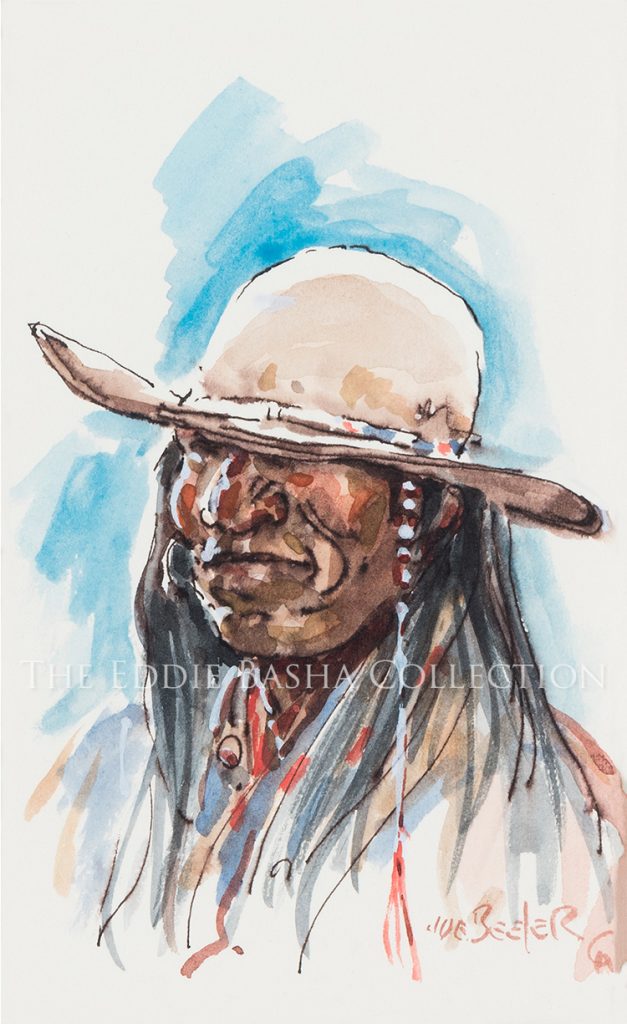 Watercolor | Image Size: 6”h x 4”w; Framed Size: 15 7/8” h x 13 7/8”w
Watercolor | Image Size: 6”h x 4”w; Framed Size: 15 7/8” h x 13 7/8”wFew western artists have been as prolific and versatile as Joe Beeler who was skilled at sculpting, drawing and painting. As a painter, he easily shifted between a variety of media, including oils, pen and ink, charcoal, pastels, pencil, and as is the case with this small Indian portrait, watercolor. Adapting to the necessities of the medium, this piece has a quick, fluid style that captures the subject and his proudly, well-worn hat; perhaps one of his favorite possessions.
What about that hat? The “boss of the plains” was designed in 1865 by John B. Stetson, specifically for the American West. Basically, it was a redesigned “bowler” that was durable, waterproof and practical, providing greater protection from the elements. Originally redesigned straight-sided, round cornered, flat brimmed and without a crease. Its appearance slowly evolved, first unintentionally by use and later deliberately by preference. In fact, those changes increasingly reflected its owner’s geographic location, occupation, and/or culture. Eventually it became referred to as the “Stetson” and more commonly, the “cowboy hat”.
Regardless of the decade, the century or the era, hats have withstood the test of time. And though styles and purpose have changed, hats remain an emblematic part of culture out of necessity or as personified in art, cinema, fashion, music, etc. Think Vincent van Gogh’s self-portrait wearing his yellow straw hat, Charlie Chaplin in his bowler, the Duke’s signature cowboy hat, Jacqueline Kennedy in her pillbox, Pharrell Williams in his boss of the plains inspired number or Billie Eilish in her beanie or bucket hat. Personas in movies such as Casablanca, Breakfast at Tiffany’s, Indiana Jones, Rocky, and The Godfather have been defined by them. Songs have been sung about them. Military service branches can be distinguished by them. They’ve been worn on solemn as well as happy occasions and at formal and informal ones too. Even in the abstract we’ve all kept something under our hats, tossed our hat into the ring, did something at the drop of a hat, worn several hats, eaten our hats, or had our hat handed to us. Maybe you’ve even pulled a rabbit out of yours.
Coco Chanel once said, “The apparent simplicity of a masterpiece is certain proof of its grace.” Who knew that a simple hat created for a specific purpose in 1865 would be so enduring? That this hat is still worn today is proof enough that it is, indeed, a masterpiece.
Unknown Title
Artist: Joe Beeler, CA Founding Member (1931-2006)
Few western artists have been as prolific and versatile as Joe Beeler who was skilled at sculpting, drawing and painting. As a painter, he easily shifted between a variety of media, including oils, pen and ink, charcoal, pastels, pencil, and as is the case with this small Indian portrait, watercolor. Adapting to the necessities of the medium, this piece has a quick, fluid style that captures the subject and his proudly, well-worn hat; perhaps one of his favorite possessions.
What about that hat? The “boss of the plains” was designed in 1865 by John B. Stetson, specifically for the American West. Basically, it was a redesigned “bowler” that was durable, waterproof and practical, providing greater protection from the elements. Originally redesigned straight-sided, round cornered, flat brimmed and without a crease. Its appearance slowly evolved, first unintentionally by use and later deliberately by preference. In fact, those changes increasingly reflected its owner’s geographic location, occupation, and/or culture. Eventually it became referred to as the “Stetson” and more commonly, the “cowboy hat”.
Regardless of the decade, the century or the era, hats have withstood the test of time. And though styles and purpose have changed, hats remain an emblematic part of culture out of necessity or as personified in art, cinema, fashion, music, etc. Think Vincent van Gogh’s self-portrait wearing his yellow straw hat, Charlie Chaplin in his bowler, the Duke’s signature cowboy hat, Jacqueline Kennedy in her pillbox, Pharrell Williams in his boss of the plains inspired number or Billie Eilish in her beanie or bucket hat. Personas in movies such as Casablanca, Breakfast at Tiffany’s, Indiana Jones, Rocky, and The Godfather have been defined by them. Songs have been sung about them. Military service branches can be distinguished by them. They’ve been worn on solemn as well as happy occasions and at formal and informal ones too. Even in the abstract we’ve all kept something under our hats, tossed our hat into the ring, did something at the drop of a hat, worn several hats, eaten our hats, or had our hat handed to us. Maybe you’ve even pulled a rabbit out of yours.
Coco Chanel once said, “The apparent simplicity of a masterpiece is certain proof of its grace.” Who knew that a simple hat created for a specific purpose in 1865 would be so enduring? That this hat is still worn today is proof enough that it is, indeed, a masterpiece.
 Bronze | Dimensions: 19”h x 26 ½”w x 11”d; Edition #1 of 35
Bronze | Dimensions: 19”h x 26 ½”w x 11”d; Edition #1 of 35American Indian women on the Great Plains were tasked with many responsibilities that were essential to the survival of their families and tribes. One of those tasks was to move camp as the men of the tribe followed the buffalo herds. In this sculpture, Beeler presents an Indian woman mounted on her horse with her child swaddled on her back. The horse is pulling a travois, a sort of sled fashioned from two of the lodge poles from her teepee. All of the family’s possessions, including their shelter, are transported on the poles. Two dogs walking alongside the mother and child complete the scene.
Prairie Madonna
Artist: Joe Beeler, CA Founding Member (1931-2006)
American Indian women on the Great Plains were tasked with many responsibilities that were essential to the survival of their families and tribes. One of those tasks was to move camp as the men of the tribe followed the buffalo herds. In this sculpture, Beeler presents an Indian woman mounted on her horse with her child swaddled on her back. The horse is pulling a travois, a sort of sled fashioned from two of the lodge poles from her teepee. All of the family’s possessions, including their shelter, are transported on the poles. Two dogs walking alongside the mother and child complete the scene.
 Oil (1977) | Image Size: 24”h x 48”w; Framed Size: 35”h x 58.5”w
Oil (1977) | Image Size: 24”h x 48”w; Framed Size: 35”h x 58.5”wThis painting depicts the first herd of South Texas cattle delivered to what was to be, the XIT Ranch at Buffalo Springs. Not having arrived at a brand yet, the crew stood around Abe Blocker, the trail boss, and “Barbeque” Campbell, the ranch foreman at the time, and Abe drew on the ground the now famous XIT brand. The brand stood for ten counties in Texas and was chosen for its difficulty to vent or change. This was a historic moment in range history.
Joe Beeler thoroughly researched this piece for historical accuracy. The cowboys are realistically portrayed and appropriately reflect the time period. Included are two African American cowboys, another accurate reflection of the day as they actively participated in many trail drives during the period. The painting is large and filled with many characters. It is replete with many details of clothing and equipment and recounts an important historical aspect of the West, the founding of a legendary Texas Panhandle ranch.
XIT is Born
Artist: Joe Beeler, CA Founding Member (1931-2006)
This painting depicts the first herd of South Texas cattle delivered to what was to be, the XIT Ranch at Buffalo Springs. Not having arrived at a brand yet, the crew stood around Abe Blocker, the trail boss, and “Barbeque” Campbell, the ranch foreman at the time, and Abe drew on the ground the now famous XIT brand. The brand stood for ten counties in Texas and was chosen for its difficulty to vent or change. This was a historic moment in range history.
Joe Beeler thoroughly researched this piece for historical accuracy. The cowboys are realistically portrayed and appropriately reflect the time period. Included are two African American cowboys, another accurate reflection of the day as they actively participated in many trail drives during the period. The painting is large and filled with many characters. It is replete with many details of clothing and equipment and recounts an important historical aspect of the West, the founding of a legendary Texas Panhandle ranch.
 Bronze (1984) | 3 ½”h x 3 ½”w
Bronze (1984) | 3 ½”h x 3 ½”wThe “Plains Indian” medallion entered the art world in 1985! Over 500 of these were gifted and put into circulation. It would be an additional five years before a specific historical figure would be recognized and depicted in the series.
Plains Indian
Artist: Joe Beeler, CA Founding Member (1931-2006)
The “Plains Indian” medallion entered the art world in 1985! Over 500 of these were gifted and put into circulation. It would be an additional five years before a specific historical figure would be recognized and depicted in the series.
 Bronze (September 2005) | Limited Edition of 110
Bronze (September 2005) | Limited Edition of 110The Medal of Honor, the USA’s most prestigious military honor, is awarded in recognition of military service members who have distinguished themselves by acts of valor. This select group gathers in a new location annually. In September of 2005, the State of Arizona and the City of Phoenix were humbled and honored to recognize the heroism and bravery of these extraordinary individuals. Joe Beeler, founding member of the Cowboy Artists of America, was asked by Eddie Basha, a member of the host committee, to create a limited edition medallion commemorating the occasion that would be gifted to each Medal of Honor recipient. Famed and admired leader of the Chiricahua Apache, Cochise, appears on its surface in recognition of all warriors.
Cochise Medallion
Artist: Joe Beeler, CA Founding Member (1931-2006)
The Medal of Honor, the USA’s most prestigious military honor, is awarded in recognition of military service members who have distinguished themselves by acts of valor. This select group gathers in a new location annually. In September of 2005, the State of Arizona and the City of Phoenix were humbled and honored to recognize the heroism and bravery of these extraordinary individuals. Joe Beeler, founding member of the Cowboy Artists of America, was asked by Eddie Basha, a member of the host committee, to create a limited edition medallion commemorating the occasion that would be gifted to each Medal of Honor recipient. Famed and admired leader of the Chiricahua Apache, Cochise, appears on its surface in recognition of all warriors.
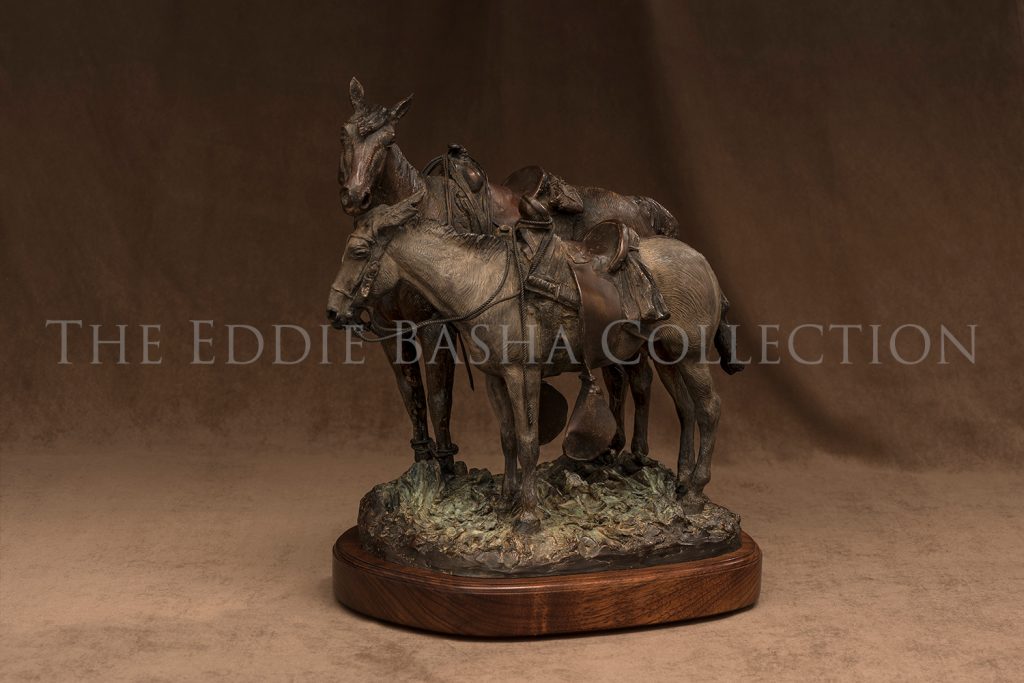 Bronze (2001) | 13 ¾”h x 11 ¼”w x 10”d; Edition #1 of 45
Bronze (2001) | 13 ¾”h x 11 ¼”w x 10”d; Edition #1 of 45“The inspiration for this piece came about as a result of a mule named Sugar. I bought it for my wife, Sharon. Once I put the mule in the same coral as the gelding, it was Love at First Sight. The gelding was no longer good for anything and he wouldn’t perform unless Sugar was by his side,” shared Joe Beeler in 2001.
Love at First Sight
Artist: Joe Beeler, CA Founding Member (1931-2006)
“The inspiration for this piece came about as a result of a mule named Sugar. I bought it for my wife, Sharon. Once I put the mule in the same coral as the gelding, it was Love at First Sight. The gelding was no longer good for anything and he wouldn’t perform unless Sugar was by his side,” shared Joe Beeler in 2001.
 Bronze (1984) | 3 ½”h x 3 ½”w
Bronze (1984) | 3 ½”h x 3 ½”wThe second medallion in the series, “The Apache” debuted in 1984! It, along with the entire series, is displayed routinely in the gallery. Often when discussing the next medallion in the series, Joe and Eddie would contemplate utilizing a particular or similar profile that Joe had crafted in an earlier painting or drawing which Eddie had acquired for the collection. Joe would then sculpt the image they had agreed upon in clay and a mold would be made for the bronze castings by Ed Reilly of Bronzesmith Fine Art Foundry and Gallery in Prescott Valley, Arizona.
Join us on social media by sharing your medallion story, image, card or note... remember to use our link and hashtags when you do! #24medallions #finderskeepers #showusyourmedallion
The Apache
Artist: Joe Beeler, CA Founding Member (1931-2006)
The second medallion in the series, “The Apache” debuted in 1984! It, along with the entire series, is displayed routinely in the gallery. Often when discussing the next medallion in the series, Joe and Eddie would contemplate utilizing a particular or similar profile that Joe had crafted in an earlier painting or drawing which Eddie had acquired for the collection. Joe would then sculpt the image they had agreed upon in clay and a mold would be made for the bronze castings by Ed Reilly of Bronzesmith Fine Art Foundry and Gallery in Prescott Valley, Arizona.
Join us on social media by sharing your medallion story, image, card or note... remember to use our link and hashtags when you do! #24medallions #finderskeepers #showusyourmedallion
 (L-R)
(L-R)Bronze | Dimensions: 14 ½”h x 14”w; Edition #13 of 20
Bronze | Dimensions: 16”h x 9”w; Edition #1 of 35
Bronze | Dimensions: 14”h x 12”w; Edition #1 of 20
(L-R) Cheyenne Scout – The Mystic – Cheyenne
Artist: Joe Beeler, CA Founding Member (1931-2006)
Bronze | Dimensions: 14 ½”h x 14”w; Edition #13 of 20
Bronze | Dimensions: 16”h x 9”w; Edition #1 of 35
Bronze | Dimensions: 14”h x 12”w; Edition #1 of 20
 Water Marker & Pen (8/3/92) | Image Size: 11”h x 8 ½”w; Framed Size: 18 ¾”h x 16 ¼”w
Water Marker & Pen (8/3/92) | Image Size: 11”h x 8 ½”w; Framed Size: 18 ¾”h x 16 ¼”wOne Shot Antelope Hunt (Parody)
Artist: Joe Beeler, CA Founding Member (1931-2006)
 Bronze (1983) | 3 ½”h x 3 ½”w
Bronze (1983) | 3 ½”h x 3 ½”wThough the concept wasn’t a new one, in 1983 Joe Beeler and Eddie Basha collaborated on what would eventually become a hallmark series of bronze, and later pewter, medallions. At that time, neither envisioned the scope nor popularity. Individual medallions soon became sets and much later a series totaling twenty-four pieces. The medallions were used as holiday gifts or acknowledgements of gratitude. The medallion shown here was the first of the series and reveals a Navajo profile which was fitting since the first Bashas’ Diné store opened in Chinle, Arizona, that same year.
While many enjoy the medallions displayed as beautiful artwork, some recipients creatively used them at their homes, offices and in landscapes. One had the pieces repurposed as cabinet pulls, another as an entry door knocker, an ornamental gate pull, and even artfully embedded along a garden path.
Inquiries are routinely fielded about the medallions, most often by individuals who actively pursue the entire series. And if your curiosity is piqued, rest assured The EBC is committed to sharing additional images and relevant series information here and on social media.
@TheEddieBashaCollection @bashacollection
#24medallions #finderskeepers #showusyourmedallion
The Navajo
Artist: Joe Beeler, CA Founding Member (1931-2006)
Though the concept wasn’t a new one, in 1983 Joe Beeler and Eddie Basha collaborated on what would eventually become a hallmark series of bronze, and later pewter, medallions. At that time, neither envisioned the scope nor popularity. Individual medallions soon became sets and much later a series totaling twenty-four pieces. The medallions were used as holiday gifts or acknowledgements of gratitude. The medallion shown here was the first of the series and reveals a Navajo profile which was fitting since the first Bashas’ Diné store opened in Chinle, Arizona, that same year.
While many enjoy the medallions displayed as beautiful artwork, some recipients creatively used them at their homes, offices and in landscapes. One had the pieces repurposed as cabinet pulls, another as an entry door knocker, an ornamental gate pull, and even artfully embedded along a garden path.
Inquiries are routinely fielded about the medallions, most often by individuals who actively pursue the entire series. And if your curiosity is piqued, rest assured The EBC is committed to sharing additional images and relevant series information here and on social media.
@TheEddieBashaCollection @bashacollection
#24medallions #finderskeepers #showusyourmedallion
 Oil (1997) | Image Size: 24”h x 36”w; Framed Size: 36 ¼”h x 48”w
Oil (1997) | Image Size: 24”h x 36”w; Framed Size: 36 ¼”h x 48”wA lone cowboy rides away from camp on a white horse, more than likely to check the herd. Meanwhile, the bedrolls are brought out and dinner preparations are underway at the chuck wagon. All the activities associated with winding down after a long day on the range. The ambient pale moonlight and firelight beautifully lend themselves as illuminators of a tranquil dusk.
Cow Camp by Moonlight
Artist: Joe Beeler, CA Founding Member (1931-2006)
A lone cowboy rides away from camp on a white horse, more than likely to check the herd. Meanwhile, the bedrolls are brought out and dinner preparations are underway at the chuck wagon. All the activities associated with winding down after a long day on the range. The ambient pale moonlight and firelight beautifully lend themselves as illuminators of a tranquil dusk.
 Bronze (2006) | 24”h x 11.25”w x 8”d; Edition #1 of 40
Bronze (2006) | 24”h x 11.25”w x 8”d; Edition #1 of 40In Joe Beeler’s bronze depiction “The Scout for the Long Knives” the Indian scout wears a unique blend of traditional garb, surplus stock issued cavalry jacket, and hat with an added feather accoutrement. Highly effective, Indian Scouts were skilled trackers, had immense knowledge of the terrain, and provided much needed intelligence. Early white settlers and subsequently soldiers were dubbed “long knives” since the knives they carried were noticeably longer than those which Indians had seen or used initially.
The Scout for the Long Knives
Artist: Joe Beeler, CA Founding Member (1931-2006)
In Joe Beeler’s bronze depiction “The Scout for the Long Knives” the Indian scout wears a unique blend of traditional garb, surplus stock issued cavalry jacket, and hat with an added feather accoutrement. Highly effective, Indian Scouts were skilled trackers, had immense knowledge of the terrain, and provided much needed intelligence. Early white settlers and subsequently soldiers were dubbed “long knives” since the knives they carried were noticeably longer than those which Indians had seen or used initially.
 Bronze | Dimensions: 8”h x 10”w x 5”d; Edition #7 of 30
Bronze | Dimensions: 8”h x 10”w x 5”d; Edition #7 of 30Lost Dallies
Artist: Joe Beeler, CA Founding Member (1931-2006)
 Charcoal (1995) | Image Size: 23"h x 16.5”w; Framed Size: 35 ½”h x 28 ½”w
Charcoal (1995) | Image Size: 23"h x 16.5”w; Framed Size: 35 ½”h x 28 ½”wShown in profile, this armed and sinister frontier character is mounted on a partially-viewed horse which accorded Beeler the opportunity to provide many details of the character’s clothing and weapon.
The Horse Thief
Artist: Joe Beeler, CA Founding Member (1931-2006)
Shown in profile, this armed and sinister frontier character is mounted on a partially-viewed horse which accorded Beeler the opportunity to provide many details of the character’s clothing and weapon.
 Bronze | Dimensions: 28 ½”h x 34 ½”w x 13 ½”d
Bronze | Dimensions: 28 ½”h x 34 ½”w x 13 ½”dJoe Beeler Cowboy Artist bronze entitled “Vengeance” was based on the second battle of Adobe Walls which occurred in the Texas Panhandle in 1864. In that battle, 20 or 30 buffalo hunters held off for three days approximately 700 (+/-) Comanche, Kiowa, and Apache warriors led by Comanche Medicine Man Isatai’i and Comanche Chief Quanah Parker, son of the previously captured white woman Cynthia Ann Parker. The deciding factor was a famous long range rifle shot by hunter Billy Dixon that killed a warrior at a distance of either 1,000 or 1,500 yards (depending on who is telling the story; 1,500 yards is almost a mile in distance). Dixon used a borrowed buffalo gun, often called the “big fifty,” which refers to the large caliber. The Indians were said to have been so startled that a shot could be made from such a distance that they dispersed. For additional information, Empire of the Summer Moon by S.C. Gwynne is a detailed account of Texas history as well as the Comanches.
Vengeance
Artist: Joe Beeler, CA Founding Member (1931-2006)
Joe Beeler Cowboy Artist bronze entitled “Vengeance” was based on the second battle of Adobe Walls which occurred in the Texas Panhandle in 1864. In that battle, 20 or 30 buffalo hunters held off for three days approximately 700 (+/-) Comanche, Kiowa, and Apache warriors led by Comanche Medicine Man Isatai’i and Comanche Chief Quanah Parker, son of the previously captured white woman Cynthia Ann Parker. The deciding factor was a famous long range rifle shot by hunter Billy Dixon that killed a warrior at a distance of either 1,000 or 1,500 yards (depending on who is telling the story; 1,500 yards is almost a mile in distance). Dixon used a borrowed buffalo gun, often called the “big fifty,” which refers to the large caliber. The Indians were said to have been so startled that a shot could be made from such a distance that they dispersed. For additional information, Empire of the Summer Moon by S.C. Gwynne is a detailed account of Texas history as well as the Comanches.
 Bronze (2006) | 20”h x 10”w x 14”d; Edition #1 of 45
Bronze (2006) | 20”h x 10”w x 14”d; Edition #1 of 45Sugar for the Trail
Artist: Joe Beeler, CA Founding Member (1931-2006)
 Bronze (1974) | 12”d x 21”h x 35”w; Edition #1 of 15
Bronze (1974) | 12”d x 21”h x 35”w; Edition #1 of 15Dog Soldiers
Artist: Joe Beeler, CA Founding Member (1931-2006)
 Oil (2003) | Image Size: 24”h x 36”w; Framed Size: 36 ¼”h x 48”w
Oil (2003) | Image Size: 24”h x 36”w; Framed Size: 36 ¼”h x 48”wUnder the Congressional Pacific Railroad Act of 1862 which was approved by President Abraham Lincoln, the Union Pacific was incorporated. The act provided for railroad construction from the Missouri River to the Pacific. From Council Bluffs, Iowa, it was constructed westward to meet the Central Pacific Railroad line which went eastward from San Francisco. Primarily constructed by immigrant labor, the two railway lines connected at Promontory Summit, Utah, on May 10, 1869, creating the first transcontinental railroad in North America.
No longer would mail or other transactional activities be transported by horseback or stage over the rugged terrain. At the very least, a toast was in order!
Toasting to the Union Pacific
Artist: Joe Beeler, CA Founding Member (1931-2006)
Under the Congressional Pacific Railroad Act of 1862 which was approved by President Abraham Lincoln, the Union Pacific was incorporated. The act provided for railroad construction from the Missouri River to the Pacific. From Council Bluffs, Iowa, it was constructed westward to meet the Central Pacific Railroad line which went eastward from San Francisco. Primarily constructed by immigrant labor, the two railway lines connected at Promontory Summit, Utah, on May 10, 1869, creating the first transcontinental railroad in North America.
No longer would mail or other transactional activities be transported by horseback or stage over the rugged terrain. At the very least, a toast was in order!
 Bronze (1995) & Oil (2002)
Bronze (1995) & Oil (2002)Bronze | Dimensions: 20”h x 11”w x 11”d; Edition #1 of 45
Oil | Image Size: 16”h x 12”w; Framed Size: 29”h x 25 1/8”w
There were a variety of war bonnets, however, those shown here were primarily worn by Sioux or Northern Plains Indians. Headpieces were not worn in battle as it would have been impractical to do so. Distinguished or highly regarded warriors who “earned” a bonnet would wear it during ceremonial or spiritual practices. These horned bison hide bonnets were often embellished with “earned” accoutrements such as fur, tails trailing behind, ermine skins and feathers.
In the Joe Beeler bronze "Sundance Chief" and the oil painting “Mountain Chief,” we see two unique bison bonnets proudly worn by their victors.
Sun Dance Chief & Mountain Chief
Artist: Joe Beeler, CA Founding Member (1931-2006)
Bronze | Dimensions: 20”h x 11”w x 11”d; Edition #1 of 45
Oil | Image Size: 16”h x 12”w; Framed Size: 29”h x 25 1/8”w
There were a variety of war bonnets, however, those shown here were primarily worn by Sioux or Northern Plains Indians. Headpieces were not worn in battle as it would have been impractical to do so. Distinguished or highly regarded warriors who “earned” a bonnet would wear it during ceremonial or spiritual practices. These horned bison hide bonnets were often embellished with “earned” accoutrements such as fur, tails trailing behind, ermine skins and feathers.
In the Joe Beeler bronze "Sundance Chief" and the oil painting “Mountain Chief,” we see two unique bison bonnets proudly worn by their victors.
 Pencil | Image Size: 18”h x 24”w; Framed Size: 28 5/8"h x 34 ¾”w
Pencil | Image Size: 18”h x 24”w; Framed Size: 28 5/8"h x 34 ¾”wAt day's end, entertainment encamp is often filled with storytelling, song or music as well as poetry. Similar experiences can be had by attending a cowboy poetry and music activity. Check for local events in your area.
Unknown Title
Artist: Joe Beeler, CA Founding Member (1931-2006)
At day's end, entertainment encamp is often filled with storytelling, song or music as well as poetry. Similar experiences can be had by attending a cowboy poetry and music activity. Check for local events in your area.
 Bronze | Dimensions: 18”h x 26”w x 17”d; Edition #1 of 45
Bronze | Dimensions: 18”h x 26”w x 17”d; Edition #1 of 45Bison and Buffalo! Early American settlers called bison “bufello” due to similarities between the species and the name stuck. However, bison are found in North America while the two main buffalo types are found in Africa and Asia.
Bison were the sustenance of the American Indian. They were an integral part of their history, culture, ceremonies and way of life. Bison were more than a major food source, the American Indian made clothing and tipis from the hides, soap from the fat, jewelry and weapons could be fashioned from teeth and horns, tools could be made from hooves and needles crafted from bone. Many social behaviors were learned and adapted from bison such as physical activity, equality of gender, using resources wisely, breastfeeding their young and the value of young and old alike. The bison were and remain today a spiritual reminder to American Indians of how they once lived harmoniously with nature and free.
"When Thunder Roared"… a powerful bronze by Joe Beeler that exhibits the tenacity of both the hunter and the hunted.
When Thunder Roared
Artist: Joe Beeler, CA Founding Member (1931-2006)
Bison and Buffalo! Early American settlers called bison “bufello” due to similarities between the species and the name stuck. However, bison are found in North America while the two main buffalo types are found in Africa and Asia.
Bison were the sustenance of the American Indian. They were an integral part of their history, culture, ceremonies and way of life. Bison were more than a major food source, the American Indian made clothing and tipis from the hides, soap from the fat, jewelry and weapons could be fashioned from teeth and horns, tools could be made from hooves and needles crafted from bone. Many social behaviors were learned and adapted from bison such as physical activity, equality of gender, using resources wisely, breastfeeding their young and the value of young and old alike. The bison were and remain today a spiritual reminder to American Indians of how they once lived harmoniously with nature and free.
"When Thunder Roared"… a powerful bronze by Joe Beeler that exhibits the tenacity of both the hunter and the hunted.